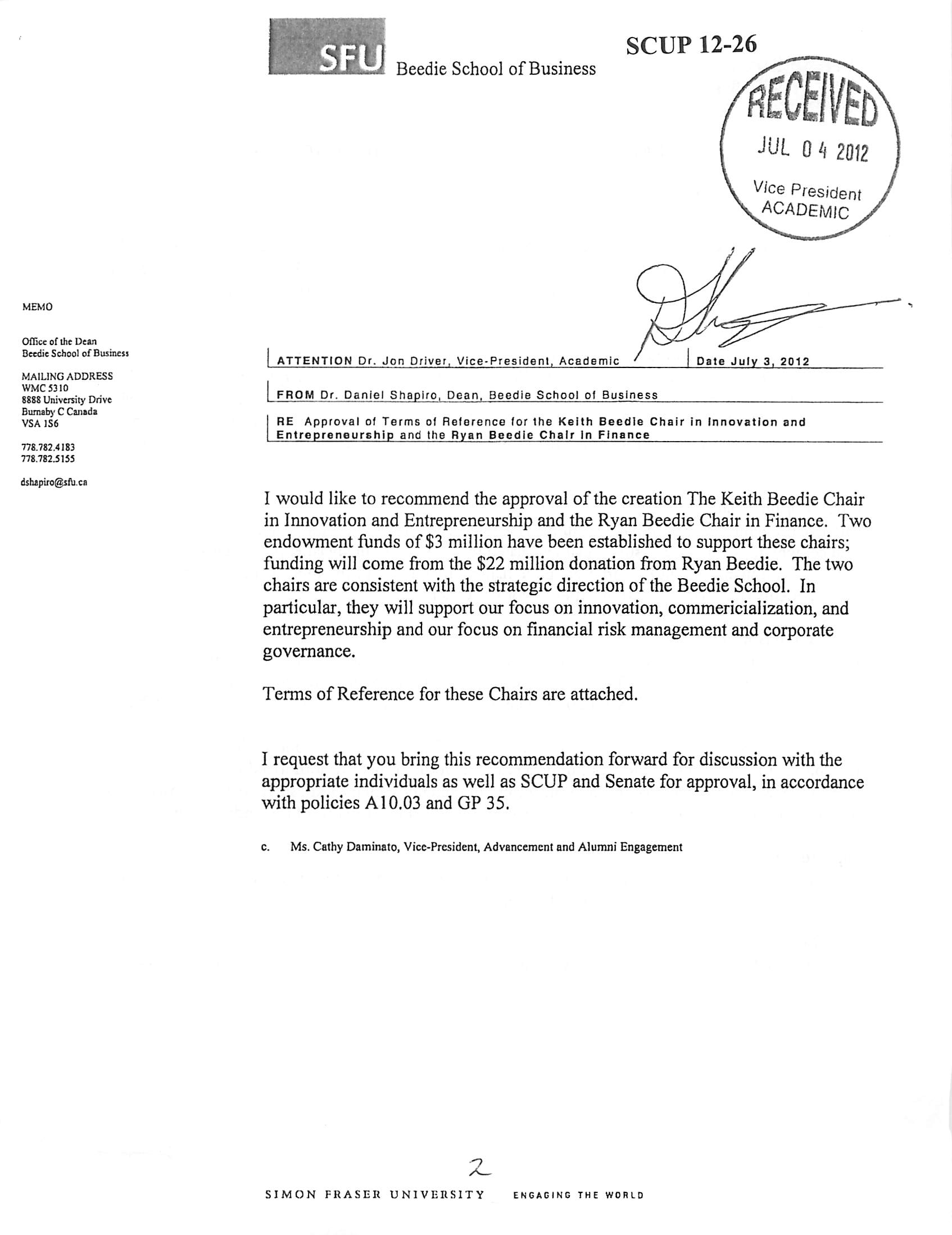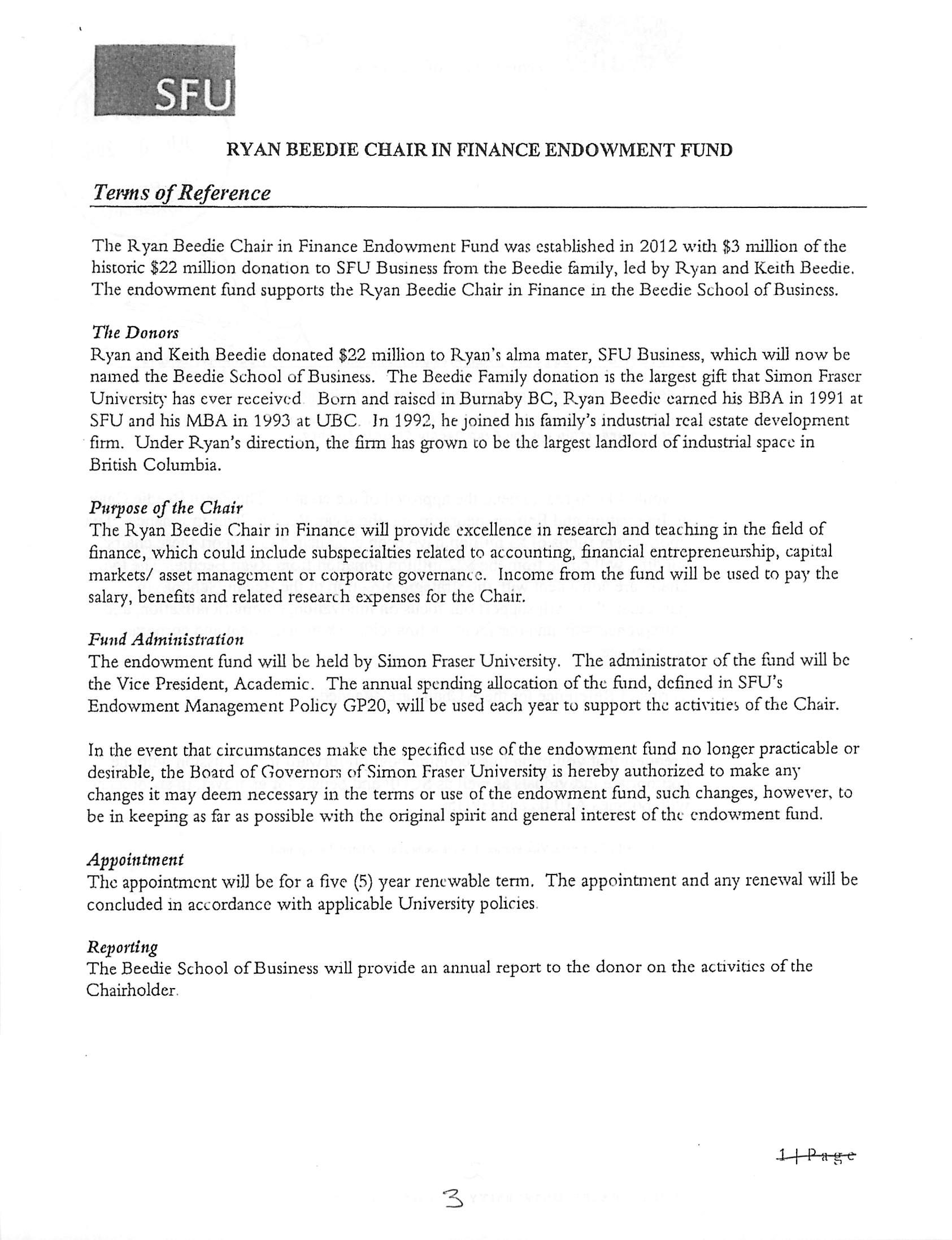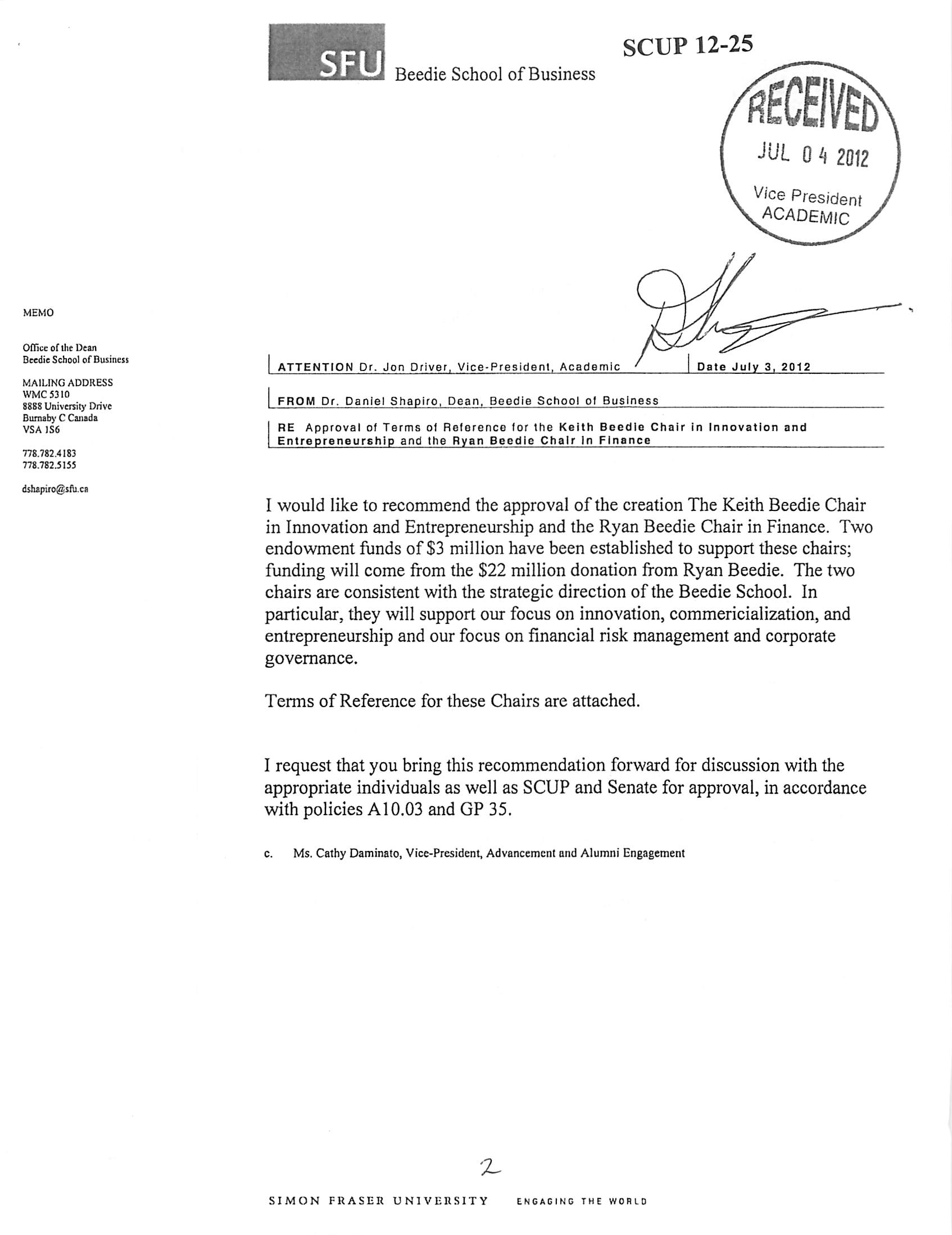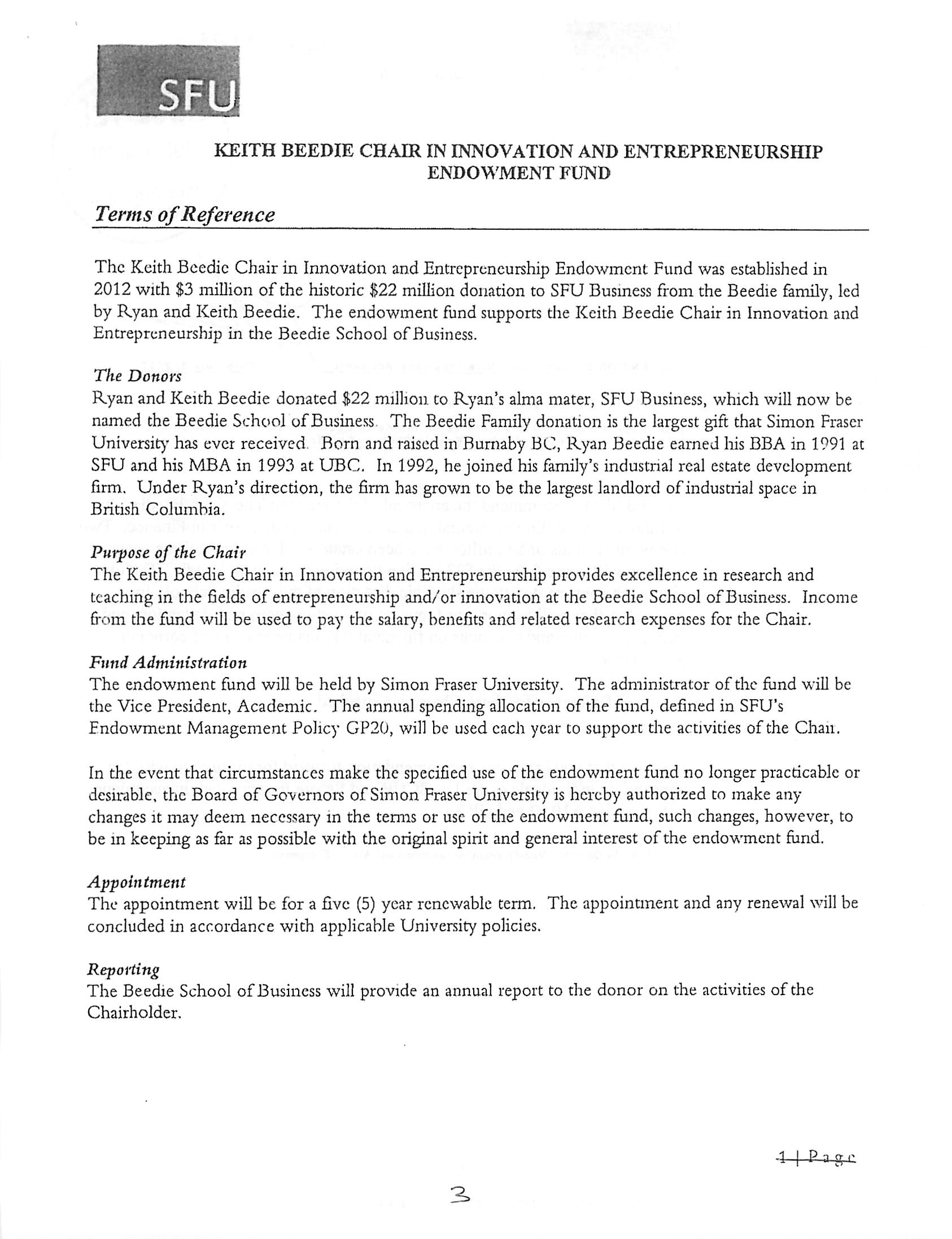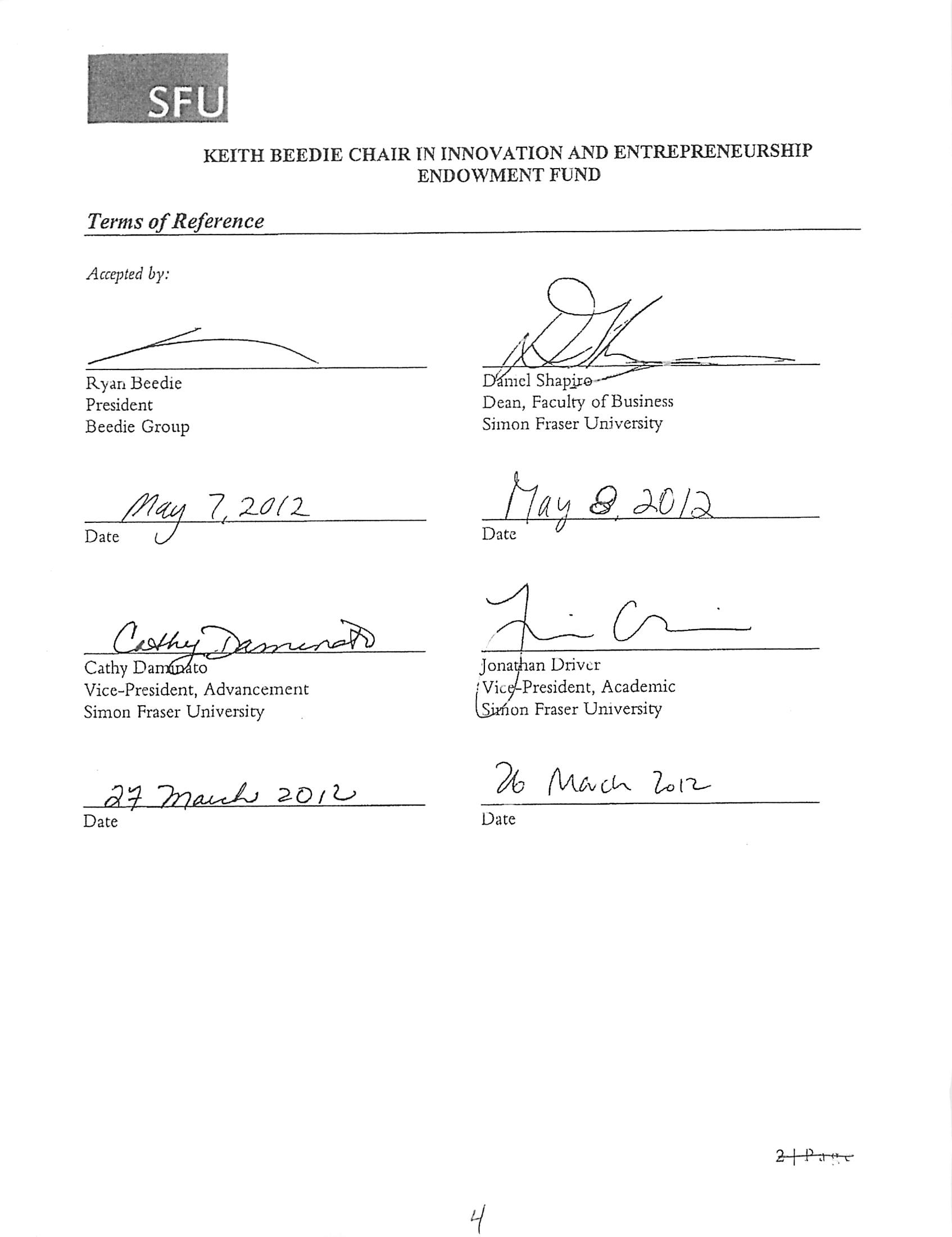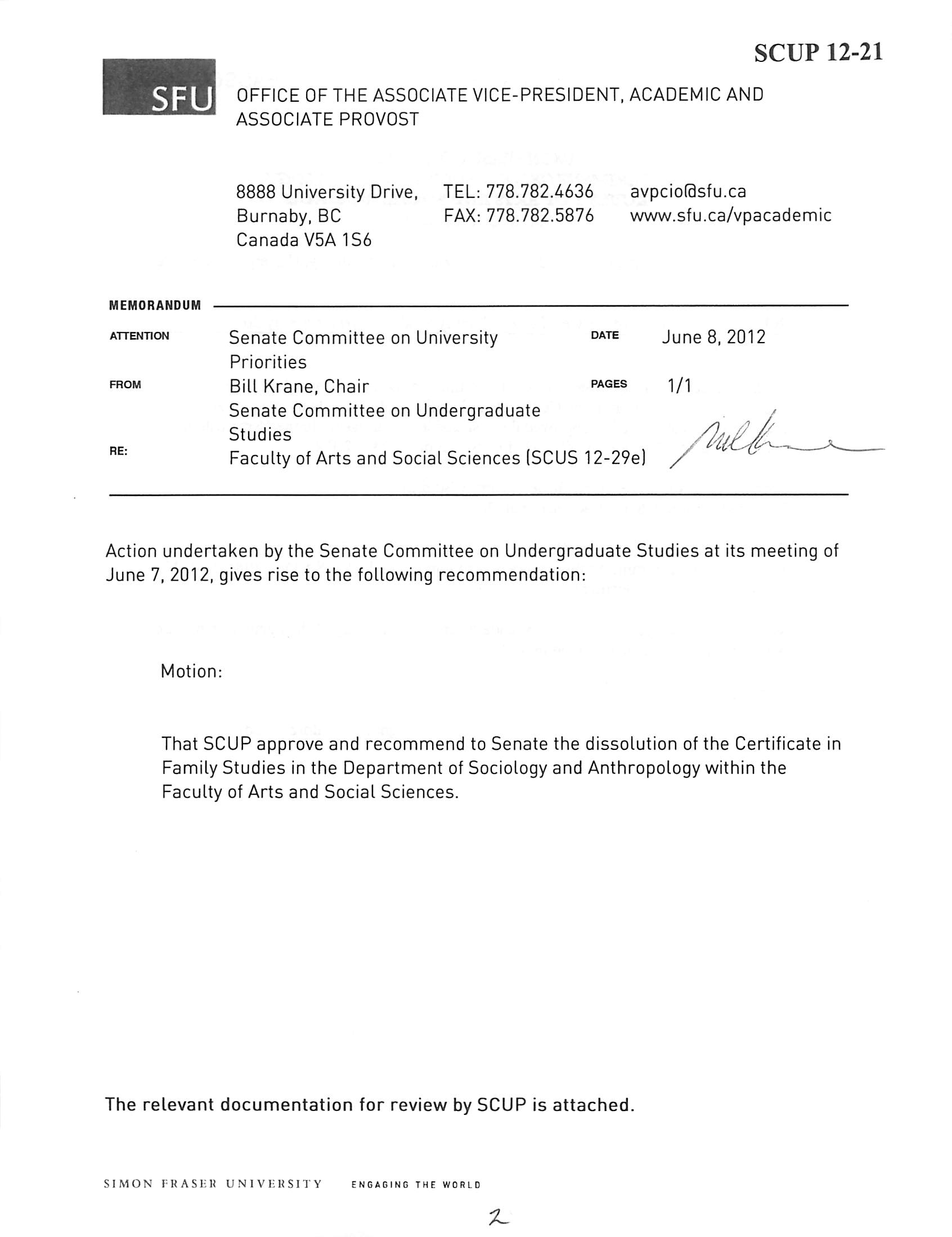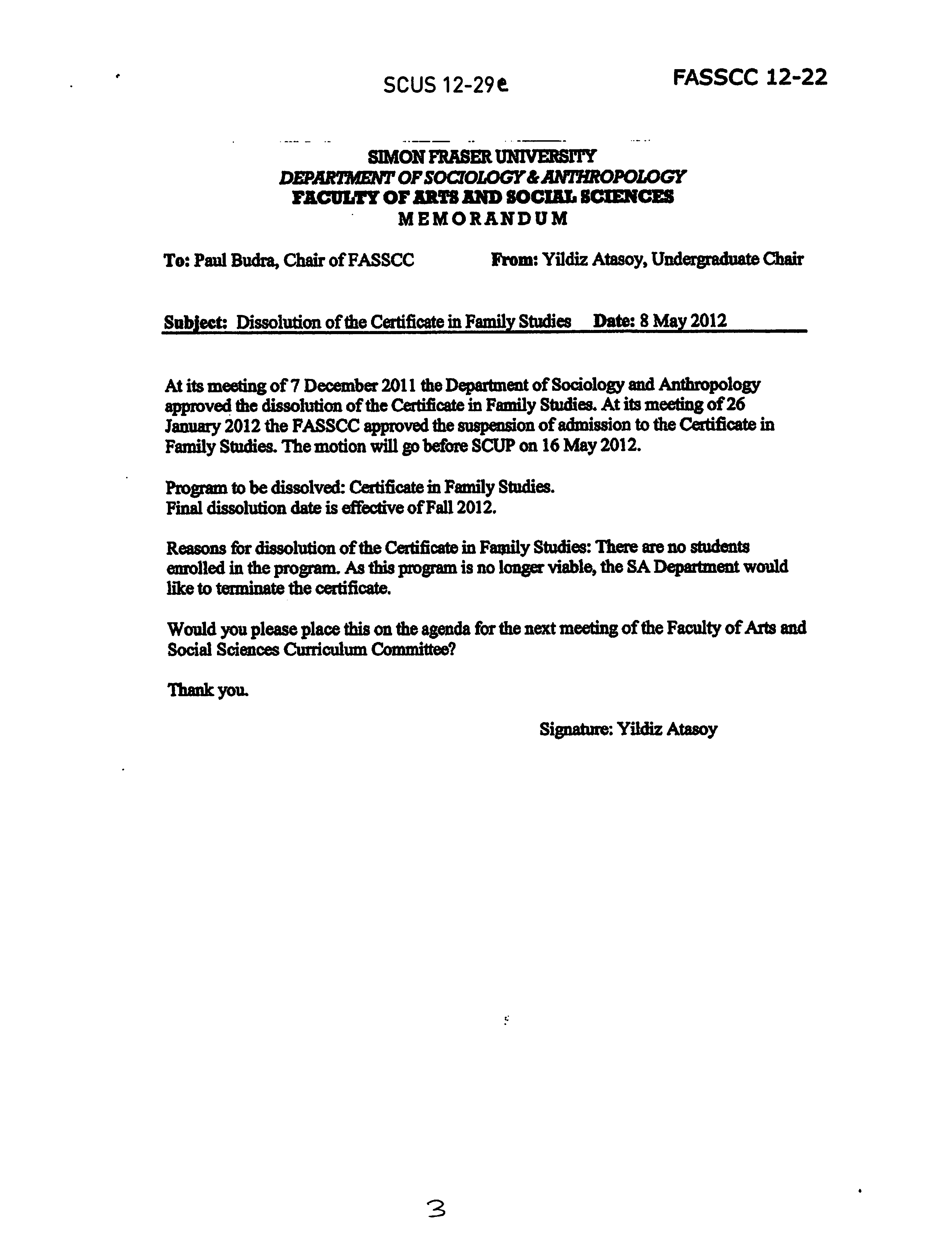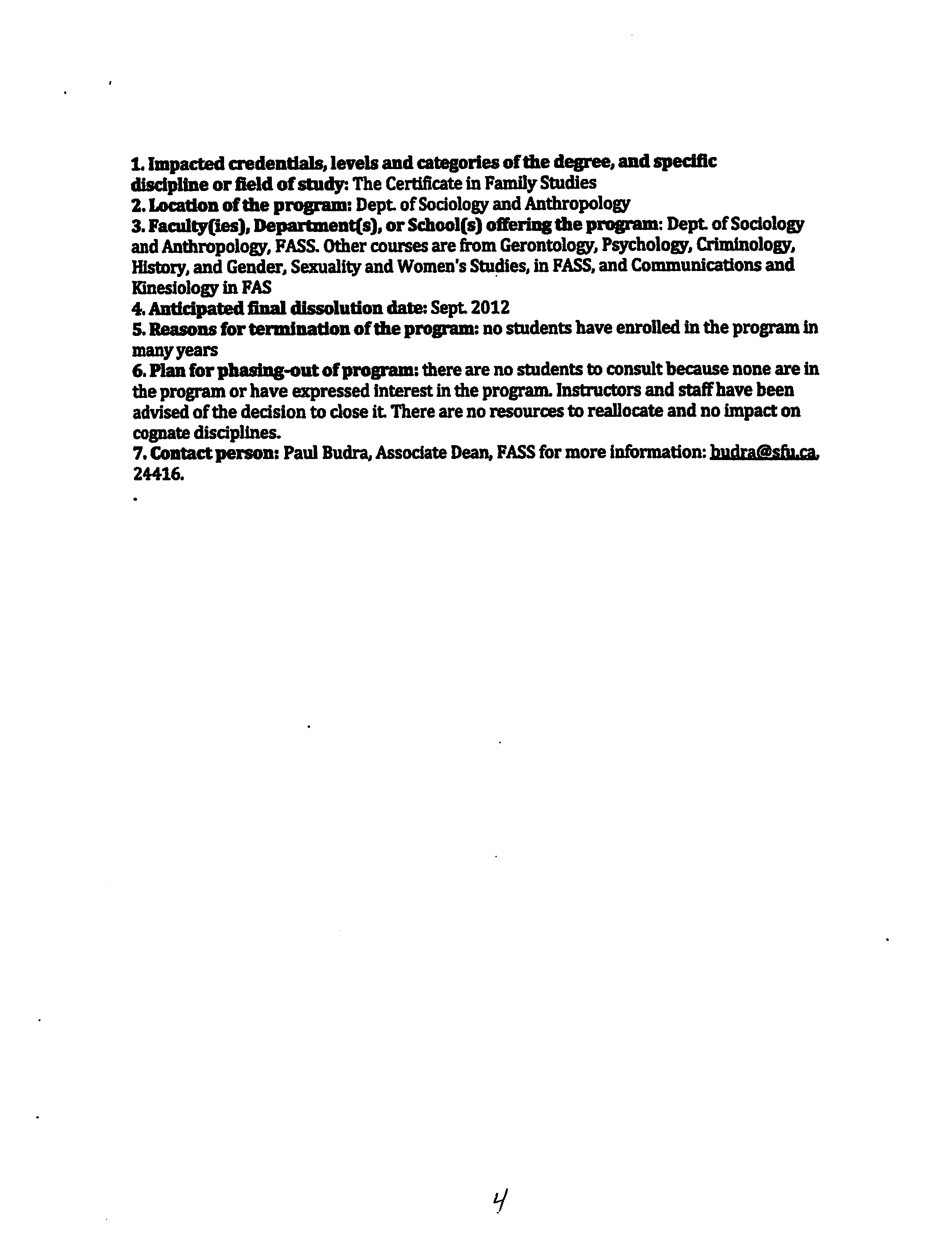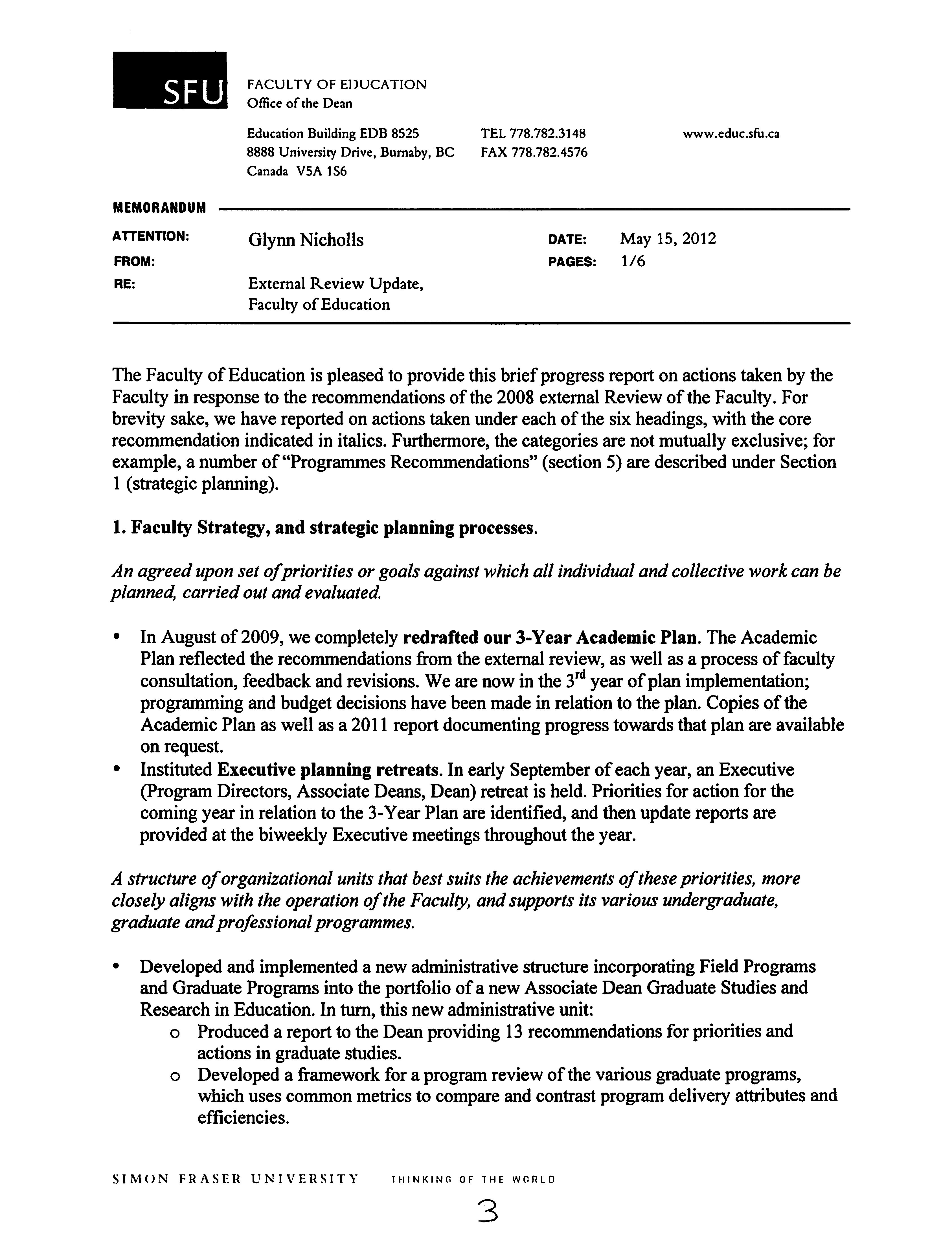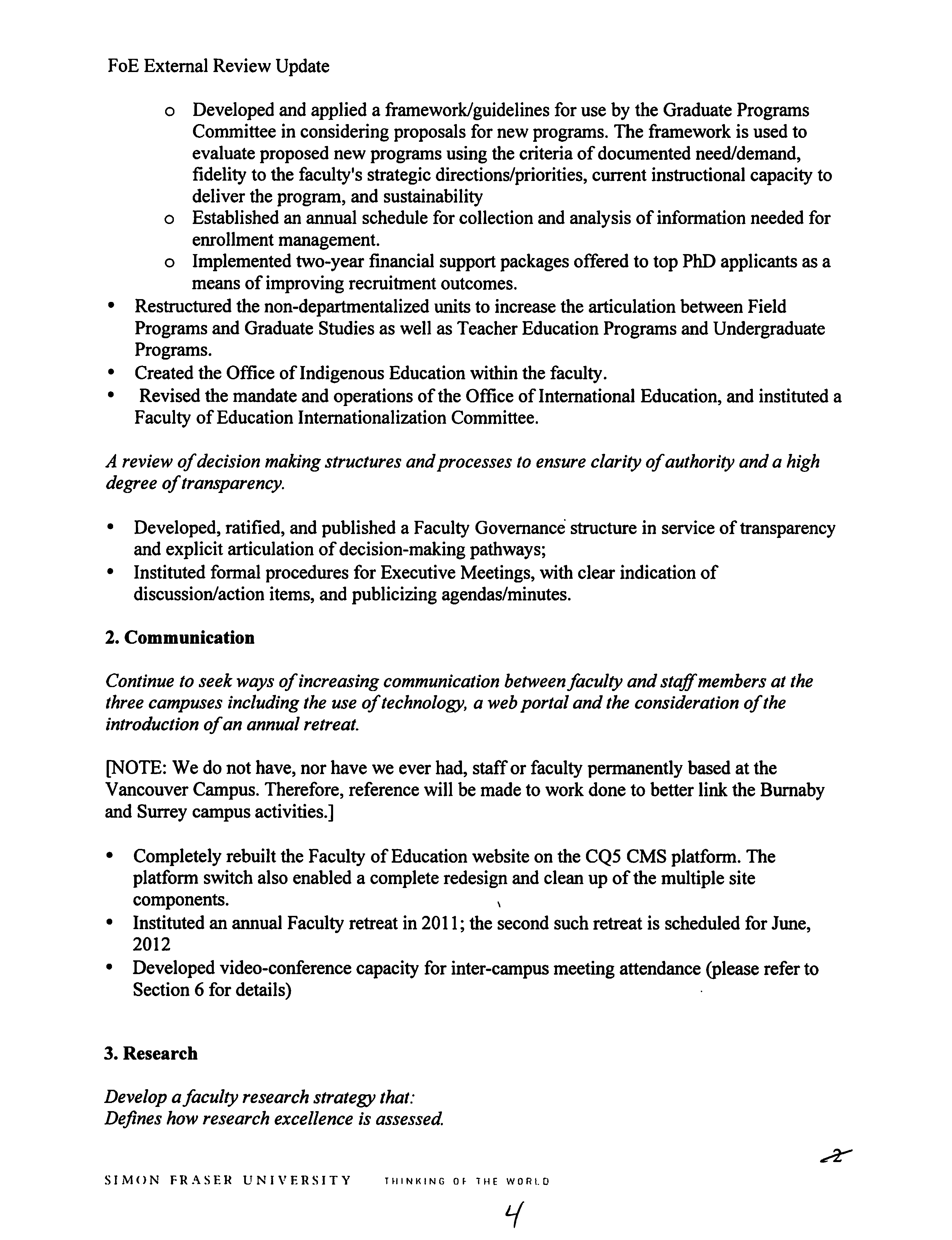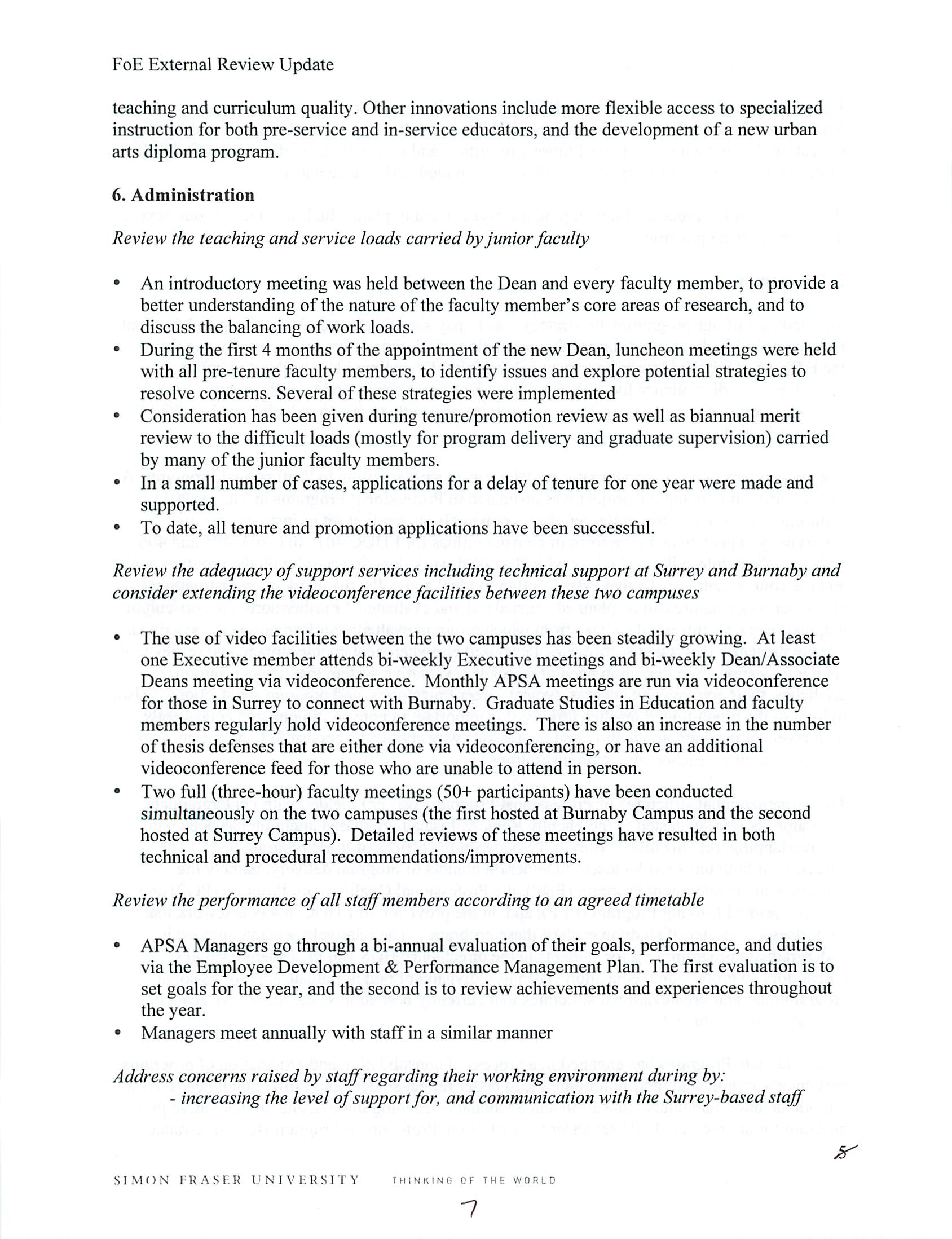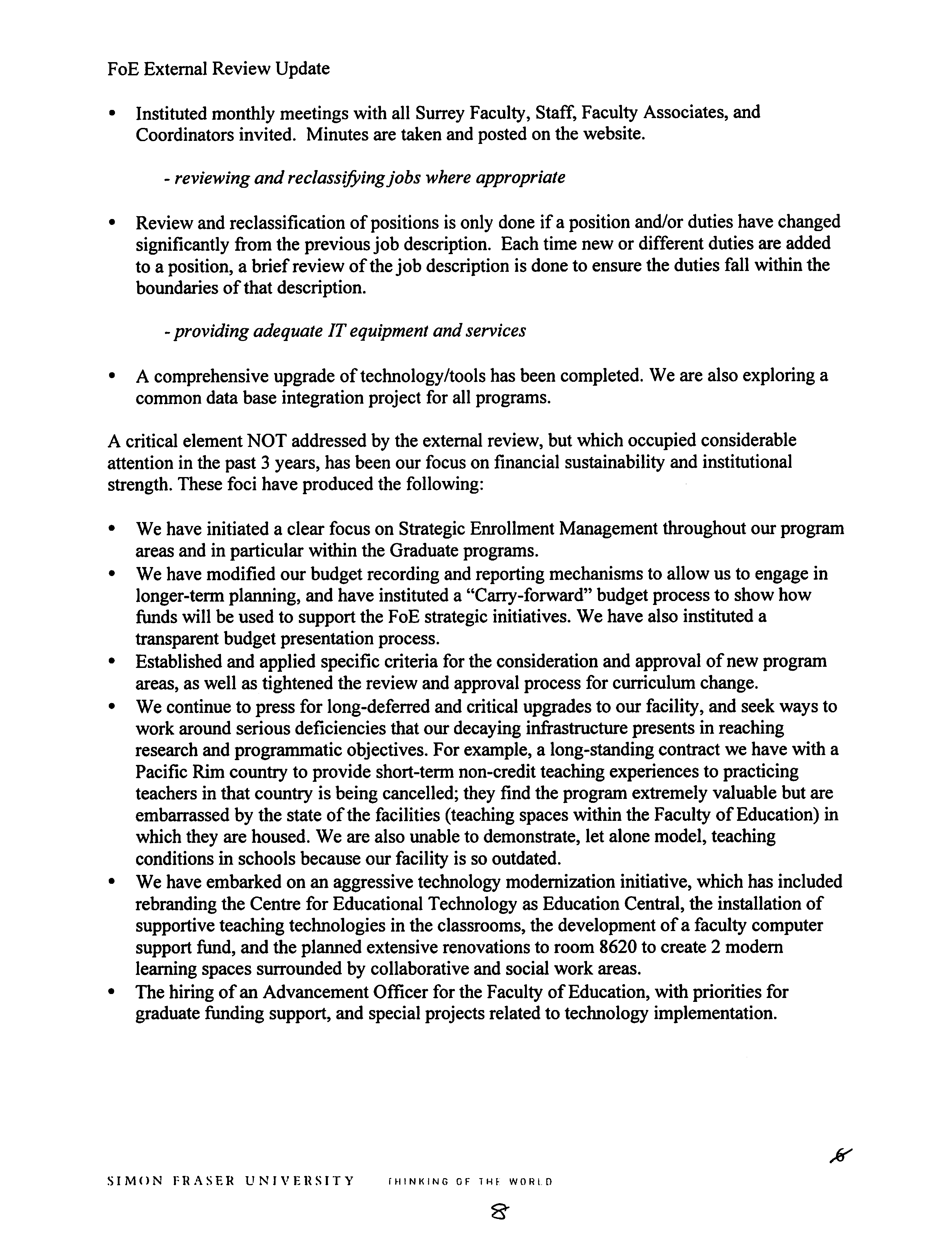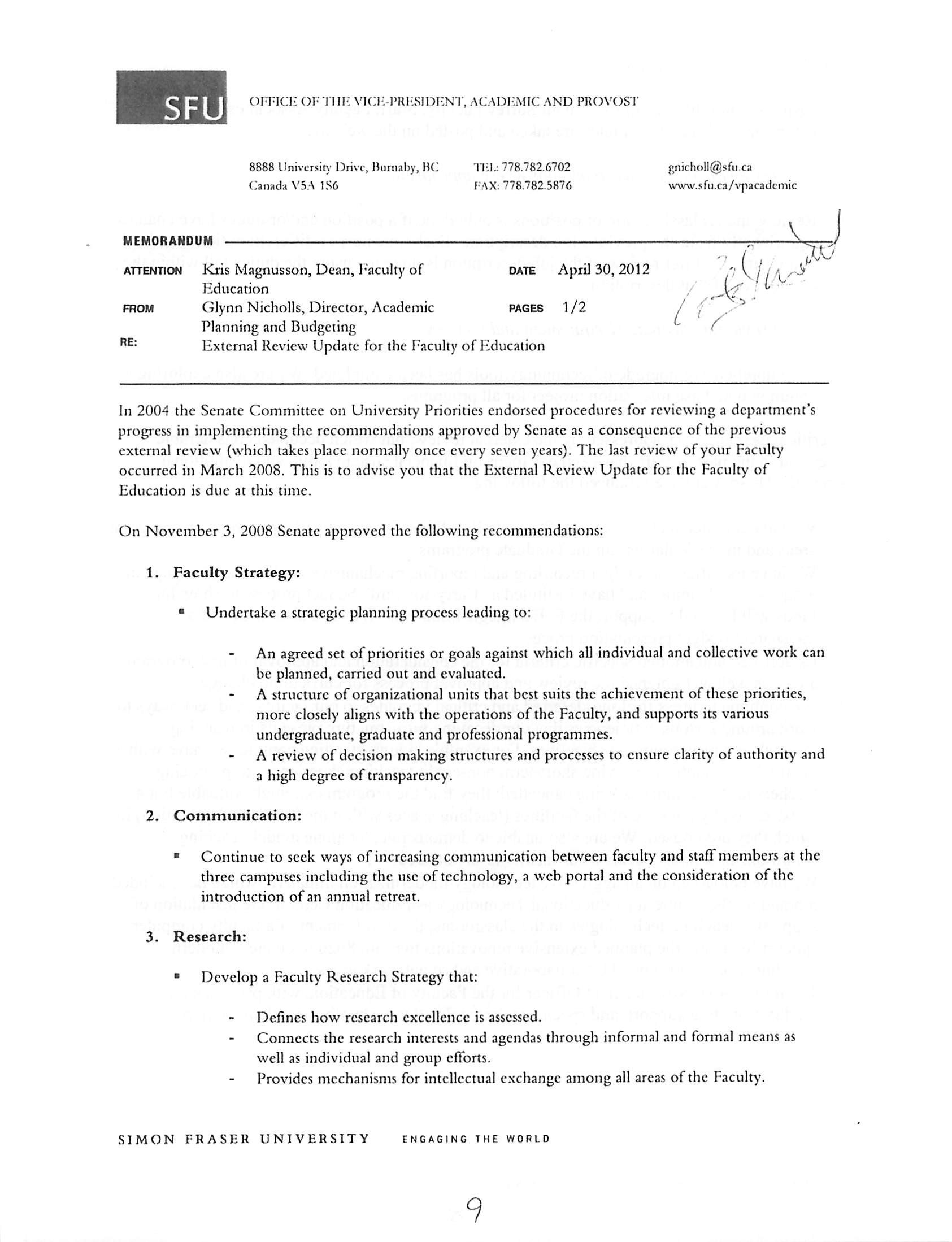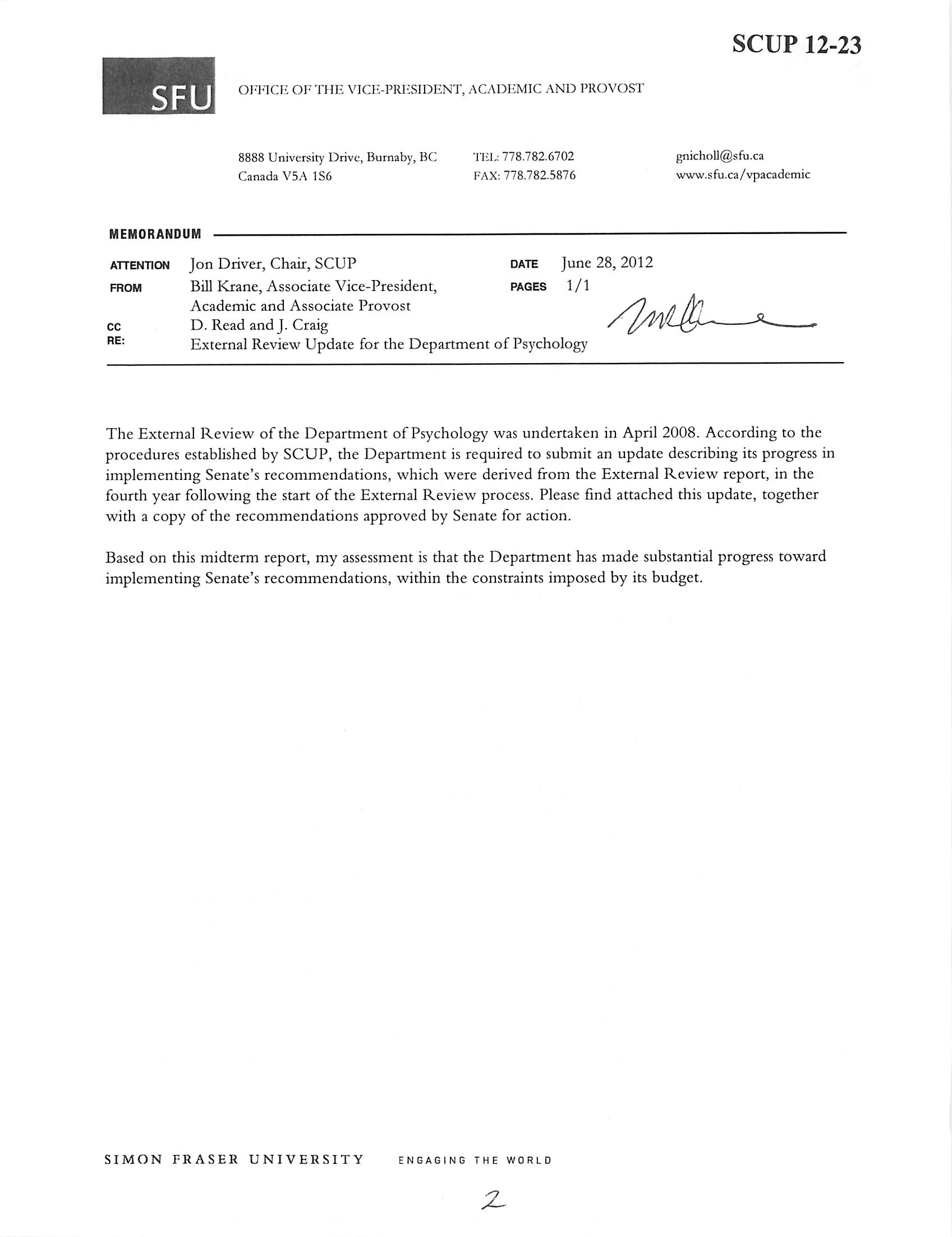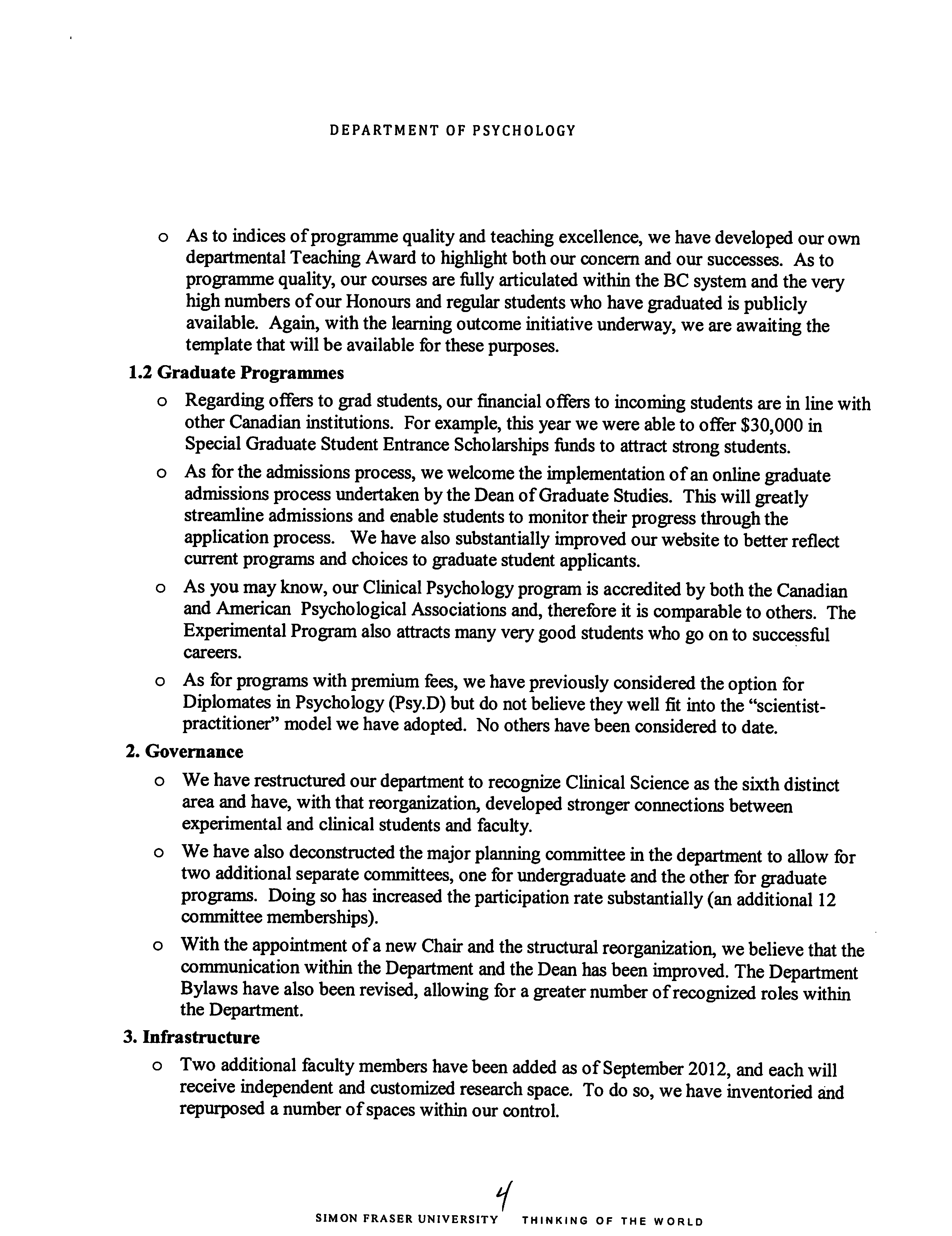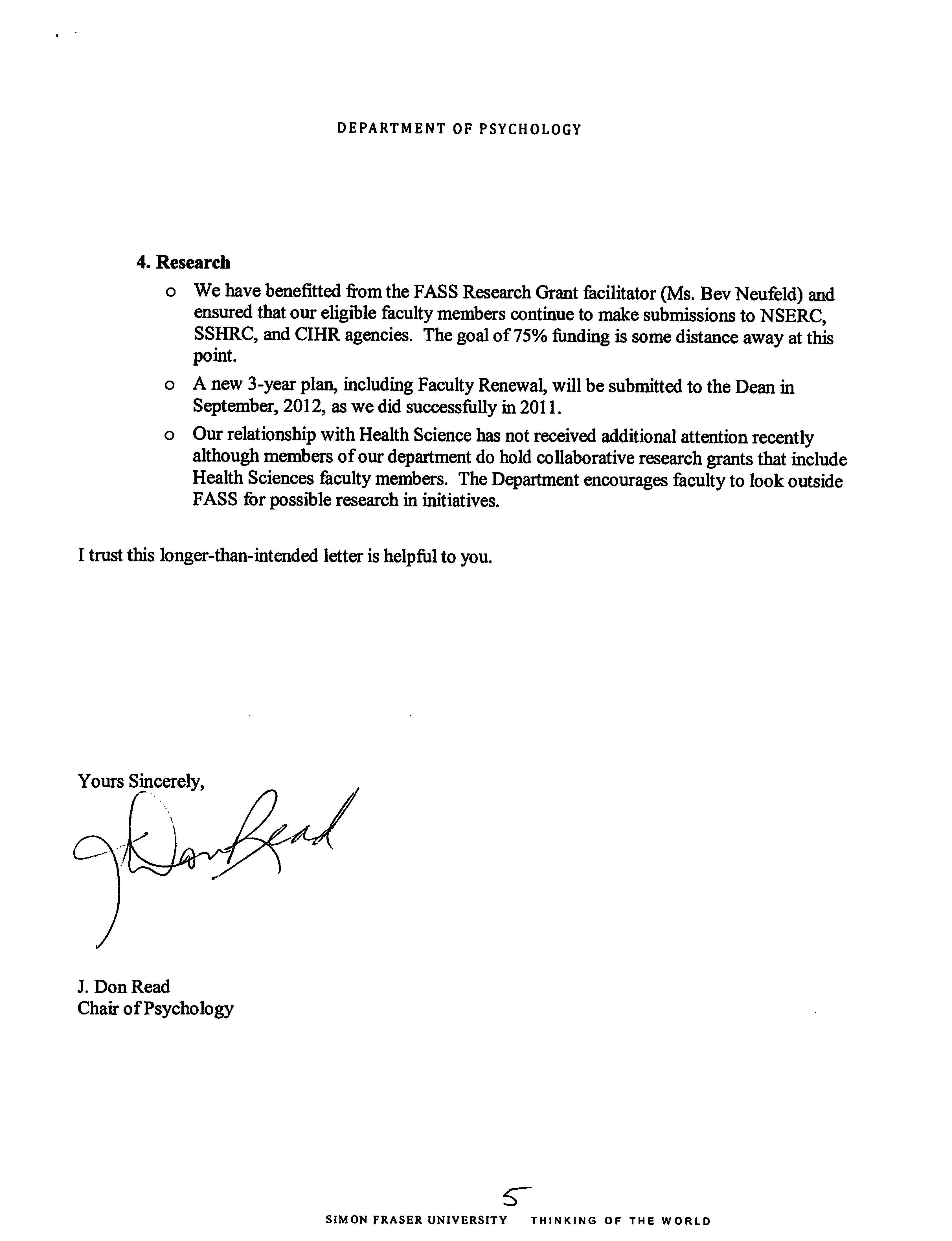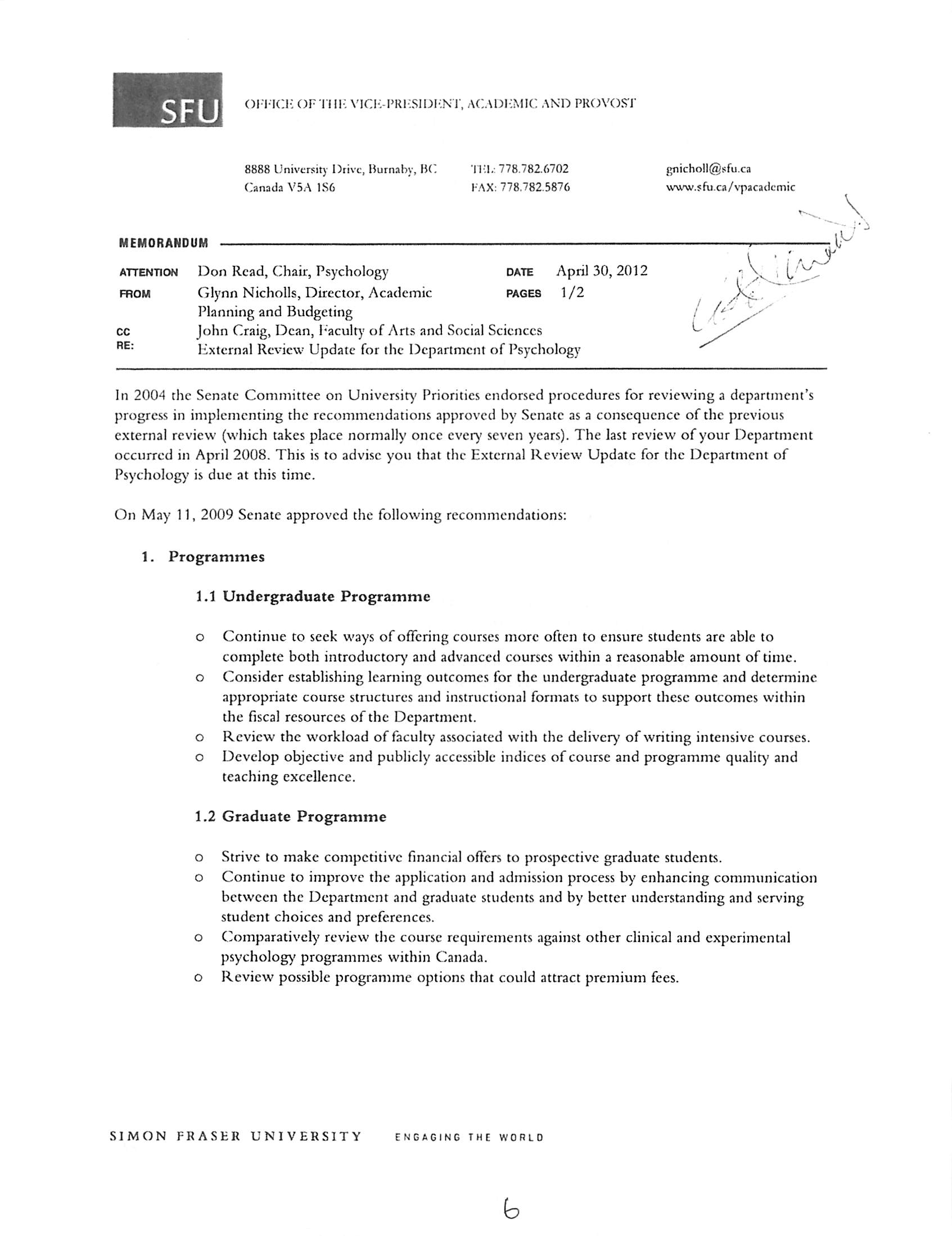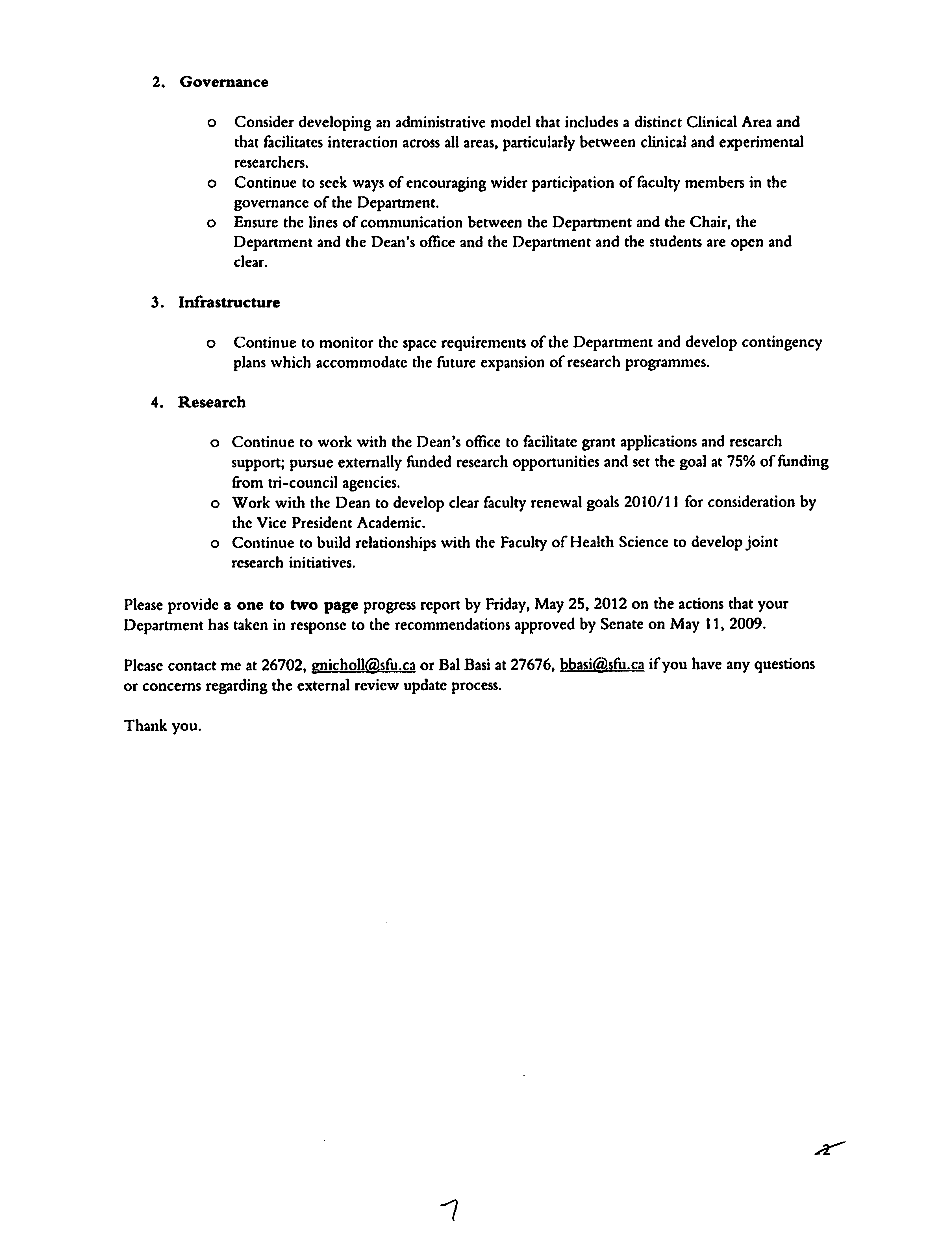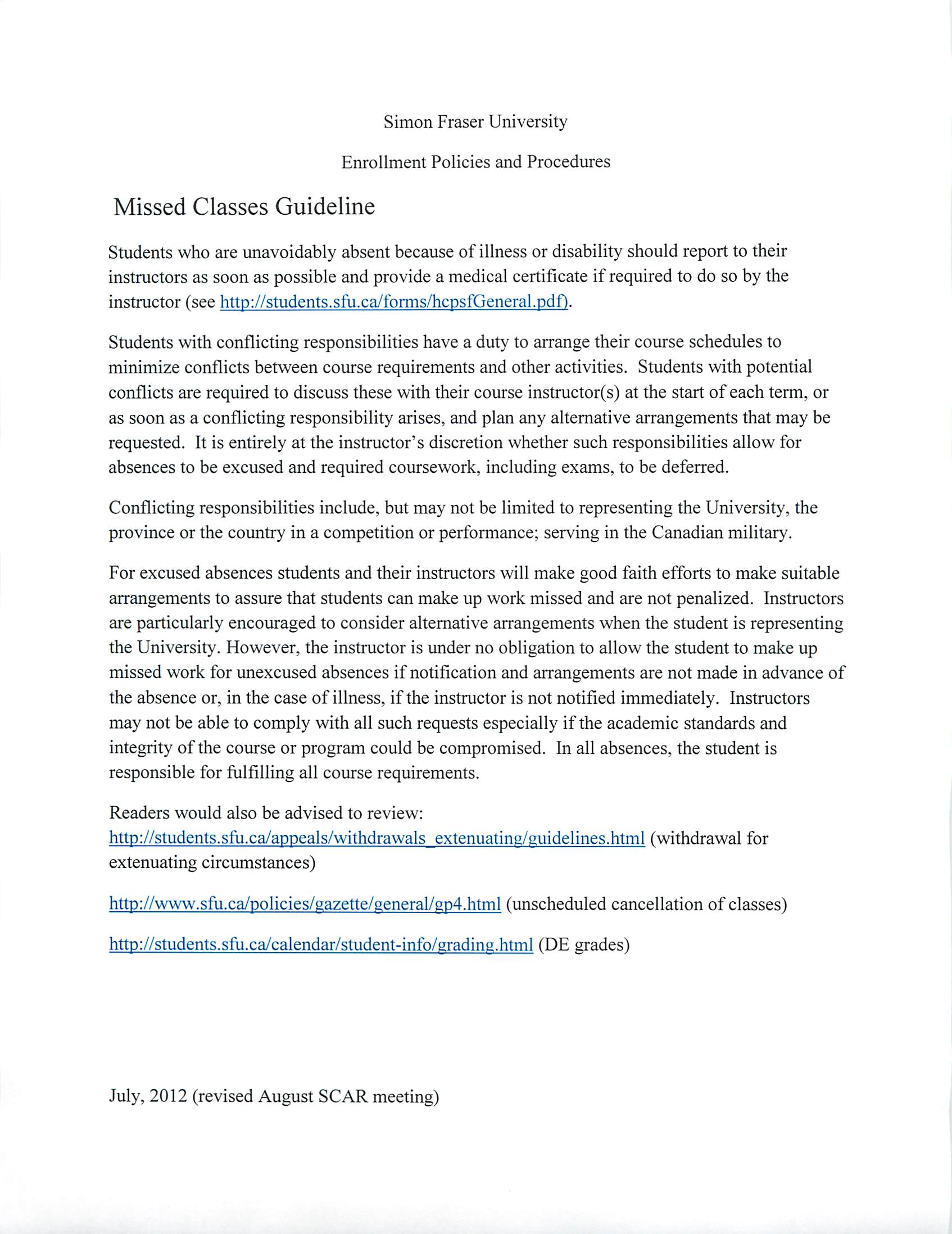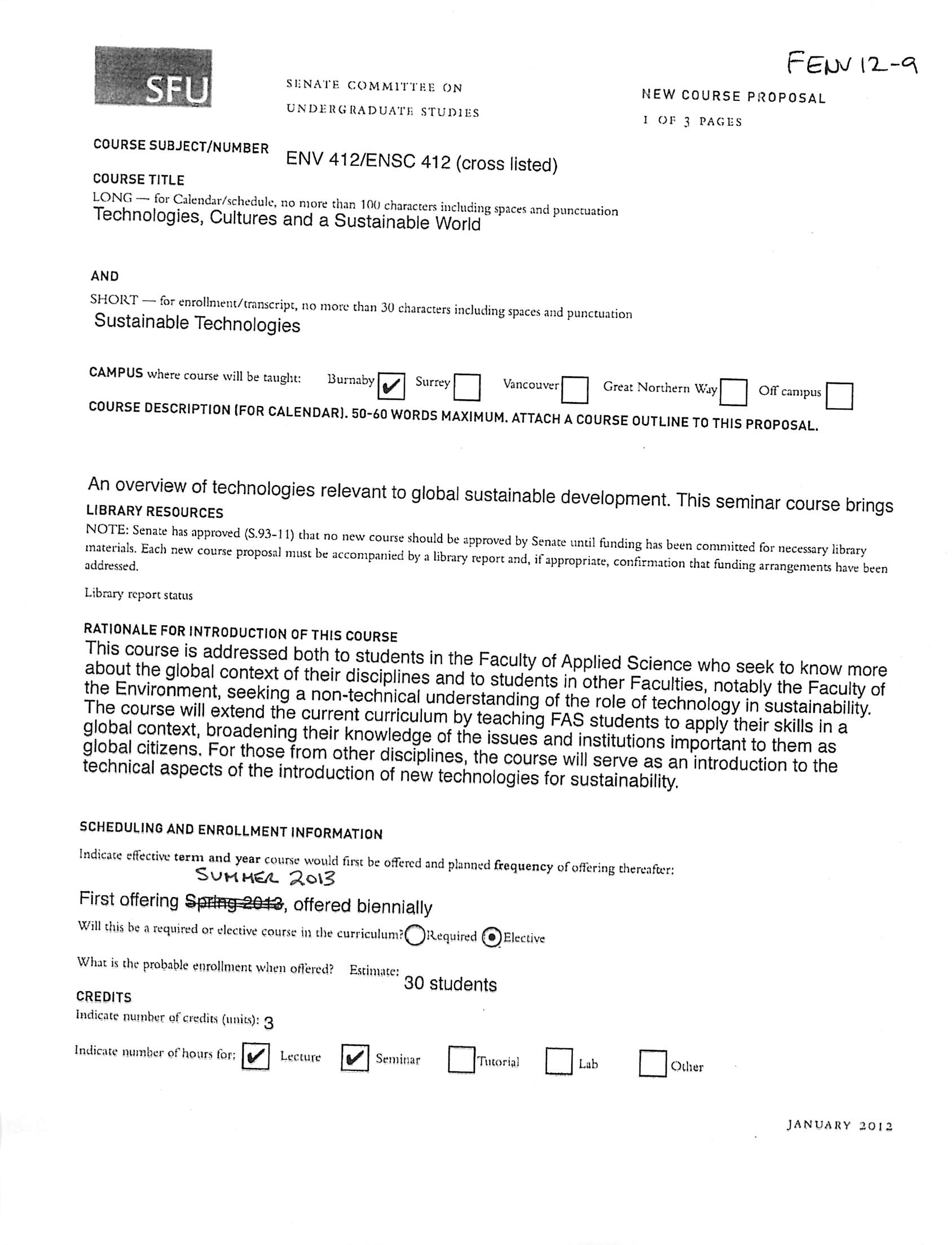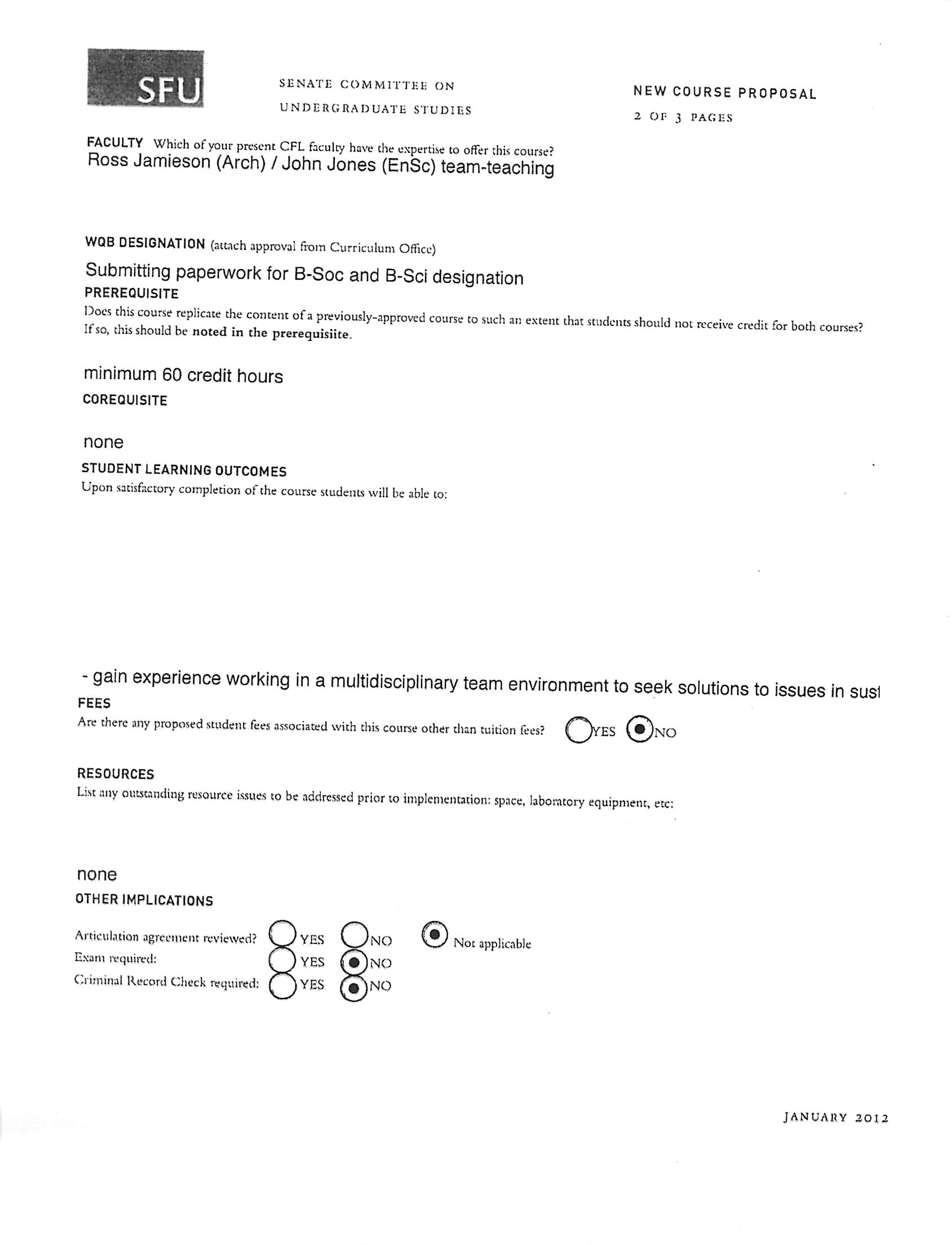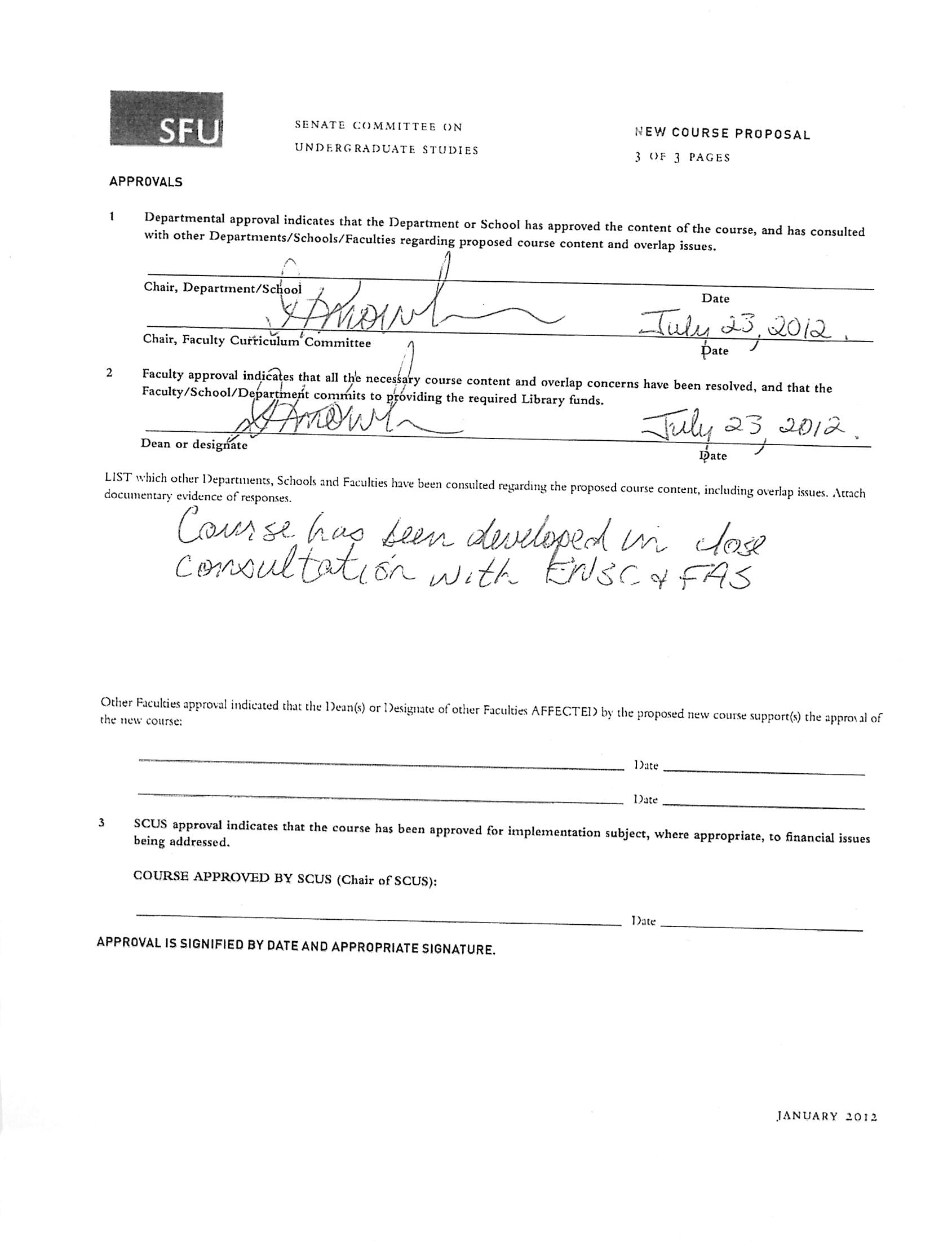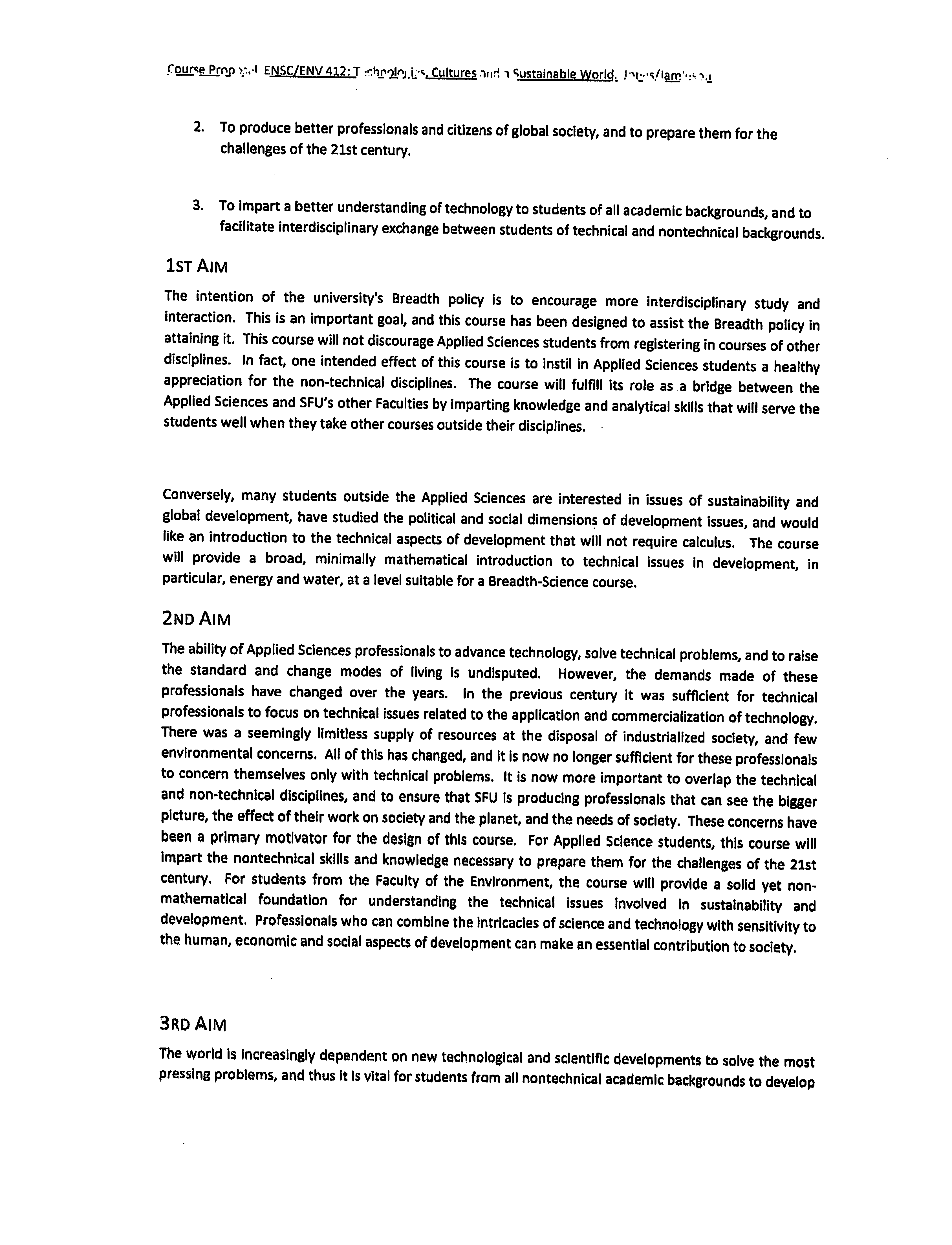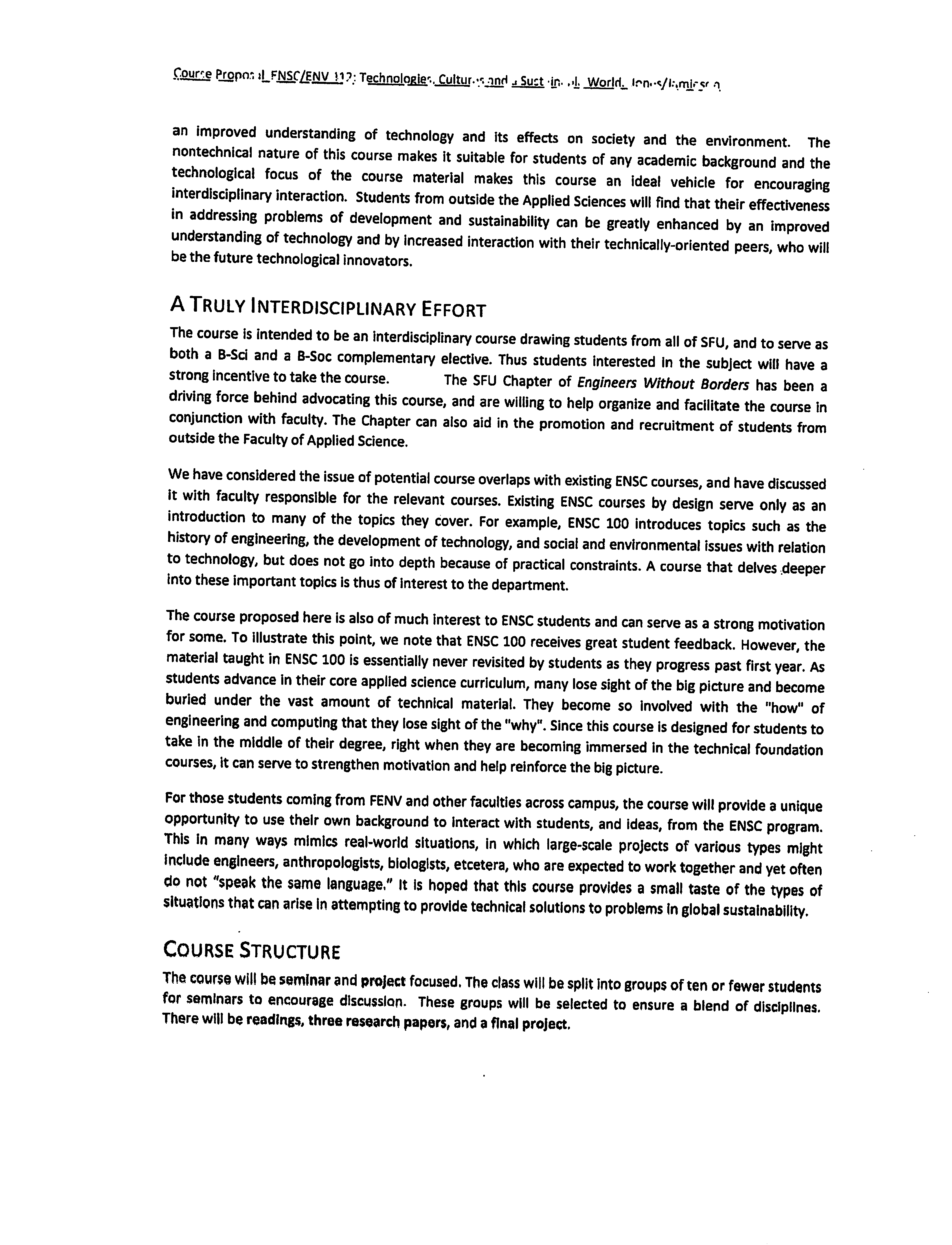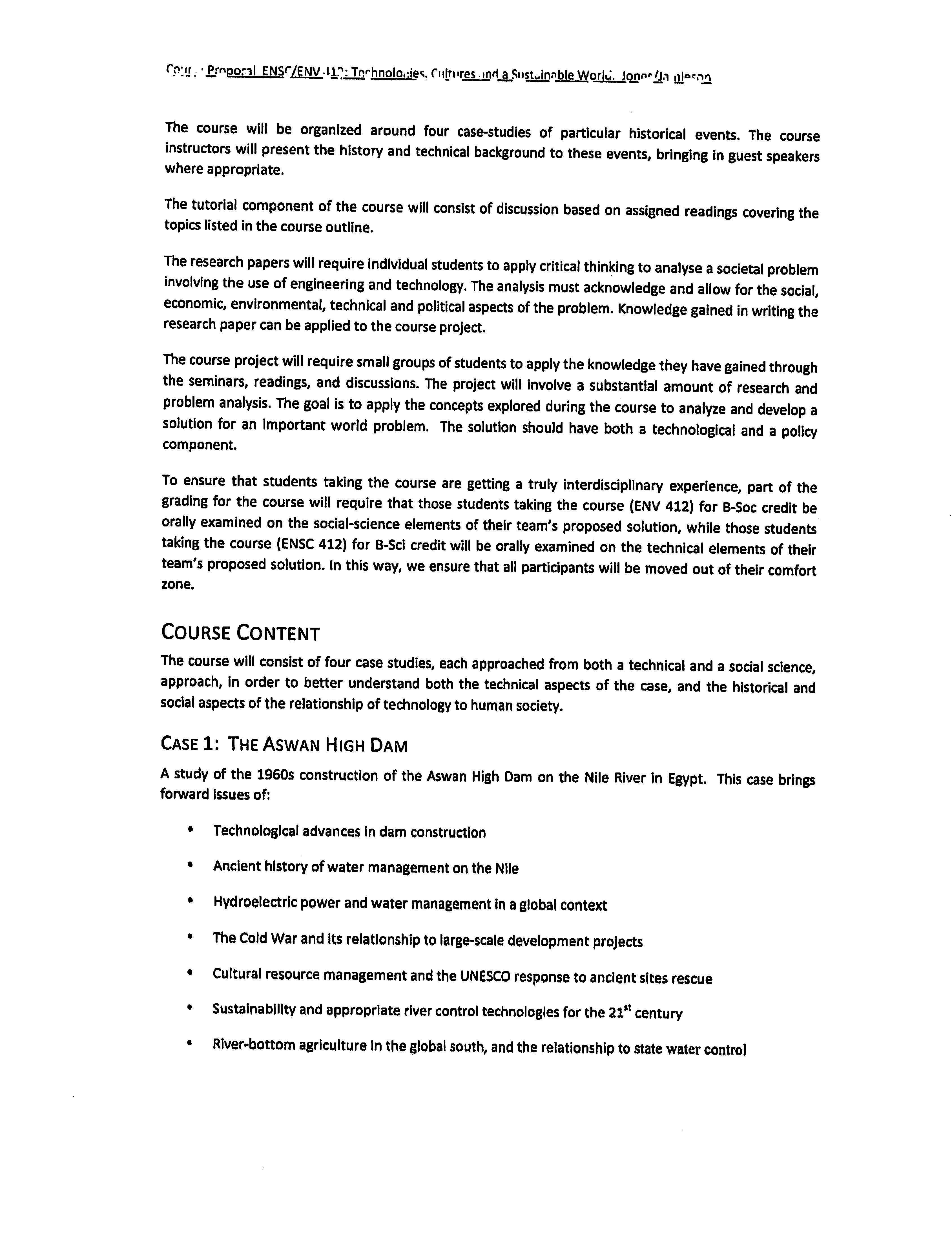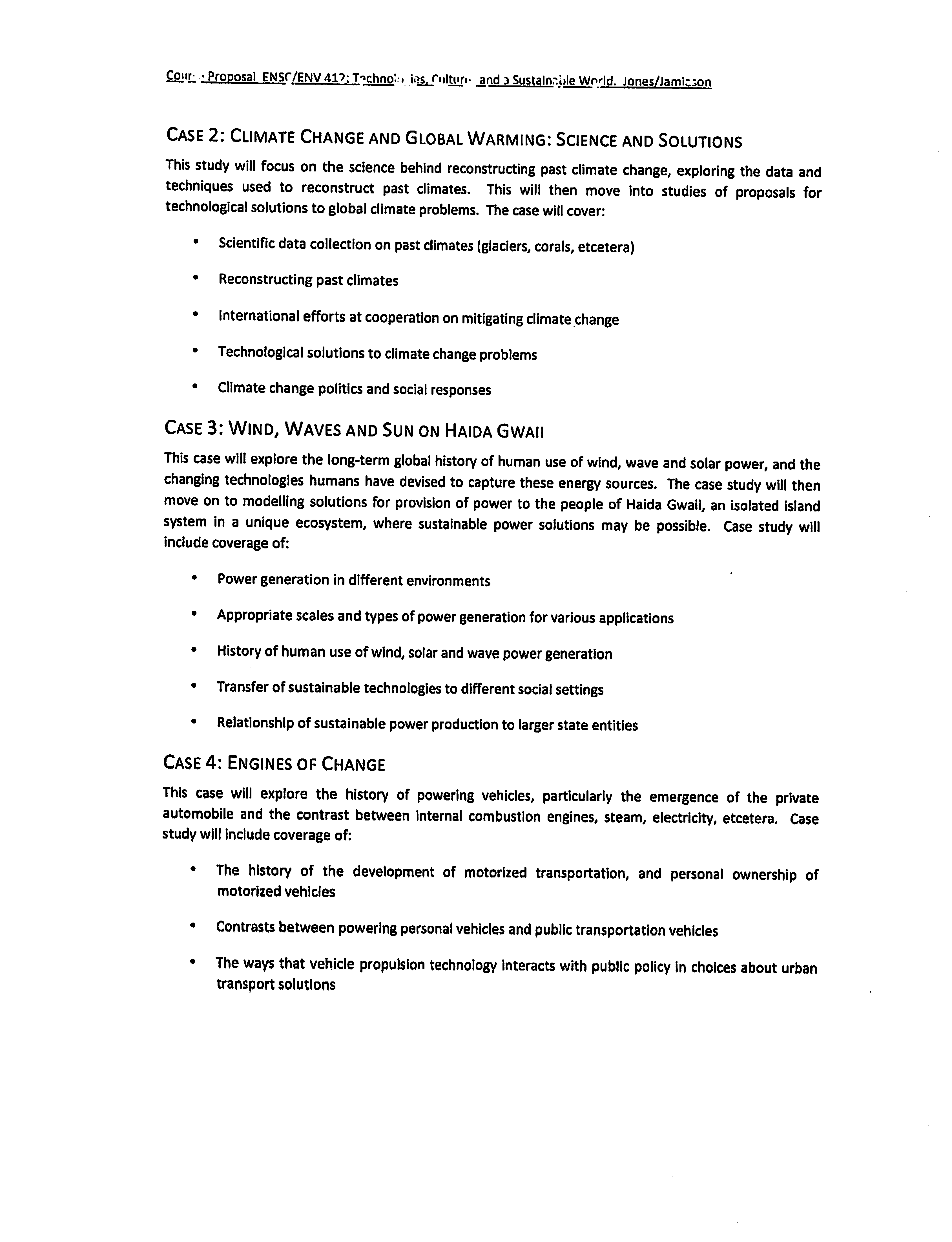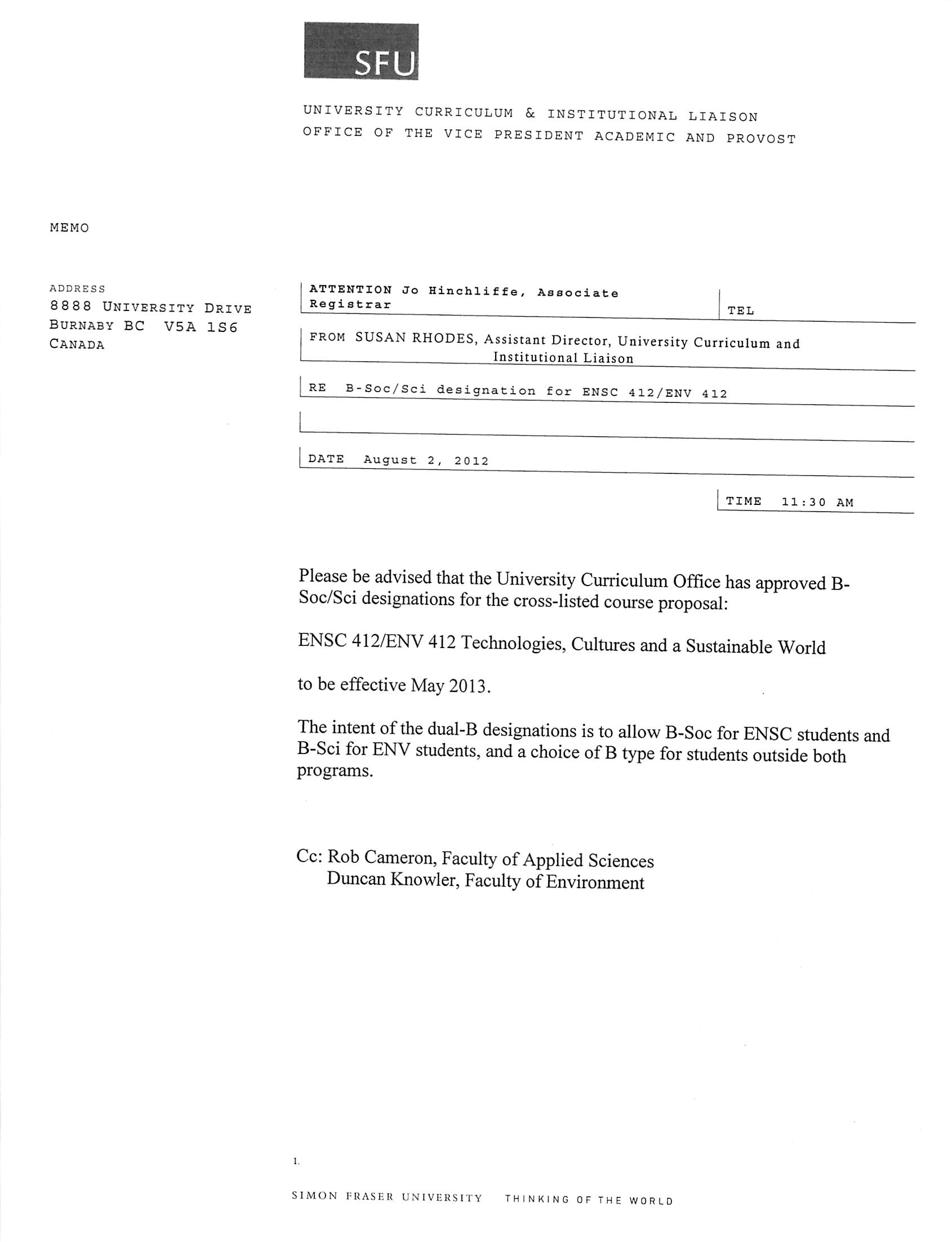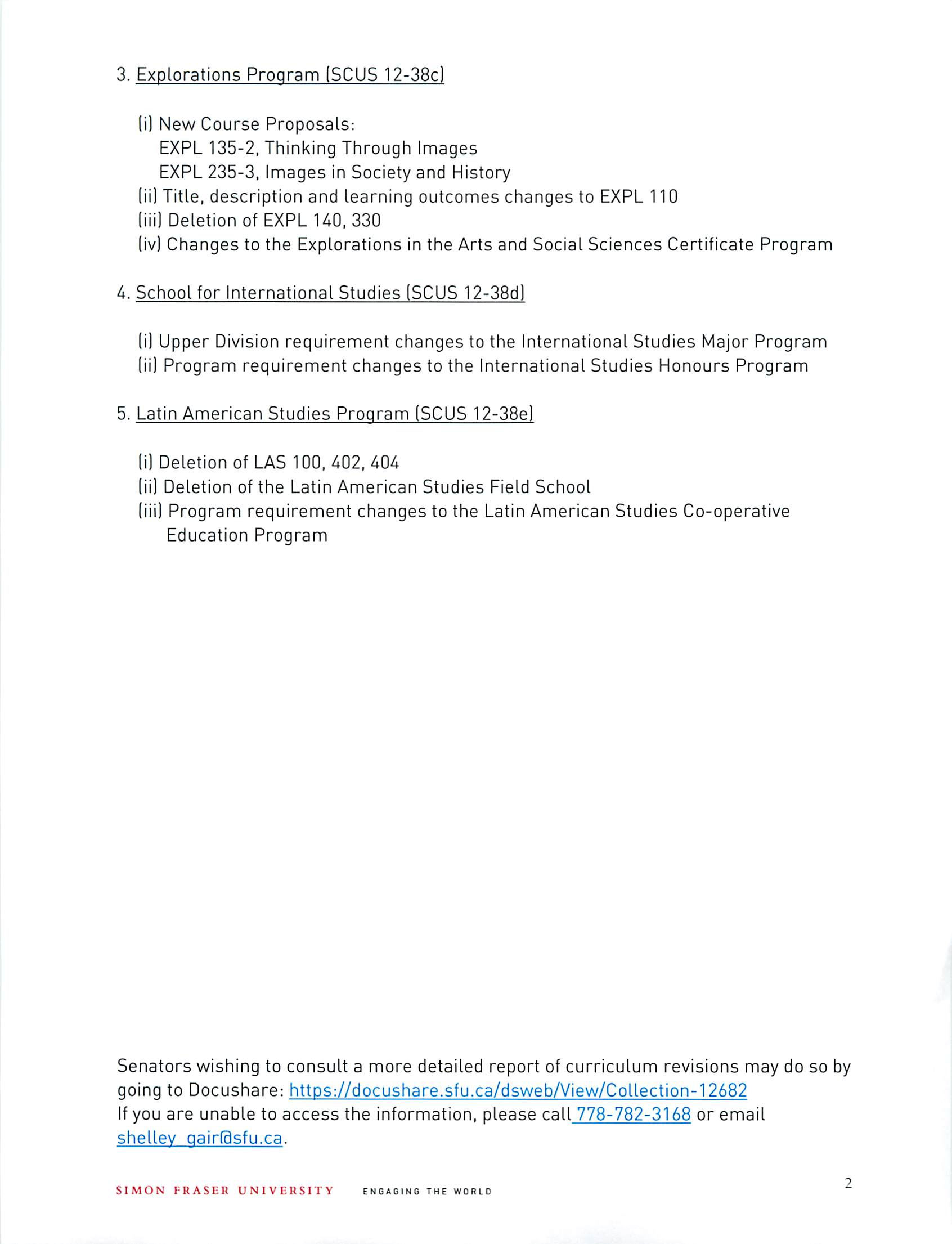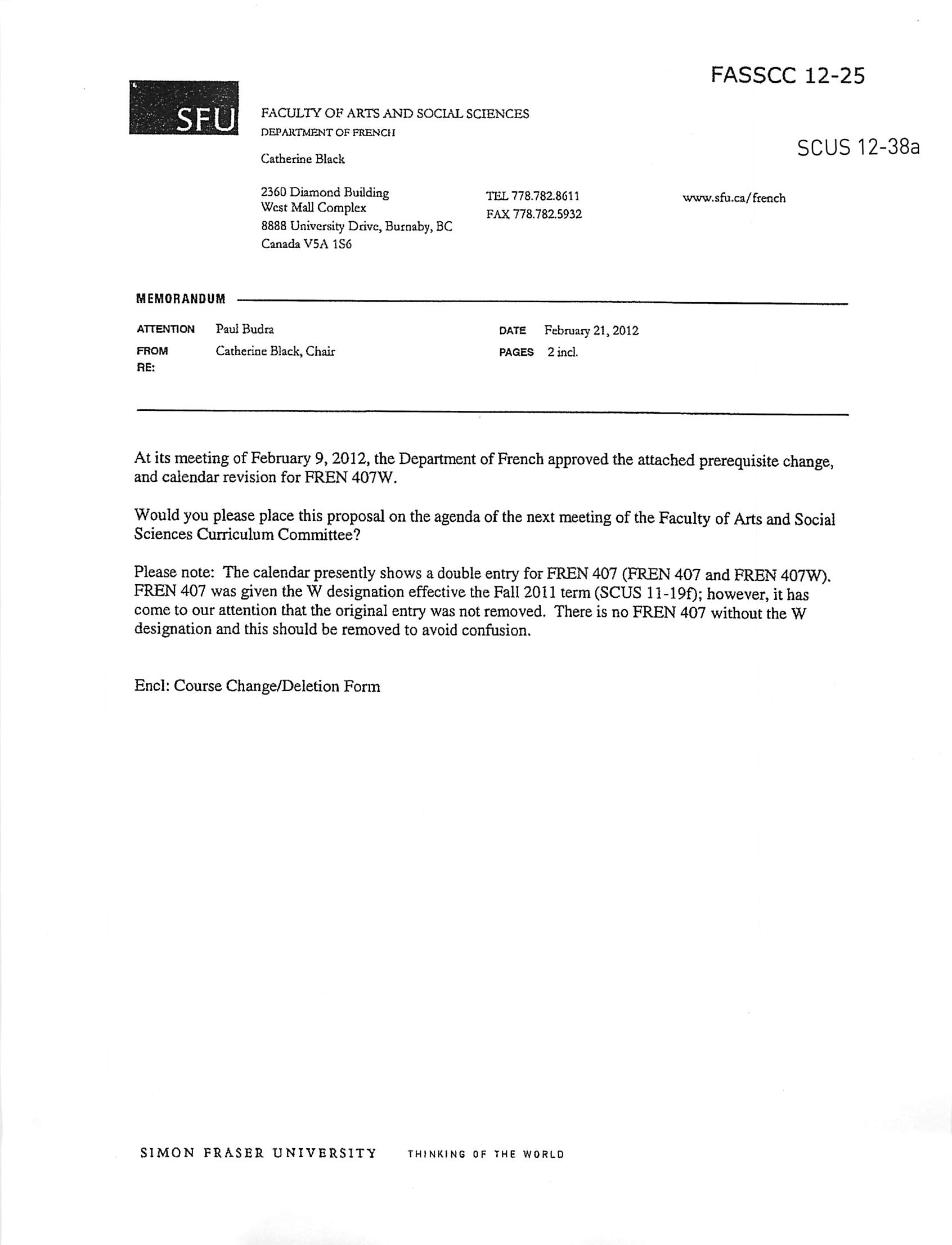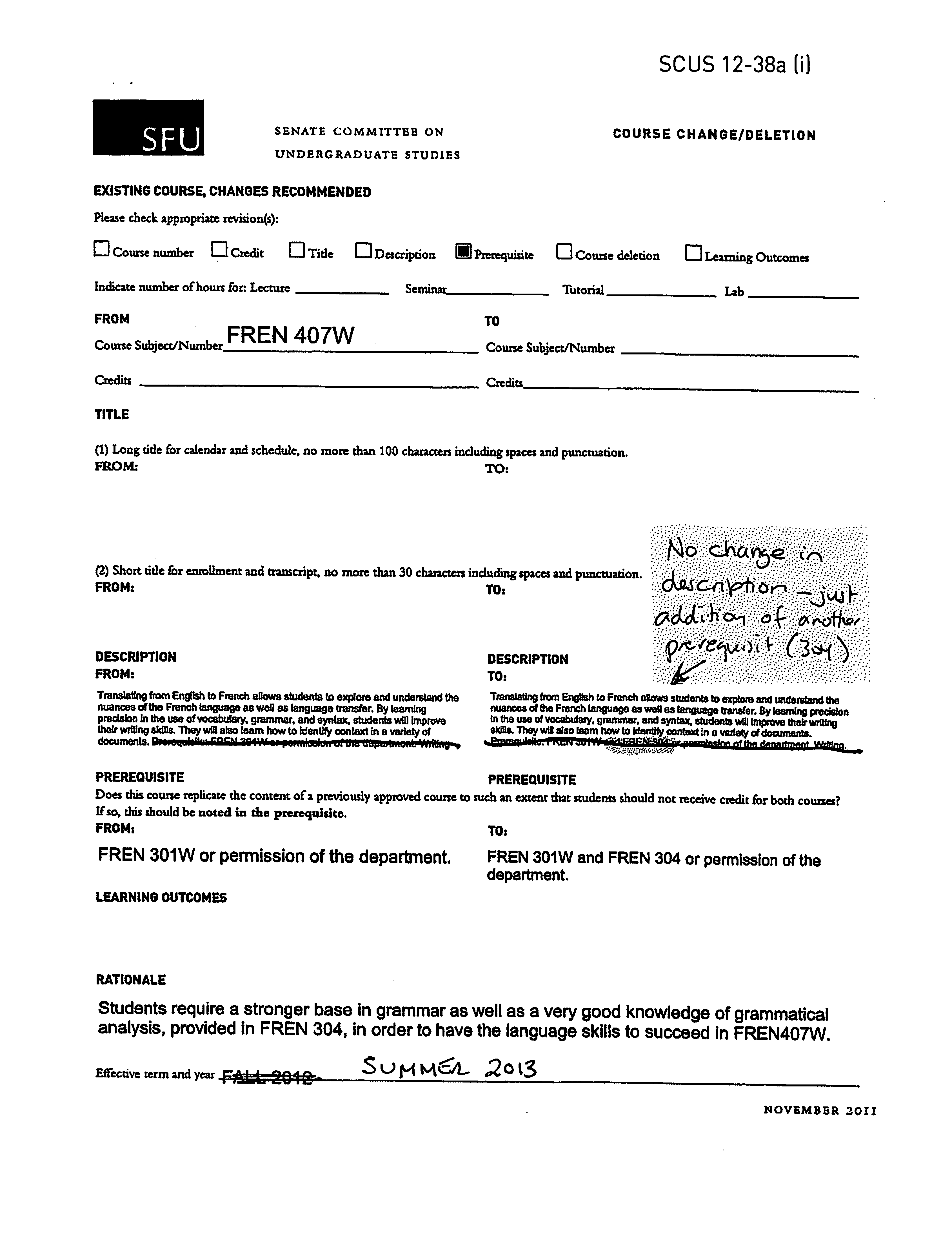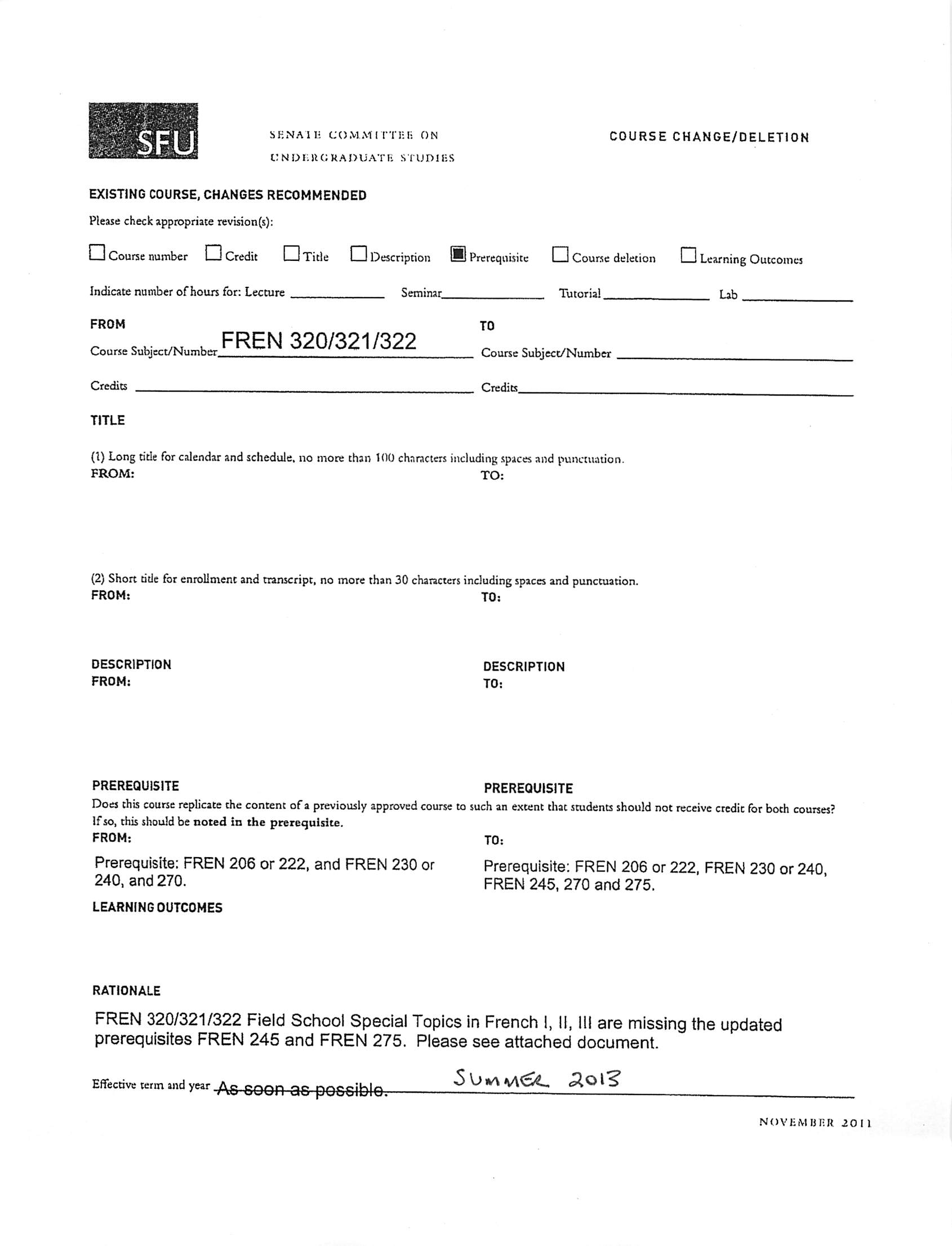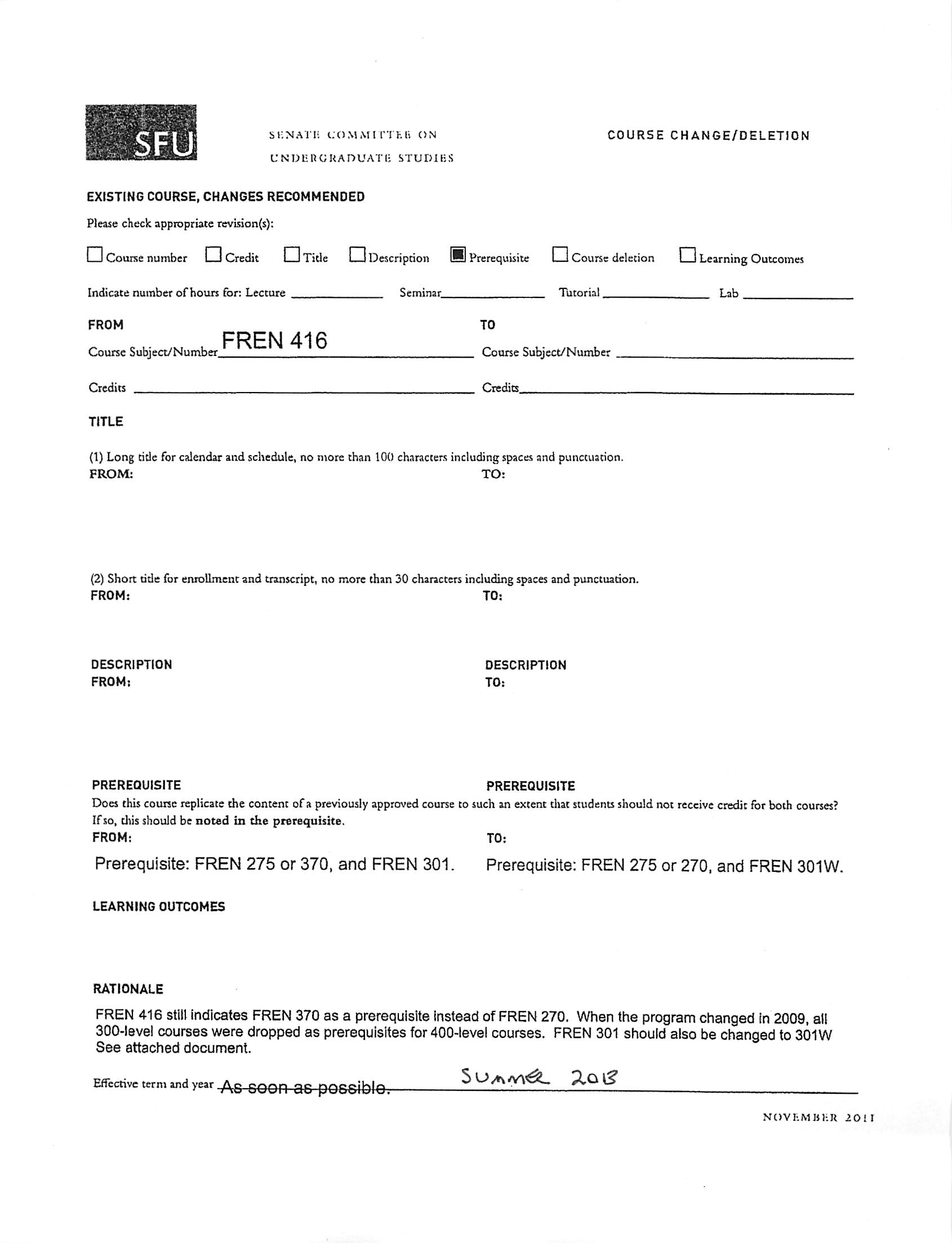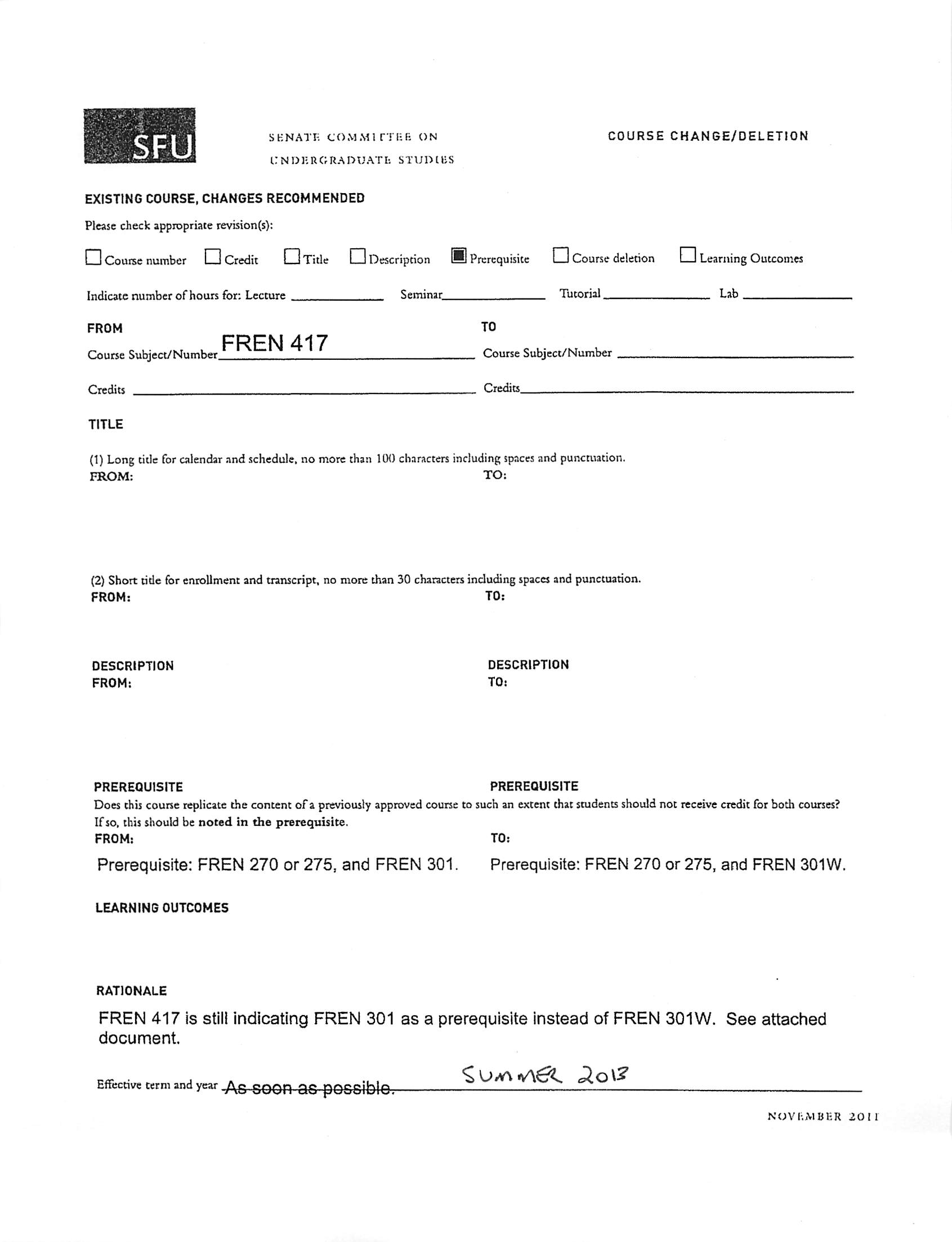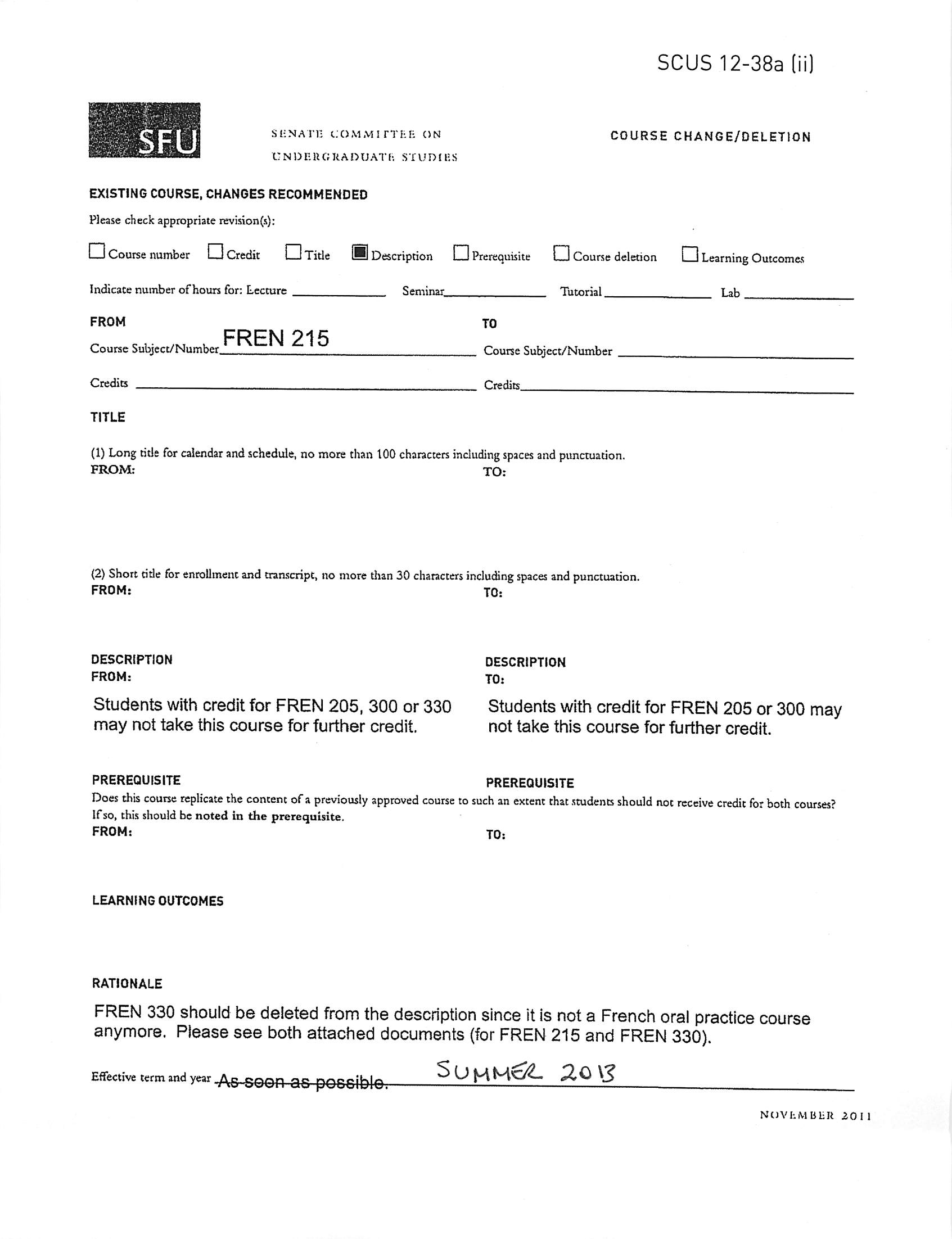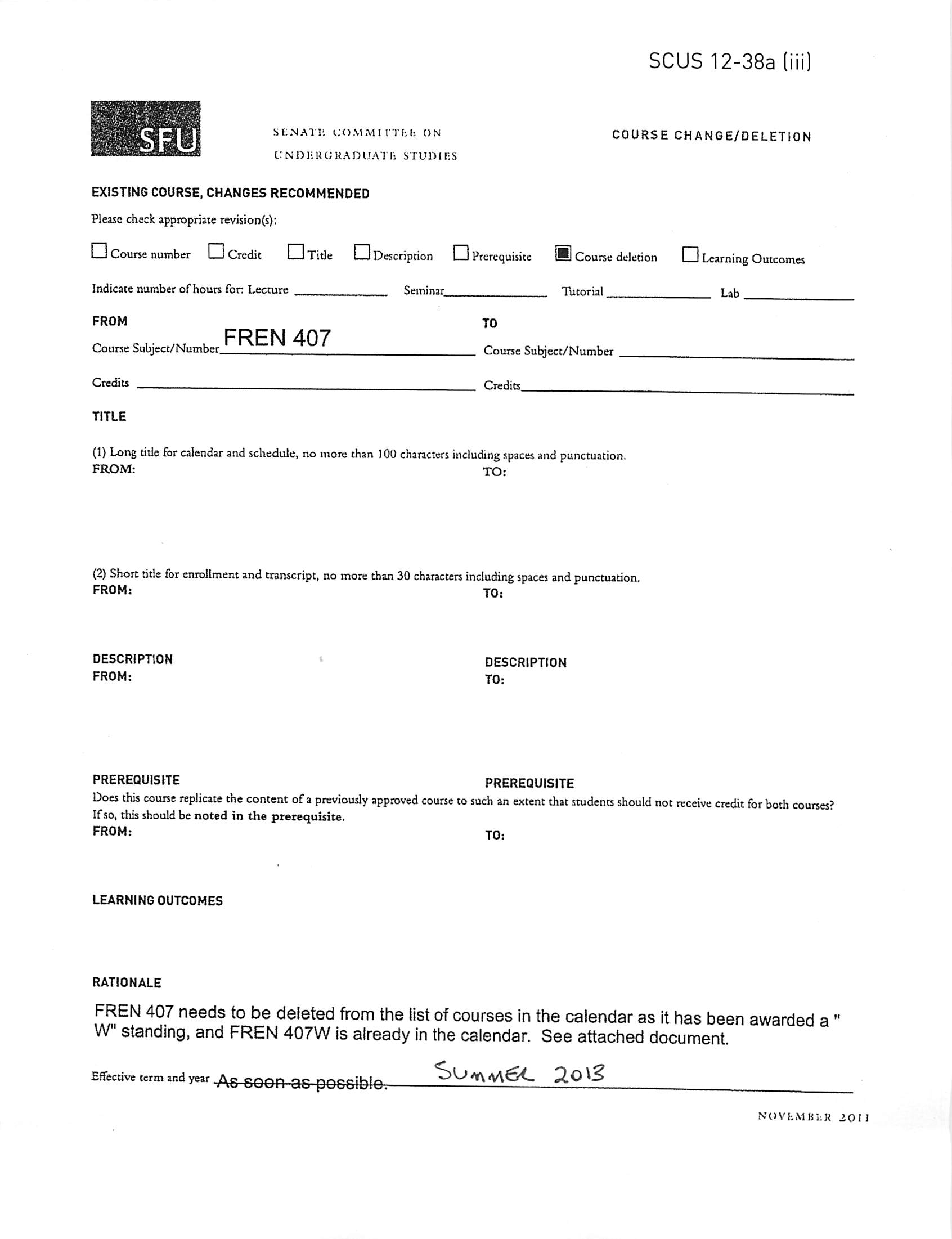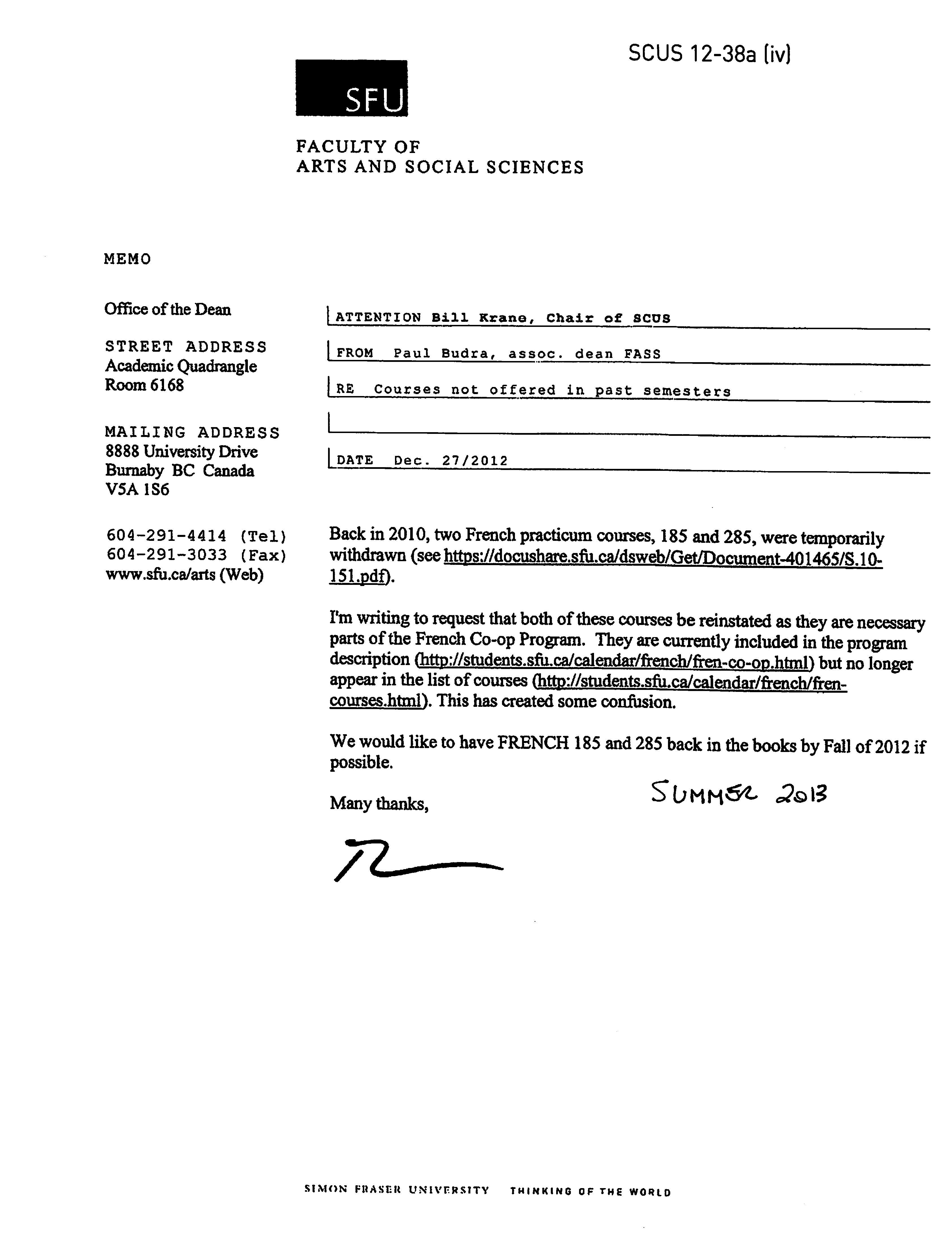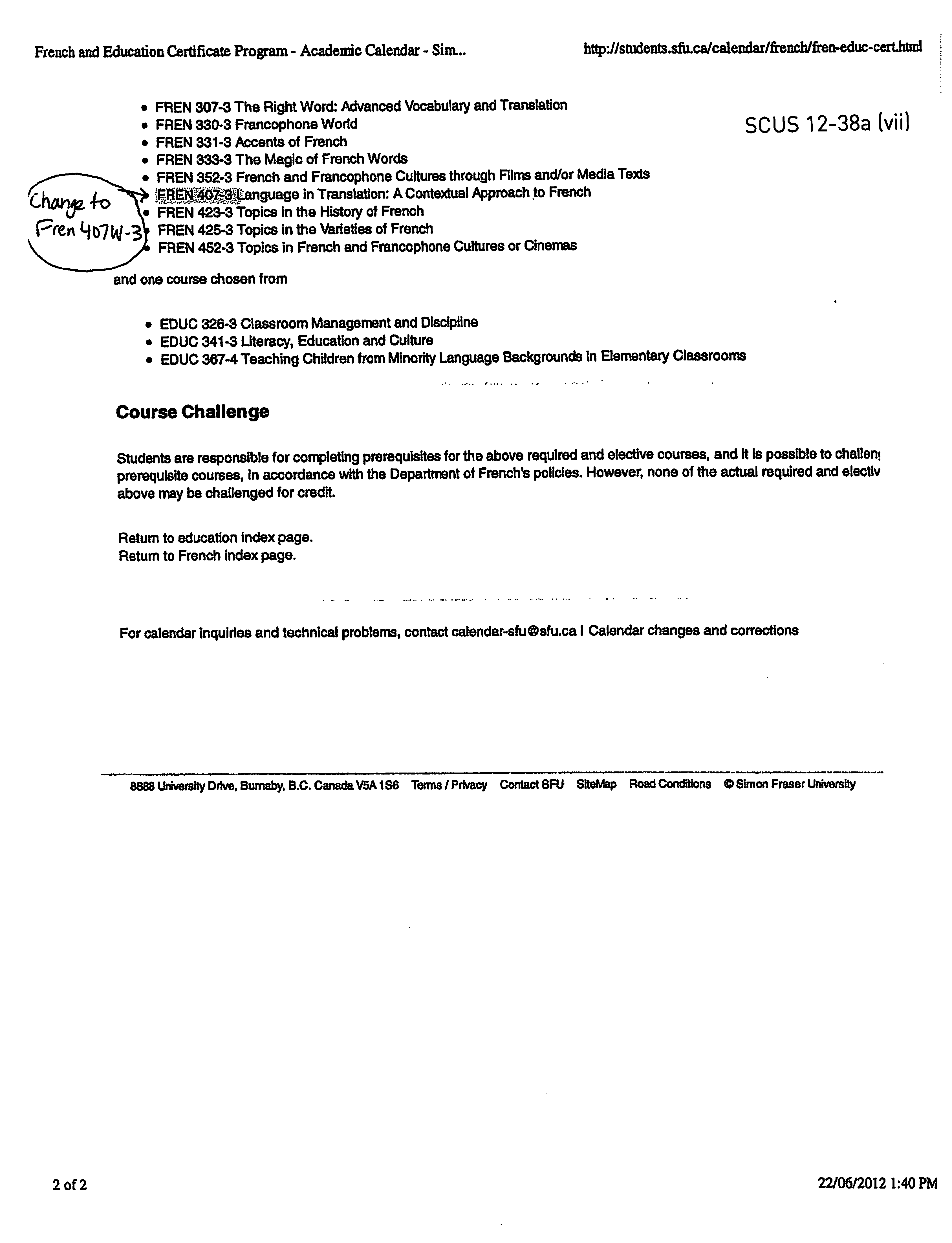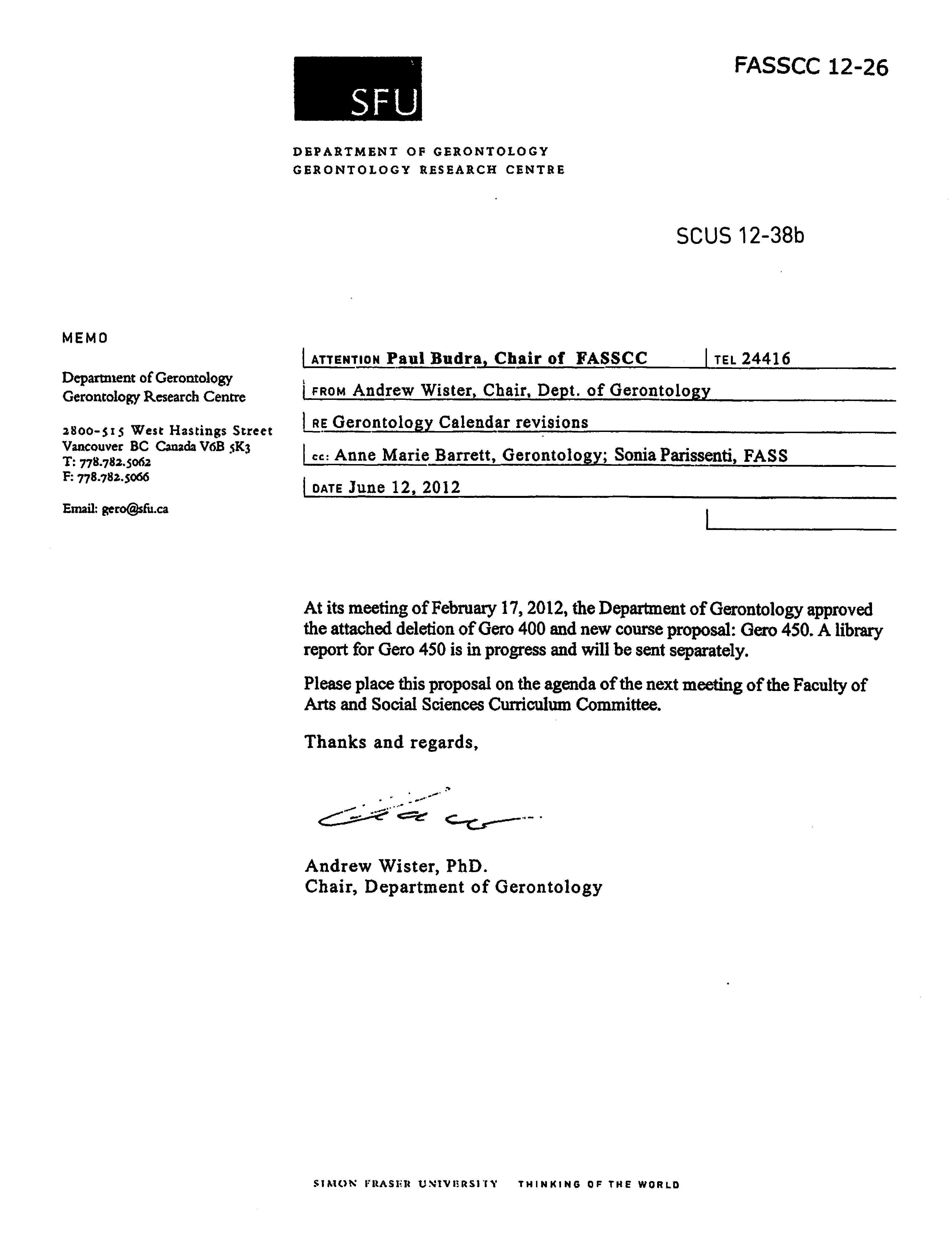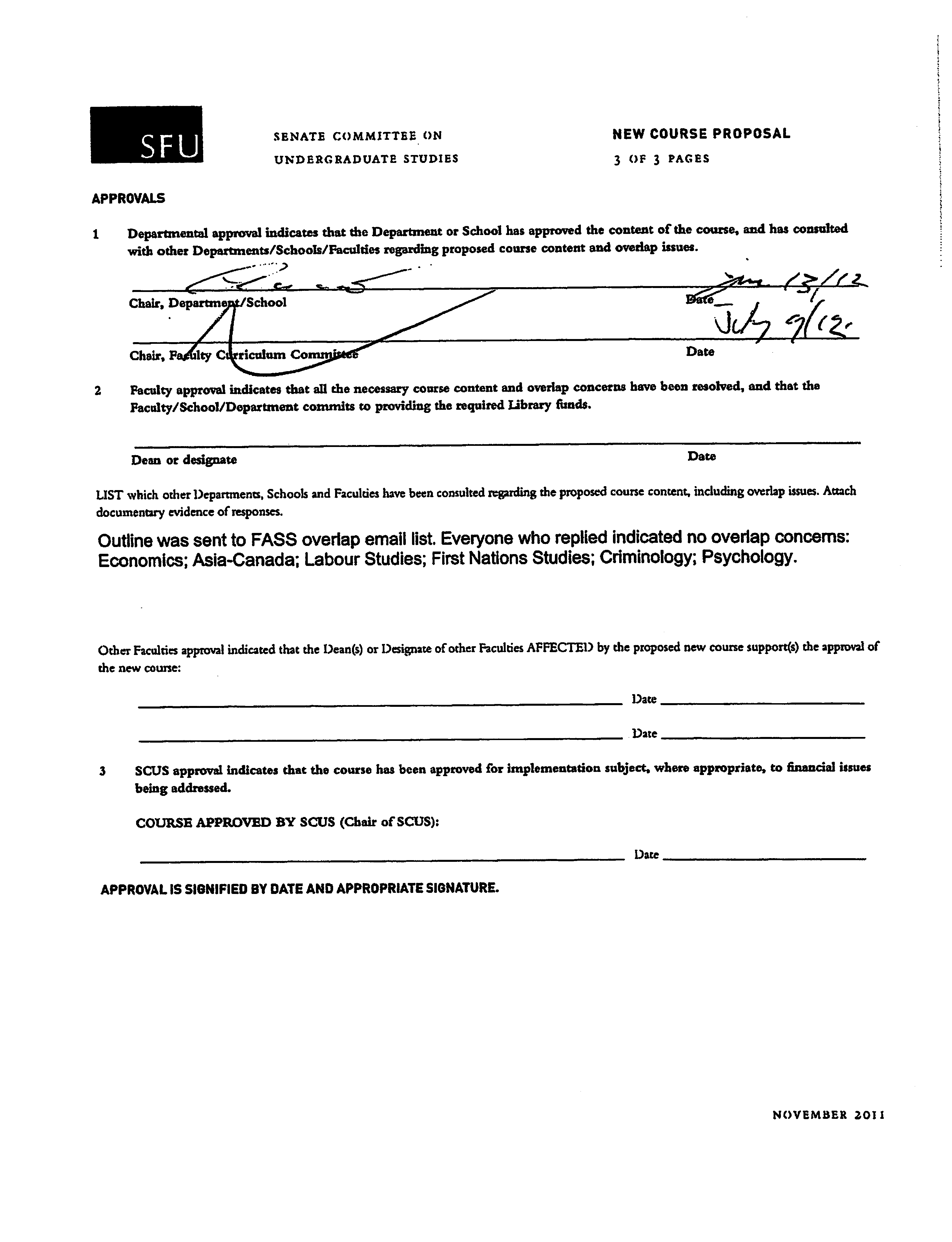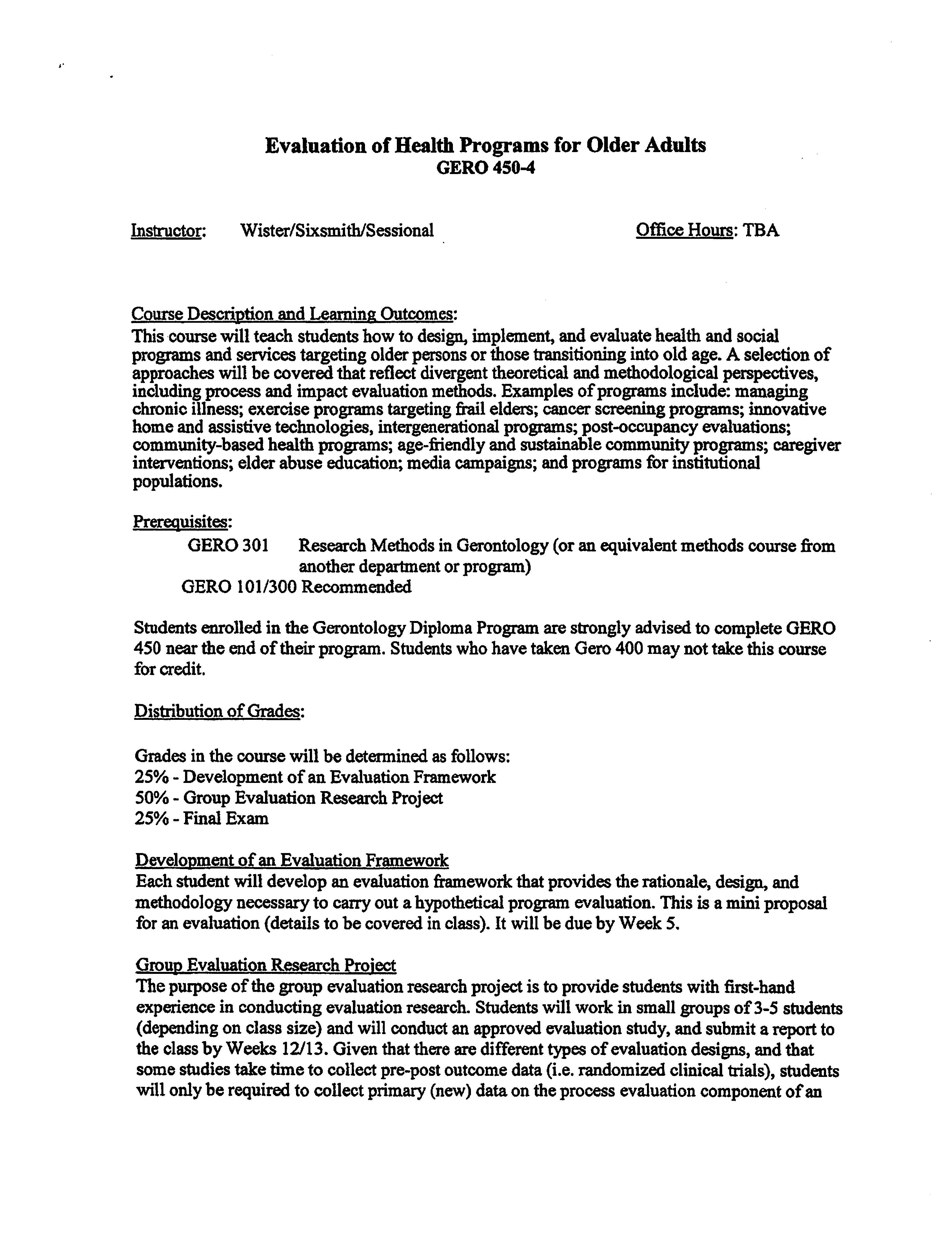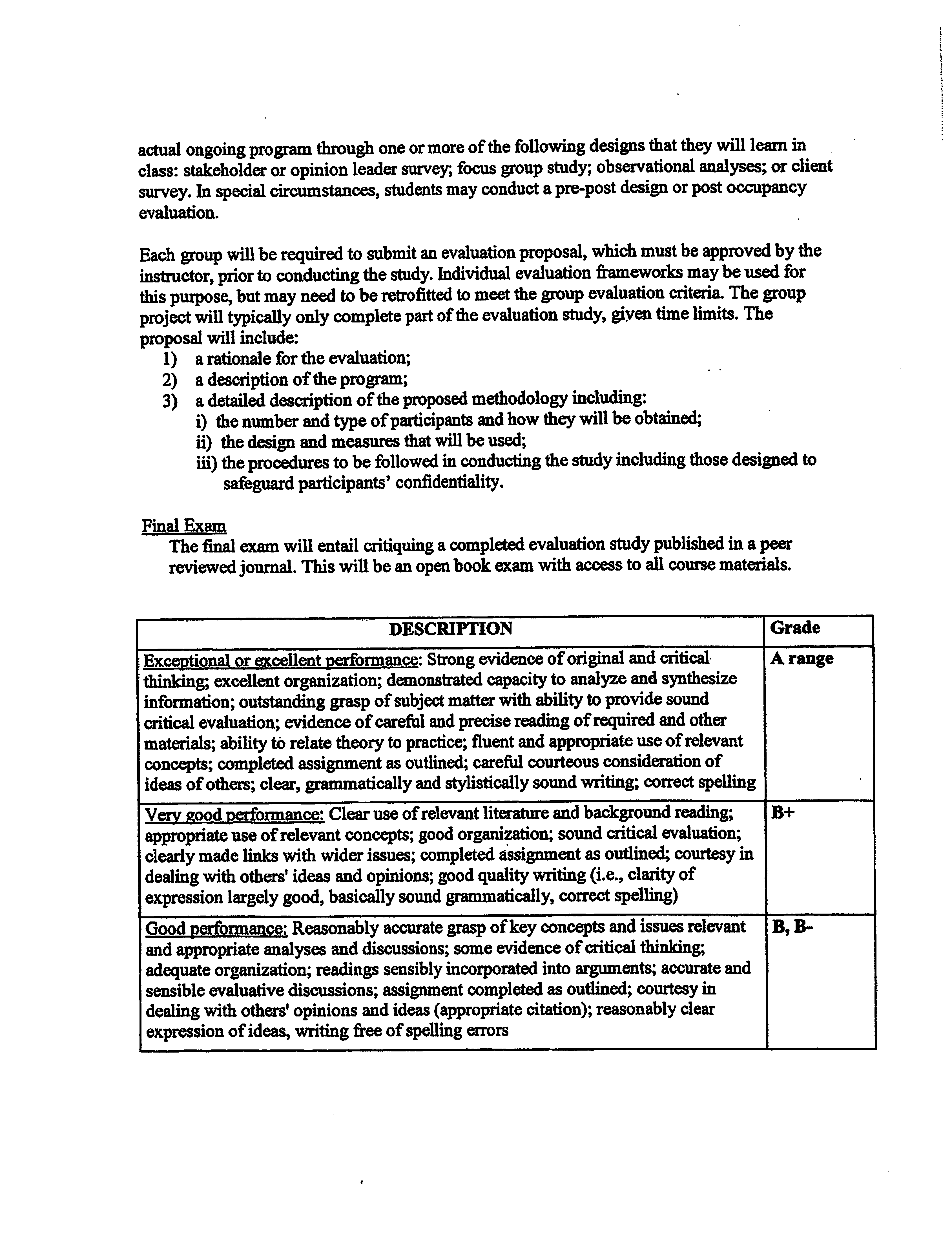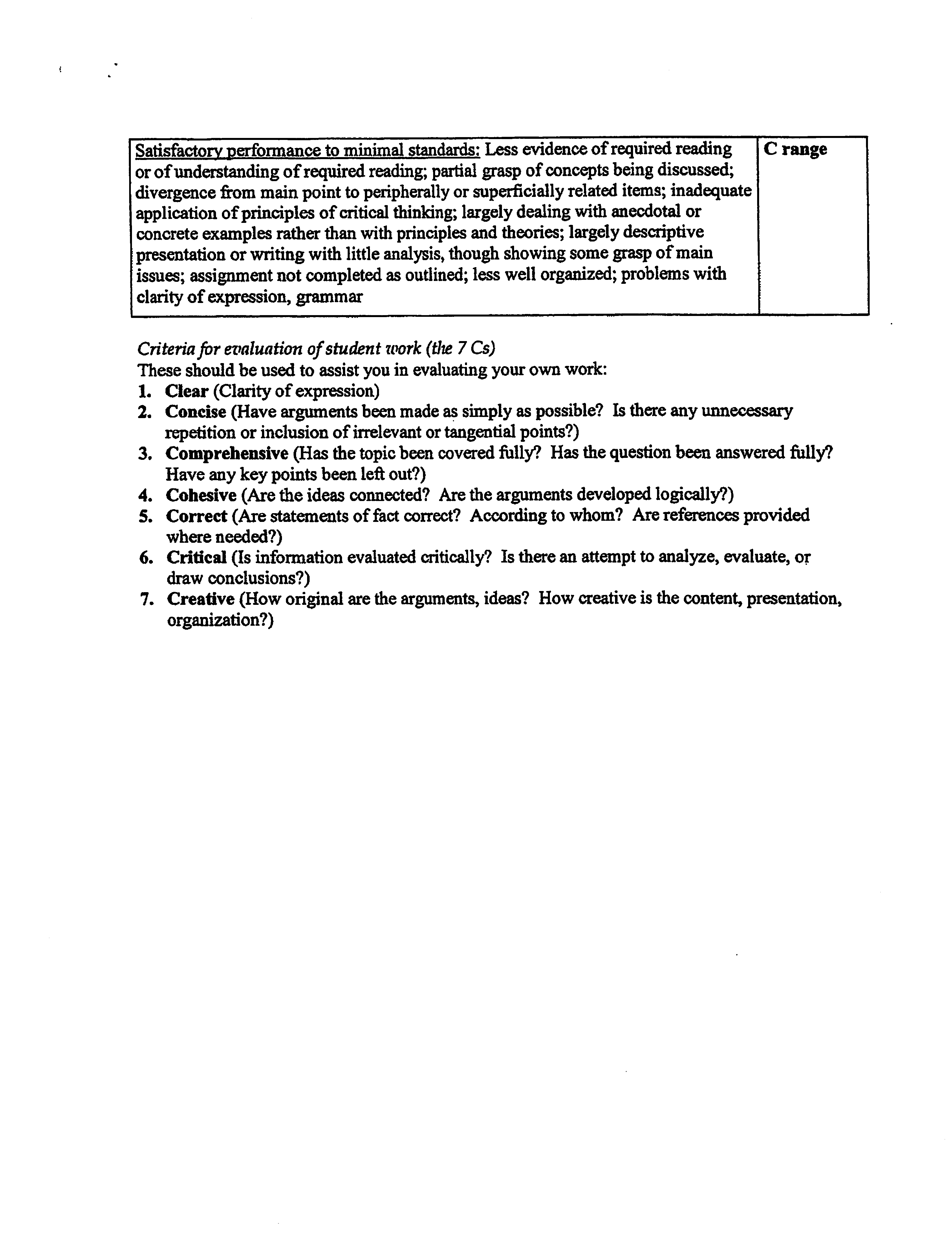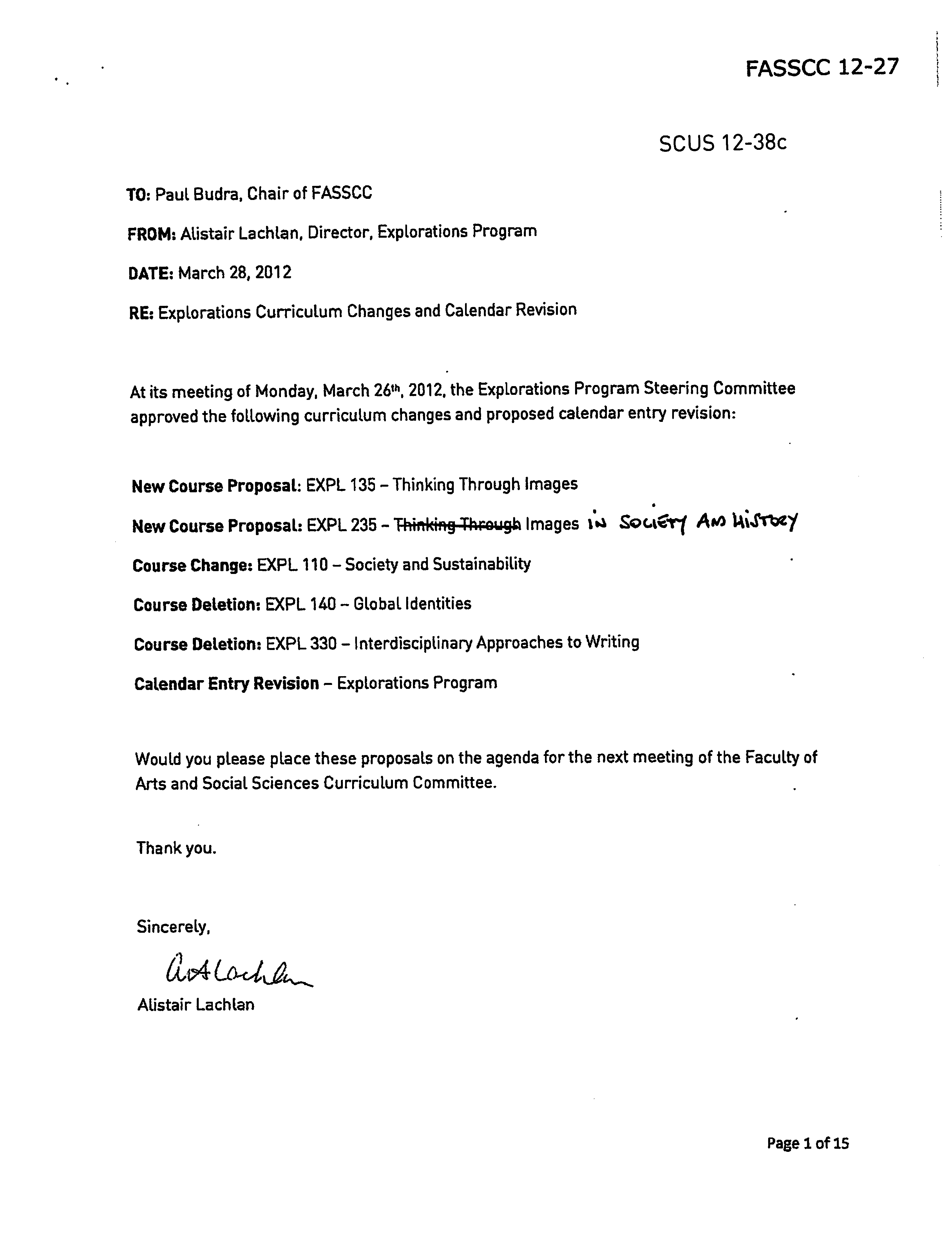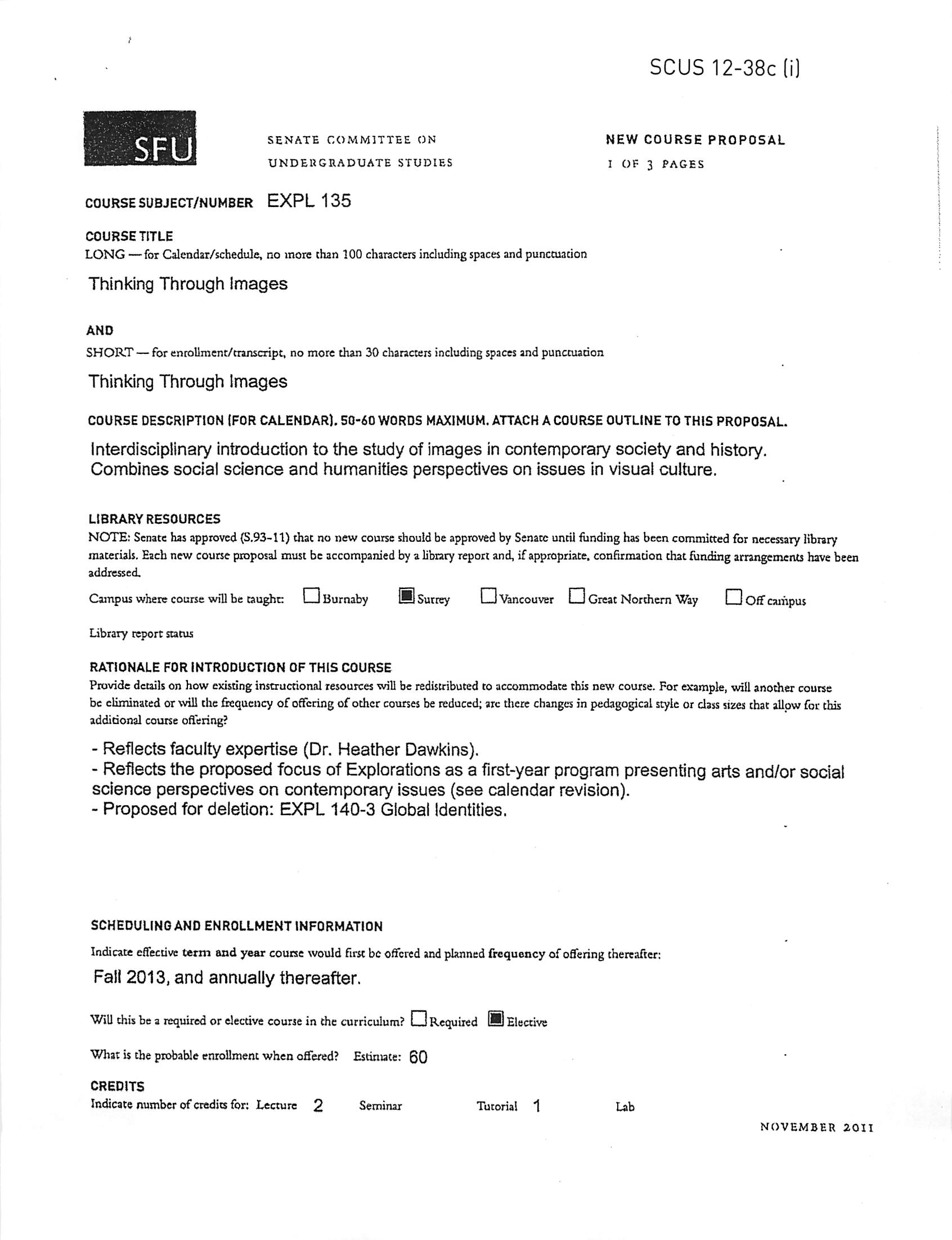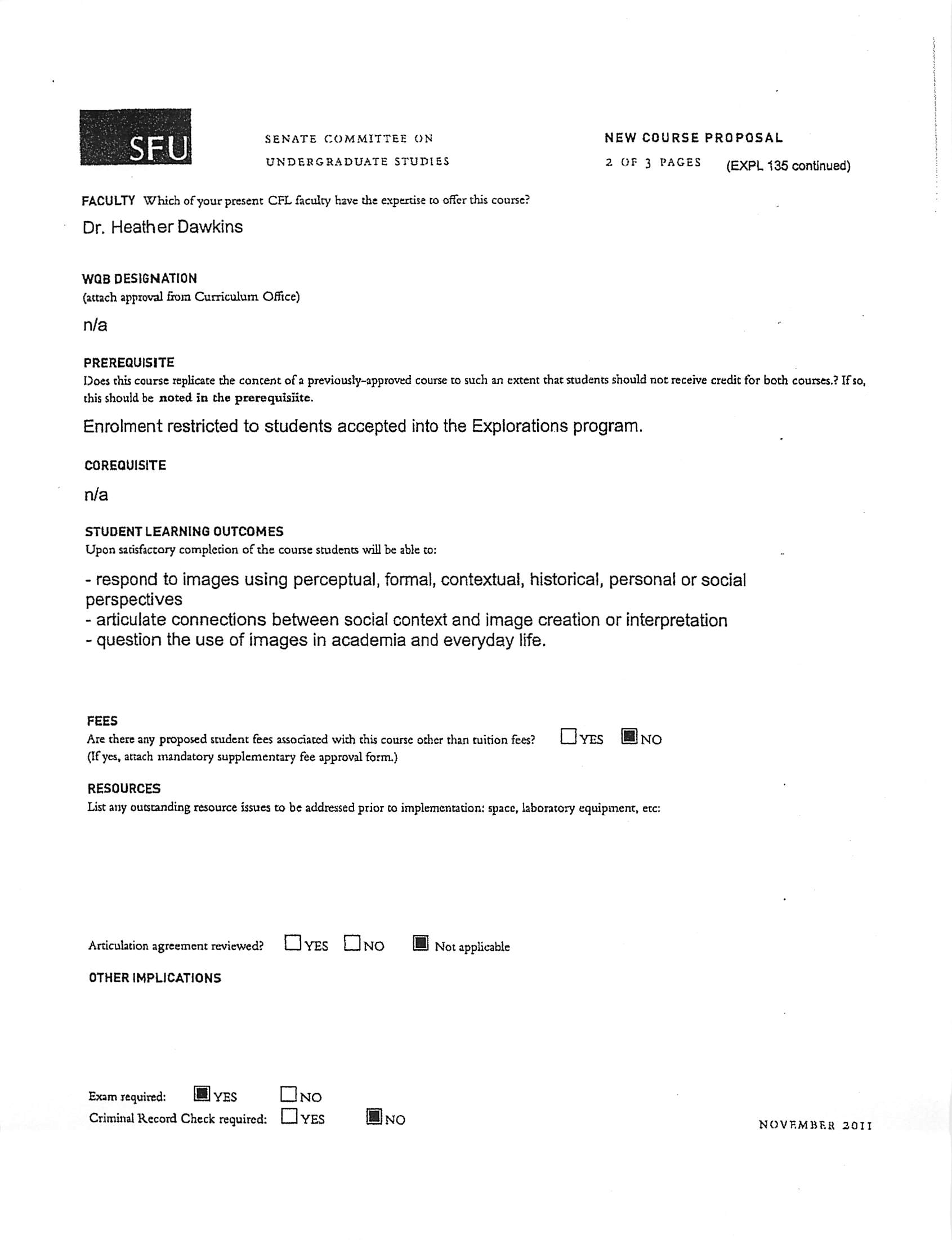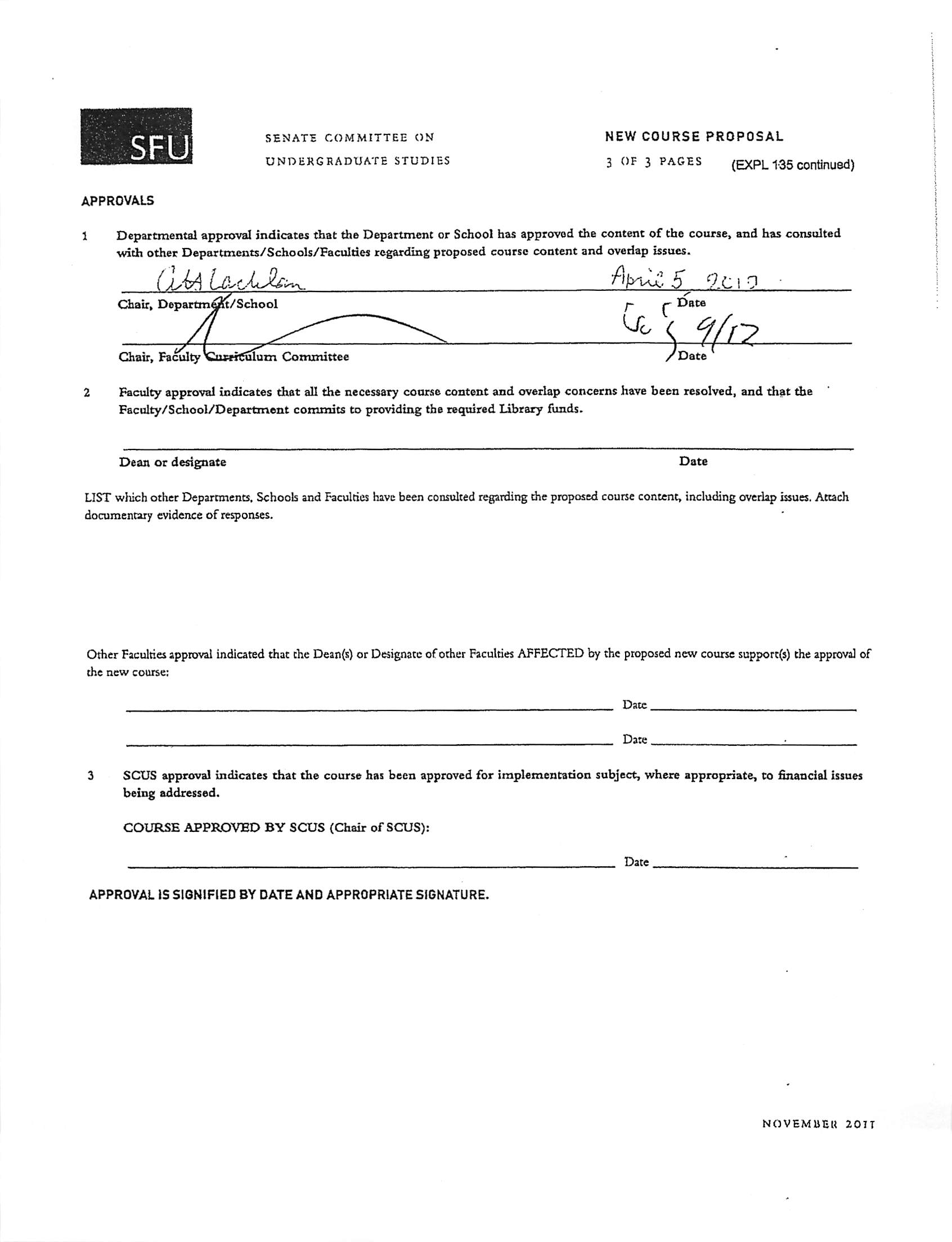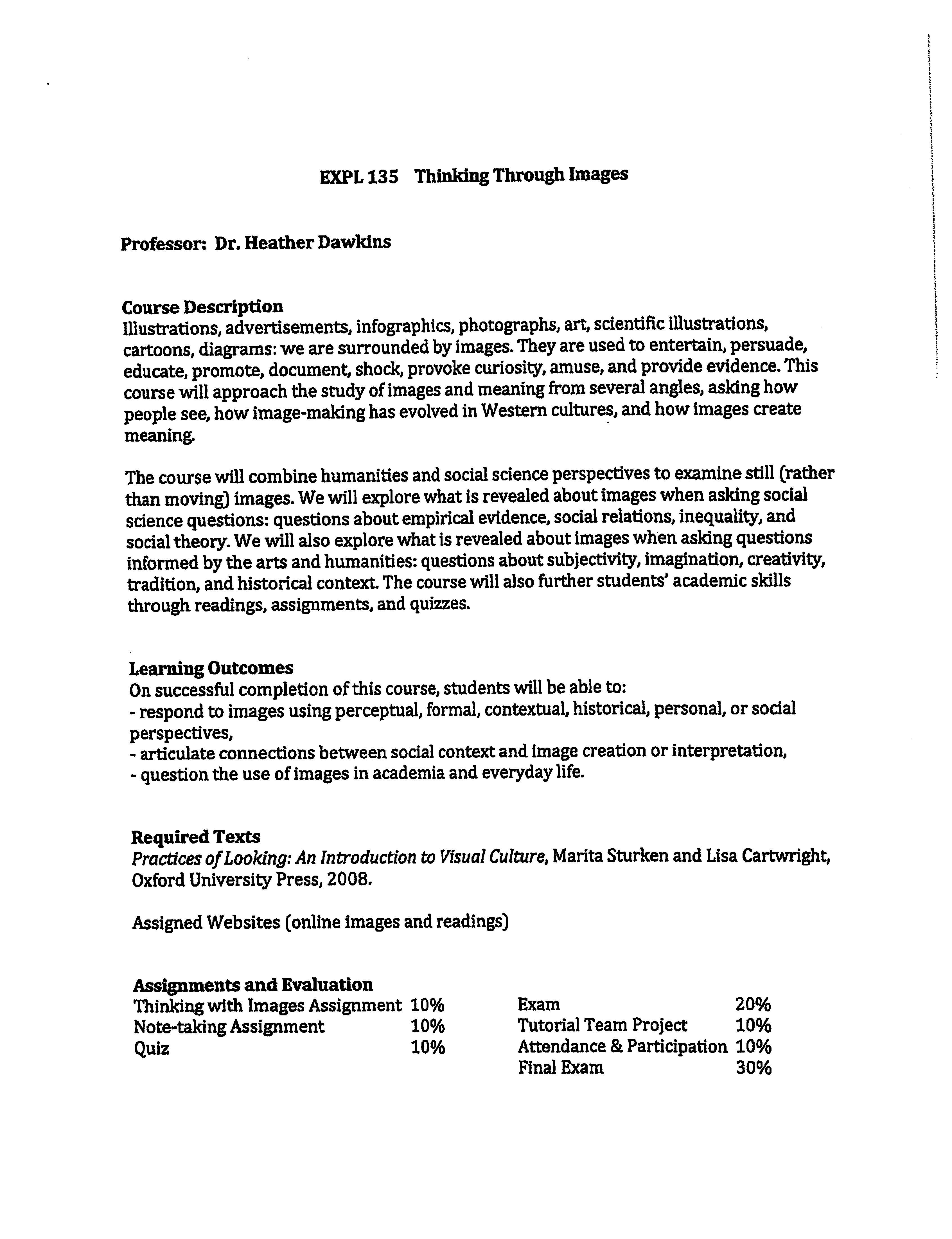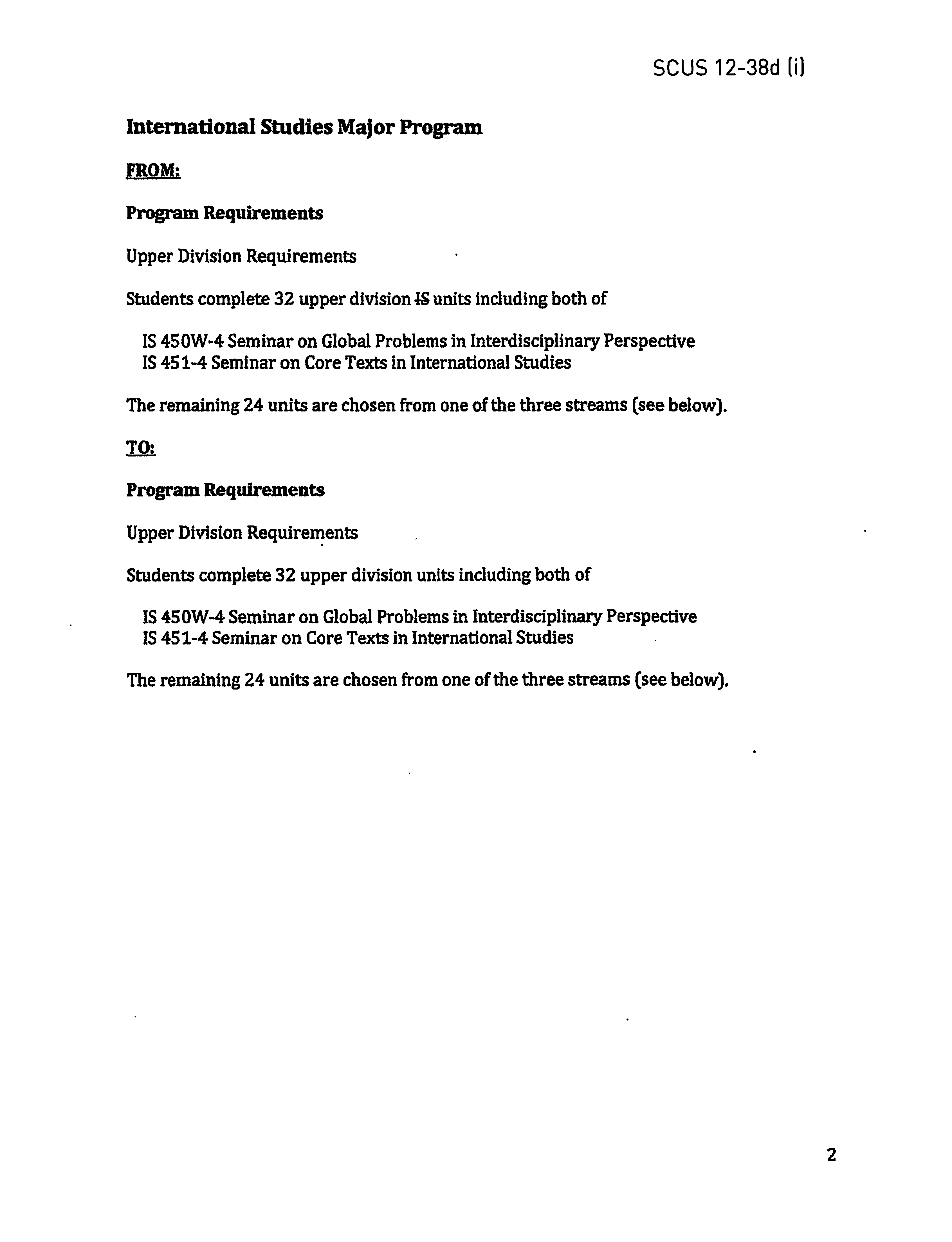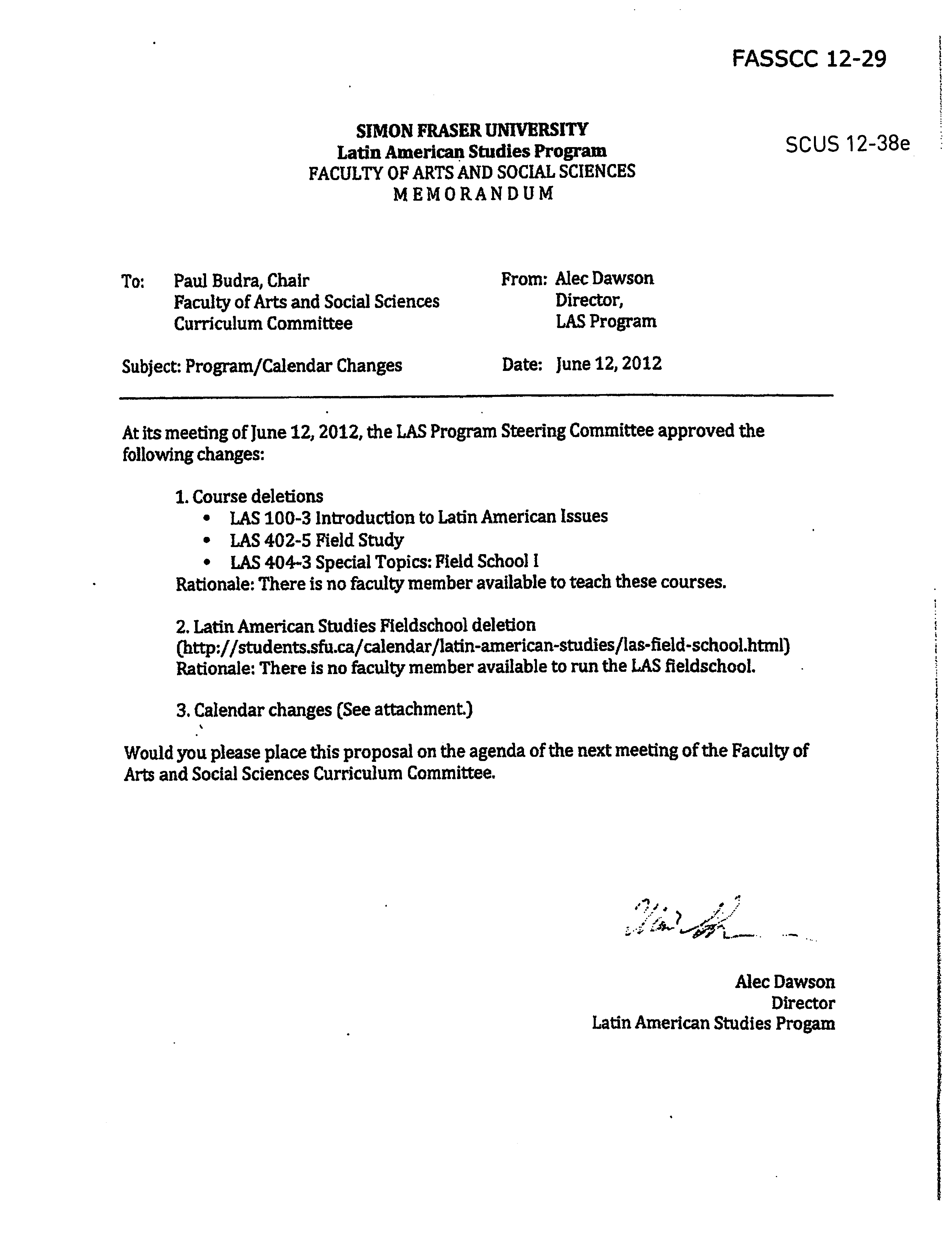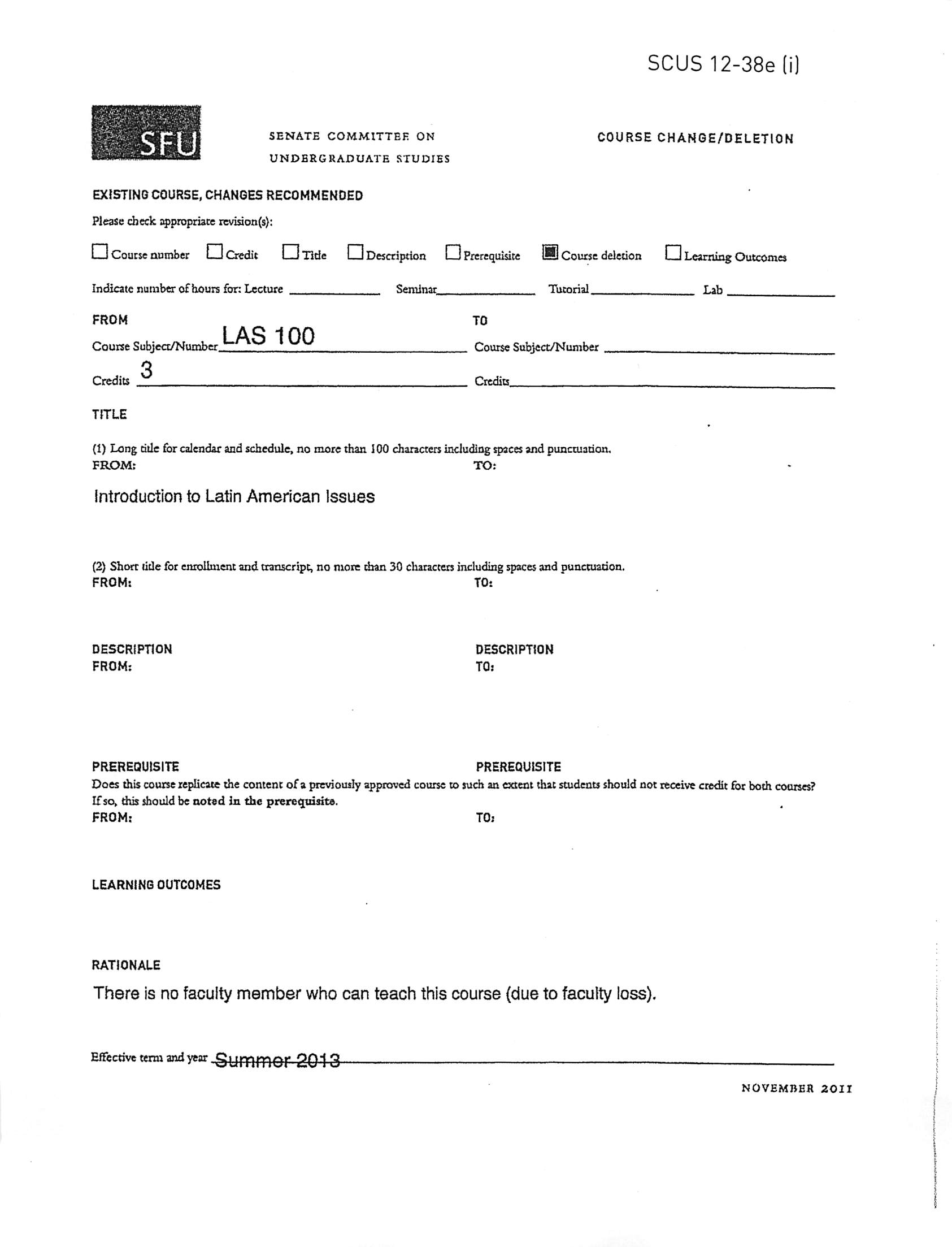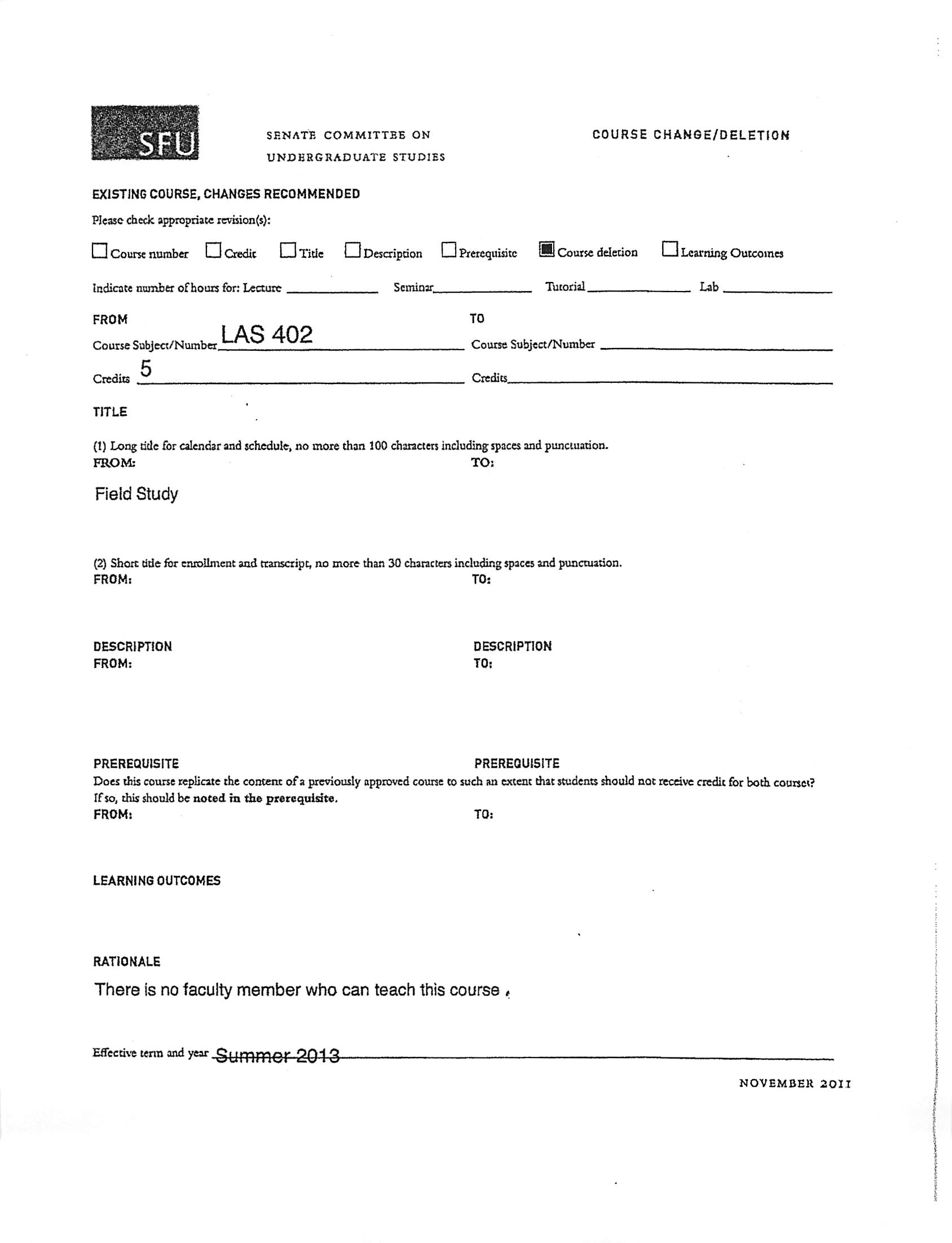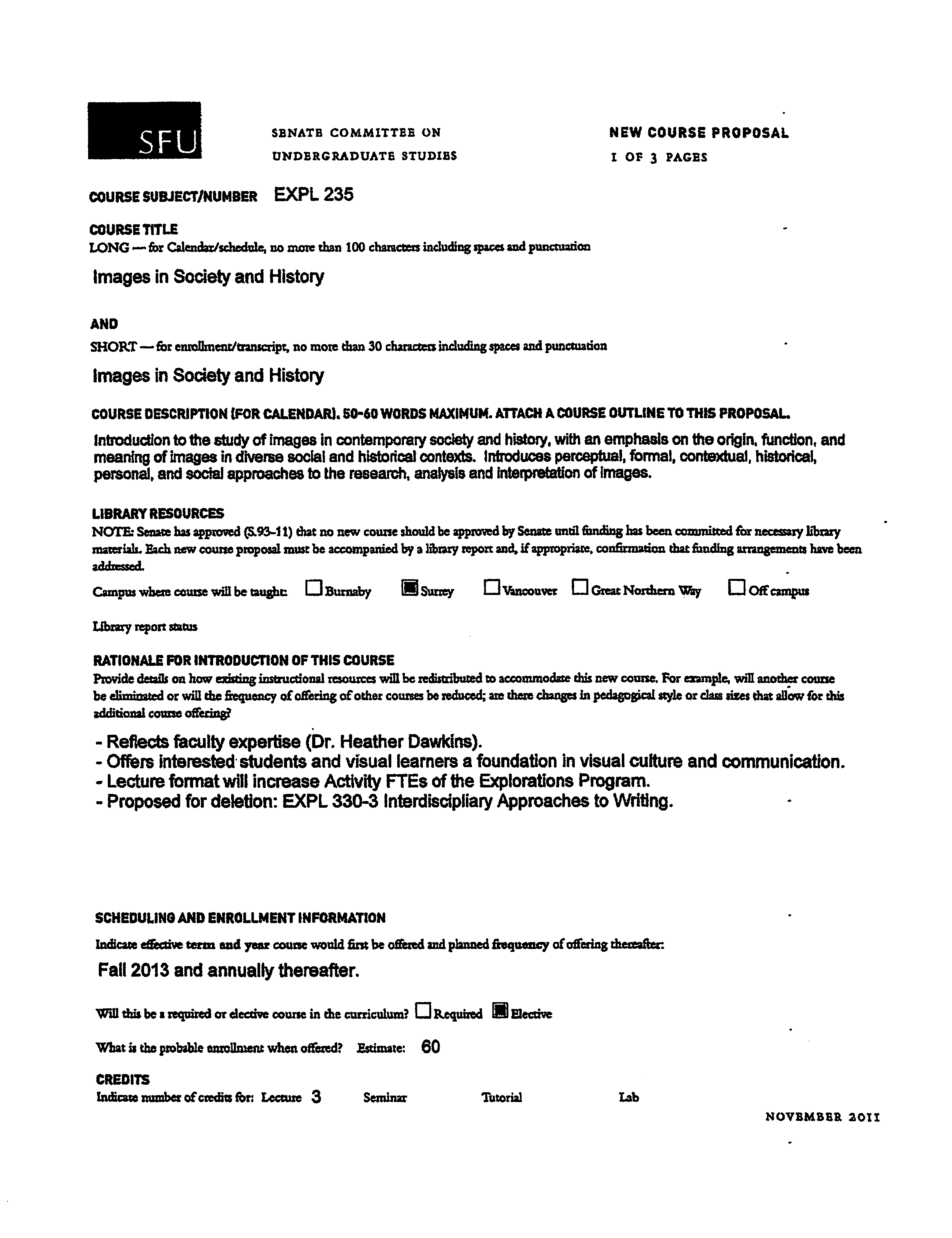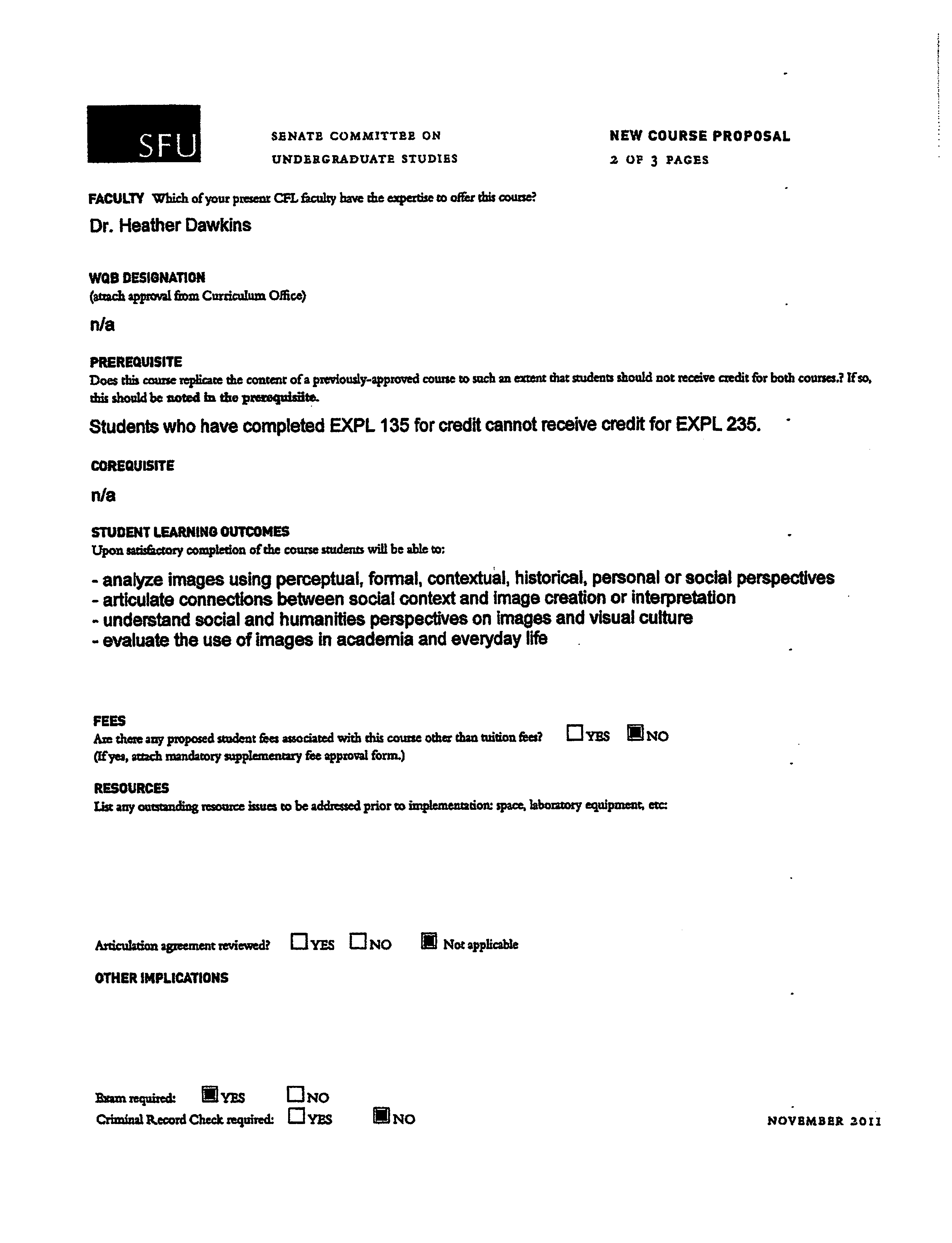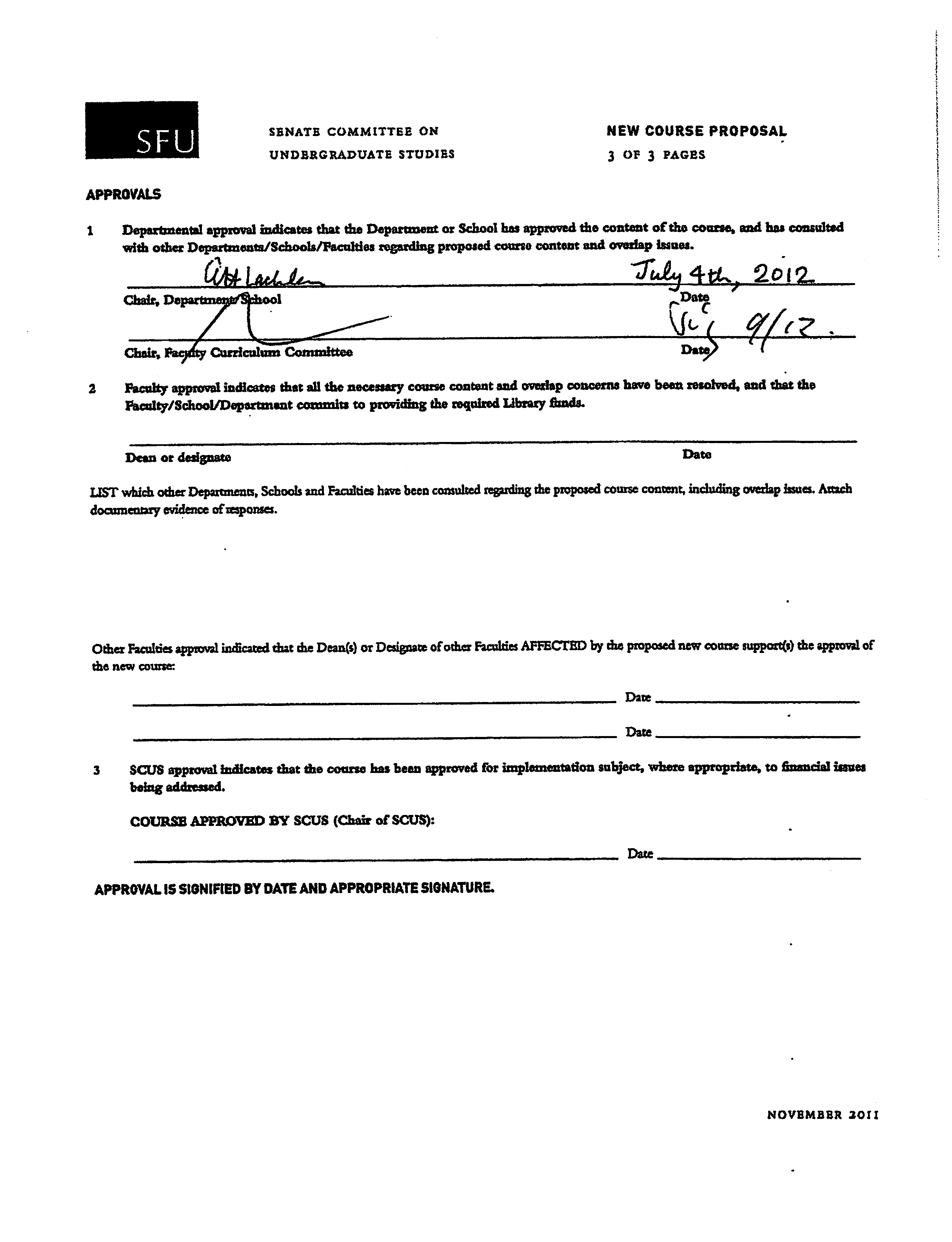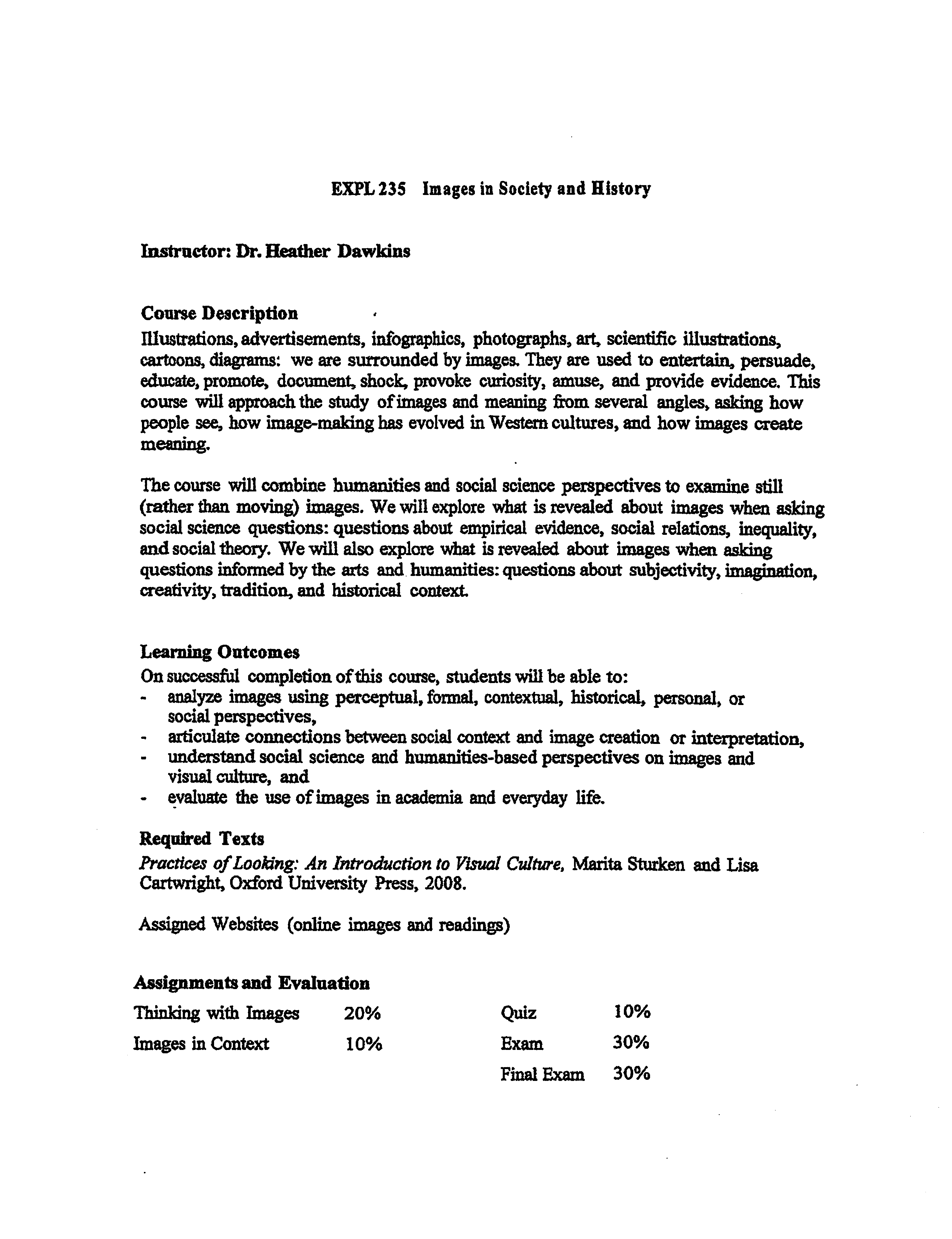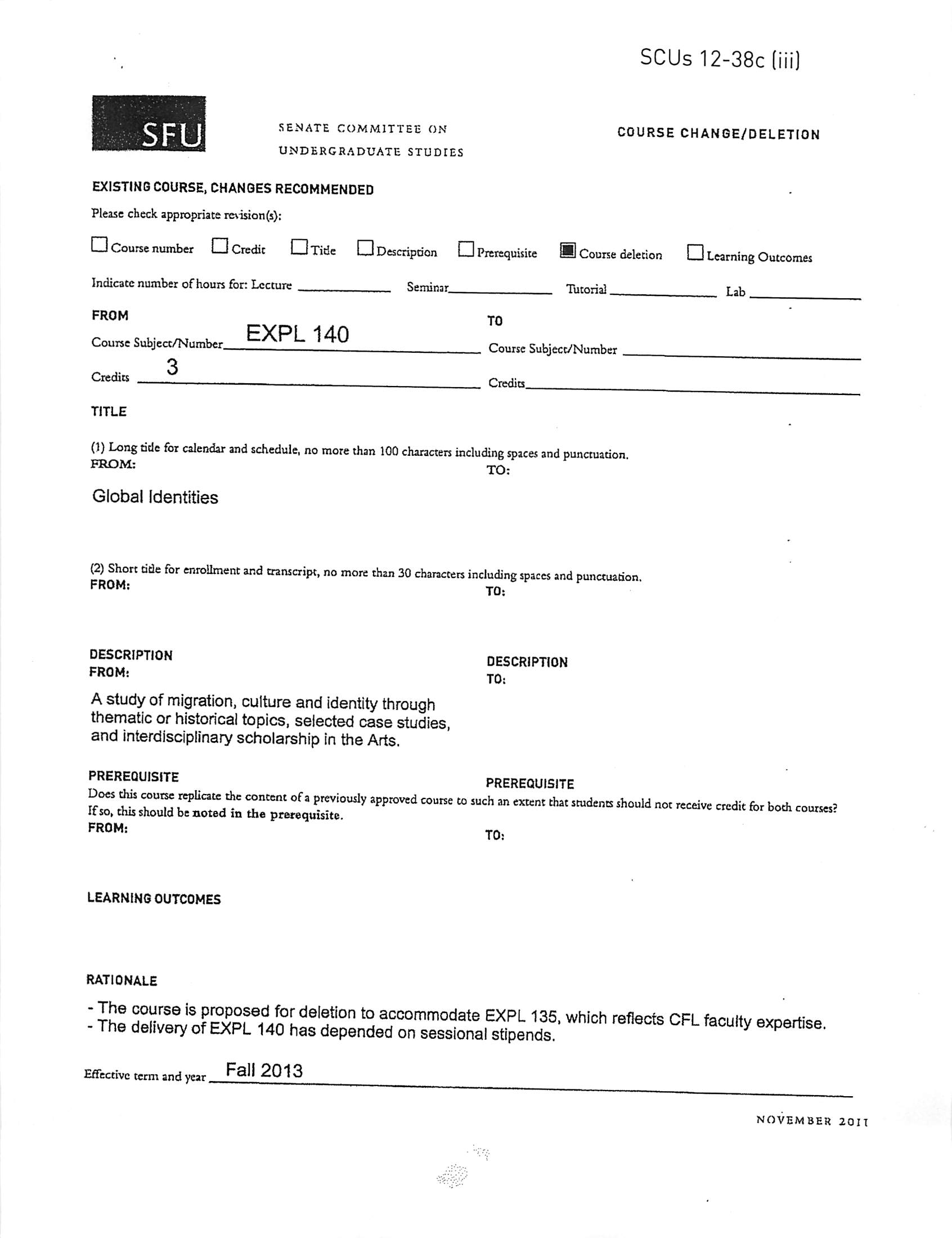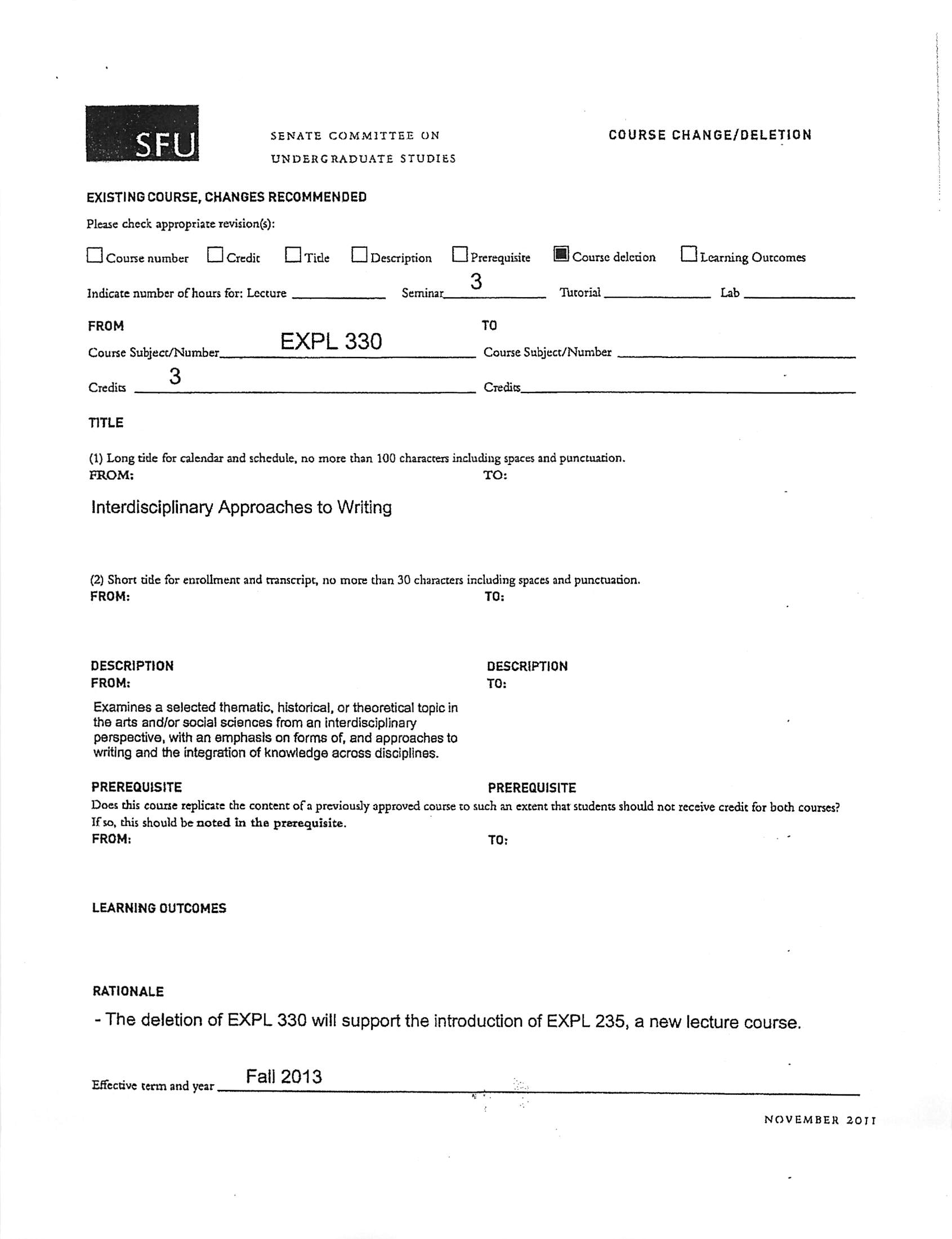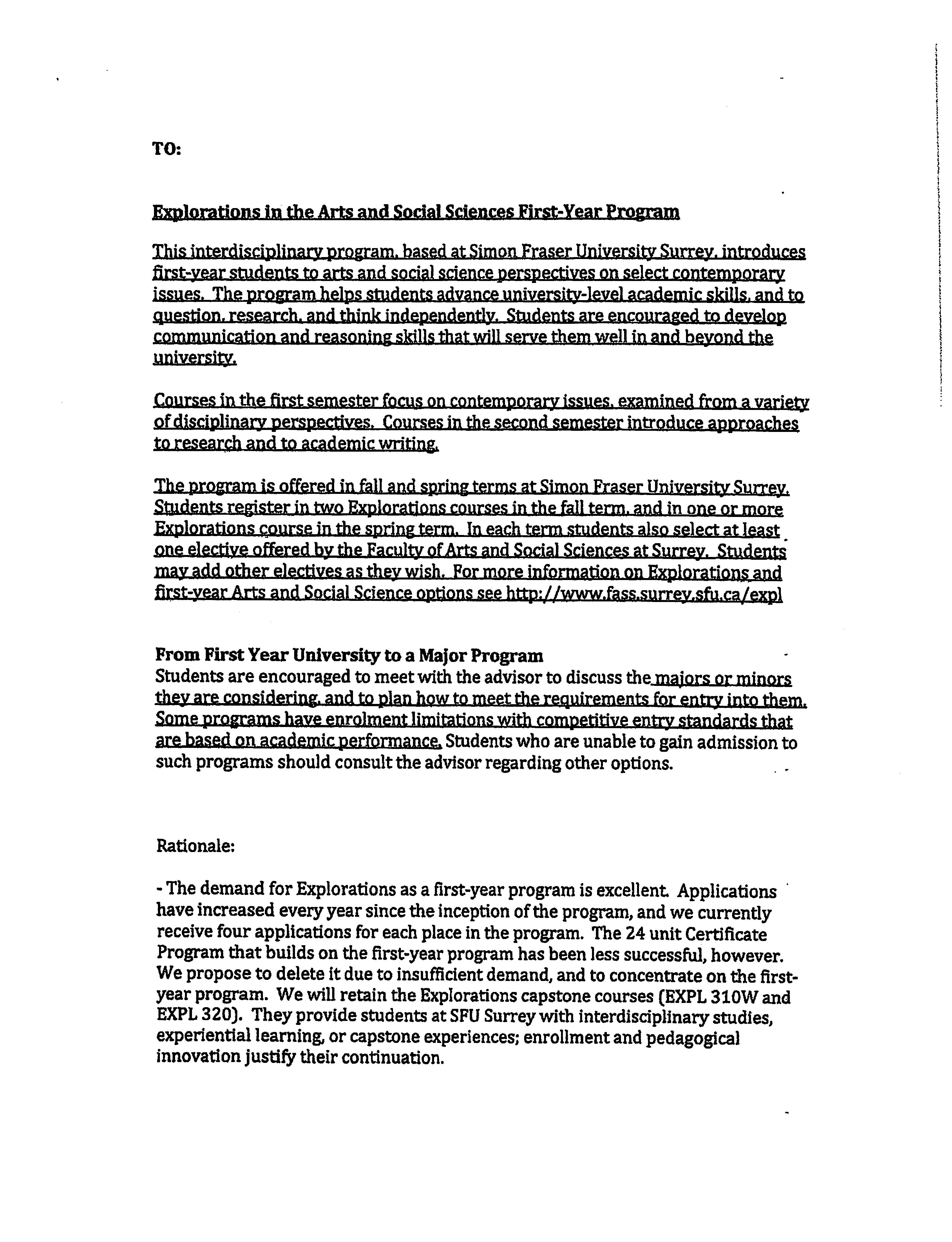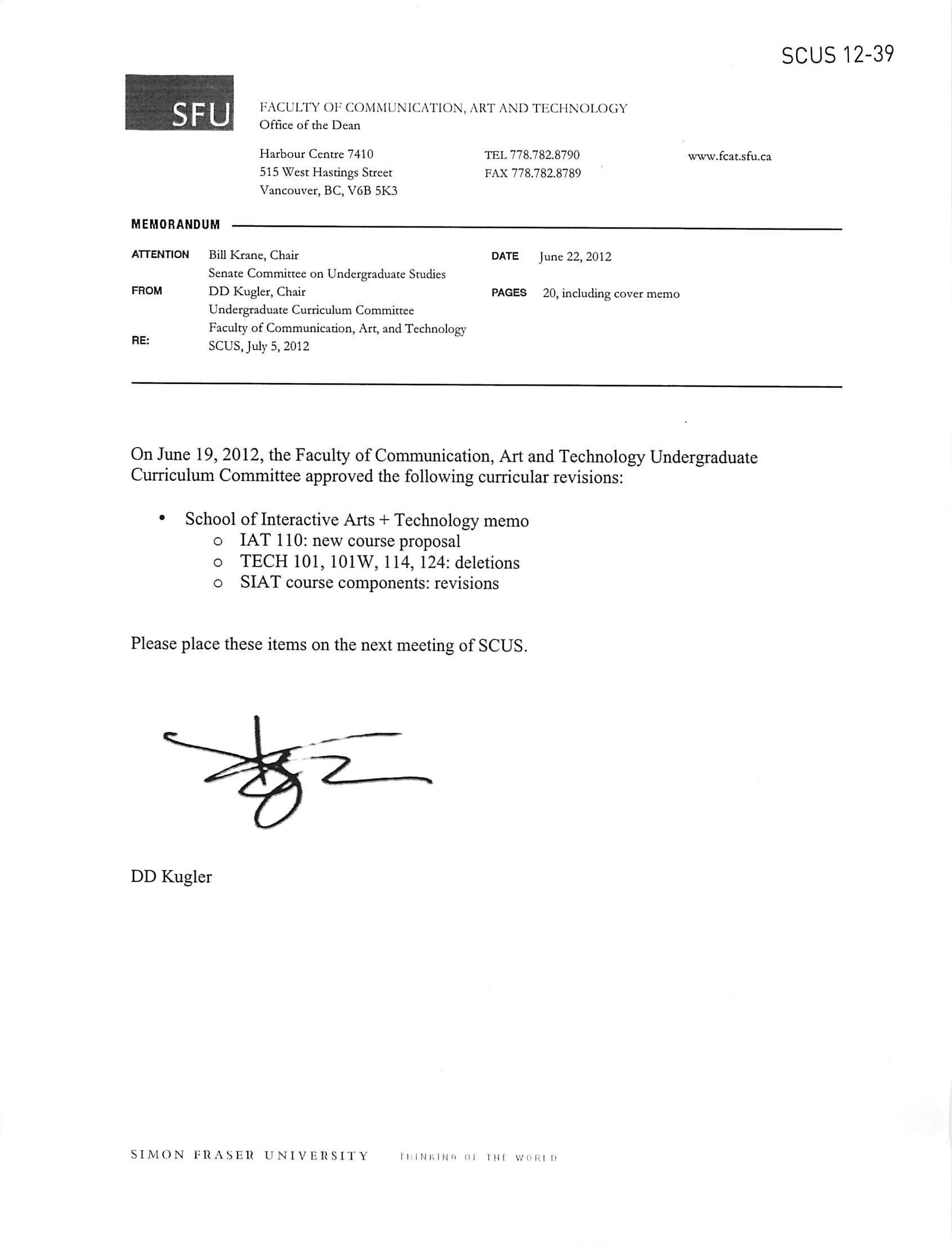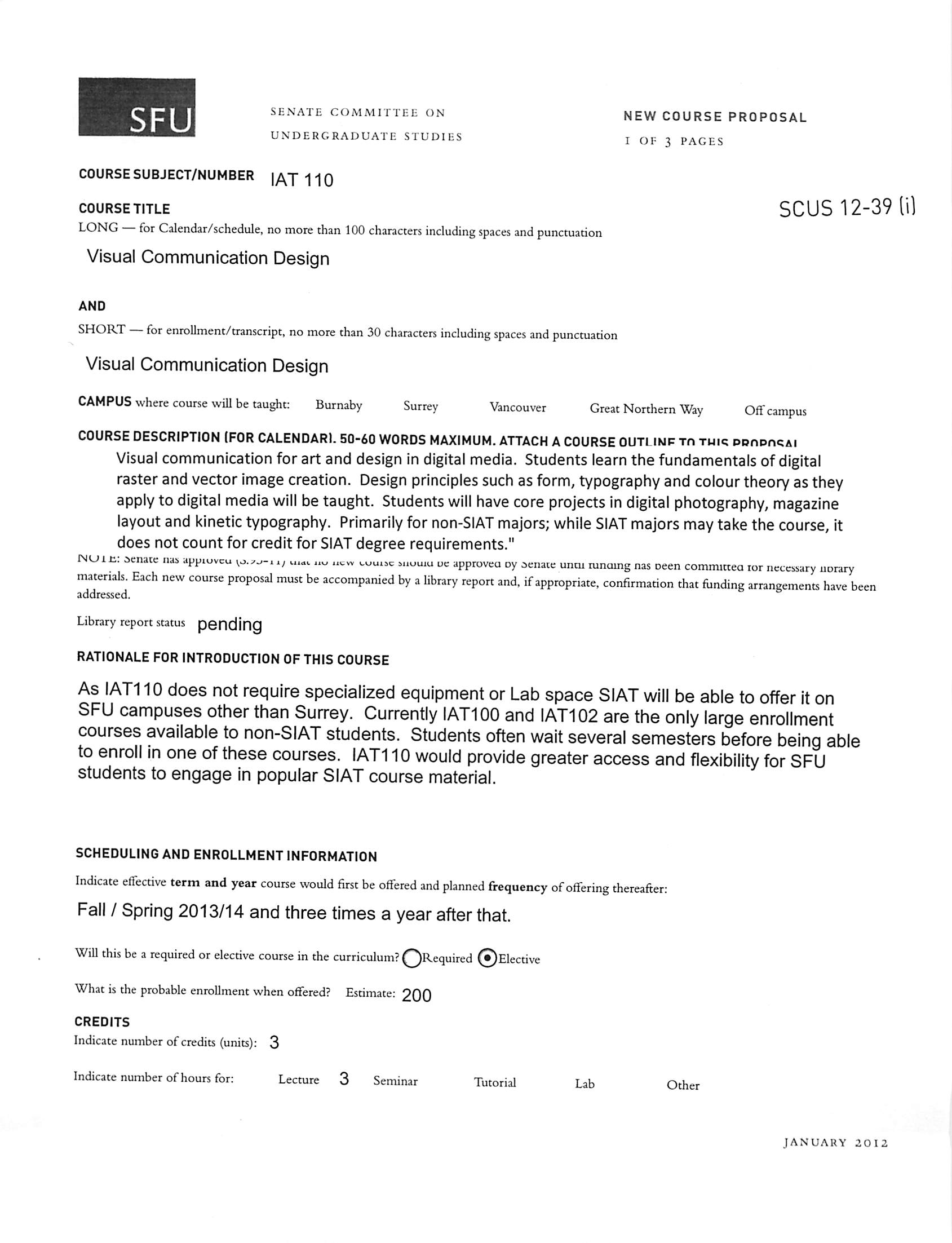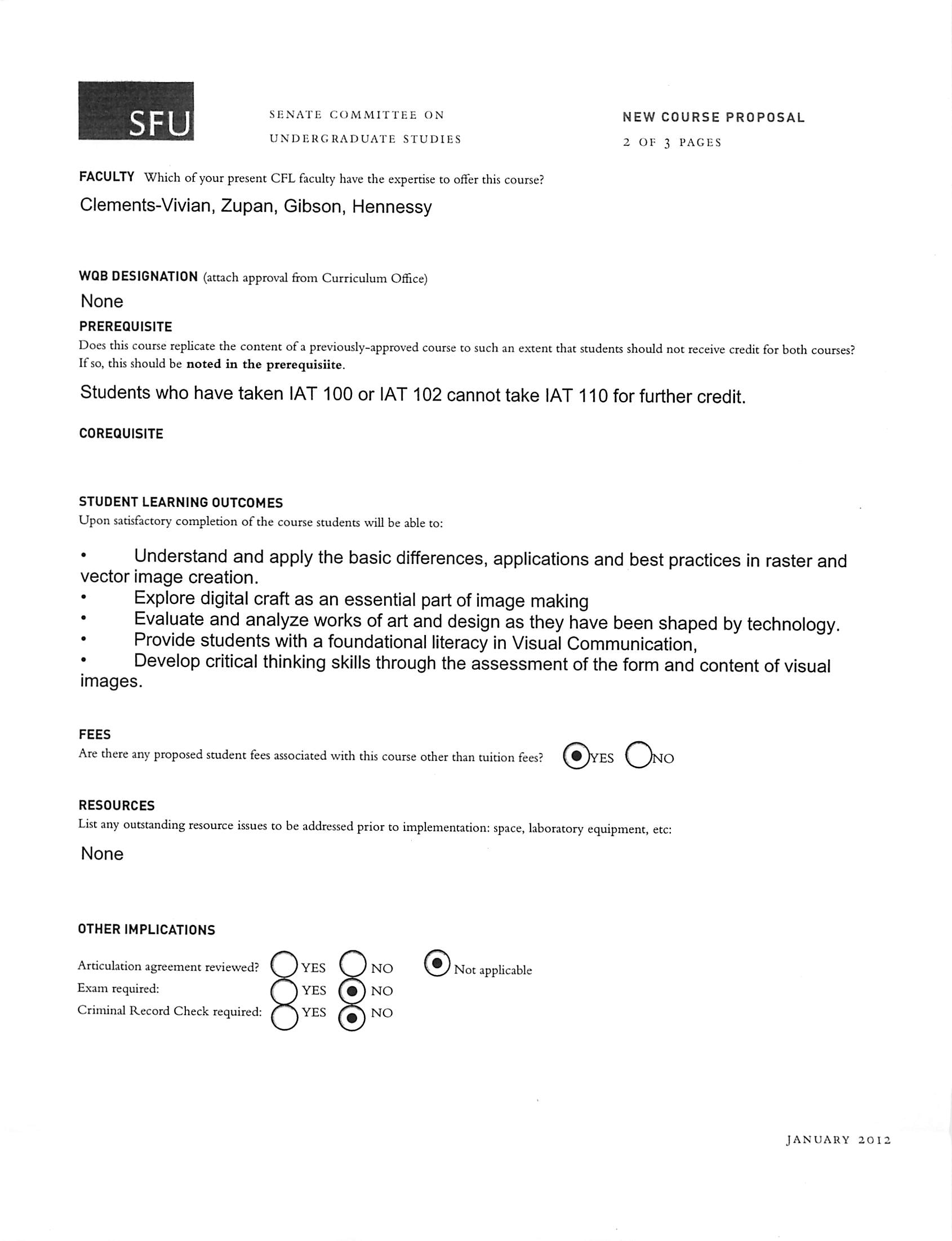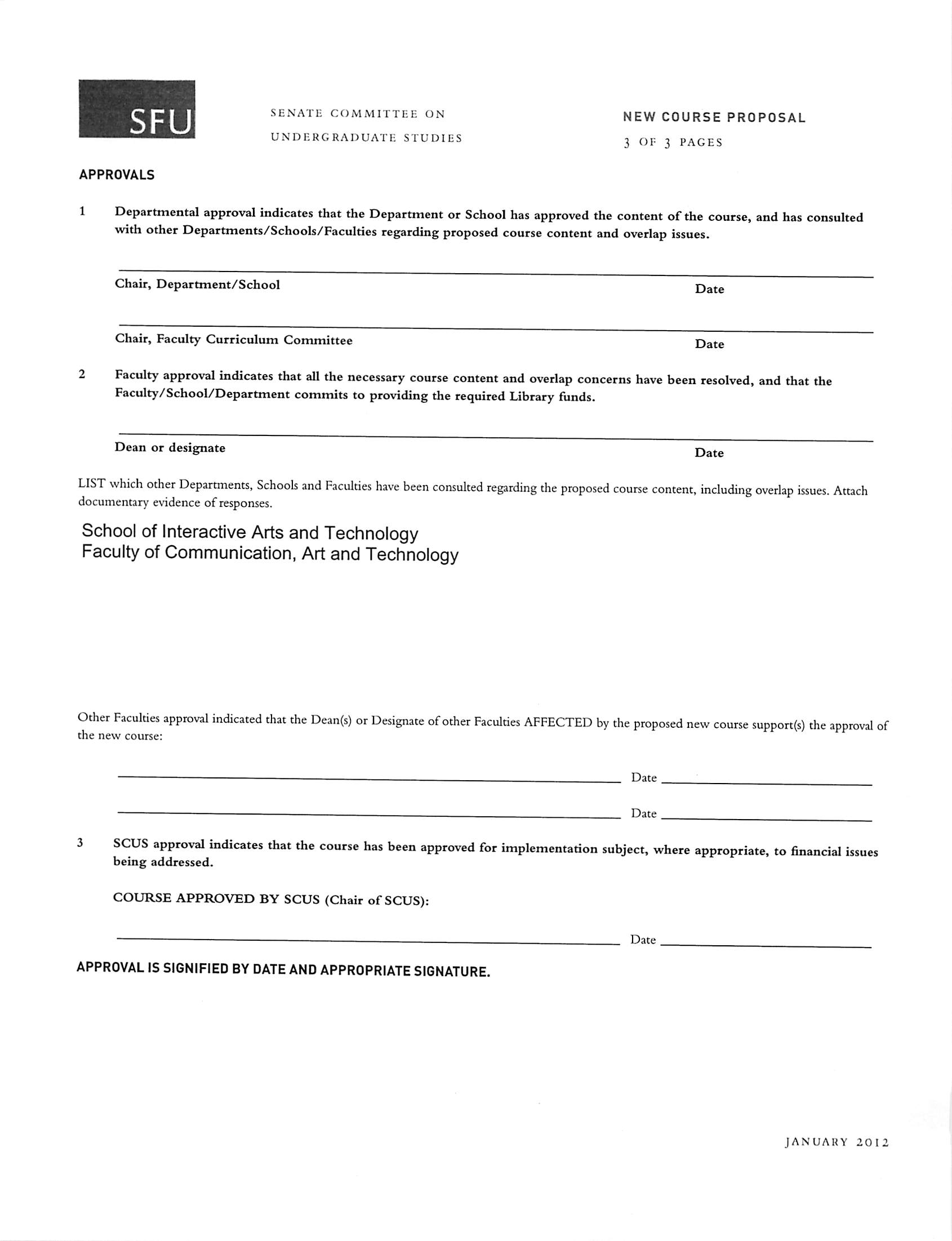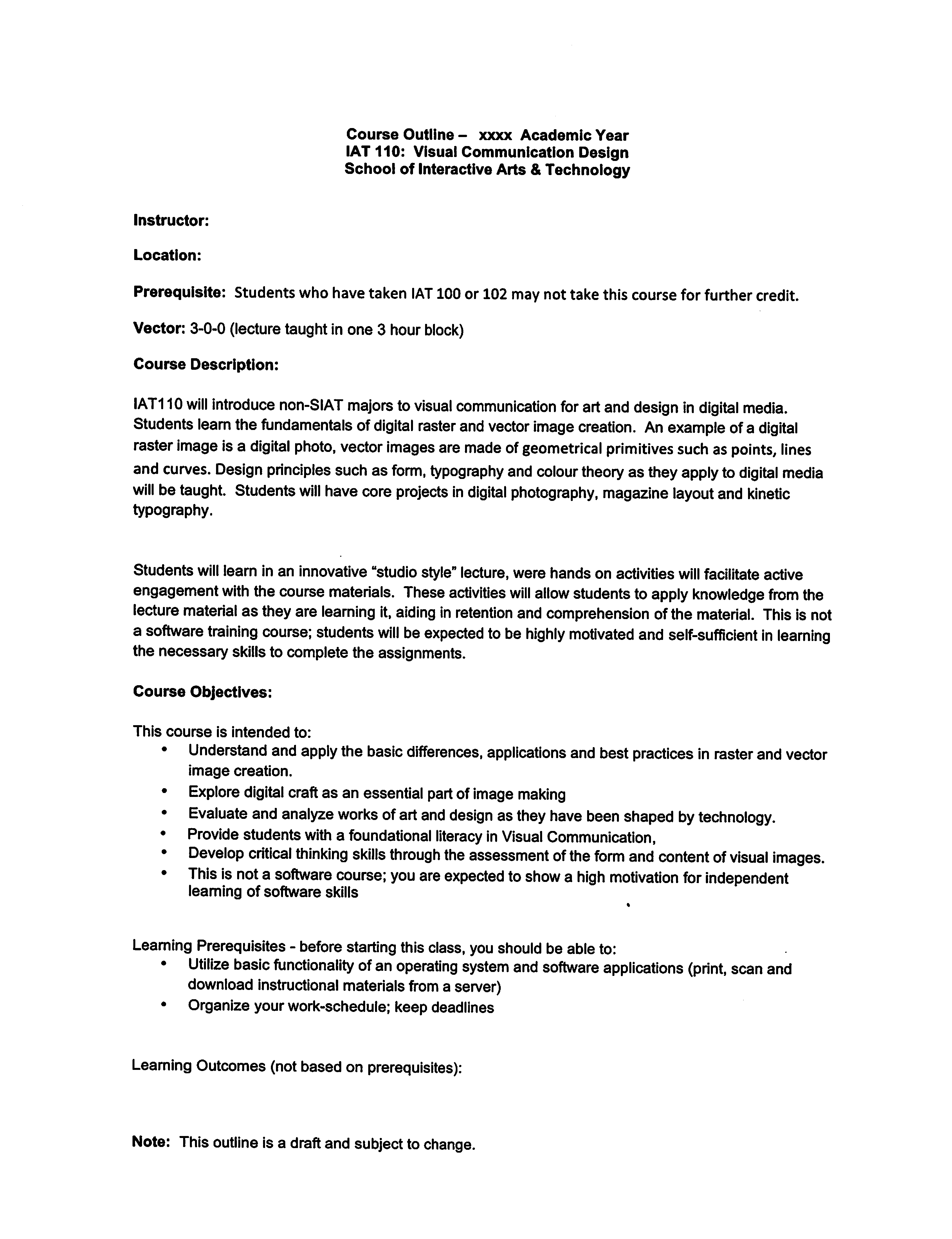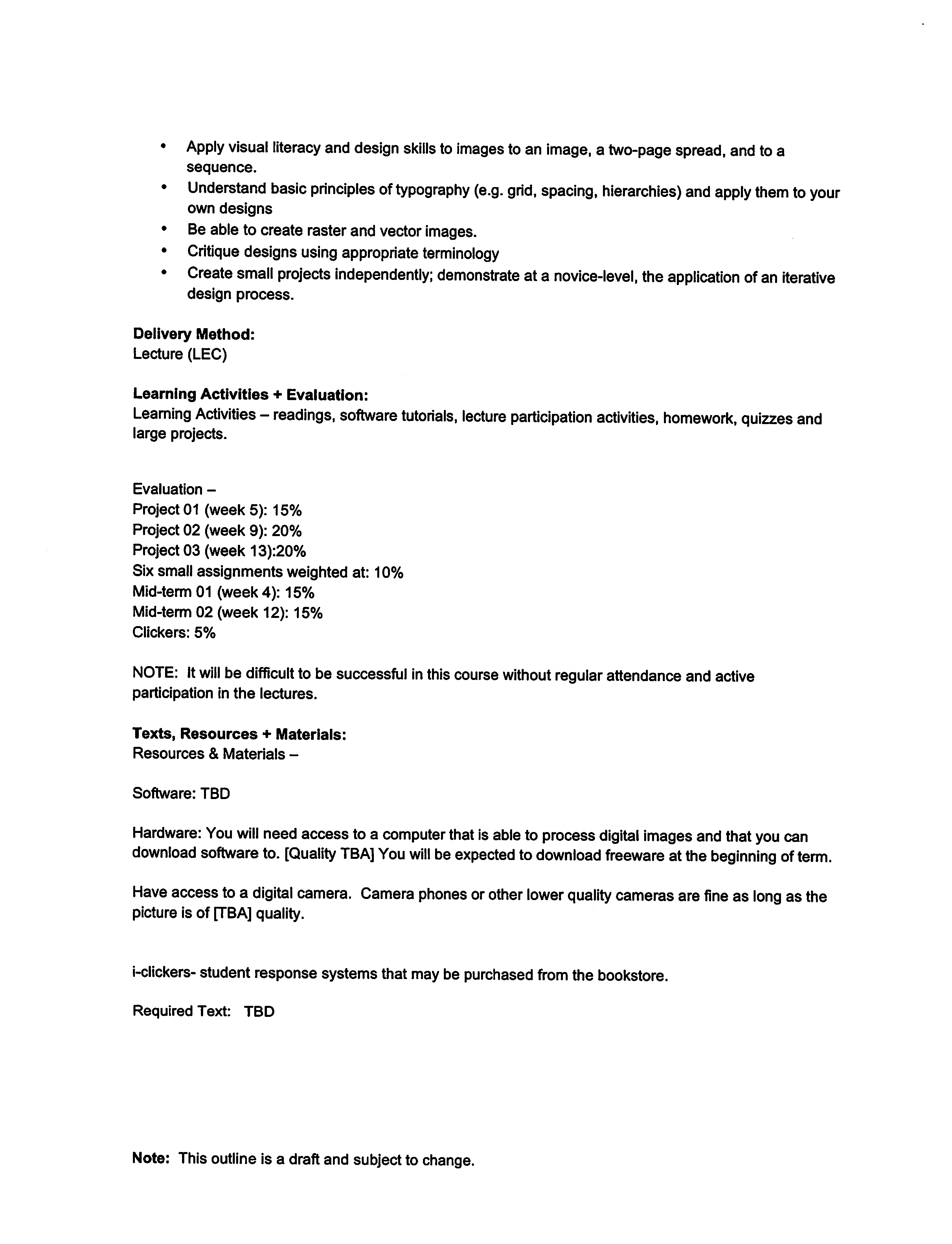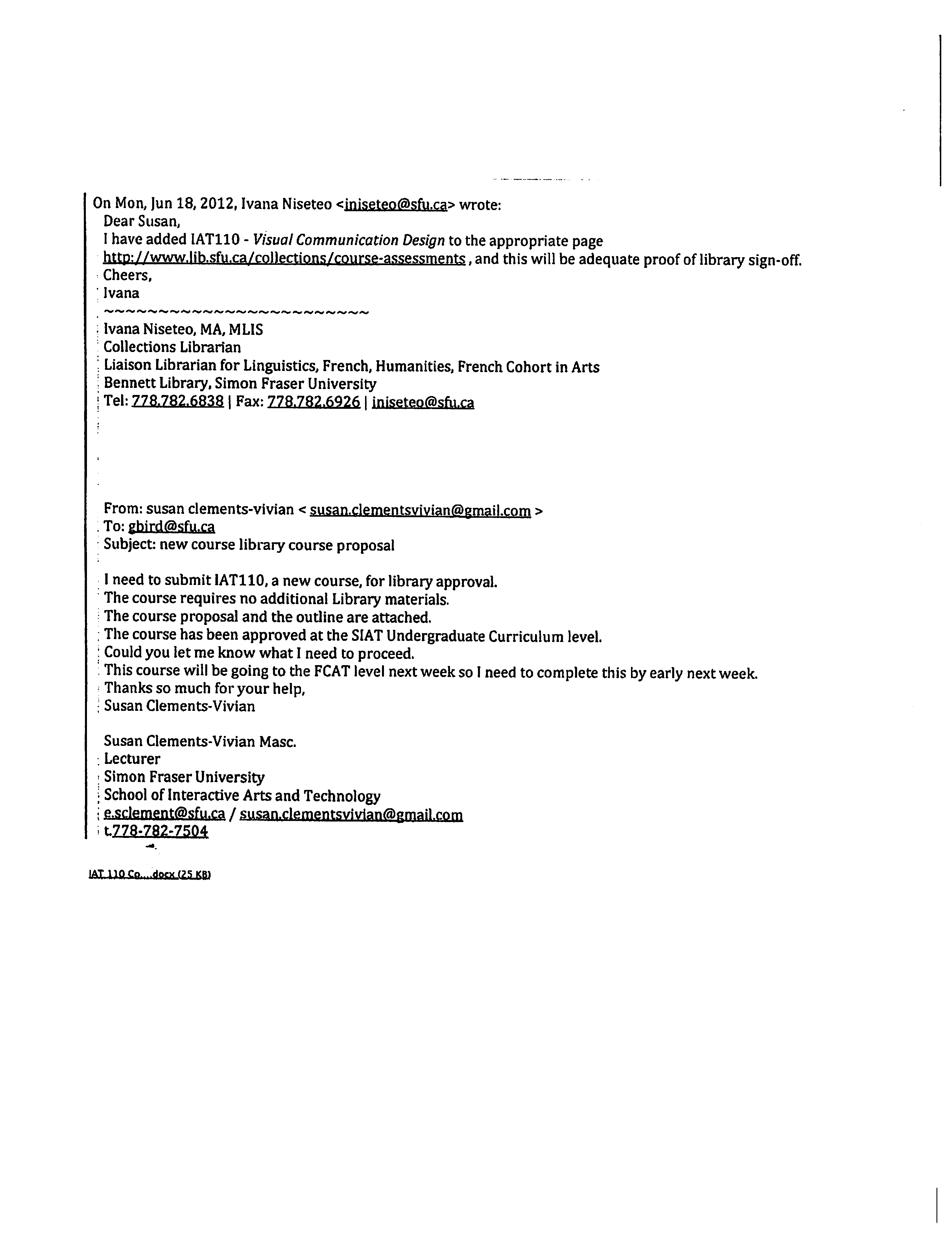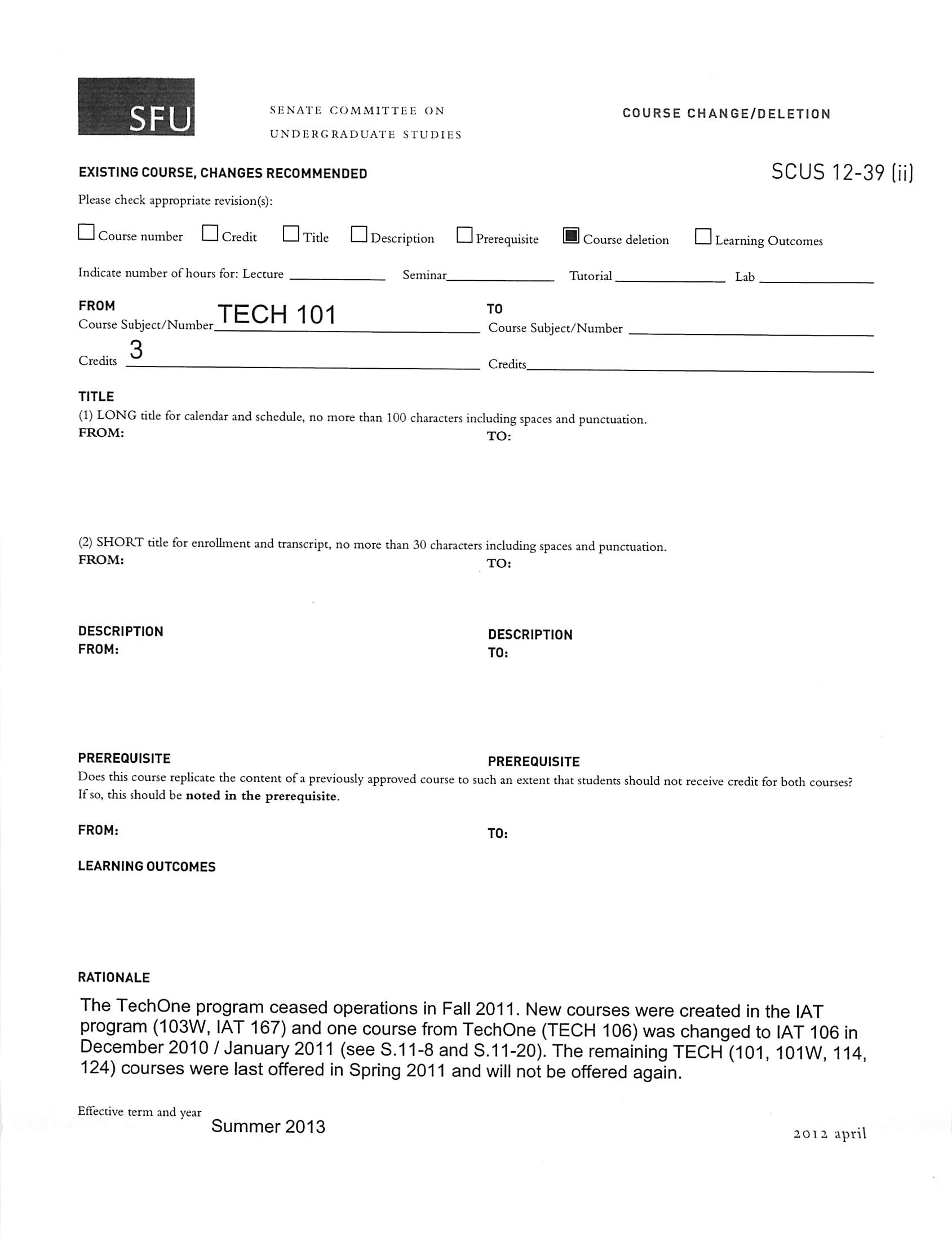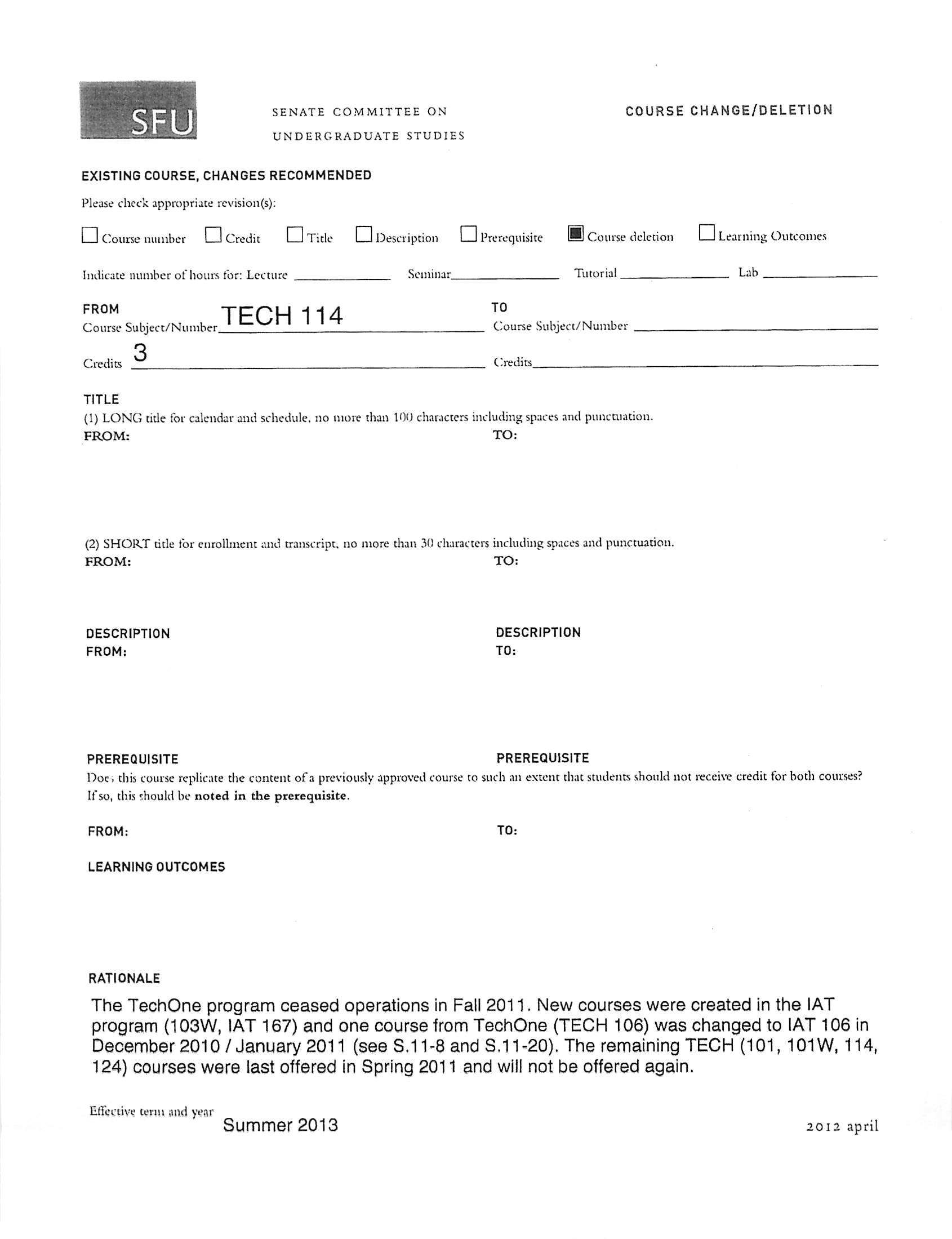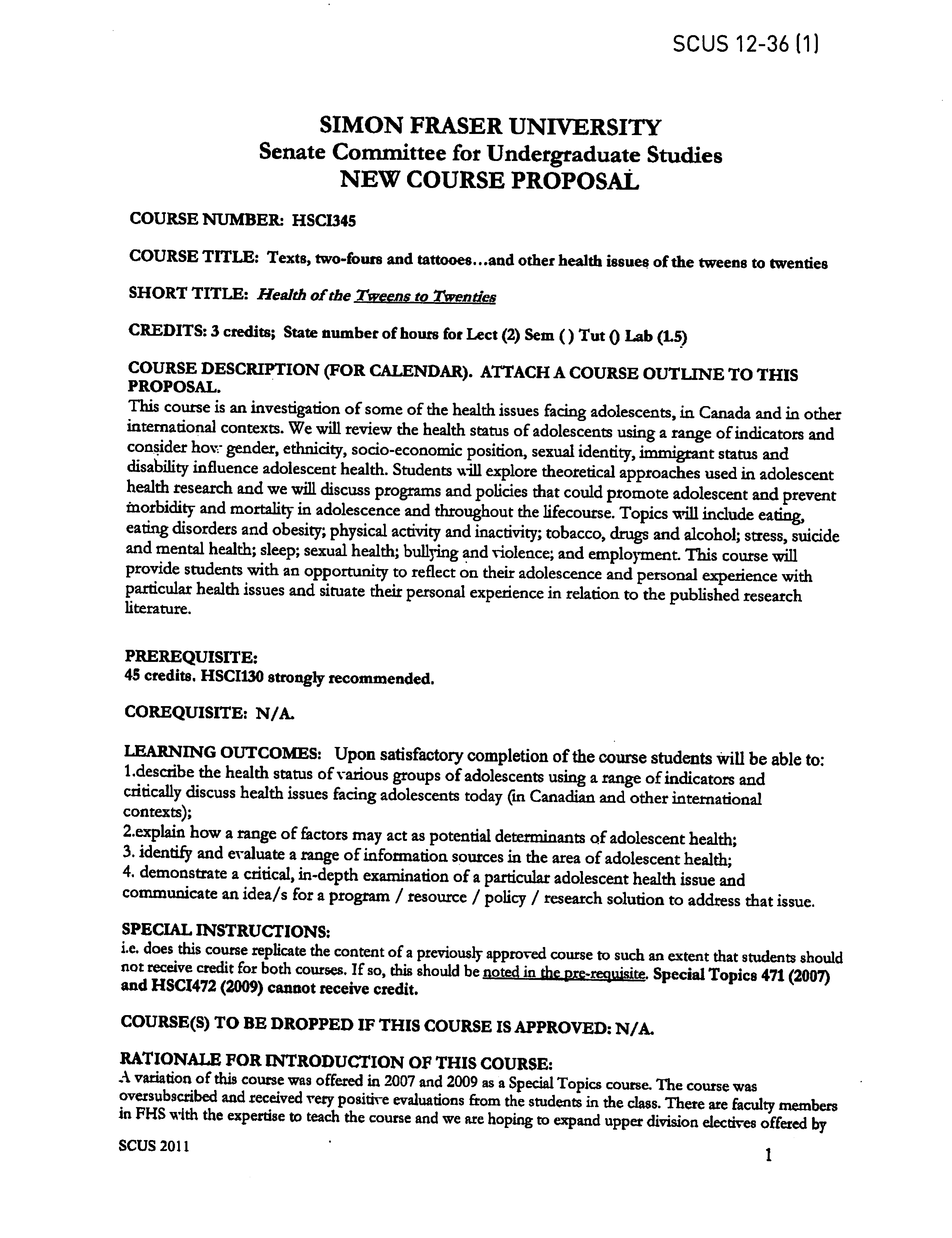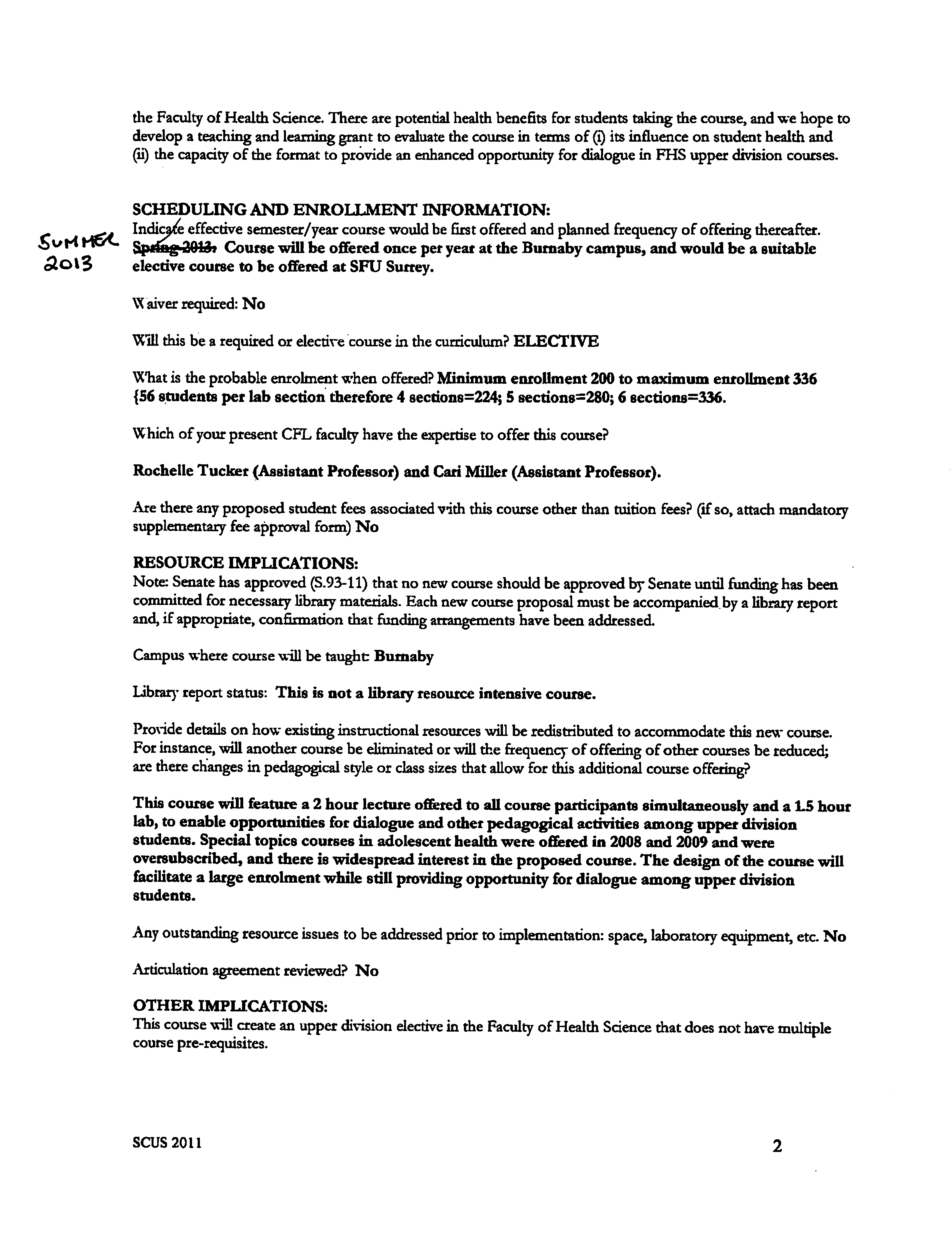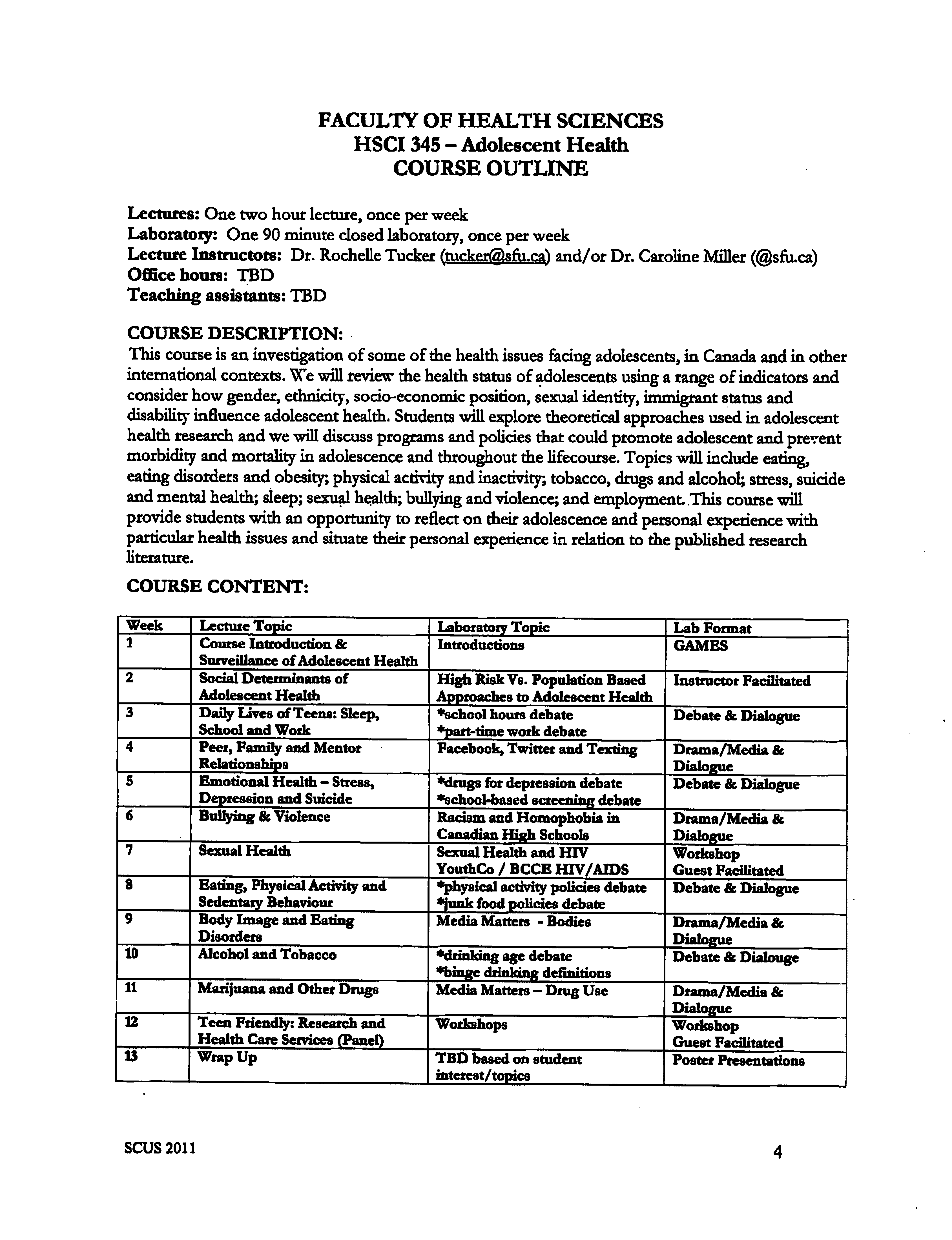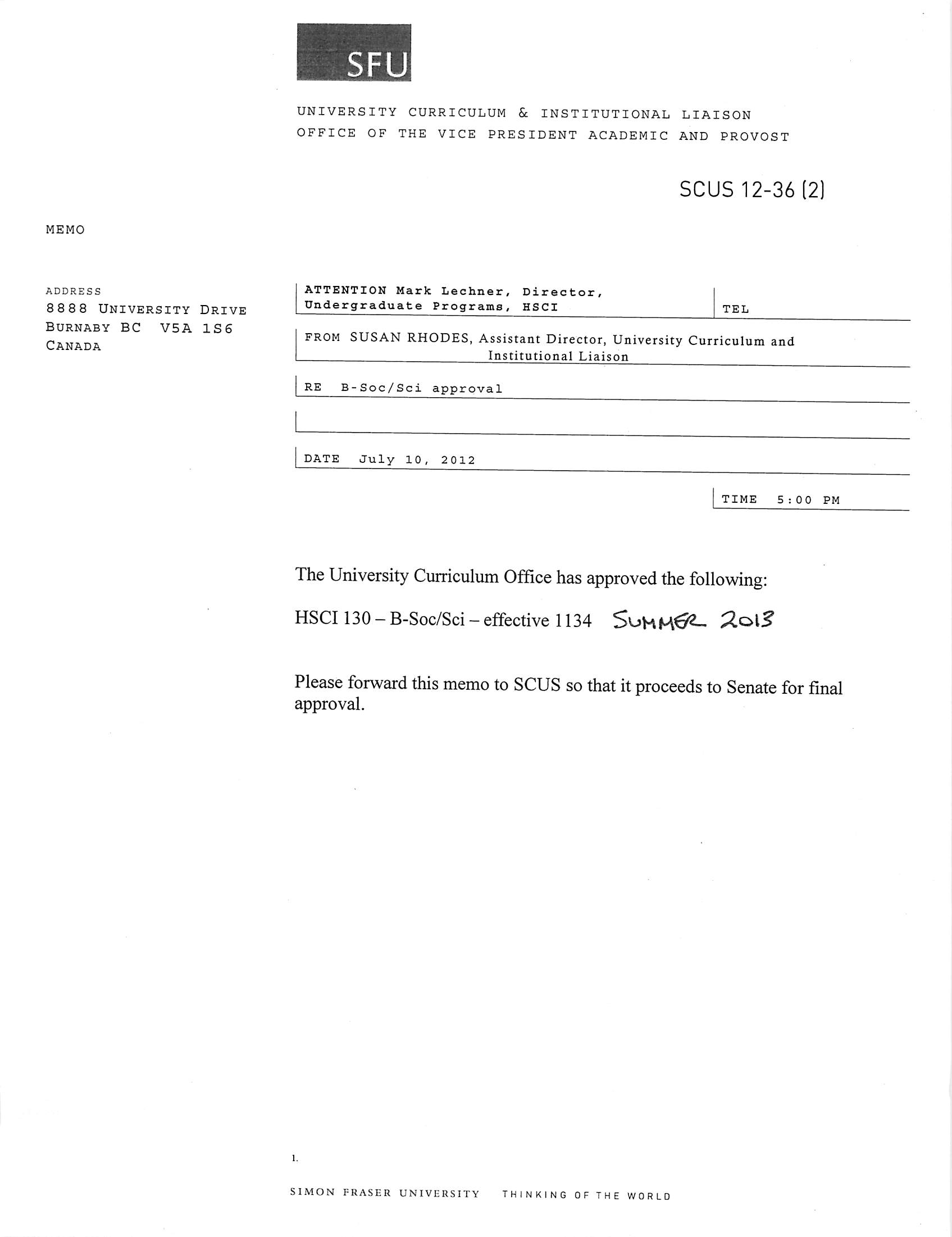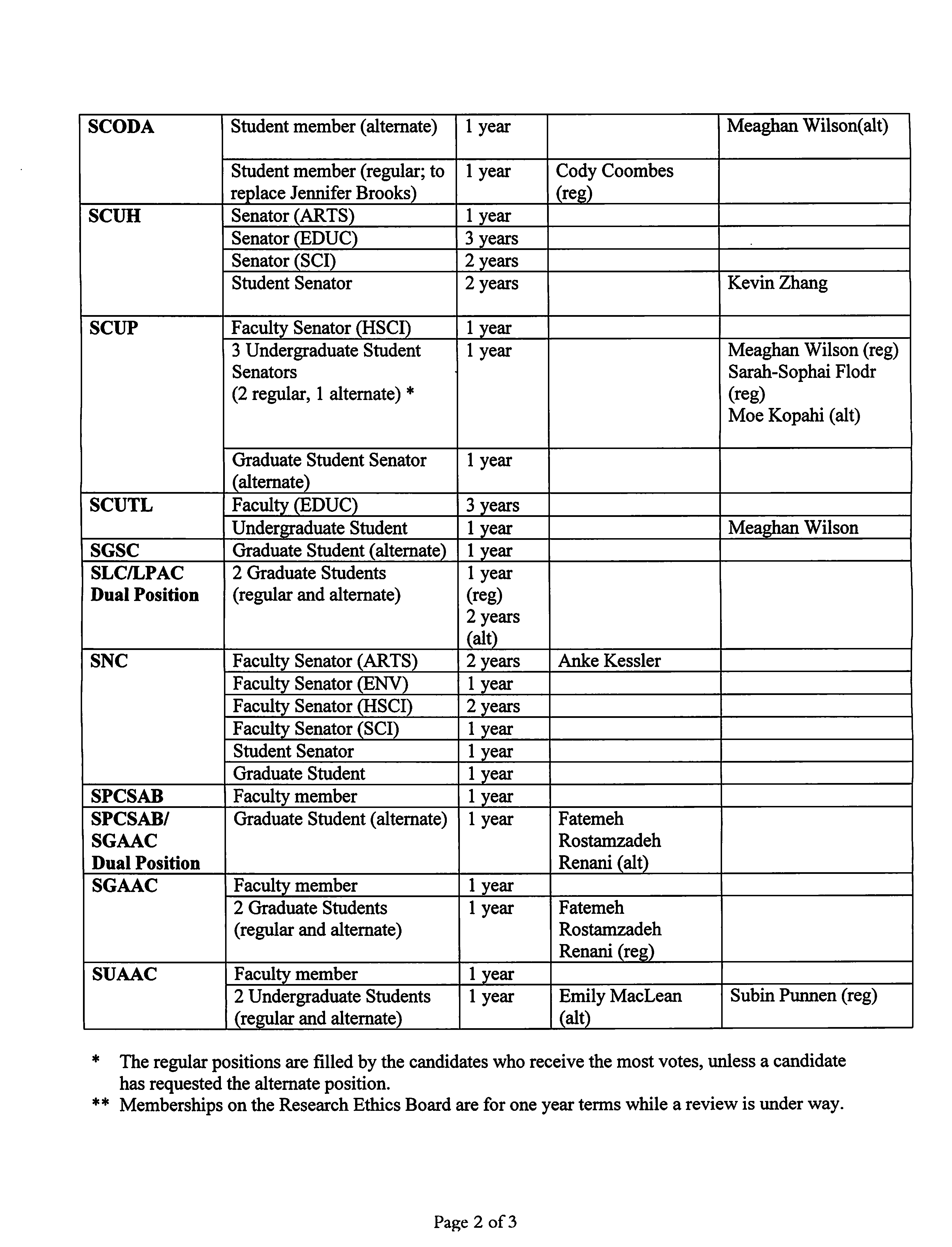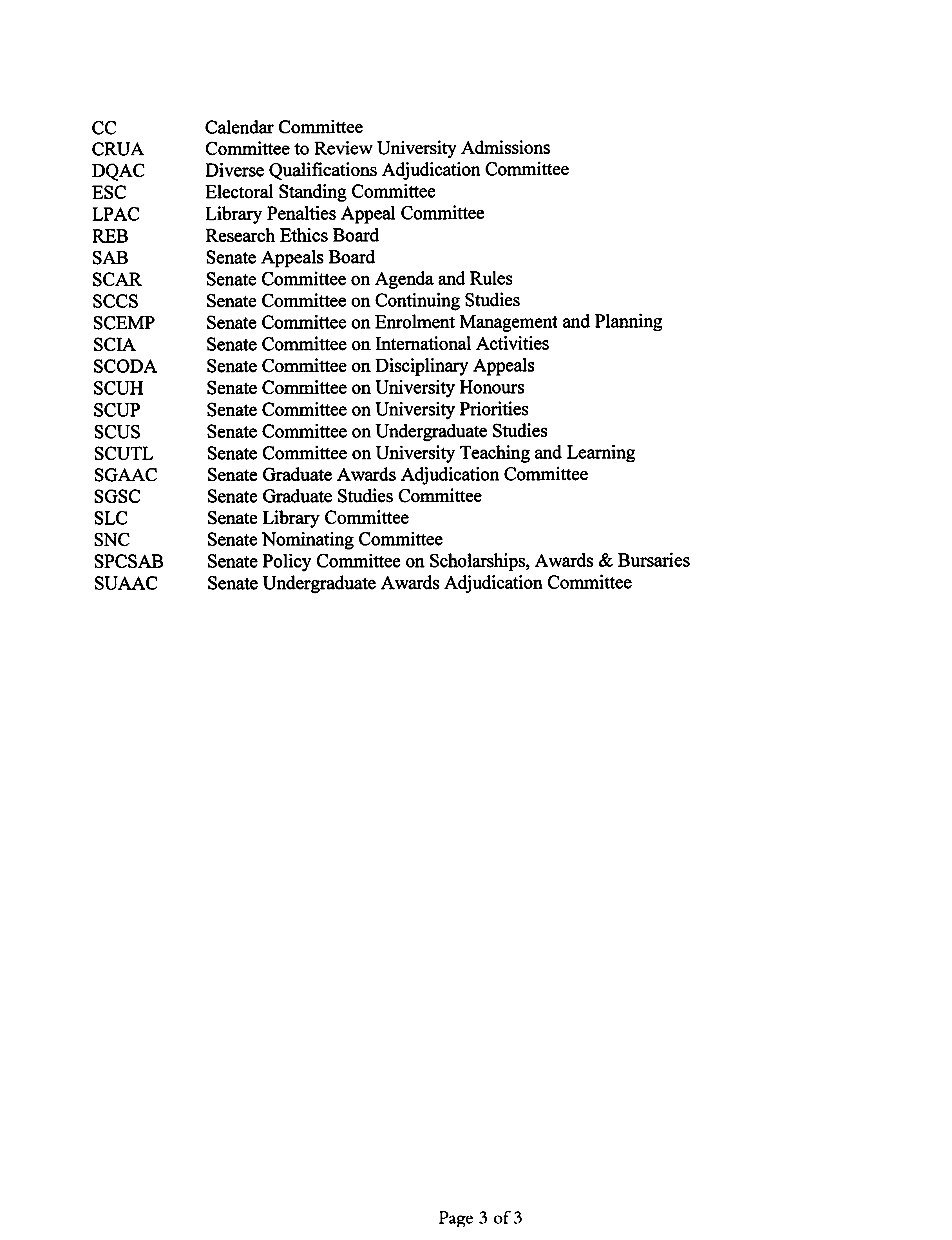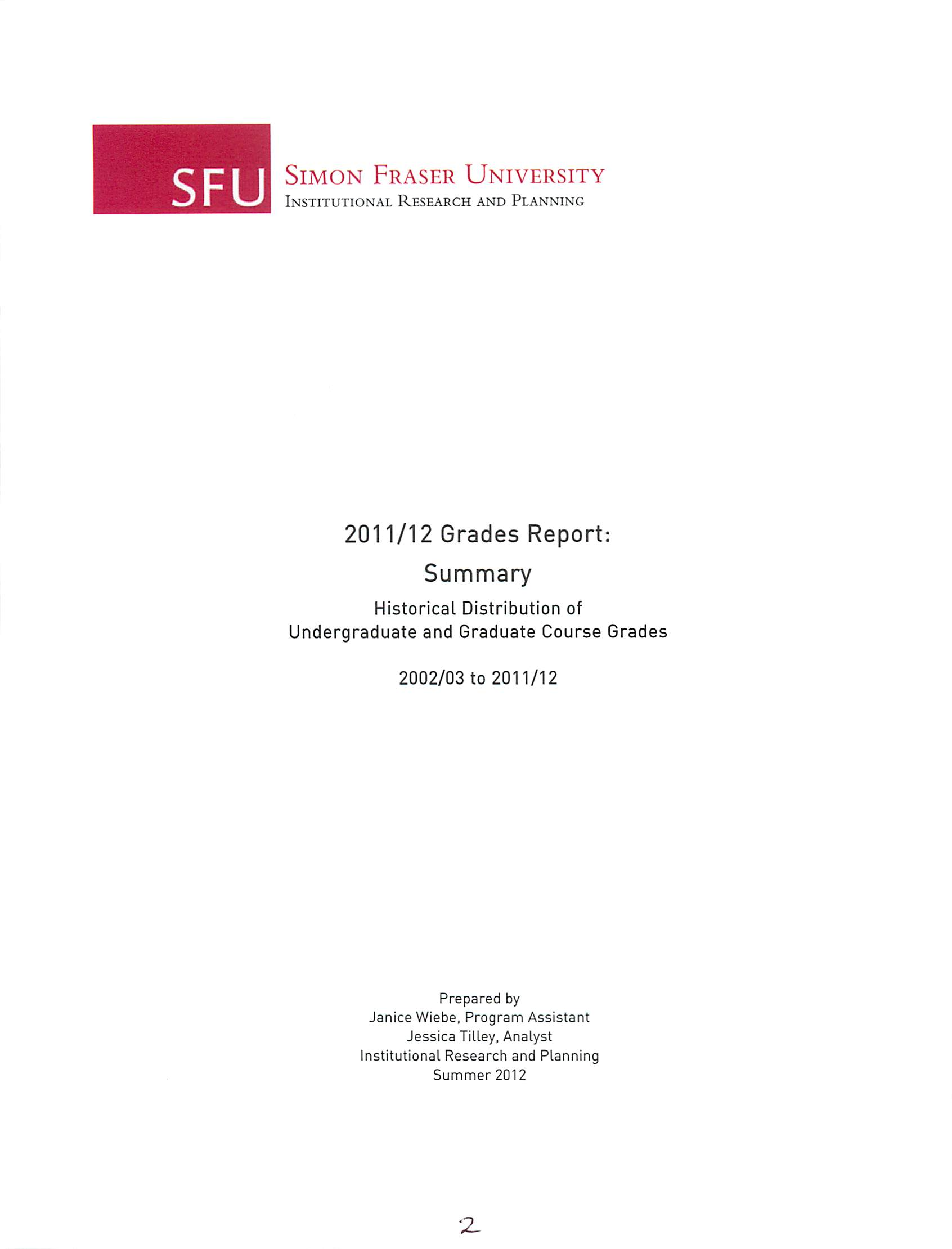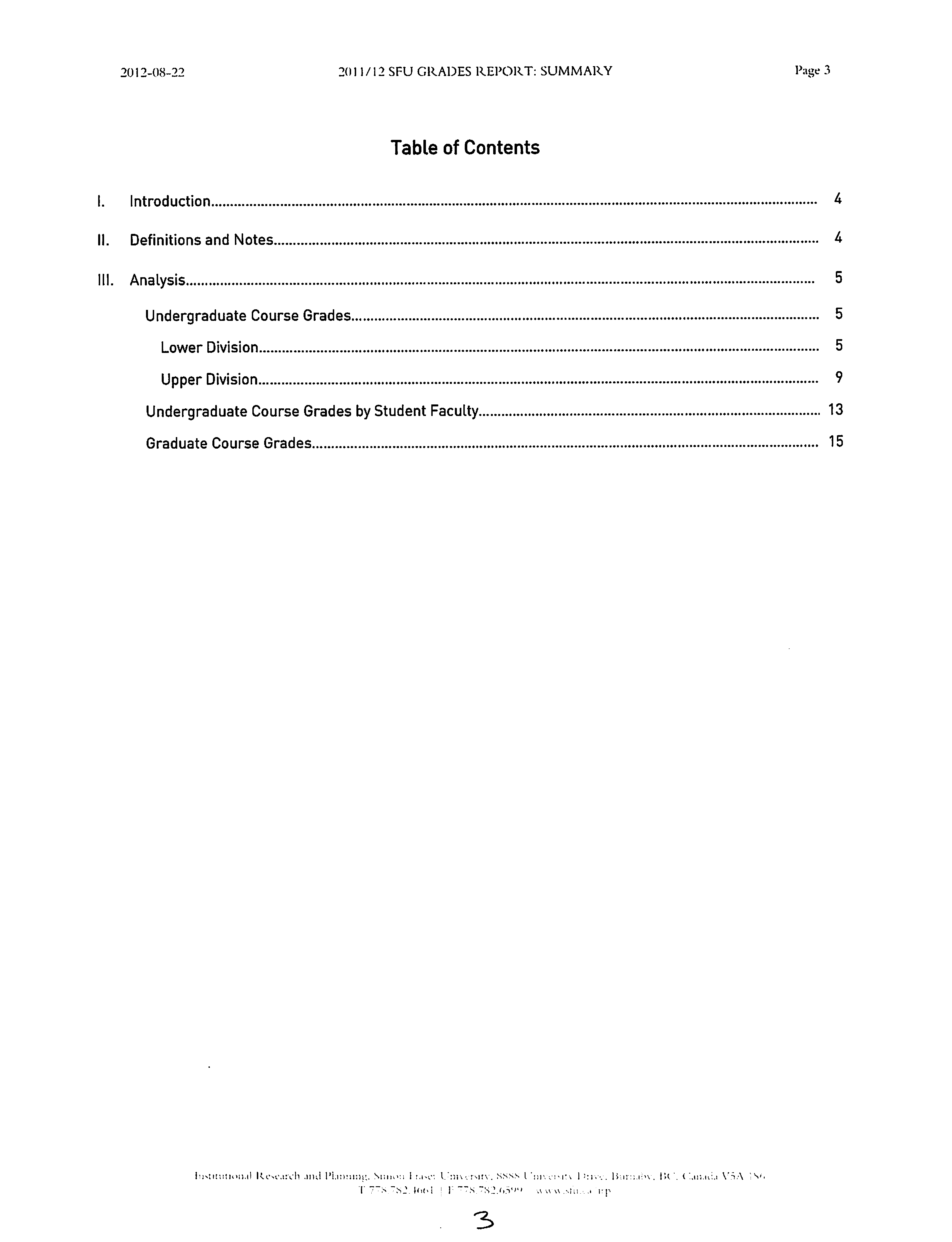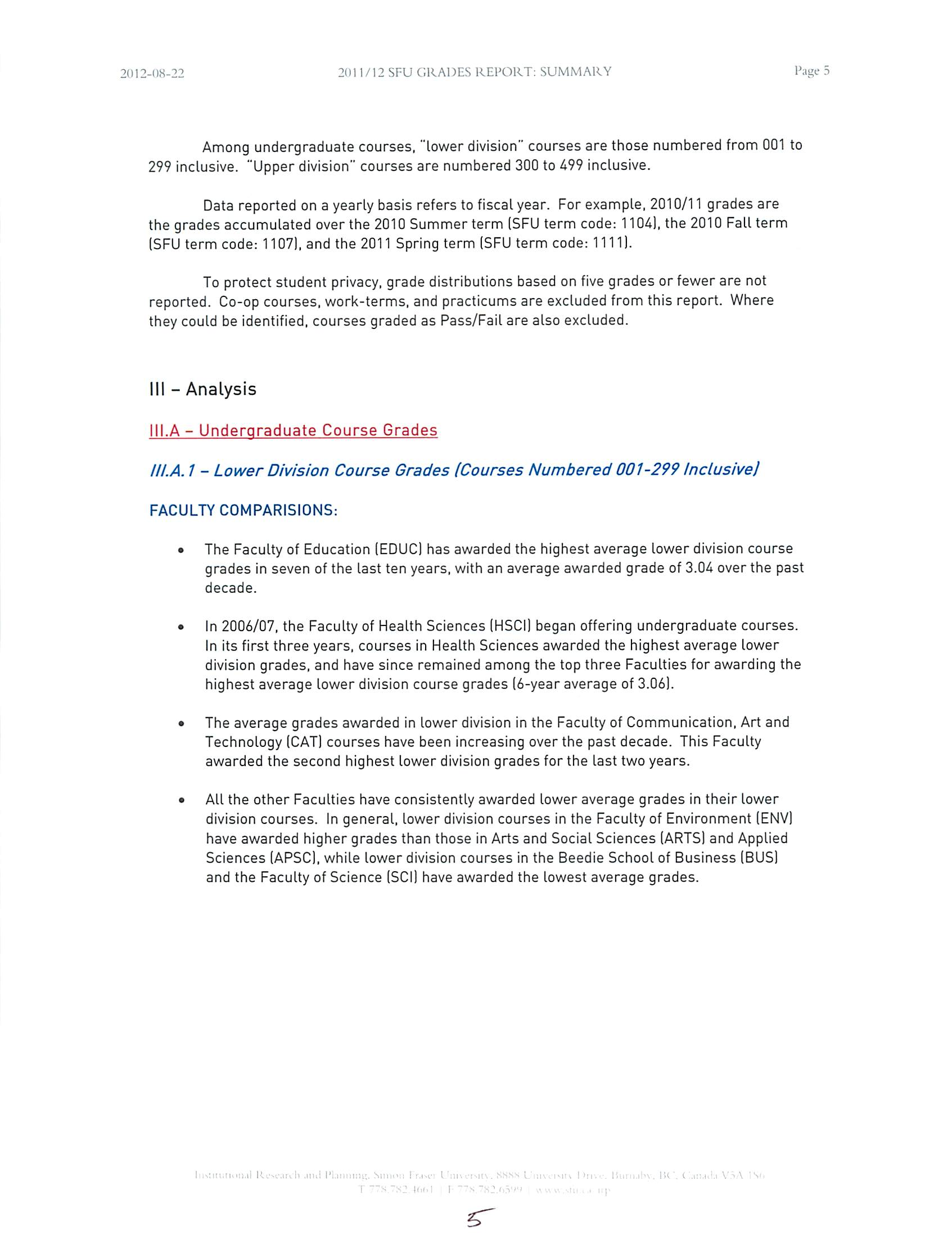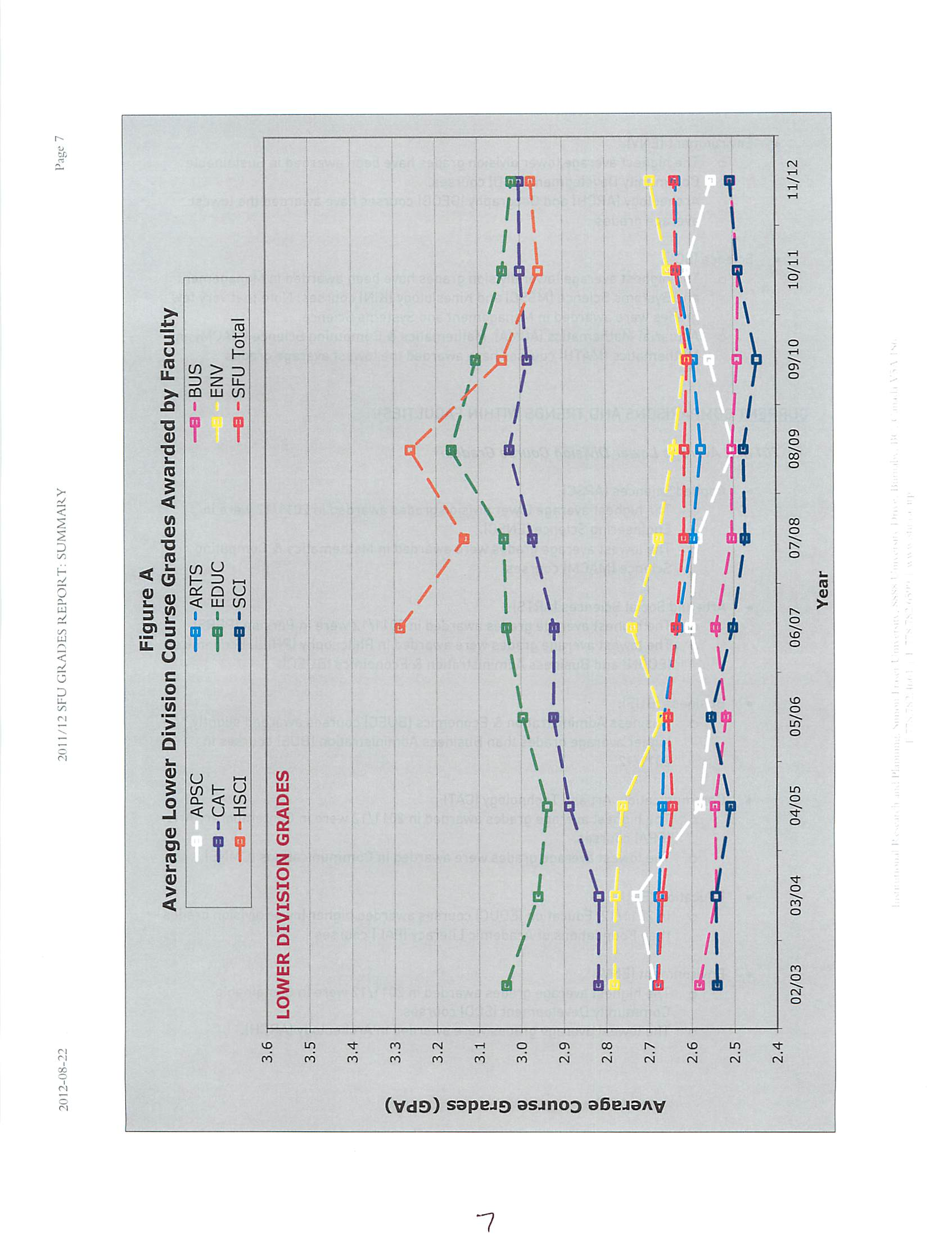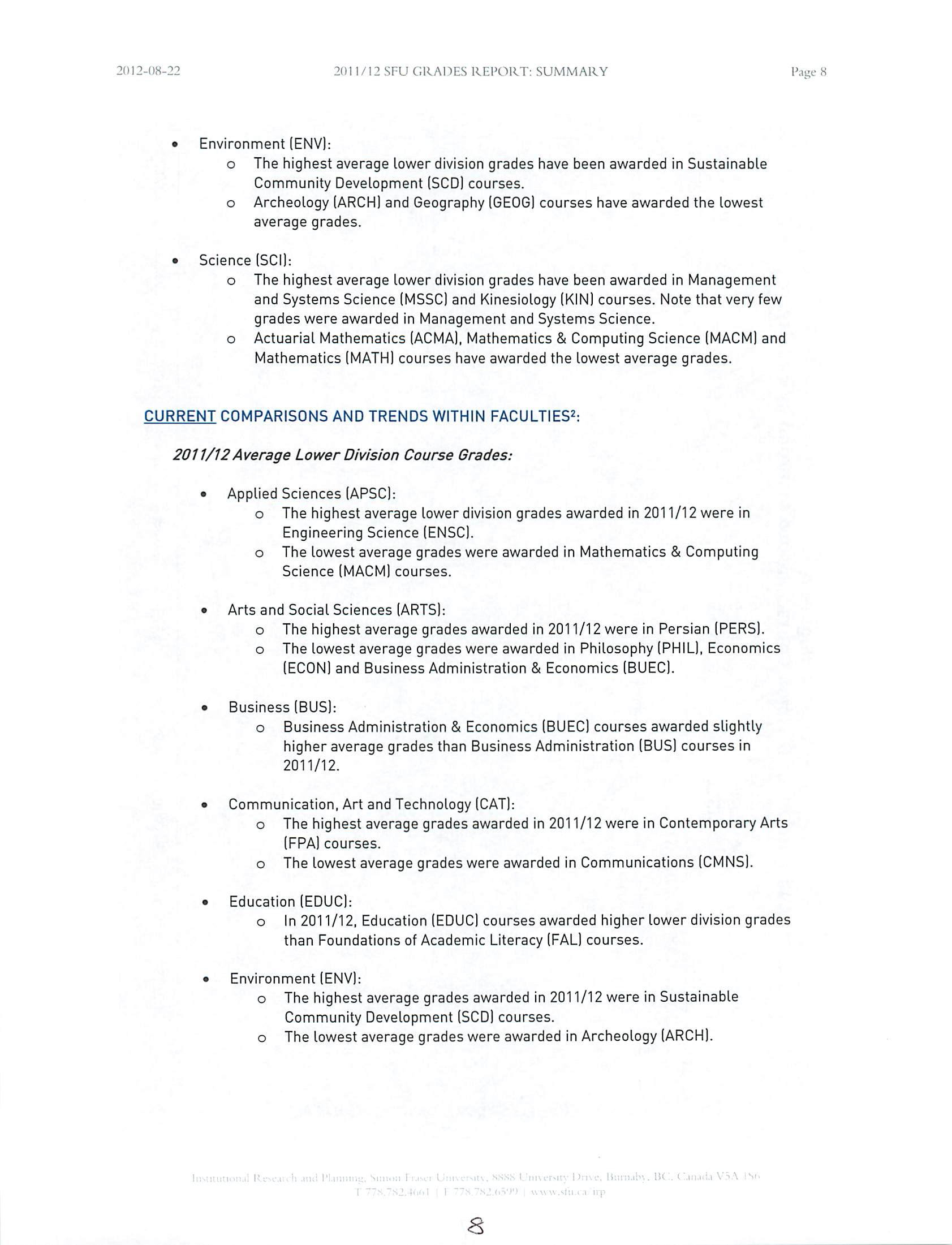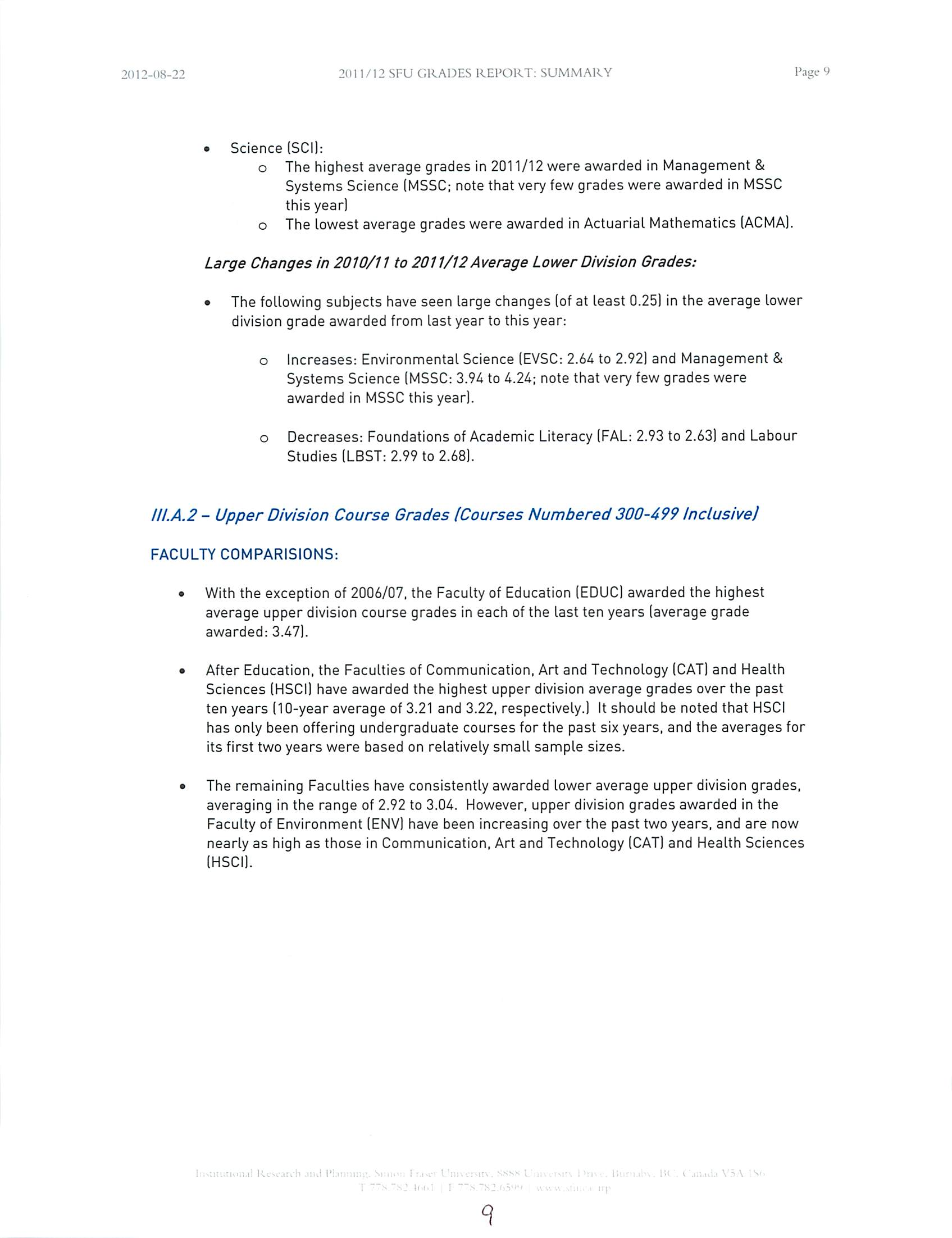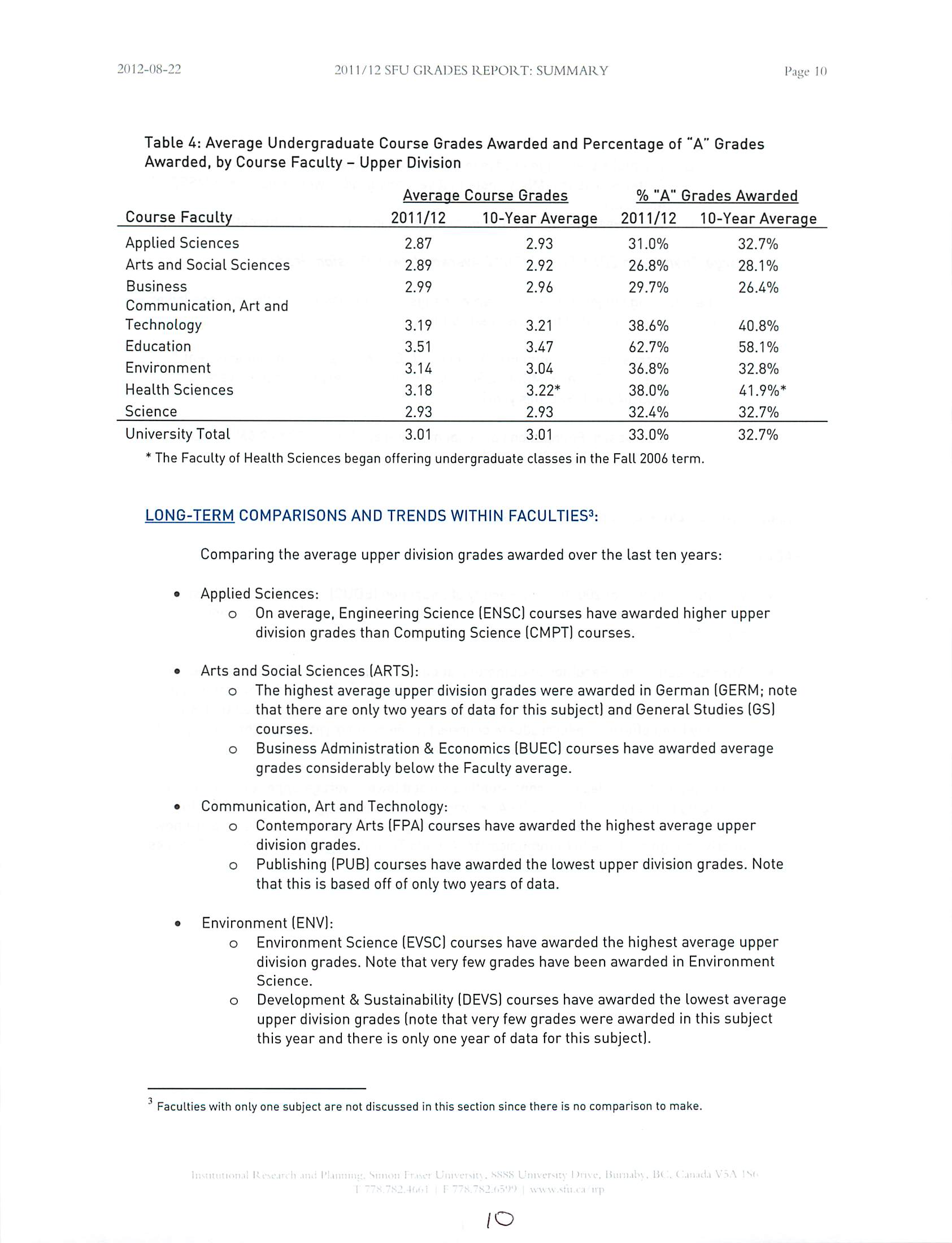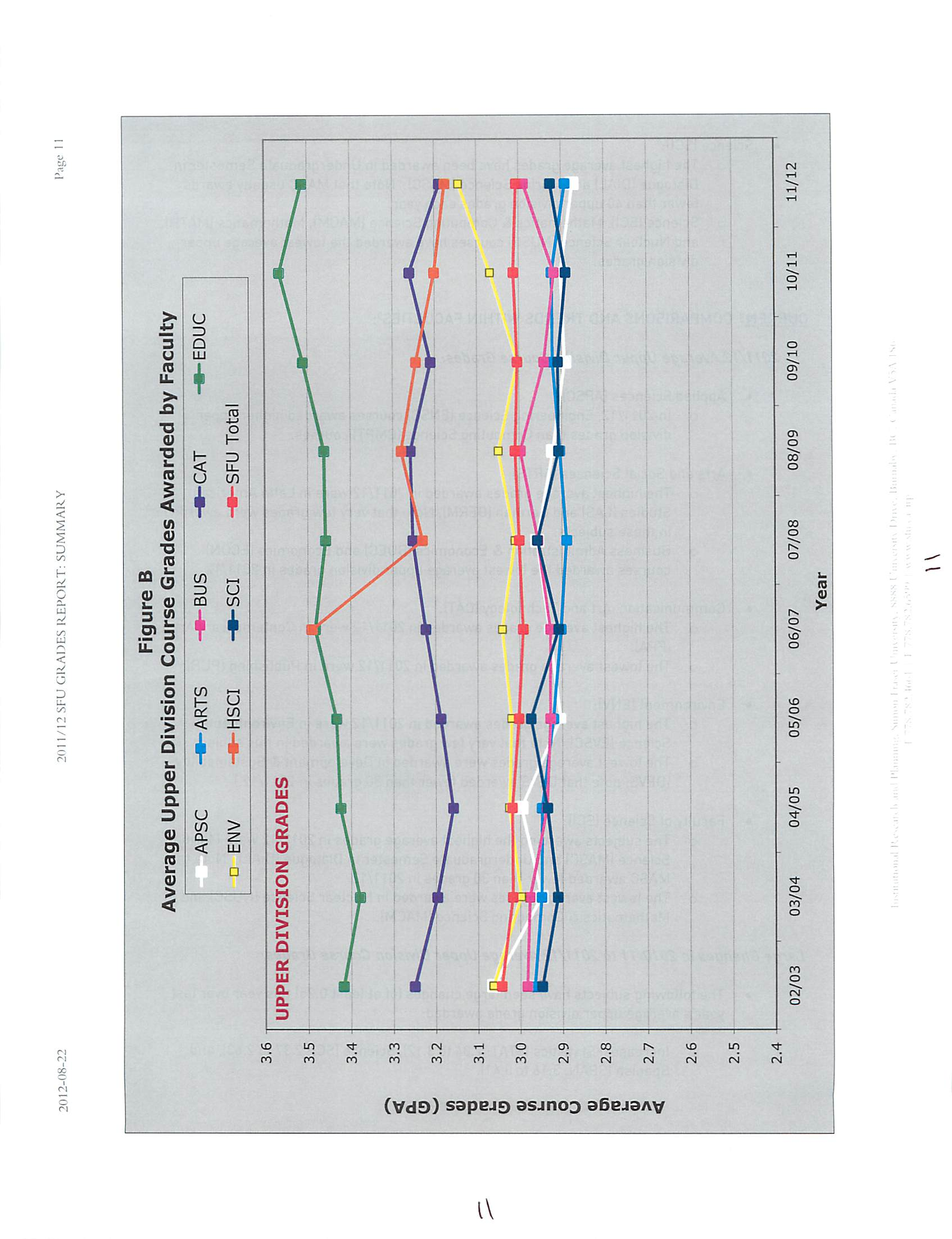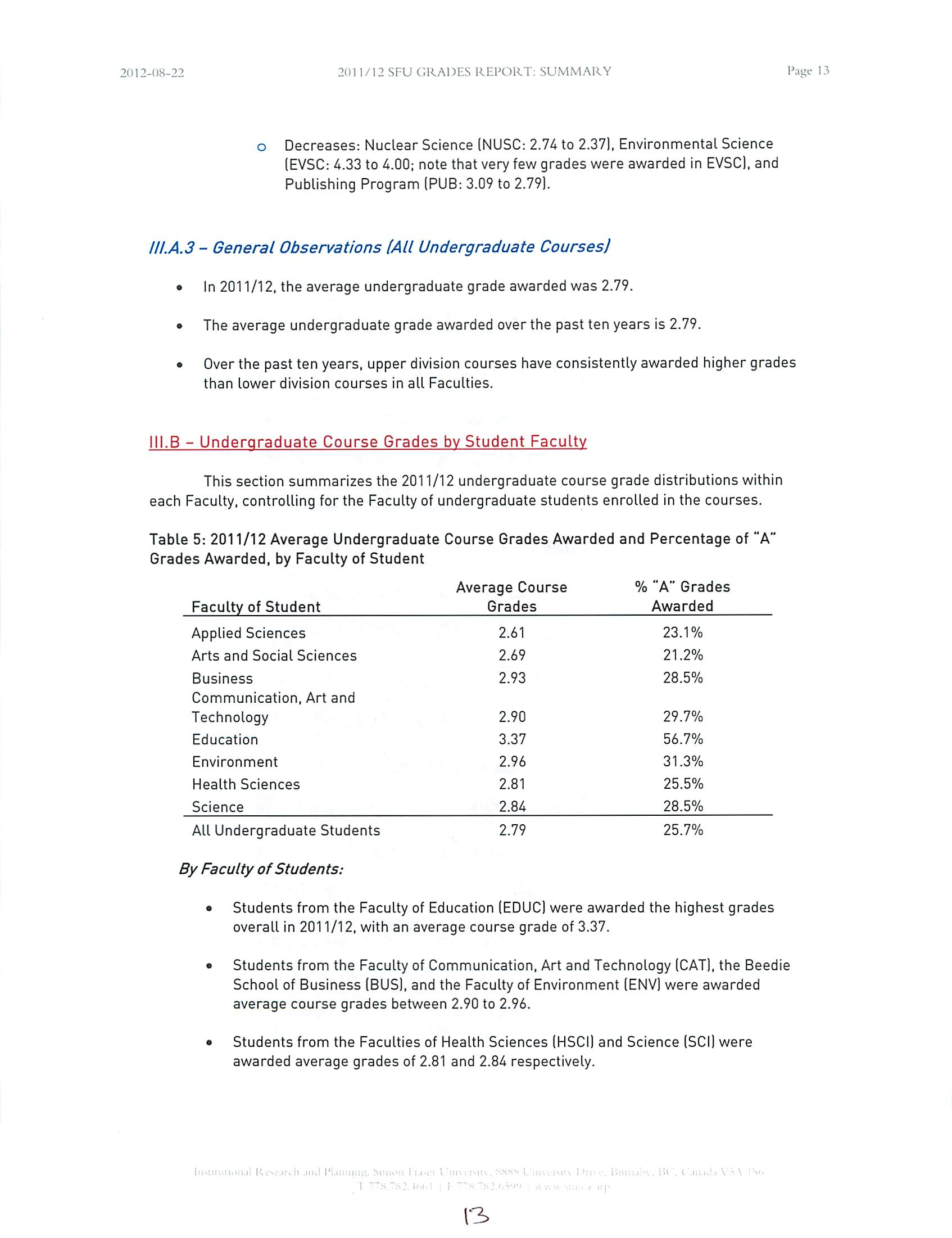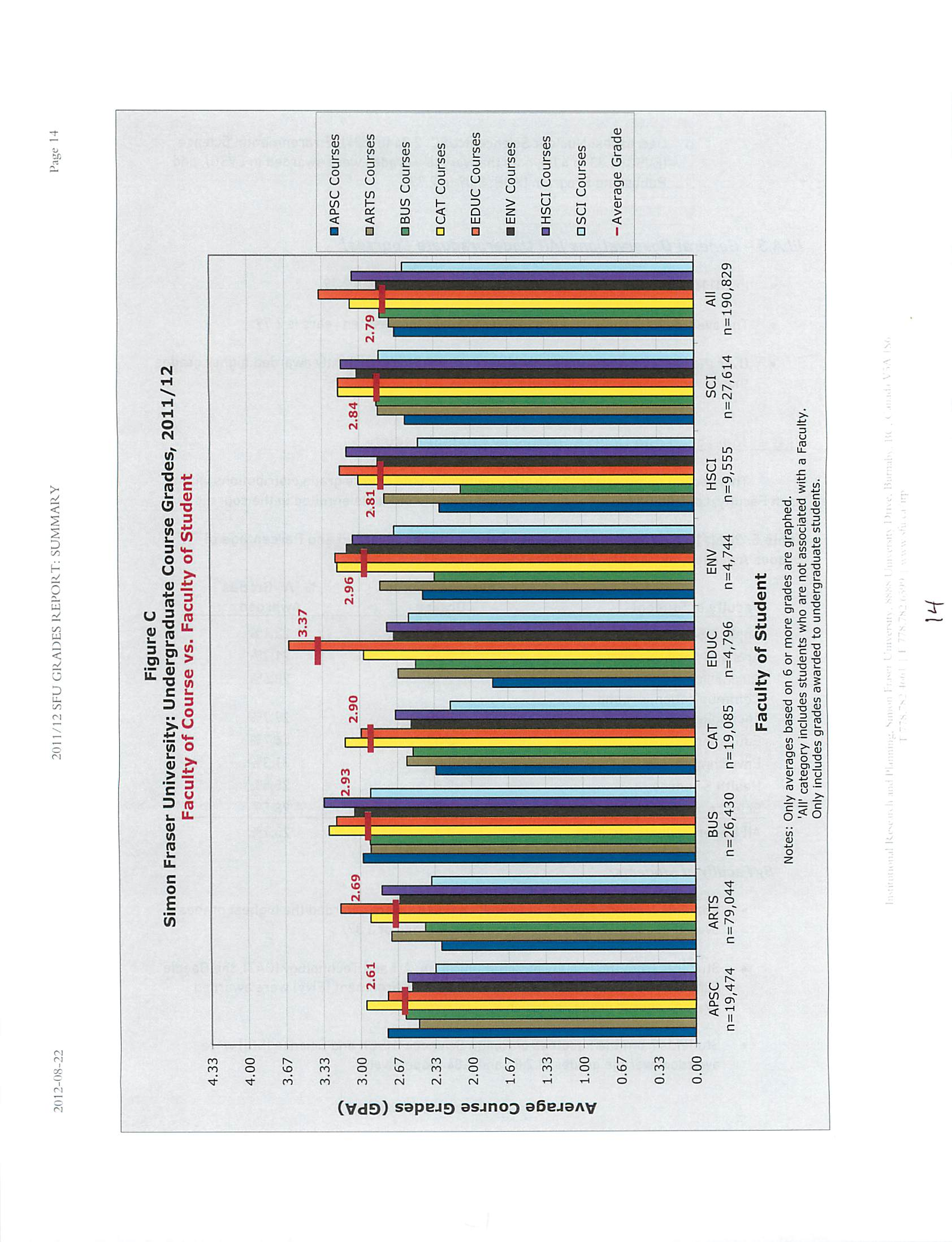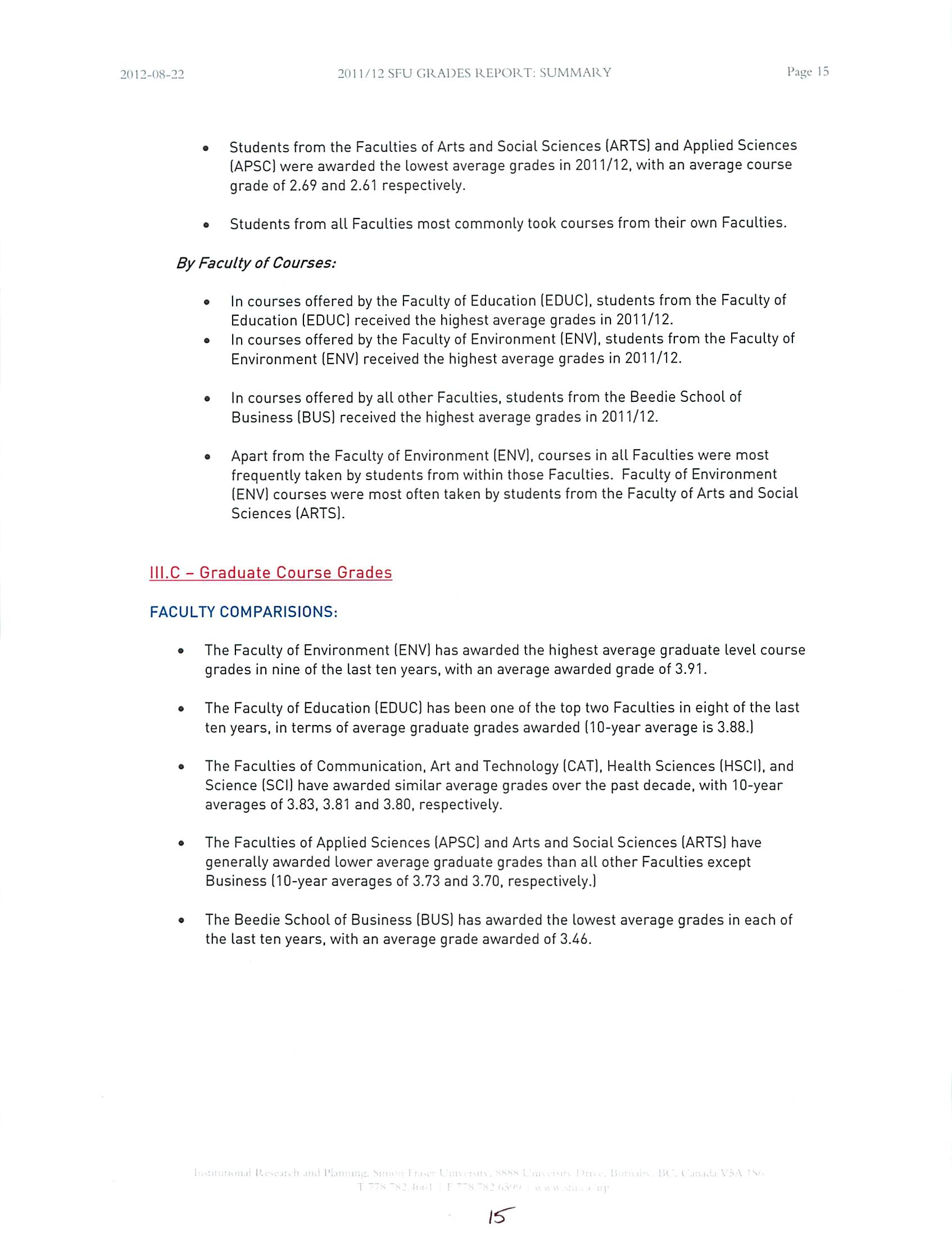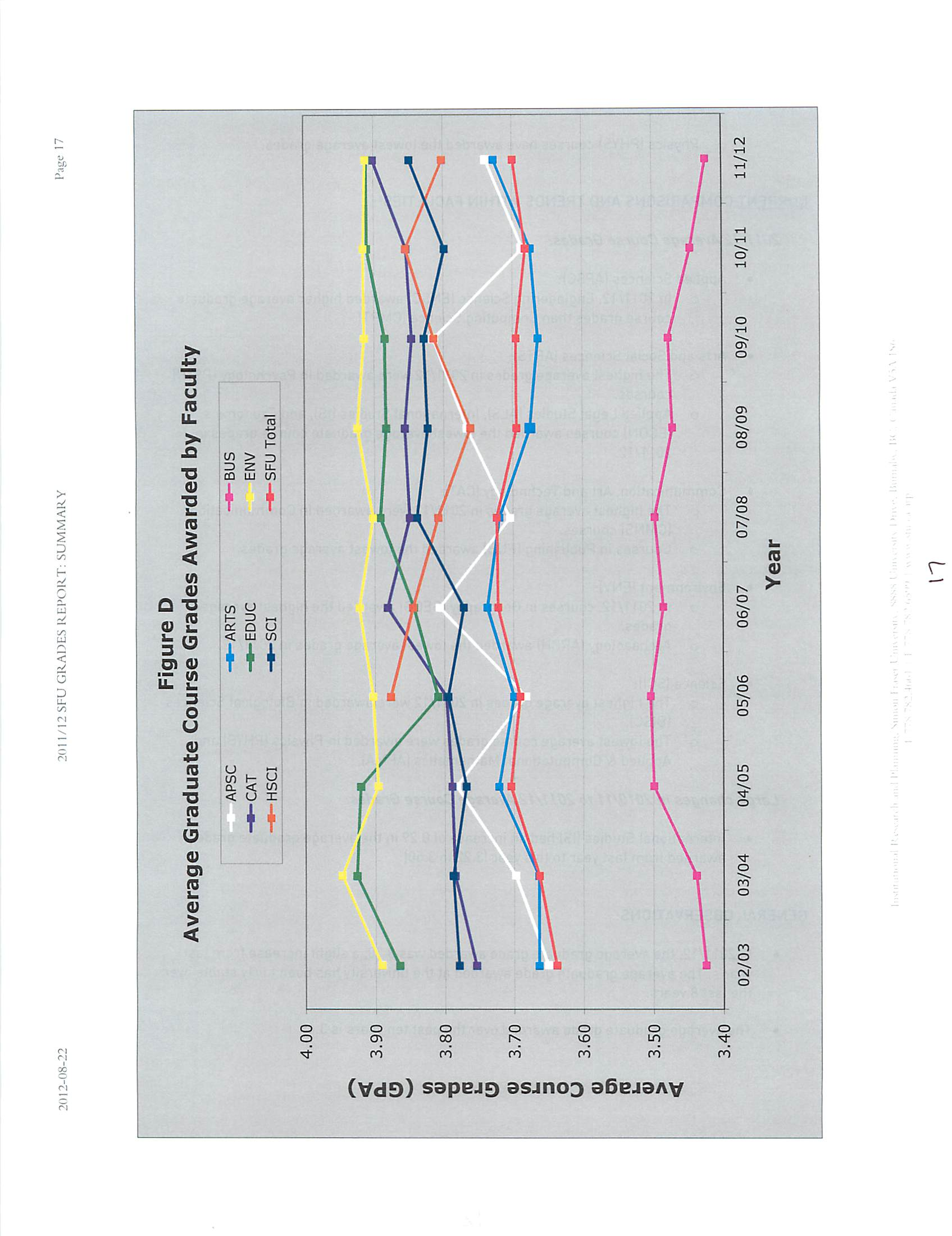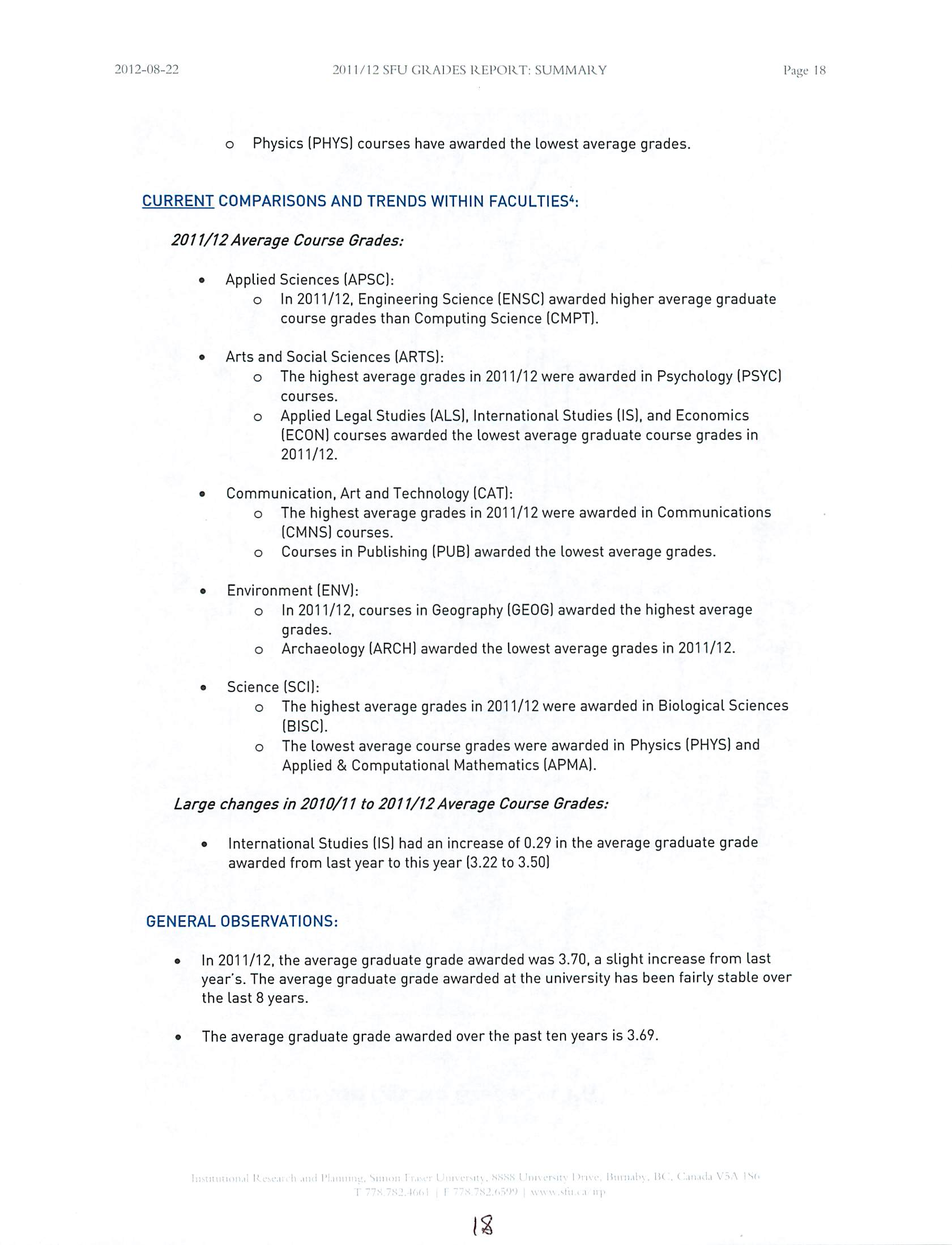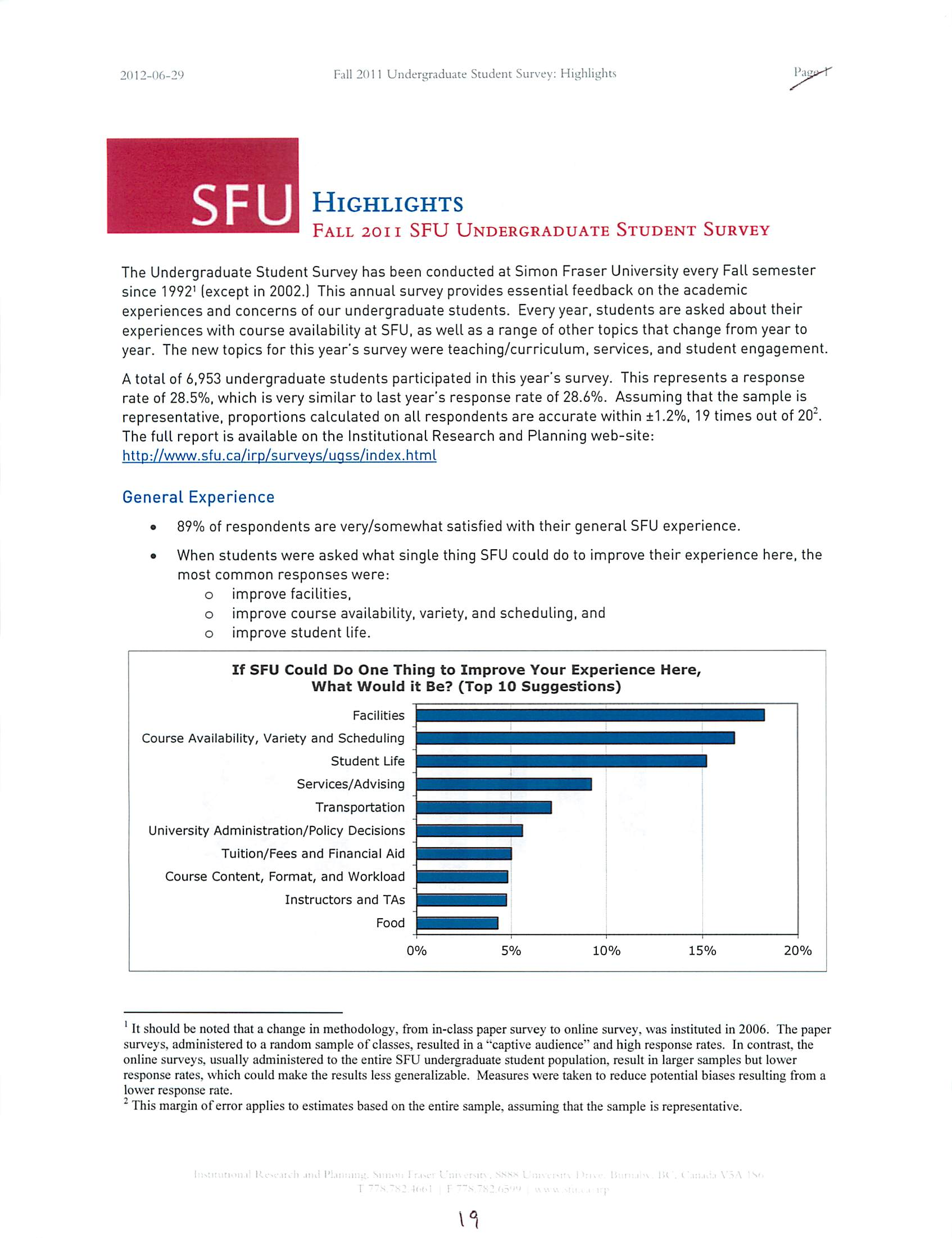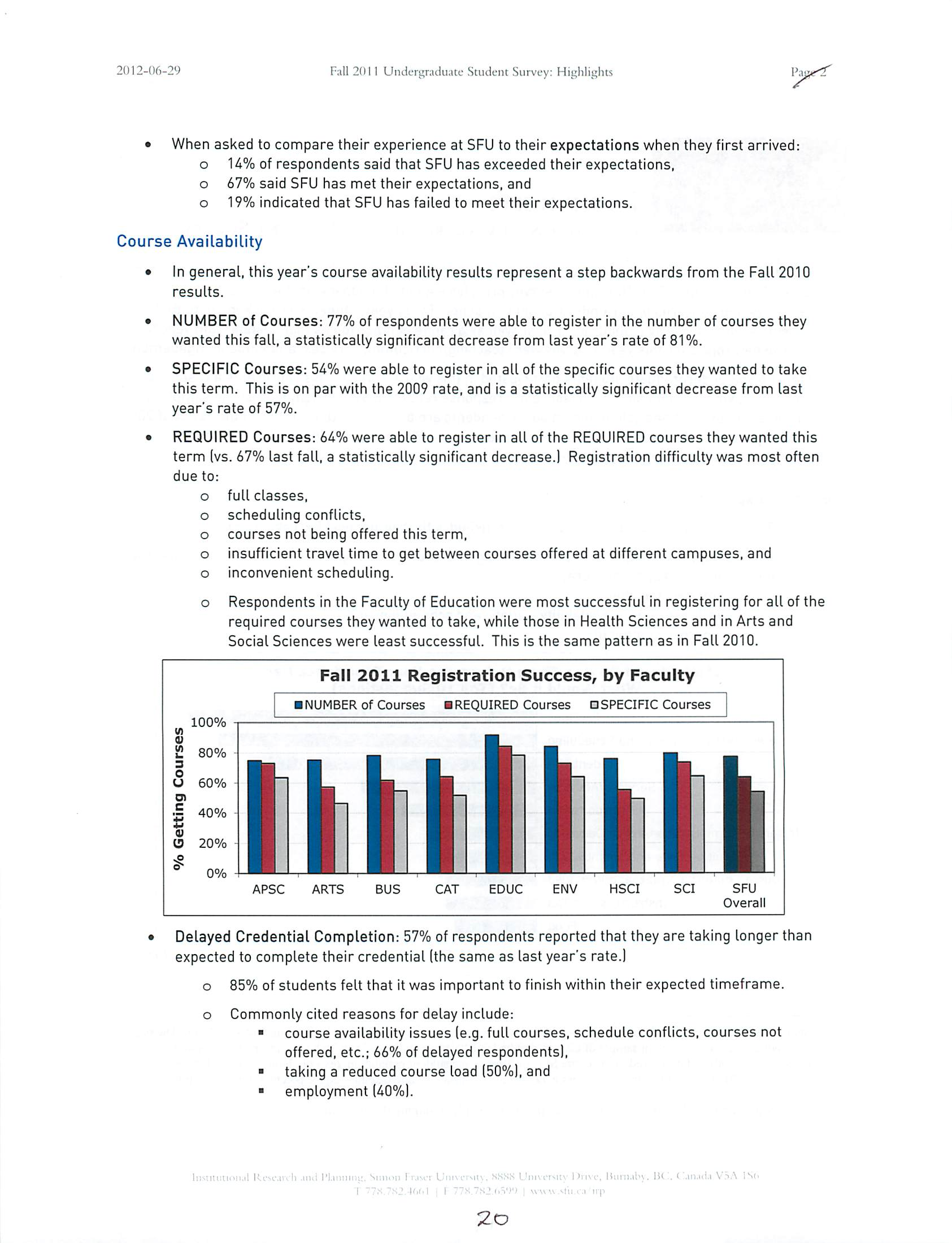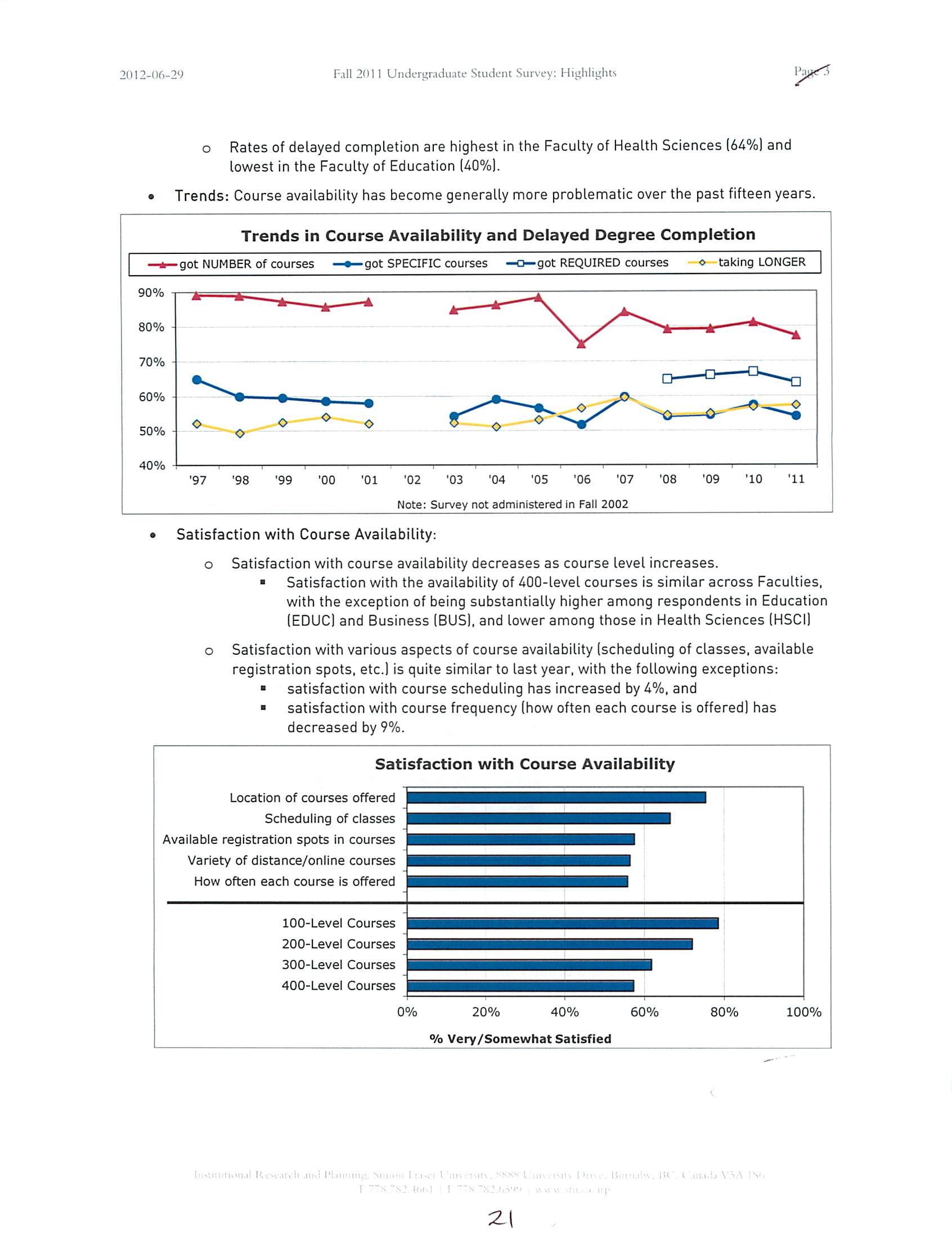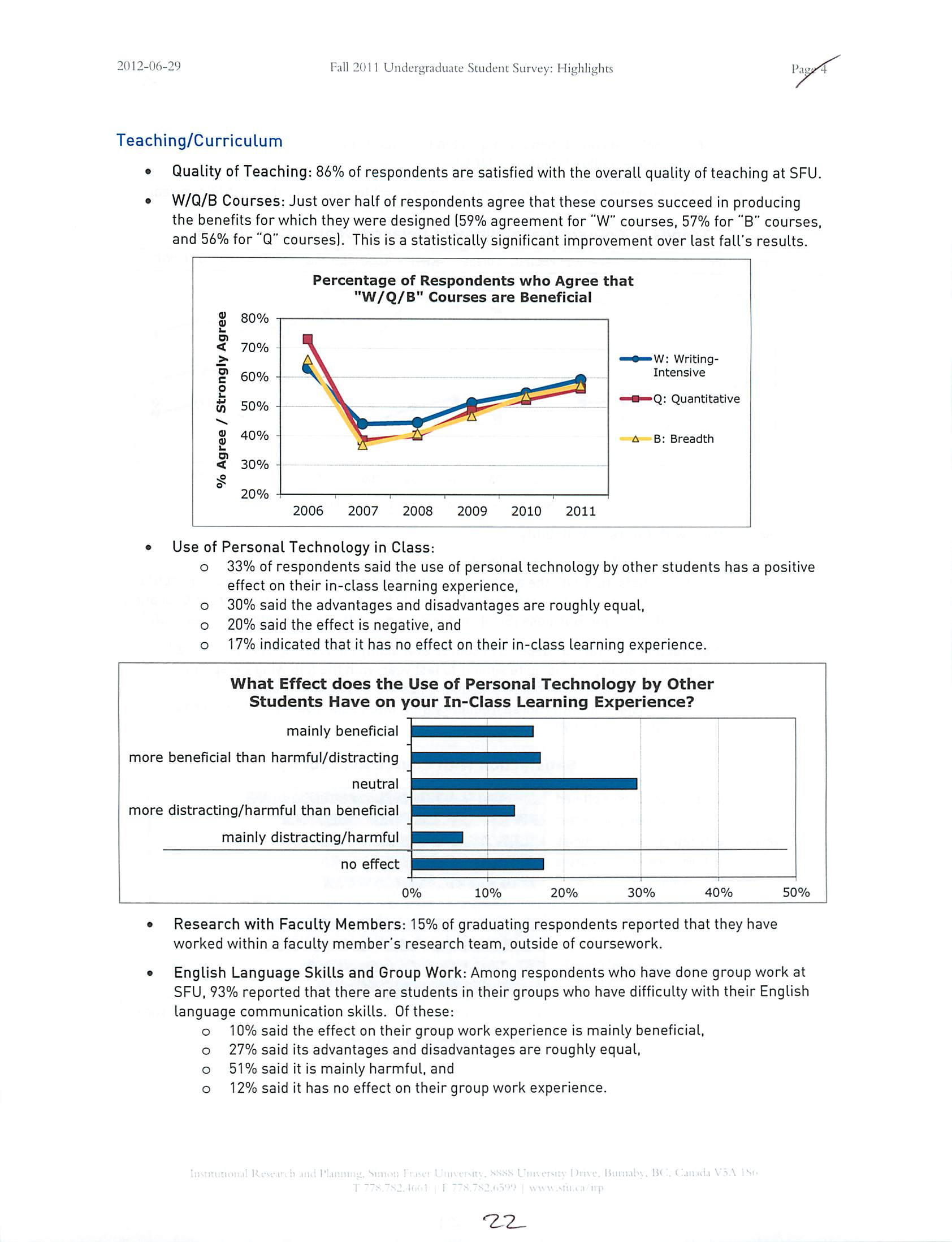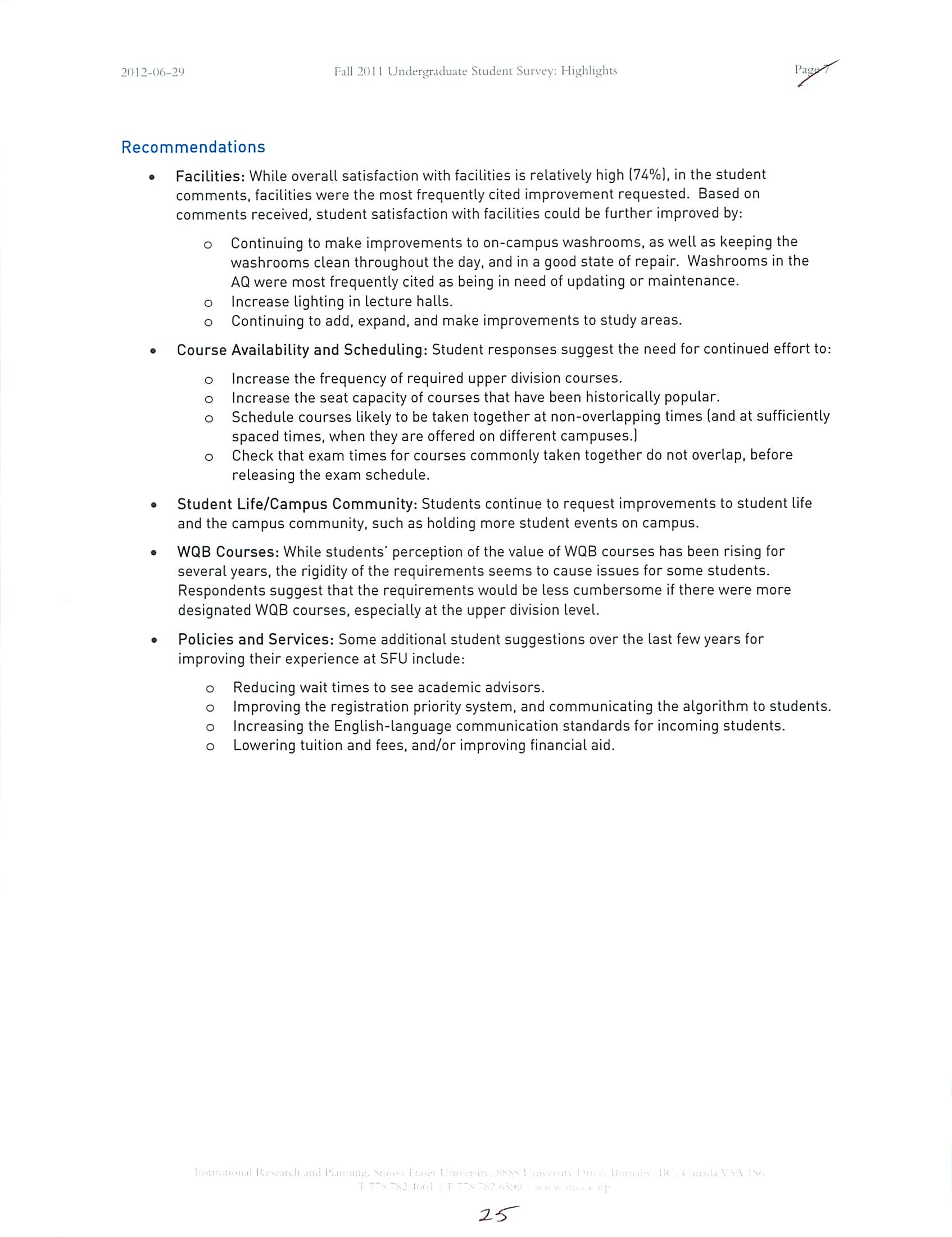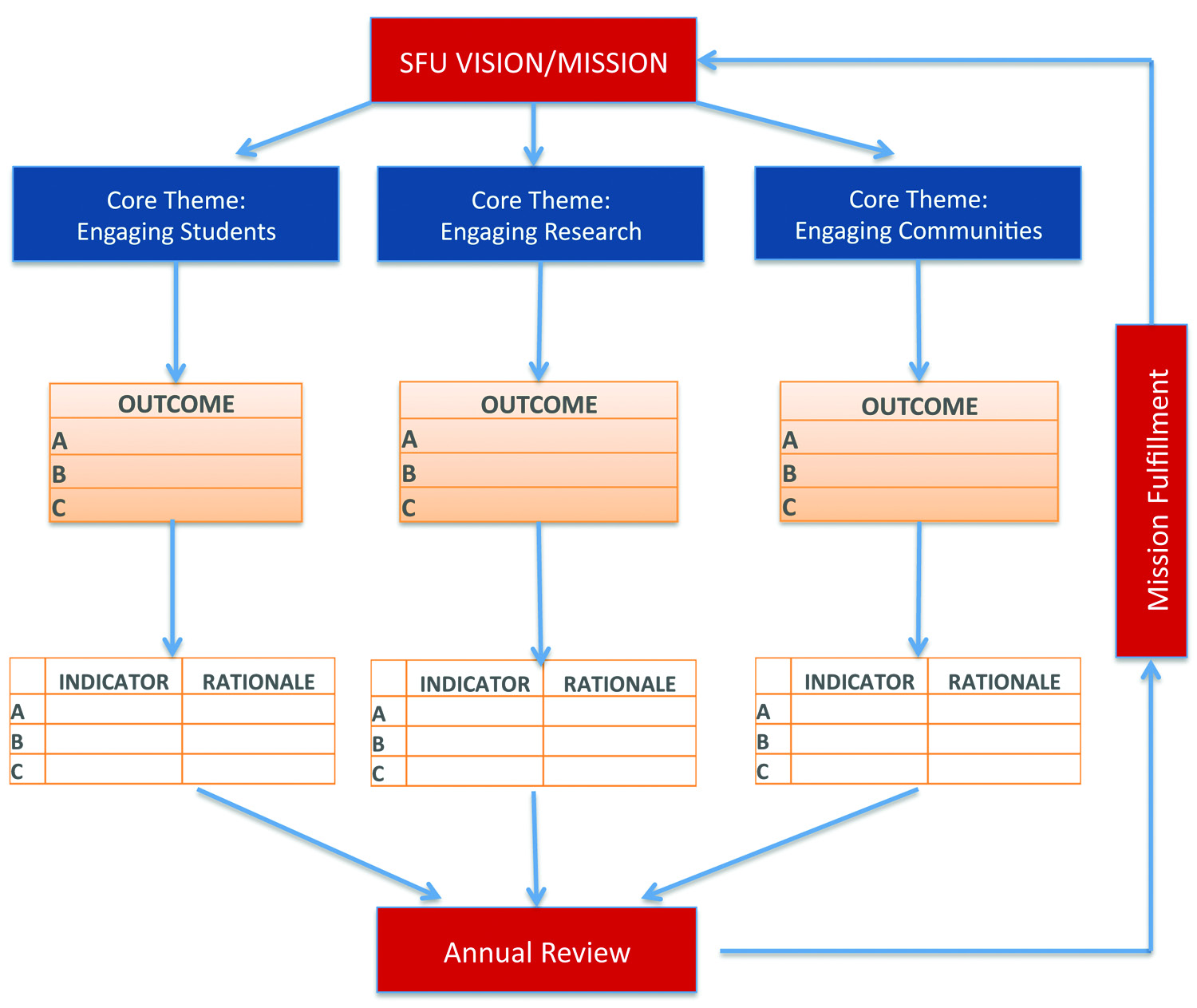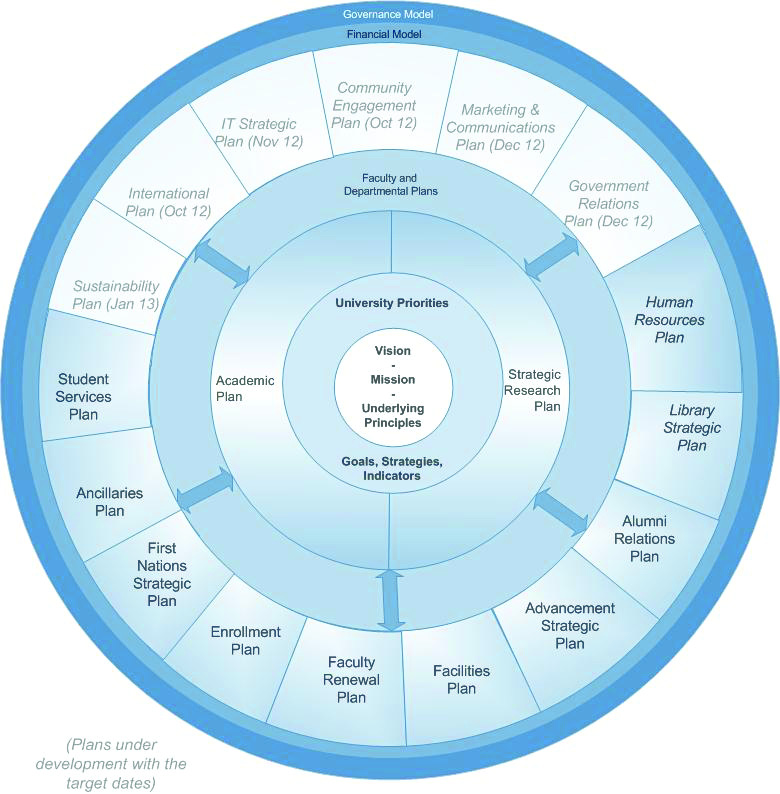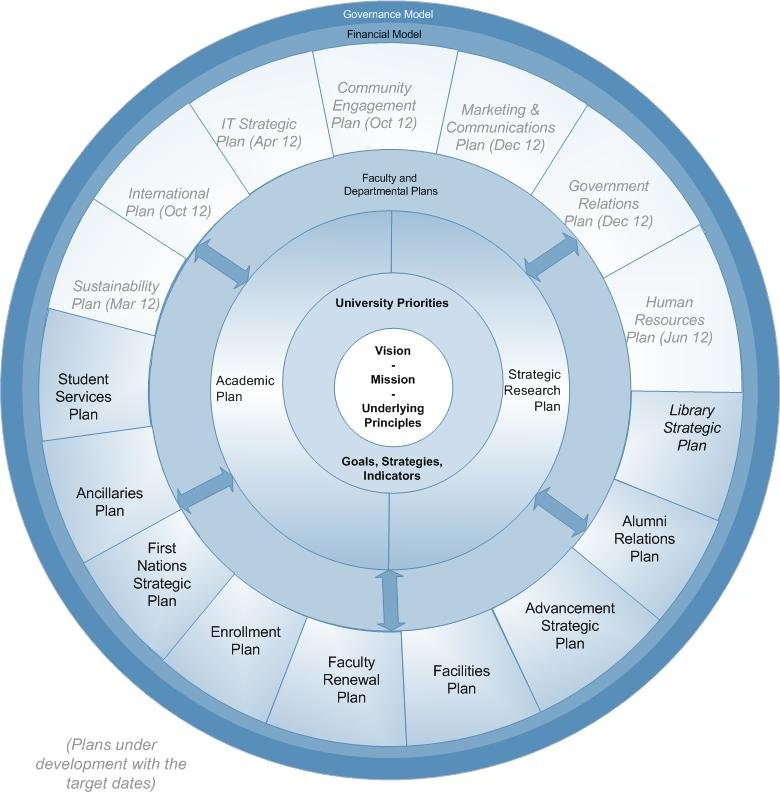SENATE OF SIMON FRASER UNIVERSITY
AGENDA – OPEN SESSION
Monday, September 10, 2012 –
7:00 pm
Room 3210 West Mall Complex
1. Approval of the Agenda
2. Minutes of the Open Session on June 11, 2012
3. Minutes of the Open Session on July 9, 2012
4. Business Arising from the Minutes
5. Report of the Chair
6. Question Period *
7. Reports of Committees
A) Senate Committee on University Priorities (SCUP)
i)
Terms of Reference for the Ryan Beedie Chair in Finance
S.12-124
ii)
Terms of Reference for the Keith Beedie Chair in Innovation and
S.12-125
Entrepreneurship
iii)
Dissolution of the Certificate in Family Studies
S.12-126
iv)
External Review Update for the Faculty of Education (For Information)
S.12-127
v)
External Review Update for the Department of Psychology (For Information)
S.12-128
B) Senate Committee on Undergraduate Studies (SCUS)
i)
Missed Class Guidelines
S.12-129
ii)
Curriculum Revisions – Faculty of Applied Sciences & Faculty of Environment
S.12-130
(For Information)
iii)
Curriculum Revisions – Faculty of Arts and Social Sciences (For Information)
S.12-131
iv)
Curriculum Revisions – Faculty of Communication, Art & Technology
S.12-132
(For Information)
v)
Curriculum Revisions – Faculty of Health Sciences (For Information)
S.12-133
C) Senate Graduate Studies Committee (SGSC)
i)
Curriculum Revisions – Faculty of Arts and Social Sciences (For Information)
S.12-134
ii)
Curriculum Revisions – Faculty of Science (For Information)
S.12-135
D) Senate Nominating Committee (SNC)
i)
Senate Committee Elections
S.12-136
8. Other Business
i)
Institutional Research and Planning (IRP) Reports (For Information)
S.12-137
ii)
NWCCU Accreditation – Year One Self Evaluation Report (For Information)
S.12-138
9. Information
i)
Date of the next regular meeting – Monday, October 1, 2012.
Agenda items and papers for the October meeting will be required by the Secretary at noon on Thursday,
September 13, 2012. Submissions may be emailed to
shelley_gair@sfu.ca
but must be followed up by a signed
paper submission. These items will be considered by the Senate Committee on Agenda and Rules on Tuesday,
September 18, 2012 with Senate distribution on Friday, September 21, 2012.
The Senate agenda and papers are available on the Senate website at
.
Detailed curriculum papers can be found on Docushare at
https://docushare.sfu.ca/dsweb/View/Collection-12682
Kate Ross
Registrar and Secretary of Senate
*
Questions should be submitted in writing to Jo Hinchliffe (email
joah@sfu.ca
) with Senate Question in the
subject line by Wednesday, September 5, 2012 at 9:00 am.
DRAFT UNTIL
APPROVED BY SENATE
Minutes of a Meeting of the Senate of Simon Fraser University held on
Monday, June 11, 2012 at 7:00 pm at the West Mall Complex (Room 3210)
Open Session
Present:
Andrew Petter, President and Chair
Ali, Alia
Black, Sam
Brandhorst, Bruce
Chapman, Glenn
Craig, John
Cupples, Claire
Driver, Jon
Easton, Stephen
Eckman, Charles
Elle, Elizabeth
Flodr, Sarah-Sophia
Geisler, Cheryl
Gordon, Robert
Hall, Angie
Hedley, Nick
Kelm, Mary-Ellen (for W. Parkhouse)
Kopahi, Moe
Krane, Bill
Kropinski, Mary Catherine
Laitsch, Dan
Leacock, Tracey
Li, Paul
Lundgreen-Nielsen, Jens
Magnusson, Kris
O’Neil, John
Palis, Heather
Parekh, Nimisha
Pavsek, Christopher
Percival, Colin
Perry, Tom
Pilarinos, Andreas
Pinto, Mario
Rajapakse, Nimal
Robinsmith, Stacey
Ruben, Peter
Sakhrani, Rohan
Schellenberg, Betty
Kate Ross, Registrar and Executive Director, Student Enrolment
Shelley Gair, Recording Secretary
Shaw, Chris
Tabin, Yvonne (for H. Wussow)
Warner, D’Arcy
Wilson, Meaghan
Zhang, Kevin
Absent:
Brennand, Tracy
Burley, David
Chen, Alexander
Corbett, Kitty
Cyr, Dianne
Delgrande, Jim
Francis, June
Golnaraghi, Farid
Hejazi, Michael
Kong, Shuyu
Leivdal, Joseph
Leznoff, Daniel
McRae, Jennifer
Nilson Levisohn, Michelle
Percival, Paul
Pierce, John
Quarmby, Lynne
Shapiro, Daniel
Somers, Julian
Szeto, Hendson
Taylor, Carole
Tingling, Peter
Woodbury, Rob
In Attendance:
Collins, Colleen
Di Francesco, Concetta
Hinchliffe, Jo
Schiphorst, Thecla
S.M. June 11, 2012
Page 2
https://docushare.sfu.ca/dsweb/View/Collection-17551
1.
Approval of the Agenda
The agenda was approved as distributed.
2.
Minutes of the Open Session on May 22, 2012 will be approved at the Senate meeting on
July 9, 2012.
3.
Business Arising from the Minutes
There was no business arising from the minutes.
4.
Report of the Chair
The Chair, on behalf of Senate, welcomed the following new and re-elected faculty and student
Senators: Jim Delgrande, Peter Tingling, David Burley, Nick Hedley, Betty Schellenberg, Lynne
Quarmby, Elizabeth Elle, Kitty
Corbett,
Rob Woodbury, Chris Shaw, Paul Percival, Peter
Ruben,
Alia Ali, Michael Hejazi, Hendson Szeto, Meaghan Wilson, Kevin Zhang, Nimisha Parakh,
Rohan Sakhrani, Joseph Leivdal, Jens Lundgreen-Nielsen, Moe Kopahi, Angie Hall, Sarah-
Sophia
Flodr,
Stacey Robinsmith, Alexander Chen, Andreas Pilarinos, Heather Palis.
The Chair reported that the Open House was a success with almost 20,000 people attending and
approximately 1,500 students, staff and faculty involved as volunteers.
A new initiative, the SFU Public Square, will be launched as an opportunity to engage the
community on major issues of public policy. The results of a recent survey by the Vancouver
Foundation found that a major issue in Greater Vancouver is a concern regarding disconnection
and isolation within the community. In September the first SFU Public Square Community
Summit, in partnership with the Vancouver Foundation, will be held on this topic.
Senate was informed that recently two major international ranking services (i.e. Times Higher
Education and QS World) focused on universities that are less than 50 years of age and the results
were positive for SFU. The results from both rankings placed SFU as 30th and 25th in the world,
7th and 3rd in North America and 2nd in Canada respectively.
5.
Question Period
There were no questions submitted for question period.
6.
Reports of Committees
A)
Senate Committee on University Priorities (SCUP)
i)
Interaction Design Research Centre (S.12-86)
S.M. June 11, 2012
Page 3
https://docushare.sfu.ca/dsweb/View/Collection-17551
Motion
Moved by J. Driver, seconded by S. Easton
“That Senate approve the proposal for the establishment of the Interaction Design Research
Centre as a Centre for a five year term.”
Question was called and a vote taken.
MOTION CARRIED
ii)
Suspension of Admission and Dissolution of the Advanced Certificate in Criminology
(S.12-87)
Motion 1
Moved by J. Driver, seconded by J. Craig
“That Senate approve the suspension of admission to the Advanced Certificate in
Criminology in the School of Criminology within the Faculty of Arts and Social Sciences,
effective immediately.”
Question was called and a vote taken.
MOTION CARRIED
Motion 2
Moved by J. Driver, seconded by S. Easton
“That Senate approve and recommended to the Board of Governors the dissolution of the
Advanced Certificate in Criminology in the School of Criminology within the Faculty of
Arts and Social Sciences, effective Spring 2013.”
Question was called and a vote taken.
MOTION CARRIED
iii)
Suspension of Admission to the Certificate in Family Studies (S.12-88)
Motion
Moved by J. Driver, seconded by T. Leacock
“That Senate approve the suspension of admission to the Certificate in Family Studies in the
Department of Sociology and Anthropology within the Faculty of Arts and Social Sciences,
effective Spring 2013.”
Question was called and a vote taken.
MOTION CARRIED
iv)
Learning Outcomes and Assessment Principles (S.12-89)
Motion
Moved by J. Driver, seconded by P. Ruben
“That Senate approve the principles that will guide the development of learning outcomes
and assessment processes.”
S.M. June 11, 2012
Page 4
https://docushare.sfu.ca/dsweb/View/Collection-17551
A lengthy discussion followed regarding the positives and negatives of implementing learning
outcomes throughout the university. Some of the key concerns raised were as follows: the
anticipated cost and time commitment required for setting up and maintaining learning outcomes;
the method of measuring outcomes; how accessible the data will be; adequate representation and
input throughout the process; and the purpose of the principles.
Senate was informed that the two main reasons this process was initiated was because of a need to
be accountable to students as well as the provincial and federal government, and secondly, during
the process of accreditation it became clear that the standard of establishing learning outcomes
and assessing those outcomes was an area that SFU lacked compared to other institutions.
The key concerns were addressed as follows:
o
It was too early in the process for cost estimates but it was felt that the costs incurred
would be mitigated by saving time and costs in other curriculum processes. It was also
expressed that this would be an investment in students and the university’s reputation.
o
Learning outcomes will be defined by the academic departments and therefore will not be
imposed by the university. Part of the process will be to define those parts of the
curriculum that can be observed and measured, although it was agreed that not all aspects
of a student’s experience can be measured.
o
Data accessibility will be determined as part of the process.
o
The process will be lengthy and involve significant amounts of consultation (e.g. focus
groups, town hall meeting) with a wide variety of people.
o
The purpose of the principles was to initiate a process and set some boundaries around the
discussion that will happen over the next few years. Senate was assured that approving
this motion only approved the principles, not the development of learning outcomes and
assessment processes.
Several Senators (faculty and students) expressed support from their own personal experience, or
from the experiences of other institutions, regarding the benefits of having learning outcomes.
An
amendment
was proposed by Senator C. Percival, and seconded by Senator M. Kopahi, to
change the word “approve” to “agrees with” in the motion. The amended motion would read as
follows: “that Senate agrees with the principles that will guide the development of learning
outcomes and assessment processes.”
Question was called and a vote taken on amendment
MOTION DEFEATED
A
friendly amendment
was proposed and accepted to change the wording of the first principle
on page 5 from “SFU will establish learning outcomes and assessment processes in order to
communicate transparently the purposes of all degree program and course requirements” to “The
S.M. June 11, 2012
Page 5
https://docushare.sfu.ca/dsweb/View/Collection-17551
primary purpose of learning outcomes and assessment processes is to communicate transparently
the purposes of all degree program and course requirements.”
Question was called and a vote taken.
MOTION CARRIED
v) Revisions to Master of Business Administration Program (S.12-90)
Motion
Moved by J. Driver, seconded by S. Easton
“That Senate approve the revisions to the Master of Business Administration Program
within the Beedie School of Business, effective September 2012.”
A concern was raised regarding a discrepancy in the list of courses on page 5 with another
location within the document as well as the current online calendar. An example is BUS 728
which appears in the online calendar but not in the Senate paper. It was confirmed for Senate that
BUS 728 should be included on the list and that the list in the right hand column on page 5 is
what is currently being approved.
Question was called and a vote taken.
MOTION CARRIED
vi) Name Change of the CMA Centre for Strategic Change and Performance Measurement to
CMA Innovation Centre (S.12-91)
Motion
Moved by J. Driver, seconded by T. Leacock
“That Senate approve that the name of the CMA Centre for Strategic Change and
Performance Measurement be changed to the CMA Innovation Centre.”
Question was called and a vote taken.
MOTION CARRIED
vii)Revisions to the Academic Planning Process (S.12-92)
Motion
Moved by J. Driver, seconded by J. Craig
“That Senate approve the revisions to Senate Guidelines for Academic Plans S.06-62.”
Question was called and a vote taken.
MOTION CARRIED
viii) External Reviews Scheduled for 2012 – 2013 (S.12-93)
Senate received information that the Senate Committee on University Priorities (SCUP) reviewed
the list of external reviews and external review updates that are scheduled for the 2012-2013
academic year.
S.M. June 11, 2012
Page 6
https://docushare.sfu.ca/dsweb/View/Collection-17551
B)
Senate Committee on Undergraduate Studies (SCUS)
i)
Curriculum Revisions – Beedie School of Business (S.12-94)
Senate received information that the Senate Committee on Undergraduate Studies, acting under
delegated authority, approved a revision to an existing program in the Beedie School of Business.
ii)
Curriculum Revisions - Faculty of Communication, Art & Technology (S.12-95)
Senate received information that the Senate Committee on Undergraduate Studies, acting under
delegated authority, approved revisions to existing courses and programs in the Faculty of
Communication, Art and Technology (Communication, Interactive Arts and Technology).
iii)
Curriculum Revisions – Faculty of Education (S.12-96)
Senate received information that the Senate Committee on Undergraduate Studies, acting under
delegated authority, approved a revision to an existing course in the Faculty of Education.
C)
Senate Graduate Studies Committee (SGSC)
i)
Curriculum Revisions – Faculty of Arts and Social Sciences (S.12-97)
Senate received information that the Senate Graduate Studies Committee, acting under delegated
authority, approved revisions to existing programs in the Faculty of Arts and Social Sciences
(Gender, Sexuality and Women’s Studies).
ii)
Curriculum Revisions – Beedie School of Business (S.12-98)
Senate received information that the Senate Graduate Studies Committee, acting under delegated
authority, approved the deletion of some existing courses in the Beedie School of Business.
iii)
Curriculum Revisions – Faculty of Environment (S.12-99)
Senate received information that the Senate Graduate Studies Committee, acting under delegated
authority, approved a revision to an existing course in the Faculty of Environment (Geography).
iv)
Curriculum Revisions – Faculty of Science (S.12-100)
Senate received information that the Senate Graduate Studies Committee, acting under delegated
authority, approved new courses and revisions to existing courses in the Faculty of Science
(Statistics and Actuarial Science).
S.M. June 11, 2012
Page 7
https://docushare.sfu.ca/dsweb/View/Collection-17551
D) Senate Nominating Committee (SNC)
i) Elections by Senate (S.12-101)
Senate received a report from the Senate Nominating Committee on the positions that required a
vote, were elected by acclamation, and outstanding vacancies. Senate was informed that a revised
document would be sent to everyone by email and that online voting would be held from June 12,
2012 to June 14, 2012.
7.
Other Business
i)
Board Election Rules - Notice of Motion (S.12-102)
Senate received the Board Election Rules as a notice of motion (without debate) to be considered
for approval at the July meeting.
ii) Revision to Academic Dates 2012 – 2015 (S.12-103)
Motion
Moved by J. Driver, seconded by S. Easton
“That Senate approve the revised Schedule of Academic Dates 2012 – 2015.”
Senate was informed that this revision was due to “Family Day” being moved to the second
Monday in February. A question was raised regarding whether consideration was given to
aligning Reading Week with other B.C. institutions, in particular UBC. It was reported that
originally SFU was aligned with other institutions but at this time, with everyone adjusting their
schedules, it cannot be confirmed whether or not our Reading Week will be aligned with other
institutions.
Question was called and a vote taken.
MOTION CARRIED
8.
Information
i)
Date of the next regular meeting – Monday, July 9, 2012.
Open session adjourned at 8:47 pm and Senate moved directly into the closed session.
Kate Ross
Registrar & Executive Director Student Enrolment
DRAFT UNTIL
APPROVED BY SENATE
Minutes of a Meeting of the Senate of Simon Fraser University held on
Monday, July 9, 2012 at 5:30 pm at the West Mall Complex (Room 3210)
Open Session
Present:
Paul Percival, Vice-Chair
Black, Sam
Brandhorst, Bruce
Cameron, Rob (for N. Rajapakse)
Chapman, Glenn
Collins, Colleen (for W. Parkhouse)
Craig, John
Delgrande, Jim
Driver, Jon
Eckman, Charles
Elle, Elizabeth
Flodr, Sarah-Sophia
Francis, June
Hall, Angie
Krane, Bill
Laitsch, Dan
Leacock, Tracey
Magnusson, Kris
Moore, Margo (for J. O’Neil)
Nilson Levisohn, Michelle
Palis, Heather
Parekh, Nimisha
Percival, Colin
Pierce, John
Pilarinos, Andreas
Pinto, Mario
Quarmby, Lynne
Robinsmith, Stacey
Schellenberg, Betty
Szeto, Hendson
Tingling, Peter
Warner, D’Arcy
Wussow, Helen
Kate Ross, Registrar and Executive Director, Student Enrolment
Shelley Gair, Recording Secretary
Absent:
Ali, Alia
Brennand, Tracy
Burley, David
Chen, Alexander
Corbett, Kitty
Cupples, Claire
Cyr, Dianne
Easton, Stephen
Geisler, Cheryl
Golnaraghi, Farid
Gordon, Robert
Hedley, Nick
Hejazi, Michael
Kong, Shuyu
Kopahi, Moe
Kropinski, Mary Catherine
Leivdal, Joseph
Leznoff, Daniel
Li, Paul
Lundgreen-Nielsen, Jens
McRae, Jennifer
Pavsek, Christopher
Perry, Tom
Petter, Andrew
Ruben, Peter
Sakhrani, Rohan
Shapiro, Daniel
Shaw, Chris
Somers, Julian
Taylor, Carole
Wilson, Meaghan
Woodbury, Rob
Zhang, Kevin
In Attendance:
Beale, Alison
Gunster, Shane
Moore, Margo
Osborne, Judith
Pratt, Elspeth
S.M. July 9, 2012
Page 2
https://docushare.sfu.ca/dsweb/View/Collection-17952
1.
Approval of the Agenda
A request was made to reverse the order of items S.12-122 and S.12-123 so that the Board
Election Rules in S.12-123 can be considered for approval before they are removed from the
Senate Rules in S.12-122. This revision to the agenda was agreed upon by Senate. One Senator
reported a discrepancy between two versions of the agenda, so the correct version of the agenda
was confirmed by the Vice-Chair.
2.
Minutes of the Open Session on May 22, 2012.
Approval of the minutes was moved by Senator C. Percival and seconded by Senator Krane. It
was noted that Senator Craig was present at the meeting on May 22, 2012
.
The minutes were
approved with this revision.
3.
Business Arising from the Minutes
There was no business arising from the minutes.
4.
Report of the Chair
The Vice-Chair acknowledged that this was the last meeting for Senator Bill Krane as Associate
Vice-President Academic and thanked him, on behalf of Senate, for his many years of service as a
Senator. Secondly, Senate was informed that a call for honorary degree nominations would be
going out soon with a deadline of September 14
th
.
5.
Question Period
There were no questions submitted for question period.
6.
Reports of Committees
A)
Senate Committee on University Priorities (SCUP)
i)
Master of Arts Double Degree Program in Global Communications,
SFU-Communication University of China (S.12-104)
Motion
Moved by J. Driver, seconded by G. Chapman
“That Senate approve and recommend to the Board of Governors the Full Program Proposal
for Simon Fraser University – Communication University of China, Master of Arts Double
Degree Program in Global Communications in the School of Communication within the
Faculty of Communication, Art and Technology, effective Fall 2013.”
In response to a question that was raised, Senate was assured that the three entrance scholarships
referred to on p. 7 of the document would be administered using the regular process for approval.
It was confirmed that the admission requirements in the proposal (p. 4) should be the same as the
calendar description (p. 16) by referring to a “500 to 600 word essay” instead of “two to three
page essay”. It was clarified for Senate that the activity fee is for various field trips that are out of
province.
Question was called and a vote taken.
MOTION CARRIED
S.M. July 9, 2012
Page 3
https://docushare.sfu.ca/dsweb/View/Collection-17952
ii)
Terms of Reference for Proposed Chair in HIV/AIDS at St. Paul’s Hospital (S.12-105)
Motion
Moved by J. Driver, seconded by J. Pierce
“That Senate approve and recommend to the Board of Governors the Terms of Reference
for the proposed Chair in HIV/AIDS at St. Paul’s Hospital.”
Question was called and a vote taken.
MOTION CARRIED
iii)
External Review of the School for the Contemporary Arts (S.12-106)
Motion
Moved by J. Driver, seconded by B. Schellenberg
“That Senate approve the Action Plan for the School for the Contemporary Arts that
resulted from its External Review.”
Question was called and a vote taken.
MOTION CARRIED
iv)
External Review Update for the Department of Chemistry (S.12-107)
Senate received information that the Senate Committee on University Priorities reviewed the
External Review Update Report for the Department of Chemistry within the Faculty of Science.
B)
Senate Committee on Undergraduate Studies (SCUS)
i)
BC 12 Admission Criteria for the School for the Contemporary Arts (S.12-108)
Moved by B. Krane, seconded by J. Craig
“That Senate approve the changes to the BC 12 Admission Criteria for the School for the
Contemporary Arts within the Faculty of Communication, Art and Technology.”
Senate was informed that an expected amendment to the list of courses on the last page was not
received in time for this meeting. After some discussion on how to proceed, this motion was
withdrawn by the mover. This item will return to Senate once the information has been updated.
MOTION WITHDRAWN by B. Krane
ii)
Curriculum Revisions – Faculty of Applied Sciences (S.12-109)
Senate received information that the Senate Committee on Undergraduate Studies, acting under
delegated authority, approved revisions to existing courses in the Faculty of Applied Sciences
(Engineering Science).
S.M. July 9, 2012
Page 4
https://docushare.sfu.ca/dsweb/View/Collection-17952
iii)
Curriculum Revisions – Faculty of Arts and Social Sciences (S.12-110)
Senate received information that the Senate Committee on Undergraduate Studies, acting under
delegated authority, approved new courses and revisions to existing courses and programs in the
Faculty of Arts and Social Sciences (World Literature, Criminology, Political Science,
Humanities, Explorations).
iv)
Curriculum Revisions - Faculty of Communication, Art & Technology (S.12-111)
Senate received information that the Senate Committee on Undergraduate Studies, acting under
delegated authority, approved new courses and revisions to existing courses and programs in the
Faculty of Communication, Art and Technology (TechOne, Communication, Interactive Arts and
Technology).
v)
Curriculum Revisions – Faculty of Education (S.112)
Senate received information that the Senate Committee on Undergraduate Studies, acting under
delegated authority, approved revisions to an existing course and programs in the Faculty of
Education.
vi)
Curriculum Revisions – Faculty of Environment (S.113)
Senate received information that the Senate Committee on Undergraduate Studies, acting under
delegated authority, approved new courses and revisions to existing courses and programs in the
Faculty of Environment (Archaeology, Environment, Geography).
vii) Curriculum Revisions – Faculty of Health Sciences (S.114)
Senate received information that the Senate Committee on Undergraduate Studies, acting under
delegated authority, approved revisions to existing courses in the Faculty of Health Sciences.
C)
Senate Graduate Studies Committee (SGSC)
i)
GGR 1.3.6 and GGR 1.3.8 Admission as a Qualifying Student and Conditional
Admission (S.12-115)
Motion 1
Moved by C. Collins, seconded by S. Black
“That Senate approves the changes to GGR 1.3.6 Admission as a Qualifying Student”
Question was called and a vote taken.
MOTION CARRIED
S.M. July 9, 2012
Page 5
https://docushare.sfu.ca/dsweb/View/Collection-17952
Motion 2
Moved by C. Collins, seconded by S. Black
“That Senate approve the changes to GGR 1.3.8 Conditional Admission”
A concern was raised regarding item 6 on page 3 with regard to students who have not completed
their degree, or provided evidence of meeting the English language requirements, being granted
regular admission and then given an allowance of two terms to submit their documentation
showing that these requirements have been fulfilled. Senate was informed that the purpose of this
allowance is to cover administrative issues (e.g. an outstanding grade) or timing issues with the
English competency exams.
Question was called and a vote taken.
MOTION CARRIED
ii)
GGR 1.3.13 Certificate Programs (S.12-116)
Motion
Moved by C. Collins, seconded by S. Black
“That Senate approve the changes to GGR 1.3.13 Certificate Programs”
Question was called and a vote taken.
MOTION CARRIED
iii)
GGR 1.4.7 Co-operative Education (S.12-117)
Motion
Moved by C. Collins, seconded by M. Nilson Levisohn
“That Senate approve the changes to GGR 1.4.7 Co-operative Education”
Question was called and a vote taken.
MOTION CARRIED
iv)
GGR 1.7.6 Courses in Master’s and Doctoral Programs (S.12-118)
Motion
Moved by C. Collins, seconded by M. Nilson Levisohn
“That Senate approve the changes to GGR 1.7.6 Courses in Master’s and Doctoral
Programs”
Question was called and a vote taken.
MOTION CARRIED
v)
Curriculum Revisions – Faculty of Arts and Social Sciences (S.12-119)
Senate received information that the Senate Graduate Studies Committee, acting under delegated
authority, approved revisions to existing programs in the Faculty of Arts and Social Sciences
(Political Science, Public Policy).
S.M. July 9, 2012
Page 6
https://docushare.sfu.ca/dsweb/View/Collection-17952
D) Senate Nominating Committee (SNC)
i) Elections by Senate (S.12-120)
Senate received a report from the Senate Nominating Committee on the positions that require a
vote, the positions that were elected by acclamation, and outstanding vacancies. Senate was
informed that online voting would begin on July 10, 2012.
7.
Other Business
i)
Election Report (S.12-121)
Senate received the results of elections to Senate and the Board of Governors for information.
ii)
Board Election Rules (S.12-123)
Motion
Moved by J. Driver, seconded by C. Percival
“That Senate approve the attached Board Election Rules effective immediately.”
An explanation was requested for the difference between voting periods. The voting period for
faculty and staff elections is two to four days and the voting period for student elections is two to
five days. Senate was informed that this is the existing practice and it is believed that the voting
period for students is fixed by other factors. It was also pointed out that under the general
regulations on page 5, there is an item addressing faculty elections and student elections but no
item addressing non-faculty staff member elections. It was agreed that an item regarding the
election of non-faculty staff members should be added to this section.
Question was called and a vote taken.
MOTION CARRIED
ii)
Revisions to Rules of Senate (S.12-122)
Motion
Moved by J. Driver, seconded by C. Percival
“That Senate approve the revisions to the Rules of Senate as per the attached document,
effective immediately.”
Question was called and a vote taken.
MOTION CARRIED
8.
Information
i)
Date of the next regular meeting – Monday, September 10, 2012.
Open session adjourned at 6:20 pm and Senate moved directly into the closed session.
Kate Ross
Registrar & Executive Director Student Enrolment
SFU
MEMORANDUM
OFFICE OF THE VICE-PRESIDKN I, ACADEMIC AND PROVOST
University Drive, Burn.ibv, BC
Canada V5A 1S6
TKI.: 778.782.3925
PAX: 778.782.5876
S.12-124
attention
Senate
date
July 25,2012
FROM
Jon Driver, Vice-President, Academic and
pages
1/1
Provost, and Chair, SCUP
RE:
Beedie School of Business: Terms of Reference the Ryan Becdie Chair in Finance
(SCUP 12-26)
At itsjuly 11, 2012 meeting SCUP reviewed and approved the Terms of
Chair in Finance.
nee for the Ryan Beedie
Motion:
That Senate approve and recommend to the Board of Governors the Terms of Reference for the Ryan
Beedie Chair in Finance.
encl.
c: D. Shapiro
C. Daminato
SIMON FRASER UNIVERSITY
engaging the world
MEMO
Office of the Dean
Beedie School of Business
MAILING ADDRESS
WMC5310
8888 University Drive
BumabyC Canada
VSA 1S6
778.782.4183
778.782.5155
dshapiro@sfu.ca
SCUP 12-26
Beedie School of Business
ATTENTION Dr. Jon Driver, Vice-Presidenl, Academic
Date July 3, 2012
FROM Dr. Daniel Shapiro, Dean, Beedie School of Business
RE Approval of Terms of Reference for the Keith Beedie Chair in Innovation and
Entrepreneurship and the Ryan Beedie Chair In Finance
I would like to recommend the approval of the creation The Keith Beedie Chair
in Innovation and Entrepreneurship and the Ryan Beedie Chair in Finance. Two
endowment funds of $3 million have been established to support these chairs;
funding will come from the $22 million donation from Ryan Beedie. The two
chairs are consistent with the strategic direction of the Beedie School. In
particular, they will support our focus on innovation, commericialization, and
entrepreneurship and our focus on financial risk management and corporate
governance.
Terms of Reference for these Chairs are attached.
I request that you bring this recommendation forward for discussion with the
appropriate individuals as well as SCUP and Senate for approval, in accordance
with policies A10.03 and GP 35.
c.
Ms. Cathy Daminato, Vice-President, Advancement and Alumni Engagement
2.
SIMON PRASES UNIVERSITY
ENGAGING THE WORLD
SFU
RYAN BEEDIE CHAIR IN FINANCE ENDOWMENT FUND
Terms ofReference
The Ryan Beedie Chair in Finance Endowment Fund was established in 2012 widi
$3
million of the
historic $22 million donation to SFU Business from the Beedie family, led by Ryan and Keith Beedie.
The endowment fund supports the Ryan Beedie Chair in Finance m the Beedie School
of Business.
The Donors
Ryan and Keith Beedie donated $22 million to Ryan's alma mater, SFU Business,which will now be
named the Beedie School
of Business. The Beedie Family donation is the largest gift that Simon Eraser
University- has ever received Burn and raised inBurnaby BC, P.yan Beedie earned his BBA in 1991 at
SFU and his MBA in 1993 at
UBC Jn 1992, he joined his family's industrial real estate development
firm.
Under Ryan's directiun, the firm has grown to be the largest landlord ofindustrial space in
British Columbia.
Purpose of the Chair
The Ryan Beedie Chair in Finance will provide excellence in research and teaching in the field of
finance, which could include subspecialties related to accounting, financial entrcpreneurship, capital
markets/ asset management or corporate governance. Income from the fund will be used to pay the
salary, benefits and related research expenses for the Chair.
Fund Administration
The endowment fund will be held by Simon Fraser University. The administrator of the fond will be
the Vice President, Academic. The annual spending allocation of the fund, defined in SFU's
Endowment Management Policy GP20, will be used each year to support the activities of the Chair.
In the event that circumstances make the specified use of die endowment fund no longer practicable or
desirable, the Board of Governors of Simon Fraser University is hereby authorized to make any
changes it may deem necessary in the terms or use of the endowmentfund, such changes, however, to
be in
keeping as far as possible with the original spirit and general interest of the endowment fund.
Appointment
The appointment will be for a five (5) year renewable tenn. The appointment and any renewal will be
concluded in accordance with applicable University policies.
Reporting
The Beedie School ofBusiness will provide an annual report to the donor on the activities of the
Chairholder.
JU-P-a-g e-
SFU
RYAN BEEDIE CHAIR IN FINANCE ENDOWMENT FUND
Terms ofReference
Aaepted by:
Ryan Beedie
President
Beedie Group
Date
/fa*
7 ^v/z
QsStLt
Cathy Damjiiato
Vice-Presioefft, Advancement
Simon Fraser University
^••9 yrjn^J^ a.ot-2-.
Date
unci
ShapfrcT^^
Dean, Faculty of Business
Simon Fraser University
8,30a
Date
lonafhan Driver
[Vice-President, Academic
imon Fraser University
2A>
(/\Ac<vc^
Zo{
Date
V
2-| Pflge
SFU
MEMORANDUM
OFFICEOFTHEVICE-PRES1DI.N I. ACADKMIC AND l'ROVOSl
88H8 University Drive, Biirnaby, BC
Canada V5A
1S6
TEL: 778.782.3925
FAX: 778.782.5876
attention
Senate
date
July 25,2012
from
Jon Driver, Vice-President, Academic and
pages
1/1
Provost, and Chair, SCUP
RE:
Beedie School of Business: Terms of Reference the Keith Beedie Chair in Innovation a?
Entrepreneurship (SCUP 12-25)
At itsJuly 11, 2012 meeting SCUP reviewed and approved the Terms of
Chair in Innovation and Entrepreneurship.
S.12-125
nee for the Keith Beedie
Motion:
That Senate approve and recommend to the Board of Governors the Terms of Reference for the Keith
Beedie Chair in Innovation and Entrepreneurship.
end.
c: D. Shapiro
C. Daminato
SIMON FRASEK UNIVERSITY
ENGAGING THE WORLD
MEMO
Office of the Dean
Beedie School of Business
MAILING ADDRESS
WMC5310
8888 University Drive
Bumaby C Canada
VSA 1S6
778.782.4183
778.782.5155
dshapiro@sfu.cn
SCUP 12-25
Beedie School of Business
ATTENTION
Dr. Jon Driver, Vice-President, Academic
Date July
3, 2012
FROM
Dr. Daniel Shapiro, Dean, Beedie School of Business
RE
Approval of Terms of Reference for the
Keith Beedie Chair in Innovation and
Entrepreneurship
and
the Ryan Beedie Chair In Finance
I would like to recommend the approval of the creation The Keith Beedie Chair
in Innovation and Entrepreneurship and the Ryan Beedie Chair in Finance. Two
endowment funds of $3 million have been established to support these chairs;
funding will come from the $22 million donation from Ryan Beedie. The two
chairs are consistent with the strategic direction
of the Beedie School. In
particular, they will support our focus on innovation, commericialization, and
entrepreneurship and our focus on financial risk management and corporate
governance.
Terms of Reference for these Chairs are attached.
I request that you bring this recommendation forward for discussion with the
appropriate individuals as well as SCUP and Senate for approval, in accordance
with policies A10.03 and GP 35.
c.
Ms. Cathy Daminato, Vice-President, Advancement and Alumni Engagement
7~
SIMON ERASER UNIVERSITY
ENGAGING THE WORLD
SFU
KEITH BEEDIE CHAIR IN INNOVATION AND ENTREPRENEURSHIP
ENDOWMENT FUND
Terms ofReference
The Keith Beedie Chair in Innovation and Entrepreneurship Endowment Fund was established in
2012 with $3 million of the historic $22 million donation to SFU Business from the Beedie family, led
by Ryan and Keith Beedie. The endowment fund supports the Keith Beedie Chair in Innovation and
Entrepreneurship
in
die Beedie School ofBusiness.
The Donors
Ryan and Keith Beedie donated $22 million to Ryan's alma mater, SFU Business, which will now be
named the Beedie School ofBusiness The Beedie Family donation is the largest gift that Simon Fraser
University has ever received. Born and raised in Burnaby BC, Ryan Beedie earned his BBA in 1991 at
SFU and his MBA in 1993 at UBC. In 1992, he joined his family's industrial real estate development
firm. Under Ryan's direction, the firm
has grown to be the largest landlord ofindustrial space in
British Columbia.
Purpose of the Chair
The Keith Beedie Chair in Innovation and Entrepreneurship provides excellence in research and
Leaching in the fields of entrepreneurship and/or innovation at the Beedie School ofBusiness. Income
from the fund will be used to pay the salary, benefits and related research expenses for the Chair.
Fund Administration
The endowment fund will be held by Simon Fraser University. The administrator of the fund will be
the Vice President, Academic.
The annual spending allocation of the fund, defined in SFU's
Endowment Management Policy GP20, will be used each year to support the activities of the Chan.
In the event that circumstances make the specified use of the endowment fund no longer practicable or
desirable, the Board of Governors of Simon Fraser University is hereby authorized to make any
changes it may deem necessary in the terms or use of the endowment fund, such changes, however, to
be in keeping as far as possible with the original spirit and general interest of the endowment fund.
Appointment
The appointment will be for a five (5) year renewable term. The appointment and any renewal will be
concluded in accordance with applicable University policies.
Reporting
The Beedie School ofBusiness will provide an annual report to the donor on the activities of the
Chairholder.
4_L_T2_a-g_c
SFU
KEITH BEEDIE CHAIR IN INNOVATION AND ENTREPRENEURSHIP
ENDOWMENT FUND
Terms ofReference
Accepted by:
Ryan Beedie
President
Beedie Group
Date
7,^/
1
Cathy Dairtfcato
Vice-President, Advancement
Simon Fraser University
/3?
Tntu^Lj 2.Qils
Date
D&iel Shapiro -
Dean, Faculty of Business
Simon Fraser University
t[£M 9. AO/Z
Jonathan Driver
•Vice/-President, Academic
ijiimon Fraser University
7k
/WvCK
lo
Date
H
2-hP^-r-
SFU
MEMORANDUM
OFFICE OF
THE
VICE-PRESIDENT, ACADEMIC
AND
PROVOST
University Drive,
Burnaby,
BC
Canada V5. \ 1S6
TEL: 778.782.3925
FAX: 778.782.5876
attention
Senate
date
July 25,2012
FROM
Jon Driver, Vice-President, Academic and
PAGES
1/1
S.12-126
RE:
Provost, and Chair, SCUP
Faculty of Arts and Social Sciences: Dissolution of the Certificate in Family Studies,
Department of Sociology and Anthropology (SCUP 12-21)
f
At itsJuly 11, 2012 meeting SCUP reviewed and approved the proposal to dissblve/the Certificate in
Family Studies in the Department of Sociology and Anthropology within the Fac^mty of Arts and Social
Sciences.
Motion:
That Senate approve and recommend to the Board of Governors the dissolution of the Certificate in
Family Studies in the Department
of Sociology and Anthropology within the Faculty of Arts and Social
Sciences, effective Summer 2013.
end.
c: P. Budra
SIMON FRASHR UNIVERSITY
ENGAGING THE WORLD
SFU
MEMORANDUM
ATTENTION
FROM
RE:
SCUP 12-21
OFFICE OF THE ASSOCIATE VICE-PRESIDENT, ACADEMIC AND
ASSOCIATE PROVOST
University Drive,
TEL: 778.782.4636
avpciotasfu.ca
Burnaby, BC
Canada V5A1S6
Senate Committee on University
Priorities
Bill Krane, Chair
Senate Committee on Undergraduate
Studies
Faculty of Arts and Social Sciences (SCUS 12-29e)
/
DATE
PAGES
June 8, 2012
1/1
4,
u
Action undertaken by the Senate Committee on Undergraduate Studies at its meeting of
June 7, 2012, gives rise to the following recommendation:
Motion:
That SCUP approve and recommend to Senate the dissolution of the Certificate in
Family
Studies in the Department of Sociology and Anthropology within the
Faculty of Arts and Social Sciences.
The relevant documentation for review by SCUP is attached.
SIMON FRASEB UNIVERSITY
engaging the world
Z-
SCUS 12-29£
FASSCC 12-22
SIMON PHASER UNIVERSITY
DEPAimmNT OFSOaOLOCYScANTHROPOLOGY
FACULTY OF ARTS AND SOCIAL SCIENCES
MEMORANDUM
To: Paul Budra, Chair ofFASSCC
From:
Yildiz Atasoy, Undergraduate Chair
Subject:
Dissolution ofmeCertificate inFamily Studies
Pate:
8 May2012
At its meetingof7 December2011 theDepartment ofSociologyand Anthropology
approved the dissolution of theCertificate in Family Studies. At its meeting of26
January 2012 the FASSCC approved thesuspension ofadmission totheCertificate in
FamilyStudies. The motionwillgobeforeSCUP on 16May2012.
Program to be dissolved: CertificateinFamily
Studies.
Final dissolution date is effective ofFall 2012.
Reasons for dissolution ofthe Certificate in FamilyStudies: There are no students
enrolledin the program.As this program is no longerviable,the SA Departmentwould
like to terminate the certificate.
Would youpleaseplacethison theagenda forthenextmeeting oftheFaculty ofArtsand
Social Sciences Curriculum Committee?
Thank you.
Signature: Yildiz Atasoy
1.Impactedcredentials, levels and categories ofthe degree,and specific
disciplineor field ofstudy:
TheCertificate in Family Studies
2. Location ofthe program:
Dept ofSociology and Anthropology
3.Faculty(ies), Department(s), or School(s)offeringthe program:
Dept ofSociology
andAnthropology, FASS. Other courses are from Gerontology, Psychology, Criminology,
History, and Gender, Sexuality and Women'sStudies, in FASS, and Communications and
Kinesiology in FAS
4. Anticipated final dissolution date:
Sept 2012
5.
Reasons for
termination ofthe program:
no students have enrolled in the program in
many years
6. Plan for phasing-out ofprogram:
there are no students to consult because none are in
the programor have expressed interest inthe program.Instructors and staffhave been
advised ofthe decision to dose it There are no resources to reallocate and no impact on
cognate disciplines.
7. Contact person:
Paul Budra, Associate Dean,FASS for more information: budra@sfu.ca.
24416.
V
SFU
MEMORANDUM
OFFICE OFTHEVICI'-I'RI'SIDI'.N'I,.\(;.\Di:.MIC.\Nl) PROVOST
University Drive, Burnaby, BC
Canada \'5.\ 1S6
TEL: 778.782.3925
FAX: 778.782.5876
ATTENTION
Senate
date
July 25,2012
from
Jon Driver, Vice-President, Academic and
pages
1/1
Provost, and Chair, SCUP
RE:
External Review Update for the Faculty of Education (SCUP 12-24)
S.12-127
At its July 11, 2012 meeting SCUP reviewed the External Review
Education. The report is attached for the information of Senate.
Report for the Faculty of
encl.
c: B. Krane
SIMON FRASER UNIVERSITY
ENGAGING THE WORLD
SFU
OFFICE OF THE VICE-PRESIDENT, ACADEMIC AND PROVOST
University Drive, Burnaby, BC
Canada V5A 1S6
TEL 778.782.6702
FAX: 778.782.5876
MEMORANDUM
attention
Jon Driver, Chair, SCUP
FROM
Bill Krane, Associate Vice-President,
Academic and Associate Provost
cc
K. Magnusson
External Review Update for the Faculty of Education
RE:
date
June 28,2012
PAGES
1/1
/l4jL
SCUP 12-24
The External Review of the Faculty of Education was undertaken in March 2008. According to the
procedures established by SCUP, the Faculty is required to submit an update describing its progress in
implementing Senate's recommendations, which were derived from the External Review report, in the
fourth year following the start
of the External Review process. Please find attached this update, together
with a copy of the recommendations approved by Senate for action.
Based on this midterm report, my assessment is that the Faculty has made substantial progress toward
implementing Senate's recommendations, within the constraints imposed by its budget.
SIMON FRASER UNIVERSITY
ENGAGING THE WORLD
2-
FACULTY OF EDUCATION
Office of the Dean
Education Building EDB 8525
8888 University Drive, Burnaby, BC
FAX 778.782.4576
Canada V5A 1S6
MEMORANDUM -
ATTENTION:
Glynn Nicholls
DATE:
May 15, 2012
FROM:
PAGES:
1/6
RE:
External Review Update,
Faculty ofEducation
The Faculty of Education is pleased to provide this brief progress report on actions taken by the
Faculty in response to the recommendations of the 2008 external Review of the Faculty. For
brevity sake, we have reported on actions taken under each ofthe six headings, with the core
recommendation indicated in italics. Furthermore, the categories are not mutually exclusive; for
example, a number of"Programmes Recommendations" (section 5) are described under Section
1 (strategic planning).
1. Faculty Strategy, and strategic planning processes.
An agreed upon set
ofpriorities or goals against which all individual and collective work can be
planned, carried out and evaluated.
• In August of 2009, we completely
redrafted our 3-Year Academic Plan.
The Academic
Plan reflected the recommendations from the external review, as well as a process of faculty
consultation, feedback and revisions. We are now inthe 3rd year ofplan implementation;
programming and budget decisions have been made in relation to the plan. Copies of the
Academic Plan as well as a 2011 report documenting progress towards that plan are available
on request.
• Instituted
Executive planning retreats.
In early September ofeach year, an Executive
(Program Directors, Associate Deans, Dean) retreat is held. Priorities for action for the
coming year in relation to the 3-Year Plan are identified, and then update reports are
provided at the biweekly Executive meetings throughout the year.
A structure oforganizational units that best suits the achievements ofthese priorities, more
closely aligns with the operation ofthe Faculty, and supports its various undergraduate,
graduate andprofessionalprogrammes.
• Developed and implemented a new administrative structure incorporating Field Programs
and Graduate Programs into the portfolio ofa new Associate Dean Graduate Studies and
Research in Education. In turn, this new administrative unit:
o Produced a report to the Dean providing 13 recommendations for priorities and
actions in graduate studies,
o Developed a framework for a program review ofthe various graduate programs,
which uses common metrics to compare and contrast program delivery attributes and
efficiencies.
SIMON FRASF.R UNIVERSITY
thinking of the world
3
FoE External Review Update
o Developed and applied a framework/guidelines for use by the Graduate Programs
Committee in considering proposals for new programs. The framework is used to
evaluate proposed new programs using the criteria of documented need/demand,
fidelity to the faculty's strategic directions/priorities, current instructional capacity to
deliver the program, and sustainability
o Established an annual schedule for collection and analysis
of information needed for
enrollment management.
o Implemented two-year financial support packages offered to top PhD applicants as a
means
of improving recruitment outcomes.
• Restructured the non-departmentalized units to increase the articulation between Field
Programs and Graduate Studies as well as Teacher Education Programs and Undergraduate
Programs.
• Created the Office ofIndigenous Education within the faculty.
•
Revised the mandate and operations
of the Office ofInternational Education, and instituted a
Faculty
of Education Internationalization Committee.
A review ofdecision making structures andprocesses to ensureclarity ofauthority and a high
degree oftransparency.
• Developed, ratified, and published a Faculty Governance structure in service of transparency
and explicit articulation of decision-making pathways;
• Instituted formal procedures for Executive Meetings, with clear indication of
discussion/action items, and publicizing agendas/minutes.
2. Communication
Continue to seek ways ofincreasing communication betweenfaculty and staffmembers at the
three campuses including the use oftechnology, a webportal and the consideration ofthe
introduction ofan annual retreat.
[NOTE: We do not have, nor have we ever had, staffor faculty permanently based at the
Vancouver Campus. Therefore, reference will be made to work done to better link the Burnaby
and Surrey campus activities.]
•
Completely rebuilt the Faculty of Education website on the CQ5 CMS platform. The
platform switch also enabled a complete redesign and clean up of the multiple site
components.
v
• Instituted an annual Faculty retreat in 2011; the second such retreat is scheduled for June,
2012
•
Developed video-conferencecapacity for inter-campus meeting attendance (please refer to
Section 6 for details)
3. Research
Develop afaculty research strategy that:
Defines how research excellence is assessed.
SIMON FRASER UNIVERSITY
thinking of the world
H
FoE External Review Update
Connects the research interests and agendas through informalandformal means as well as
individual and group efforts.
Provides mechanisms
for intellectual exchange among all areas ofthe Faculty.
Aligns the research centres with the University's and the Faculty's priorities to ensure the best
use is made ofall resources.
Enriches the understanding ofall aspects ofteacher education
•
The TPC examined and refined conceptions of scholarly performance within the Faculty of
Education
•
An agenda of academically sound program research has been initiated, including:
o A comprehensive review ofthe impact of FAL (Foundations of Academic Literacy);
o A review of the impact ofthe Field Programs model of graduate education;
o The integration of First Nations pedagogy and issues related to the historical and
current context
of First Nations, Inuit and Metis learners throughout Professional
Programs;
o The development ofa research based module on Imaginative Education within
Professional Programs;
o
A task force on Teacher Education for the 21st Century, which will complete its work
in the Fall of 2013, and already has a paper and 3 conference presentations as
scholarly products.
• Two new research centres were established:
o Centre for Research on International Education (CRIE); and
o Institute for Environmental Learning
• A new Tier II CRC in Mathematics Education was established.
•
A new research micro website (researchinedeucation.ca) is in the pilot stage, to profile the
high calibre
of faculty research.
• Established a fund to attract and promote visiting scholars to the SFU.
•
Creative deployment ofresources to support innovative faculty research. For example, we
have faculty sharing in high tech research labs; we supported a small project to test server
load capacity for a potential major collaborative research project; we invested in site licenses
for visual analytics software; etc.
•
Several faculty support initiatives were instituted, including:
o Writing retreats, to help with preparation and/or polishing ofpapers for submission;
o Supplementary research grants, to assist pre-tenure faculty members establish their
research agendas.
Two indicators ofthe impact of these activities were apparent this year. First, in 2012 the Faculty
ofEducation exceeded both the national average and the SFU average acceptance rate for
SSHRC applications (60% funded) and also exceeded average size of awards. Second, the Chair
ofthe FTPC reported the highest average scholarly production rate in several years in the 2012
merit assessment of faculty performance.
4. Faculty Renewal
Develop a succession plan for hiringfaculty based on clearly definedpriorities
SIMON FRASER UNIVERSITY
thinking of the worlo
FoE External Review Update
In our previous 3-year plan, we had identified 4 priority areas for tenure track hiring:
Multicultural counselling; developmental disabilities; adult education and literacy; and science
education. We have hired to two
of those 4 priorities, and currently have offers out to individuals
to fill the remaining 2 priority areas (both have provided verbal acceptance).
We are now in the process of developing the 5-year Faculty plan, which will include our next set
of strategic hiring priorities.
5. Programmes
The first part of our programmatic strategy was to pay significant attention to Field and Graduate
Programs, and to the streamlining and coordination of administrative processes. During this time,
the EdD was "delinked" from its focus on developing Educational Leadership to a more
inclusive cross-disciplinary focus. We will next be turning our attention to the number ofcourse
and programme offerings in our graduate programmes, with a view to reducing the breadth
of
offerings in each.
The second part
ofour programmatic strategy was to shift attention to Professional Programs. A
major 'curriculum mapping' project was instigated in Professional Programs in May
of2011,
resulting in a more determinative set of program goals, an explicit set of instructional and
supervisory expectations in the form of course outlines for EDUC 401,402,403,405 and 406,
and a set
of module syllabi which provide details of work done in accord with the program goals
and the course outlines. To that extent, "all individual and collective work or an instructional
and supervisory nature can be planned, carried out and evaluated." Furthermore, the curriculum
mapping work promises a data base from which program evaluative information can be gained.
We are presently looking at software systems used elsewhere that enable storage and retrieval of
such information. We remain in need of a broader evaluative system that tracks program
graduates, their employment success, typical career trajectories, and program satisfactions. Also,
in light of the much-touted teacher surplus, it is important to note continuing and consistently
high levels
ofprogram application and the reasons why applicants choose SFU programs over
those ofthe other teacher education institutions.
The "organizational structure" ofProfessional Programs was not melded with Undergraduate
Programs, as was suggested in the Faculty Review. Instead, increased attention has been paid to
the overlapping, organizational work done between the offices
ofthese program units. The
Directors
of both units work closely together on matters of program delivery, namely the
Professional Development Program (PDP), the Professional Qualification Program (PQP) and
the Professional Linking Program (PLP), and on the provision of EDUC 404 coursework that
comprises a semester
of study in each of these programs. The relatively separate interest in
undergraduate programming for students in the direct entry BGS and in academic studies
preparatory to professional education warrants a division of undergraduate and professional
programming and organizational structures that currently best address the respective academic
interests of these students.
Undergraduate Programs has engaged in a process of consolidation and articulation ofprograms,
particularly minors and their requirements, to better reflect student and professional needs. New
minors include Elementary Education and Secondary Teaching minors, and an innovative pilot
program for an integrated 404 semester (as part of the Professional Program/Bed) to advance
SIMON FRASER UNIVERSITY
thinking of the world
b
FoE External Review Update
teaching and curriculum quality. Other innovations include more flexible access to specialized
instruction for both pre-service and in-service educators, and the development of a new urban
arts diploma program.
6. Administration
Review the teaching and service loads carried byjuniorfaculty
•
An introductory meeting was held between the Dean and every faculty member, to provide a
better understanding of the nature of the faculty member's core areas of research, and to
discuss the balancing
of work loads.
• During the first 4 months
of the appointment of the new Dean, luncheon meetings were held
with all pre-tenure faculty members, to identify issues and explore potential strategies to
resolve concerns. Several of these strategies were implemented
• Consideration has been given during tenure/promotion review as well as biannual merit
review to the difficult loads (mostly for program delivery and graduate supervision) carried
by many
of the junior faculty members.
•
In a small number
of cases, applications for a delay of tenure for one year were made and
supported.
•
To date, all tenure and promotion applications have been successful.
Review the adequacy
ofsupport services including technical support at Surreyand Burnabyand
consider extending the videoconferencefacilities between these two campuses
•
The use
of video facilities between the two campuses has been steadily growing. At least
one Executive member attends bi-weekly Executive meetings and bi-weekly Dean/Associate
Deans meeting via videoconference. Monthly APSA meetings are run via videoconference
for those in Surrey to connect with Burnaby. Graduate Studies in Education and faculty
members regularly hold videoconference meetings. There is also an increase in the number
of thesis defenses that are either done via videoconferencing, or have an additional
videoconference feed for those who are unable to attend in person.
•
Two full (three-hour) faculty meetings (50+ participants) have been conducted
simultaneously on the two campuses (the first hosted at Burnaby Campus and the second
hosted at Surrey Campus). Detailed reviews
of these meetings have resulted in both
technical and procedural recommendations/improvements.
Review theperformance ofall staffmembers according to an agreed timetable
•
APSA Managers go through a bi-annual evaluation of their goals, performance, and duties
via the Employee Development & Performance Management Plan. The first evaluation is to
set goals for the year, and the second is to review achievements and experiences throughout
the year.
•
Managers meet annually with staff in a similar manner
Address concerns raised by staffregarding their workingenvironment during by:
- increasing the level ofsupport for, and communication with the Surrey-based staff
S 1 M <) N FR A S FR UNIVERSITY
thinking of the world
"7
FoE External Review Update
•
Instituted monthly meetings with all SurreyFaculty, Staff, Faculty Associates, and
Coordinators invited. Minutes are taken and posted on the website.
-
reviewing and reclassifyingjobs where appropriate
•
Review and reclassification of positions is only done if a position and/or duties have changed
significantly from the previousjob description. Eachtime new or different duties are added
to a position, a brief review
ofthe job description is done to ensure the duties fall within the
boundaries ofthat description.
-providing adequate IT equipment and services
•
A comprehensive upgradeoftechnology/tools has been completed. We are also exploring a
common data base integration project for all programs.
A critical element NOT addressed by the external review, but which occupied considerable
attention in the past 3 years, has been our focus on financial sustainability and institutional
strength. These foci have produced the following:
•
We have initiated a clear focus on Strategic Enrollment Management throughout our program
areas and in particular within the Graduate programs.
•
We have modified our budget recording and reporting mechanisms to allow us to engage in
longer-term planning, and have instituted a "Carry-forward" budget process to show
how
funds will be used to support the FoE strategic initiatives. We have also instituted a
transparent budget presentation process.
•
Established and applied specific criteria for the consideration and approvalofnew program
areas, as well as tightened the review and approval process for curriculum change.
•
We continue to press for long-deferred and critical upgrades to our facility, and seek ways to
work around serious deficiencies that our decaying infrastructure presents in reaching
research and programmatic objectives. For example, a long-standing contract we have with a
Pacific Rim country to provide short-term non-credit teaching experiences to practicing
teachers in that country is being cancelled; they find the program extremely valuable but are
embarrassed by the state ofthe facilities (teaching spaces within the Faculty of Education) in
which they are housed. We are also unable to demonstrate, let alone model, teaching
conditions in schools because our facility is so outdated.
•
We have embarked on an aggressive technology modernization initiative, which has included
rebranding the Centre for Educational Technology as Education Central, the installation of
supportive teaching technologies in the classrooms, the development ofa faculty computer
support fund, and the planned extensive renovations to room 8620 to create 2 modern
learning spaces surrounded
by collaborative and social work areas.
• The hiring ofan Advancement Officer for the Faculty of Education, with priorities for
graduate funding support, and special projects related to technology implementation.
SIMON FR A SER UNIVERSITY
thinking of the world
8-
SFU
MEMORANDUM
OFFICE
OF TIIK
VICK-PRKSIDENT.
ACADEMIC AND PROVOST
8888
University Drive, Burnaby, BC
TKIj
"78.782.6702
gnicholl@sf*u.ca
Canada V5A 1S6
""U?
attention
Kris Magnusson, Dean, Faculty of
date
April 30,2012
- y
i . a rb
Education
/
jrf ' "
from
Glynn Nicholls, Director, Academic
pages
1/2
/
'•
Planning and Budgeting
<
RE:
External Review Update for the Faculty of Education
In 2004 the Senate Committee on University Priorities endorsed procedures for reviewing a department's
progress in implementing the recommendations approved by Senate as a consequence ofthe previous
external review (which takes place normally once every seven years). The last review of your Faculty
occurred in March 2008. This is to advise you that the External Review Update for the Faculty of
Education is due at this time.
On November 3, 2008 Senate approved the following recommendations:
1. Faculty Strategy:
•
Undertake a strategic planning process leading to:
An agreed set of priorities or goals against which all individual and collective work can
be planned, carried out and evaluated.
A structure of organizational units that best suits the achievement of these priorities,
more closely aligns with the operations ofthe Faculty, and supports its various
undergraduate, graduate and professional programmes.
A review of decision making structures and processes to ensure clarity of authority and
a high degree of transparency.
2.
Communication:
•
Continue to seek ways of increasing communication between faculty and staffmembers at the
three
campuses including the use of technology, a web portal and the consideration ofthe
introduction of an annual retreat.
3.
Research:
•
Develop a Faculty Research Strategy that:
Defines how research excellence is assessed.
Connects the research interests and agendas through informal and formal means as
well as individual and group efforts.
Provides mechanisms for intellectual exchange among all areas ofthe Faculty.
SIMON FRASER UNIVERSITY
ENGAGING THE WORLD
9
Aligns the research centres with the University's and the Faculty's priorities to ensure
the best use is made of all resources.
Enriches the understanding of all aspects of teacher education.
4. Faculty Renewal
•
Develop a succession plan for hiring faculty based on clearlydefined priorities.
•
Intensify efforts at mentoring junior and pre-tenure faculty.
5. Programmes
•
Create a system for conducting regular, comprehensive internal evaluations for all
programmes.
•
Review ofthe balance ofthe faculty capacity against student enrollment in each ofthe
programmes
•
Develop guidelines for the establishment of new graduate programmes including the
possibility ofconsolidation with existing programmes.
6. Administration
•
Review the teaching and service loads carried by junior faculty.
•
Review the adequacy of support services including technical support at Surrey and Burnaby
and consider extending the video conference facilities between these two campuses.
•
Review the performance of all staff members according to an agreed timetable.
•
Address the concerns raised by staffregarding their working environment during by:
Increasing the level of support for, and communication with the Surrey based staff
Reviewing and reclassifying jobs where appropriate
Providing adequate IT equipment and services.
Please provide
a one to two page
progress report by Friday, May 25, 2012 on the actions that your
Department has taken in response to the recommendations approved by Senate on November 3, 2008.
Please contact me at 26702, gnicholltSjsfu.ca or Bal Basi at 27676, bbasi@sfu.ca if you have any questions
or concerns regarding the external review update process.
Thank you.
/o
SFU
MEMORANDUM
ON-ICKOI-Tlli: YICH-PKI'.SIDKNT, ACADI-MIC AND PROVOST
University Drive, Burnaby, BC
Canada V5A 1S6
TEL: 778.782.3925
FAX: 778.782.5876
attention
Senate
date
July 25,2012
FROM
]on Driver, Vice-President, Academic and
pages
1/1
Provost, and Chair, SCUP
Faculty of Arts and Social Sciences: External Review Update for the Department of
Psycholog)-(SCUP 12-23)
RE:
S.12-128
At its July 11, 2012 meeting SCUP reviewed the External Review
Psychology within the Faculty of Arts and Social Sciences. The repoV^
Senate.
Report for the Department of
ached for the information of
c: B. Krane
SIMON FRASER UNIVERSITY
ENGAGING THE WORLD
SFU
OFFICE OF THE VICE-PRESIDENT, ACADEMIC AND PROVOST
University Drive, Burnaby, BC
Canada V5A1S6
TEL: 778.782.6702
FAX: 778.782.5876
MEMORANDUM
attention
Jon Driver, Chair, SCUP
from
Bill Krane, Associate Vice-President,
Academic and Associate Provost
cc
D. Read and J. Craig
RE:
External ReviewUpdate for the Department of Psycholog}
date
June 28, 2012
PAGES
1/1
SCUP 12-23
The External Review of the Department of Psychology was undertaken in April 2008. According to the
procedures established by SCUP, the Department is required to submit an update describing its progress in
implementing Senate's recommendations, which were derived from the External Review report, in the
fourth year following the start of the External Review process. Please find attached this update, together
with a copy of the recommendations approved by Senate for action.
Based on this midterm report, my assessment is that the Department has made substantial progress toward
implementing Senate'srecommendations, within the constraints imposed by its budget.
SIMON FRASER UNIVERSITY
ENGAGING THE WORLD
2-
SFU
DR. J. DON READ, CHAIR
Phone:
778-782-3358
Fax:
778-782-3427
Email:
jdonread@sfu.ca
DEPARTMENT OF PSYCHOLOGY
RCB 5245
8888 University Drive
Burnaby, BC V5A 1S6
Canada
RECEIVED
JUN 01 2012
Vice President
ACADEMIC
May 22, 2012
Mr. Glynn Nichols, Director
Academic Planning and Budgeting
RE: External Review Update for the Department of Psychology
Dear Mr. Nicholls:
I am pleased to provide a briefsummary of the measures taken bythe Department of Psychology in
response to the 2008 recommendations of our External Review, approved by Senate. The Department
previously responded to the Review on January 28, 2009 with a report providing corrections to comments
made within the Review and further justification of our program choices at that time.
This note is organized in thesame manner as your request. I have opted to use point form for many of the
changes to save space. Overall, we have actually made a great many changes in all four areas of
Programmes, Governance, Infrastructure, and Research. We found the External Review document to be a
useful guideline over the last three years.
1. Programmes
1.1 Undergraduate Programme
To increase ourofferings we have (i) added distance course options and wehave promoted
the enrollment in distance courses withboth students and faculty, (ii) We have also
streamlined our prereq structure for PSYC 100 and PSYC 102 to allow students to take
second-year courses earlier, (iii) We have eliminated some gateway requirements (100 and
102 no longer have minimum grade requirements, (iv) We have eliminated some barriers
to declaration of Psychology as a major, specifically the History of Psychology has been
removed as a prereq for declaration such that students can declare earlier and access
courses with a higher priority, (v) We have added another popular course, Psychology of
Personality. Finally, it is worth noting that, giventhe reduced TA budget, we are unable to
offer additional space in our mandatory W courses (PSYC 201, PSYC 300).
As for learning outcomes, we are considering ouroptions in the light of the ongoing
university-wide initiatives on this topic. However, our course syllabihave always
provided students with a description of our expectations in the course and the mannerby
which those would be assessed.
o
o
o
As to faculty workload on W courses, as noted above, the reduced TA budget severely
limits the numbers of students we may handle. We have distributed the lower level W
course (201) to more than one faculty member but that is a temporary fix because the
position is held by a Limited Term person.
3
SIMON FRASER UNIVERSITY
THINKING OF THE WORLD
DEPARTMENT OF PSYCHOLOGY
o
As to indices ofprogramme quality andteaching excellence, we havedeveloped our own
departmental Teaching Award to highlight both our concern and our successes. As to
programme quality, our courses arefully articulated within the BC system andthe very
high numbers ofourHonours and regular students who have graduated ispublicly
available. Again, with the learning outcome initiative underway, we areawaiting the
template that will be available for these purposes.
1.2 Graduate Programmes
o
Regarding offersto grad students, our financial offersto incoming students are in linewith
otherCanadian institutions. Forexample, this year we wereable to offer$30,000 in
Special Graduate Student Entrance Scholarships funds to attract strong students.
o
As for theadmissions process, we welcome the implementation of anonline graduate
admissions process undertaken bytheDean ofGraduate Studies. This will greatly
streamline admissions and enable students to monitor their progress through the
application process. We have also substantially improved our websiteto better reflect
current programs and choices to graduate student applicants.
o
As youmayknow, our Clinical Psychology program is accredited by boththe Canadian
and American Psychological Associations and, therefore it is comparable to others. The
Experimental Program also attracts many very good students who go onto successful
careers.
o
As for programs with premium fees, we have previously considered the option for
Diplomates in Psychology (Psy.D) but do notbelieve they well fit into the "scientist-
practitioner" model we have adopted. No others have been considered to date.
2. Governance
o
We have restructured our department to recognize Clinical Science as the sixth distinct
areaandhave, withthatreorganization, developed stronger connections between
experimental and clinical students and faculty.
o
We have also deconstructed the major planning committee inthe department to allow for
two additional separate committees, one for undergraduate and theother for graduate
programs. Doing so has increased theparticipation rate substantially (an additional 12
committee memberships).
o
With theappointment of a new Chair and the structural reorganization, we believe that the
communication within the Department and the Dean has been improved. The Department
Bylaws have also been revised, allowing for a greater number ofrecognized roles within
the Department.
3.
Infrastructure
o
Two additional faculty members have been added as of September 2012, and each will
receive independent and customized research space. To do so, wehave inventoried and
repurposed a number ofspaces within our control.
SIMON FRASER UNIVERSITY
THINKING OF THE WORLD
DEPARTMENT OF PSYCHOLOGY
4. Research
o
We have benefitted from the FASS Research Grant facilitator (Ms. Bev Neufeld) and
ensured thatour eligible faculty members continue to make submissions to NSERC,
SSHRC, and CIHR agencies. The goal of 75% funding is some distance away at this
point.
o A new 3-year plan, including Faculty Renewal, will be submitted to the Dean in
September, 2012, as we did successfullyin 2011.
o
Our relationship with Health Science has not received additional attention recently
although members ofourdepartment dohold collaborative research grants thatinclude
Health Sciences faculty members. The Department encourages faculty to lookoutside
FASS for possible research in initiatives.
I trust this longer-than-intended letter is helpfulto you.
Yours Sincerely,
J. Don Read
Chair ofPsychology
5"
SIMON FRASER UNIVERSITY
THINKING OF THE WORLD
SFU
OFFICE OF Till- VICIi-PRKSIDKNT, ACADEMIC AND PROVOST
8888 University Drive, Burnaby, IJC
Canada V5A 1S6
TK!.: 778.782.6702
PAX: 778.782.5876
MEMORANDUM
ATTENTION
FROM
CC
RE:
Don Read, Chair, Psychology
date
April 30,2012
Glynn Nicholls, Director, Academic
pages
1/2
Planning and Budgeting
John Craig, Dean, Faculty of Arts and Social Sciences
External Review Update for the Department
of Psychology
rJ
;aji'
In 2004 the Senate Committee on University Priorities endorsed procedures for reviewing a department's
progress in implementing the recommendations approved by Senate as a consequence of the previous
external review (which takes place normally once ever)' seven years). The last review of your Department
occurred in April 2008. This is to advise you that the External Review Update for the Department of
Psychology is due at this time.
On May 11, 2009 Senate approved the following recommendations:
1. Programmes
1.1 Undergraduate Programme
o
Continue to seek ways of offering courses more often to ensure students are able to
complete
both introductory and advanced courses within a reasonable amount of time,
o
Consider establishing learning outcomes for the undergraduate programme and determine
appropriate course structures and instructional formats to support these outcomes within
the
fiscal resources of the Department,
o
Review the workload of faculty associated with the delivery of writing intensive courses,
o
Develop objective and publicly accessible indices of course and programme quality and
teaching excellence.
1.2
Graduate Programme
o
Strive to make competitive financial offers to prospective graduate students.
o
Continue to improve the application and admission process by enhancing communication
between the Department and graduate students and by better understanding and serving
student choices and preferences,
o
Comparatively review the course requirements against other clinical and experimental
psychology programmes within Canada,
o
Review possible programme options that could attract premium fees.
SIMON FRASER UNIVERSITY
ENGAGING THE WORLD
2.
Governance
Consider developing an administrative model that includes a distinct Clinical Area and
that facilitates interaction across all areas, particularly between clinical and experimental
researchers.
Continue to seek ways of encouraging wider participation of faculty members in the
governance of the Department.
Ensure the lines of communication between the Department and the Chair, the
Department and the Dean's office and the Department and the students are open and
clear.
3.
Infrastructure
o
Continue to monitor the space requirements of the Department and develop contingency
plans which accommodate the future expansion of research programmes.
4.
Research
o Continue to work with the Dean's office to facilitate grant applications and research
support; pursue externally funded research opportunitiesand set the goal at 75%of funding
from tri-council agencies,
o Work with the Dean to develop clear faculty renewal goals 2010/11 for consideration by
the Vice President Academic,
o Continue to build relationships with the Faculty of Health Science to develop joint
research initiatives.
Please provide
a one to two page
progress report by Friday, May 25, 2012 on the actions that your
Department has taken in response to the recommendations approved by Senate on May 11, 2009.
Please contact me at 26702, gnicholl(5?sfu.ca or Bal Basi at 27676, bbasi(S>sfu.ca if you have any questions
or concerns regarding the external review update process.
Thank you.
jr
"7
SFU
MEMORANDUM
ATTENTION
FROM
RE:
S.12-129
OFFICE OFTHEASSOCIATEVICE-PRESIDENT, ACADEMIC AND
ASSOCIATE PROVOST
8888 University Drive,
Burnaby, BC
Canada V5A1S6
TEL: 778.782.4636
FAX: 778.782.5876
Senate
Bill Krane, Chair
Senate Committee on
Undergraduate Studies
Missed Class Guidelines (SCUS 12-35]
DATE
PAGES
August 3, 2012
1/1
Action undertaken by the Senate Committee on Undergraduate Studies at its meeting of
August 2, 2012, gives rise to the following recommendation:
Motion
That Senate approve the Missed Class guideline, to be placed in the Enrolment Policies
and Procedures section of the SFU Calendar.
SIMON PR A SEB UNIVERSIT Y
ENGAGING THE WORLD
Simon Fraser University
Enrollment Policies and Procedures
Missed Classes Guideline
Students who are unavoidably absent because of illness or disability should report to their
instructors as soon as possible and provide a medical certificate
if required to do so by the
Students with conflicting responsibilities have a duty to arrange their course schedules to
minimize conflicts between course requirements and other activities. Students with potential
conflicts are required to discuss these with their course instructor(s) at the start of each term, or
as soon as a conflicting responsibility arises, and plan any alternative arrangements that may be
requested. It is entirely at the instructor'sdiscretion whether such responsibilities allow for
absences to be excused and required coursework, including exams, to be deferred.
Conflicting responsibilities include, but may not be limited to representing the University, the
province or the country in a competition or performance; serving in the Canadian military.
For excused absences students and their instructors will make good faith efforts to make suitable
arrangements to assure
that students can make up work missed and are not penalized. Instructors
are particularly encouraged to consider alternative arrangements when the student is representing
the University. However, the instructor is under no obligation to allow the student to make up
missed work for unexcused absences if notification and arrangements are not made in advance of
the absence or, in the case of illness, if the instructor is not notified immediately. Instructors
may not be able to comply with all such requests especially if the academic standards and
integrity of the course or program could be compromised. In all absences, the student is
responsible for fulfilling all course requirements.
Readers would also be advised to review:
extenuating circumstances)
July, 2012 (revised August SCAR meeting)
SFU
MEMORANDUM
ATTENTION
FROM
RE:
S.12-130
OFFICE OF THE ASSOCIATE VICE-PRESIDENT, ACADEMIC AND
ASSOCIATE PROVOST
8888 University Drive,
TEL: 778.782.4636
avpciofdsfu.ca
Burnaby, BC
Canada V5A1S6
Senate
Bill Krane, Chair
Senate Committee on
Undergraduate Studies
Faculty of Applied Sciences and Faculty of Environment (SCUS 12-34)
DATE
PAGES
August 3, 2012
1/1
For information:
Acting under delegated authority at its meeting of August 2, 2012, SCUS approved the
following curriculum revisions effective Summer 2013:
1. New cross-listed Course Proposal: ENV/ENSC 412-3, Technologies, Cultures and a
Sustainable World.
2. B-Sci designation for ENSC 412 and the B-Soc designation for ENV 412
Senators wishing to consult a more detailed report of curriculum revisions may do so by
going to Docushare: https://docushare.sfu.ca/dsweb/View/Collection-12682
If you are unable to access the information, please call 778-782-3168 or email
shellev qairfdsfu.ca.
S I M O N PRASES UNIVERSITY
ENGAGING THE WORLD
MEMO
Dean's Office
TASC 2, Suite 8900
Tel: 778-782-8787
SFU
SCUS 12-34
FACULTY OF ENVIRONMENT
ATTENTION
Bill Krane, Chair, SCUS
FR0M
Duncan Knowler, Associate Dean,
RE
DATE
Rob Cameron, Associate Dean, FAS
Faculty of Environment/Faculty of Applied Sciences - New
Cross-listed Course Proposal, ENV 412-3/ENSC 412-3
July 24, 2012
The following new cross-listed course proposal was approved by the
Faculties of Environment and Applied Sciences Undergraduate Curriculum
Committees and is being forwarded to SCUS for approval and
recommendation to Senate.
•
Faculty of Environment (ENV)
o
ENV 412-3 -
new cross-listed course proposal
•
Faculty ofApplied Sciences (ENSC)
o
ENSC 412-3 -
new cross-listed course proposal
Note that this is a single course cross-listed in both Faculties as ENV 412-
3/ENSC 412-3.
Would you please place these proposed changes on the agenda of the next
meeting of SCUS.
Thanks,
'Ju«ut*fjjtoun»*
SFU
SENATE COMMITTEE ON
UNDERGRADUATE STUDIES
COURSE SUBJECT/NUMBER
ENV
_
412/ENSC 412 (cross listed)
COURSE TITLE
lecnnoiogies, Cultures and a Sustainable World
AND
"
r f°7n«^^ipt, no men, than 30 characters including spaces and punctua
Sustainable Technologies
tion
Few \i~-°\
NEW COURSE PROPOSAL
i OF 3 PAGES
CAMPUS „„ere„illbeMglu:
Bu,.naby0 SurKyQ Wik
ta^^n Off^r-1
COURSE DESCRIPT,ON (FOR CALENDAR,. 50-60 WORDS MAXiMUM. ATTACH A
COURSE OUTLiNE TO TH,S PROPOSAL.
iz:z:i:rhnolo9ies
re,evant to 9,obai sustainab,e deve,°^™*
-*«CoUrSe Mnfl.
addreaed.
P
•""•-P™.*!
by al.b.ary report and,,, app^ria* confirmation to funding Tnmgeraens
h« been
Library- report status
RATIONALE FOR INTRODUCTION OF THIS COURSE
"SSXiSMSSi^£^^I^
?
*"**
Science wh° s*k to know more
teonnica, aspec.s^tnSuS
XS&S^'SEW^^*
*"
SCHEDULING AND ENROLLMENT INFORMATION
Indicate effective
tern, and,year
course would fir« be offered and planned frequency of offering thereafter:
First offering 8f38ggsi§&, offered biennially
Will this be areqvnred or elective course in the curriculun,?(>equired ©Elective
What is the probable enrollment when offered?
Estimate-
30 students
CREDITS
Indicate number ofcredits (units): o
md,ra,o „,„„„„. erhwm ,br: 0
Uam
0
Se
!ar
r-|Tmonji
|-| ub
j-j oi]w
JANUARY 2012
SFU
SENATE COMMITTEE ON
UNDERGRADUATE STUDIES
NEW COURSE PROPOSAL
2 Or- 3 PAGES
FACULTY
Which of your present CFL faculty have the expertise to offer this course'
Ross Jamieson (Arch) /John Jones (EnSc) team-teaching
WQB DESIGNATION (attach approval from Curriculum Office)
Submitting paperwork for B-Soc and B-Sci designation
PREREQUISITE
minimum 60 credit hours
COREQUISITE
none
STUDENT LEARNING OUTCOMES
Upon satisfactory completion ofthe course students will be able to:
courses?
-gam experience working in a multidisciplinary team environment to seek solutions to issues in susl
FEES
Are there
•e any proposed student fees associated with this course other than tuition fees?
QyES (#)nO
RESOURCES
List any outstanding resource issues to be addressed prior to implementation: space, laboratory equipment, etc:
none
OTHER IMPLICATIONS
Articulation agreement reviewed?
\)
YES
K^JNO
Exam required:
(™)
YES
(#)iNO
Criminal Record Check required: ()YES
fm\NQ
V_y Not
applicable
applicnb
JANUARY 2012
SFU
APPROVALS
SENATE COMMITTEE ON
UNDERGRADUATE STUDIES
NEW COURSE PROPOSAL
3 <>F 3 PAGES
I
Dapartmental approval indicates that the Department or School has approved the content of the course, and has consulted
with other Departments/Schools/Faculties regarding proposed course content and overlap issues.
Chair, Faculty Curriculum Committe
22£23r
| •«•; '«"»«i»n.Ki„„i
Va"
f».»i*
t
""IFcoime
to providing the
c<""en'and
required Library
°vorIap
funds.
concorns havc b"n «*-•—*«
*•
7*
L
Dean or designate
Date
pate
A
7
Date
Other Faculties approval indicated that the Dean(s) or Designate of other Faculties AFFECTED bv the ;
the new course:
proposed new course support® the approval of
Date
Date
ITJlZZT""'"
'"""" t'°0rSe "aS """
*m™d
f°r *"*——
'«««*.where appropriate, to financial i,
lg addressed.
COURSE APPROVED BY SCUS (Chair ofSCUS):
Date
APPROVAL IS SIGNIFIED BY DATE AND APPROPRIATE SIGNATURE.
JANUARY 2012
CiarsjLPror ^^r^Nvvi-lOLChr..'
v&^nejizMa
:J. ,*. , ,^., j, .«, /j,fnlwn
ENSC 412/ENV 412
Technologies, Cultures and a Sustainable
World
Aproposal for the development and piloting of anew interdisciplinary
course
John Jones, School of Engineering Science, and Ross Jamieson, Department of
Archaeology
Introduction
This course is addressed both to students in the Faculty of Applied Science who seek to know more about
the global context of their disciplines and to students in other Faculties, notably the Faculty of the
Environment, seeking anon-technical yet deep understanding of the role of technology in sustainability
and development. It is designed as a pair ofcross-listed ENSC and ENV courses, intended to
be co-scheduled and co-taught ENSC 412 is proposed to be designated B-Sci, while ENV 412
is proposed to be designated B-Soc.
Engineering students will have been introduced to these issues in courses such as ENSC 100 (Engineering
Technology and Society), ENSC 201 (The Business of Engineering), and ENSC 406 (Social Responsibility and
Professional Practice). However, more can be done to build on these foundational courses and the
evidence suggests that the courses currently available are not enough to keep pace with the advances in
global engineering education made by other universities across North America. This new upper-division
engineering/environment course,
Technologies, Culture and aSustainable World,
will extend the current
curriculum by teaching engineering students to apply their skills in aglobal context, and by broadening
their knowledge of the issues and Institutions important to them as global citizens and professionals. To
encourage engineers to take this course and consider these issues from the broad
perspective, the B-Soc label is proposed for ENV 412.
For students from other faculties, this course offers an introduction to the technical issues underlying
development, with aparticular focus on hydroelectric and solar power, water quality, urban planning, and
global warming. To encourage interest in this course for students outside of science and
applied sciences, the B-Sci label isproposed for ENSC 412.
Detailed Breakdown of the Merits of the Course
The course has three main aims;
1.
To provide the knowledge and analytical skills necessary to bridge the gap between the
specialized, technical nature of the Applied Sciences and the nontechnical, more socially focused
Artsand Social Sciences subjects.
CourseProp y-.l ENSC/ENV412:T ;rhPolrYi.<, Cultures -...r! t Sustainable World, JM;;"s/iarD'^\i
2.
To produce better professionals and citizens ofglobal society, and to prepare them for the
challenges of the 21st century.
3.
To impart abetter understanding oftechnology tostudents ofall academic backgrounds, and to
facilitate interdisciplinary exchange between students of technical and nontechnical backgrounds.
1st Aim
The intention of the university's Breadth policy is to encourage more interdisciplinary study and
interaction. This is an important goal, and this course has been designed to assist the Breadth policy in
attaining it. This course will not discourage Applied Sciences students from registering in courses ofother
disciplines.
In fact, one intended effect of this course is to instil in Applied Sciences students ahealthy
appreciation for the non-technical disciplines.
The course will fulfill its role as a bridge between the
Applied Sciences and SFU's other Faculties by imparting knowledge and analytical skills that will serve the
students well when theytake other courses outside their disciplines.
Conversely, many students outside the Applied Sciences are interested in issues of sustainability and
global development, have studied the political and social dimensions of development issues, and would
like an introduction to the technical aspects of development that will not require calculus.
The course
will provide a broad, minimally mathematical introduction to technical issues in development, in
particular, energy and water, at a levelsuitable fora Breadth-Science course.
2nd Aim
The ability ofApplied Sciences professionals toadvance technology, solve technical problems, and to raise
the standard and change modes of living is undisputed.
However, the demands made of these
professionals have changed over the years,
in the previous century it was sufficient for technical
professionals to focus on technical issues related to the application and commercialization of technology.
There was a seemingly limitless supply of resources at the disposal of industrialized society, and few
environmental concerns. All ofthis has changed, and It is now no longer sufficient for these professionals
to concern themselves only with technical problems. It is now more important to overlap the technical
and non-technical disciplines, and to ensure that SFU is producing professionals that can see the bigger
picture, the effect oftheir work on society and the planet, and the needs ofsociety. These concerns have
been a primary motivator for the design ofthis course.
For Applied Science students, this course will
impart the nontechnical skills and knowledge necessary to prepare them for the challenges ofthe 21st
century,
For students from the Faculty of the Environment, the course will provide a solid yet non-
mathematical
foundation
for
understanding the
technical
issues
involved
in
sustainability and
development. Professionals who can combine the Intricacies of science and technology with sensitivity to
the human, economic and social aspects of development can make an essential contribution to society.
3RD AIM
The world Is increasingly dependent on new technological and scientific developments to solve the most
pressing problems, and thus it is vital for students from all nontechnical academic backgrounds to develop
Course Proprv; C^C/ENVn
?•
TechnolQEie'..Xdtyj.., ™H .s^.|p. ..J. World. Jrn. VMUrv o
an improved understanding of technology and its effects on society and the environment
The
nontechnical nature of this course makes it suitable for students of any academic background and the
technological focus of the course material makes this course an ideal vehicle for encouraging
interdiscplinary interaction. Students from outside the Applied Sciences will find that their effectiveness
maddressing problems of development and sustainability can be greatly enhanced by an improved
understanding of technology and by increased interaction with their technically-oriented peers, who will
be the futuretechnological innovators.
A Truly Interdisciplinary Effort
The course is intended to be an interdisciplinary course drawing students from all of SFU, and to serve as
both aB-Sci and aB-Soc complementary elective. Thus students interested in the subject will have a
strong incentive to take the course.
The SFU Chapter of
Engineers Without Borders
has been a
driving force behind advocating this course, and are willing to help organize and facilitate the course In
conjunction with faculty. The Chapter can also aid in the promotion and recruitment ofstudents from
outside the Faculty of Applied Science.
We have considered the issue of potential course overlaps with existing ENSC courses, and have discussed
it with faculty responsible for the relevant courses. Existing ENSC courses by design serve only as an
introduction to many of the topics they cover. For example, ENSC 100 introduces topics such as the
history of engineering, the development of technology, and social and environmental issues with relation
to technology, but does not go into depth because of practical constraints. Acourse that delves deeper
into these important topics is thus ofinterest tothe department.
The course proposed here is also of much interest to ENSC students and can serve as astrong motivation
for some. To illustrate this point, we note that ENSC 100 receives great student feedback. However, the
material taught in ENSC 100 is essentially never revisited by students as they progress past first year. As
students advance in their core applied science curriculum, many lose sight of the big picture and become
buried under the vast amount of technical material. They become so involved with the "how" of
engineering and computing that they lose sight ofthe "why". Since this course is designed for students to
take in the middle oftheir degree, right when they are becoming immersed in the technical foundation
courses, itcan serve tostrengthen motivation and help reinforce the big picture.
For those students coming from FENV and other faculties across campus, the course will provide aunique
opportunity to use their own background to interact with students, and ideas, from the ENSC program.
This in many ways mimics real-world situations, in which large-scale projects of various types might
include engineers, anthropologists, biologists, etcetera, who are expected to work together and yet often
do not "speak the same language," It is hoped that this course provides asmall taste of the types of
situations that can arise In attempting to provide technical solutions to problems in global sustainability.
Course Structure
The course will be seminar and project focused. The class will be split Into groups often or fewer students
for seminars to encourage discussion.
These groups will be selected to ensure ablend of disciplines.
There will be readings, three research papers, and afinal project.
rPl'J; •P.i-^B0OLENSr/ENV llPiTrv*j™gisdgs-
rnlti.res,>nd aSiisUnnble Worly. Jqnn^.i Qi^on
The course will be organized around four case-studies of particular historical events. The course
instructors will present the history and technical background to these events, bringing in guest speakers
where appropriate.
The tutorial component of the course will consist of discussion based on assigned readings covering the
topics listed in the course outline.
The research papers will require individual students to apply critical thinking to analyse asocietal problem
involving the use of engineering and technology. The analysis must acknowledge and allow for the social,
economic, environmental, technical and political aspects of the problem. Knowledge gained in writing the
research papercanbe applied to the course project.
The course project will require small groups of students to apply the knowledge they have gained through
the seminars, readings, and discussions. The project will involve a substantial amount of research and
problem analysis. The goal is to apply the concepts explored during the course to analyze and develop a
solution for an important world problem. The solution should have both atechnological and apolicy
component.
To ensure that students taking the course are getting a truly interdisciplinary experience, part of the
grading for the course will require that those students taking the course (ENV 412) for B-Soc credit be
orally examined on the social-science elements of their team's proposed solution, while those students
taking the course (ENSC 412) for B-Sci credit will beorally examined on the technical elements of their
team's proposed solution. In this way, we ensure that all participants will be moved outoftheir comfort
zone.
Course Content
The course will consist offour case studies, each approached from both atechnical and asocial science,
approach, in order to better understand both the technical aspects of the case, and the historical and
social aspects ofthe relationship of technology to human society.
Case 1: The Aswan High Dam
Astudy of the 1960s construction ofthe Aswan High Dam on the Nile River in Egypt. This case brings
forward issues of:
Technological advances In dam construction
Ancient history of water management on the Nile
Hydroelectric power andwater management inaglobal context
The Cold War and Its relationship to large-scale development projects
Cultural resource management and the UNESCO response to ancient sites rescue
Sustainability and appropriate river control technologies for the 21rt century
River-bottom agriculture In the global south, and the relationship to state water control
Coiir . Proposal ENSC/ENV 41?: Techno:., i.|sj"i,itiiri- and 3Sustalnr.ule World. Jones/Jamison
Case 2: Climate Change and Global Warming: Science and Solutions
This study will focus on the science behind reconstructing past climate change, exploring the data and
techniques used to reconstruct past climates.
This will then move into studies of proposals for
technological solutions to global climate problems. Thecase will cover:
Scientific data collection on past climates (glaciers, corals, etcetera)
Reconstructing past climates
International efforts at cooperation onmitigating climate change
Technological solutions to climatechange problems
Climate changepolitics and social responses
Case 3: Wind, Waves and Sun on Haida Gwaii
This case will explore the long-term global history of human use ofwind, wave and solar power, and the
changing technologies humans have devised to capture these energy sources. The case study will then
move on to modelling solutions for provision of power to the people of Haida Gwaii, an isolated island
system in a unique ecosystem, where sustainable power solutions may be possible.
Case study will
include coverage of:
Power generation in different environments
Appropriate scalesand types of powergeneration forvarious applications
History of human use of wind,solar andwave powergeneration
Transfer of sustainabletechnologies to differentsocial settings
Relationship of sustainable power production to larger state entities
Case 4: Engines of Change
This case will explore the history of powering vehicles, particularly the emergence of the private
automobile and the contrast between Internal combustion engines, steam, electricity, etcetera.
Case
study will include coverage of:
•
The history of the development of motorized transportation, and personal ownership of
motorized vehicles
•
Contrasts between powering personal vehicles and public transportation vehicles
•
The ways that vehicle propulsion technology interacts with public policy in choices about urban
transport solutions
MEMO
ADDRESS
8888 University Drive
Burnaby BC V5A 1S6
Canada
SFU
UNIVERSITY CURRICULUM & INSTITUTIONAL LIAISON
OFFICE OF THE VICE PRESIDENT ACADEMIC AND PROVOST
ATTENTION Jo Hinchliffe, Asaociat.
Registrar
TEL
FROM SUSAN RHODES, Assistant Director, University Curriculum and
Institutional Liaison
RE B-Soc/Sci designation for ENSC 412/ENV 412
DATE August 2, 2012
TIME 11:30 AM
Please be advised that the University Curriculum Office has approved B-
Soc/Sci designations for the cross-listed course proposal:
ENSC 412/ENV 412 Technologies, Cultures and a Sustainable World
to be effective May 2013.
The intent ofthe dual-B designations isto allow B-Soc for ENSC students and
B-Sci for ENV students, and a choice ofBtype for students outside both
programs.
Cc: Rob Cameron, Faculty of Applied Sciences
Duncan Knowler, Faculty of Environment
SIMON I-RASER UNIVERSITY
THINKING OF THE WORLD
SFU
S.12-131
OFFICE OF THE ASSOCIATE VICE-PRESIDENT, ACADEMIC AND
ASSOCIATE PROVOST
University Drive,
Burnaby, BC
Canada V5A1S6
TEL: 778.782.4636
FAX: 778.782.5876
MEMORANDUM
ATTENTION
FROM
Senate
Bill Krane, Chair
Senate Committee on
Undergraduate Studies
Faculty of Arts and Social Sciences (SCUS 12-38)
DATE
PAGES
August 3, 2012
1/2
RE:
For information:
Acting under delegated authority at its meeting of August 2, 2012, SCUS approved the
following curriculum revisions effective Summer 2013:
1. Department of French [SCUS 12-38a)
) Prerequisite changes for FREN 407W, 320, 321, 322, 416, 417,
i) Description change for FREN 215
ii) Deletion of FREN 407
v) Reinstate French Practicum courses 185 and 285
v) Upper Division requirement changes to the French Major Program
vi) Upper Division requirement changes to the French and Humanities Joint Major
Program
vii) Change to the French and Education Certificate Program - electives list
2. Department of Gerontology (SCUS 12-38b)
(i) Deletion of GERO 400
(ii) New Course Proposal: GERO 450-4, Evaluation of Health Programs for Older
Adults
SIMON l-RASHH UNIVERSITY
ENGAGING THE WORLD
3. Explorations Program (SCUS 12-38c]
(i) New Course Proposals:
EXPL 135-2, Thinking Through Images
EXPL235-3, Images in Society and History
(ii) Title, description and learning outcomes changes to EXPL 110
(iii) Deletion of EXPL 140,330
(iv) Changes to the Explorations in the Arts and Social Sciences Certificate Program
4. School for International Studies [SCUS 12-38d)
(i) Upper Division requirement changes to the International Studies Major Program
(ii) Program requirement changes to the International Studies Honours Program
5. Latin American Studies Program (SCUS 12-38e)
) Deletion of LAS 100,402,404
i) Deletion of the Latin American Studies Field School
ii) Program requirement changes to the Latin American Studies Co-operative
Education Program
Senators wishing to consult a more detailed report of curriculum revisions may do so by
going to Docushare: https://docushare.sfu.ca/dsweb/View/Collection-12682
If you are unable to access the information, please call 778-782-3168 or email
shelley gairldsfu.ca.
SIMON ERASER UNIVERSITY
ENGAGING THE WORLD
MEMO
SFU
FACULTY OF
ARTS AND SOCIAL SCIENCES
ATTENTION: Bill Krane, Associate Vice-President, Academic
SCUS 12-38
FROM:
Paul Budra, Associate Dean, Faculty of Arts & Social Sciences
Chair, Faculty of Arts & Social Sciences Curriculum
Committee
RE: FASSCC Proposals
DATE: July 9, 2012
FASSCC met on June 27, 2012 and passed the attached motions. Would you please place them on the agenda forthe next
SCUS Meeting?
J
SIMON PHASER UNIVERSITY
THINKING OF THE W0 R L0
SFU
MEMORANDUM
FACULTY OF ARTS AND SOCIAL SCIENCES
DEPARTMENT OF FRENCII
Catherine Black
2360 Diamond Building
West MallComplex
8888 University Drive, Burnaby, BC
Canada V5A 1S6
TEL 778.782.8(311
FAX 778.782.S932
ATTENTION
Paul Budra
DATE
February 21, 2012
PAGES 2 ind.
FROM
RE:
Catherine Black, Chair
FASSCC 12-25
At itsmeeting ofFebruary 9, 2012, the Department ofFrench approved the attached prerequisite change,
and calendar revision for FREN 407W.
Would you please place this proposal ontheagenda of the next meeting of theFaculty of Arts andSocial
Sciences Curriculum Committee?
Please note: Thecalendar presently shows a double entry for FREN 407 (FREN 407 and FREN 407W).
FREN 407 wasgiven the W designation effective theFall2011 term(SCUS 1l-19f); however, it has
come to our attention that the original entry was not removed. There is no FREN 407 without the W
designation and this should be removed to avoid confusion.
Encl: Course Change/Deletion Form
SIMON FRASER UNIVERSITY
THINKING OF THE WORLD
SFU
SENATE COMMITTEE ON
UNDERGRADUATE STUDIES
SCUS 12-38a (i)
COURSE CHANGE/DELETION
EXISTING COURSE, CHANGES RECOMMENDED
Please checkappropriate revision(s):
DCourse number
Q Credit
DTitle
D Description
HPrerequisite
DCourse deletion
•
Learning Outcomes
Indicate number ofhours for: Lecture
Seminar:
Tutorial
Lab
FROM
TO
FREN 407W
Course Subject/Number__
Course Subject/Number
_
Credits
.
Credits
.
__
TITLE
(1) Long tide for calendar and schedule, no more than 100 characters including spaces and punctuation.
FROM:
TO:
(2) Short tide for enrollment and transcript, nomore than 30characters including spaces and punctuation,
J
FROM:
TO:
O&SCSl\f>t)0ri
_ ^J.
DESCRIPTION
FROM:
Translating tramEnglish to French aBowsstudents to exploreandunderstand the
nuancesofthe
French language as wen as languagetransfer. By learning
precision Inthe use ofvocabulary, grammar, andsyntax, studentswin Improve
their writing skBls. Theywffl alsolearn howto identify contextina variety of
documents. P—oyrieitomfll 19<W m pei'twlauiuii uflim UUtim^iwuwt'^Wiilirrtf^
DESCRIPTION
TO:
Translating from EngBsh toFrench aBows students to explore andunderstand the
nuances ofthe French language aswas astangutge transfer. By learning precision
In theuseofvocabulary, grammar, andsyntax, students wfll Improve theirwriting
skBls. They wllalsotearn howto«ant(fy cerrtnxt inavariety c/tfwumartte.
Hi
i'"
I
Jiimnnffirr—^nnfnnnfftM,<ton»,t,™"t
"""tin
PREREQUISITE
PREREQUISITE
Does this course replicate the content ofapreviously approved coune tosuch an extent that students should notreceive credit for both courses?
Ifso, this should be noted in the prerequisite.
FROM:
TO:
FREN 301Wor permission of the department
FREN 301W and FREN 304 or permission ofthe
department.
LEARNING OUTCOMES
RATIONALE
Students require a stronger base In grammar as well as a very good knowledge of grammatical
analysis, provided in FREN 304, in order to havethe language skills to succeed in FREN407W.
Effective term and year f-fl|| 7Q|H.
OU^MGJ ^cOl3
NOVEMBER 2011
SENATE COMMITTES ON
COURSE CHANGE/DELETION
UN DEft GRADUATE STUDIES
EXISTING COURSE, CHANGES RECOMMENDED
Pleasecheckappropriate revision(s):
I—I Course number
I—'Credit
I—I Title
I—I Description
IS
Prerequisite
I ICourse deletion
LJ Learning Outcomes
Indicate number of hours for: Lecture
Seminar
Tutorial
Lab
FROM
_
TO
Course
Subject/Number '
^klN
O-U/O/jl loZZ
^^Subjecc/Number
Credits
Credits
TITLE
(1) Long tide for calendar and schedule, no more than 100 characters including spaces and punctuation.
FROM:
TO:
(2) Short ride for enrollment andtranscript, no more than 30 characters including spaces and punctuation.
FROM:
TO:
DESCRIPTION
DESCRIPTION
FROM:
TO:
PREREQUISITE
PREREQUISITE
Does this course replicate the contentof a previously approved course to such an extent thatstudents should not receive credic for both courses?
Ifso,thisshould be
noted in the prerequisite.
FROM:
TO:
Prerequisite: FREN 206 or 222, and FREN 230 or
Prerequisite: FREN 206 or 222, FREN 230 or 240
240, and 270.
FREN 245, 270 and 275.
LEARNING OUTCOMES
RATIONALE
FREN 320/321/322 Field School Special Topics in French i, II, 111 are missing the updated
prerequisites FREN 245 and FREN 275. Please see attached document.
Effective term and year
AS GOOn QC pOGGJblO.
-Sb^y^
<2ol?
NOVEMBER 20 1 )
SFU
SENATE COMMITTER ON
COURSE CHANGE/DELETION
UNDCRGRADUATB STUD!US
EXISTING COURSE, CHANGES RECOMMENDED
Please check appropriate revision(s):
I ICourse number
I ICredit
I ITitle
I IDescription
IMI Prerequisite
I 1Course deletion
1 ILearning Outcomes
Indicate number ofhours for: Lecture
Seminar
Tutorial
Lab
FROM
TO
Course Subject/Number
... /N1 . FREN 416
r
Coune Subject/Number
QV
M
,
_
Credits
Credits
TITLE
(1) Long tide for calendar and schedule, no more than 100 characters including spaces and punctuation.
FROM:
TO:
(2) Short tide for enrollment and transcript, no more than 30 charactersincluding spacesand punctuation.
FROM:
TO:
DESCRIPTION
DESCRIPTION
FROM:
TO:
PREREQUISITE
PREREQUISITE
Does this coune replicate the content of a previouslyapproved course to such an extent that students should not receive credit for both courses?
Ifso, thisshould be noted in the prerequisite.
FROM:
TO:
Prerequisite: FREN 275 or 370, and FREN 301.
Prerequisite: FREN 275 or 270, and FREN 301W.
LEARNING OUTCOMES
RATIONALE
FREN 416still indicates FREN 370as a prerequisite instead of FREN 270. When the program changedin 2009, all
300-level courses were dropped as prerequisites for 400-level courses. FREN 301 should also be changed to301W
See attached document.
Effective term and year AS SOOn QC pOGCibkfc
U^/y^L
2__?
NOVEMBER
201
I
SFU
SENATE COMMITTEE ON
COURSE CHANGE/DELETION
i: N D E KG RA PUATI: STUD I liS
EXISTING COURSE, CHANGES RECOMMENDED
Please check appropriate revision(s):
LJ Coune number
LJ Credit
LJTitle
LJ Description
H Prerequisite
I—I Course deletion
l_l Learning Outcomes
Indicate number of hours for: Lecture
Seminar
Tutorial
Lab
FROM
TO
FREN 417
Course Subject/Number
Course Subject/Number _
Credits
Credits
TITLE
(1) Long title for calendar and schedule, no more than 100characters including spaces and punctuation.
FROM:
TO:
(2) Short tide for enrollment and transcript, no more than 30 characters includingspaces and punctuation.
FROM:
TO:
DESCRIPTION
DESCRIPTION
FROM:
TO:
PREREQUISITE
PREREQUISITE
Does this course replicate the content ofa previously approved coune to such an extent that studentsshould not receivecredit for both courses?
If so. this should be noted in the prerequisite.
FROM:
TO:
Prerequisite: FREN 270 or 275, and FREN 301.
Prerequisite: FREN 270 or 275, and FREN 301W.
LEARNING OUTCOMES
RATIONALE
FREN 417 is still indicating FREN 301 as a prerequisite instead of FREN 301W. See attached
document.
bit
Effective
*
term and
a
year AS
*
SOOH QS pOSSlblO.
._,
<>Kj*\tA€&
3.o\2
—
NOVKMBBR 20! 1
SCUS 12-38a (ii)
SUNATli COMMITTEE ON
COURSE CHANGE/DELETION
UNDERGRADUATE STUDIES
EXISTING COURSE. CHANGES RECOMMENDED
Please checkappropriate revision(s):
LJ Course number
•
Credit
LJTide
IB Description
D Prerequisite
O Course deletion
CD Learning Outcomes
Indicate number ofhoun for: Lecture
Seminar
Tutorial
___^_ Lab
FROM
TO
FRF-W 2t*?
Course Subject/Number
Coune Subject/Number
Credits
Credits
TITLE
(1) Long tide for calendar and schedule, no more than 100 characten including spaces and punctuation.
FROM:
TO:
(2) Short ride for enrollment and transcript, no more than 30characters including spaces and punctuation.
FROM:
TO:
DESCRIPTION
DESCRIPTION
FROM:
TO:
Students with credit for FREN 205, 300 or 330
Students with credit for FREN 205 or300 may
may not take this course for further credit.
not take this course for further credit.
PREREQUISITE
PREREQUISITE
Does this coune replicate the content ofa previously approved course tosuch an extent that students should not receive credit for both courses?
Ifso, thisshould be noted in the prerequisite.
FROM:
TO:
LEARNING OUTCOMES
RATIONALE
FREN 330 should be deleted from the description since itis not a French oral practice course
anymore. Please see both attached documents (for FREN 215 and FREN 330).
Effective term and year
AS SOOn QS pOOGJblO.
U^M^
^0 ^
NOVEMBER 20 1 1
SCUS12-38a (iii)
SENATK COMMITTEE on
COURSE CHANGE/DELETION
V-
N D E It C RADUAT E STUD I l":S
EXISTING COURSE, CHANGES RECOMMENDED
Please checkappropriate revision (s);
U Course number
U Credit
LJ Title
LJ Description
D Prerequisite
H Coune deletion
•
Learning Outcomes
Indicate number ofhoun for: Lecture .
Seininar_
Tutorial
Lab
FROM
TO
FREN 407
Coune Subject/Number
Coune Subject/Number
Credits
Credits
TITLE
(1) Long tide for calendar and schedule, nomore than 100 characters including spaces and punctuation.
FROM:
TO:
(2) Short title for enrollment and transcript, no more than 30 characten including spaces and punctuation.
FROM:
T0:
DESCRIPTION
DESCRIPTION
FROM:
TO:
PREREQUISITE
PREREQUISITE
Does this coune replicate the content ofa previously approved course to such an extent that students should not receive credit for both counes?
Ifso, this should be
noted in the prerequisite.
FROM:
T0:
LEARNING OUTCOMES
RATIONALE
FREN 407 needs to be deleted from the list of courses in the calendar as it has been awarded a"
W" standing, and FREN 407W is already in the calendar. See attached document.
Effective term and year
AS SOOn QC pOGGJblO.
<^^^\»V\6C
2<) \g
NOVEMBER
201 ]
MEMO
Office ofthe Dean
STREET ADDRESS
Academic Quadrangle
Room 6168
MAILING ADDRESS
8888 University Drive
Burnaby BC Canada
V5A 1S6
604-291-4414 (Tel)
SFU
FACULTY OF
ARTS AND SOCIAL SCIENCES
SCUS12-38a(iv)
jATTENTION Bill Krane, Chair of SCUS
1FROM Paul Budra, assoc. dean PASS
IRE Courses not offered in past semesters
|DATE Dec. 27/2012
Back in2010, two French practicum courses, 185 and 285, were temporarily
withdrawn (see https://docushare.srU.ca/dsweb/Get/Document-401465/S 10-
351.pdfl.
I'm writing to request that both ofthese courses bereinstated as they are necessary
parts of the French Co-op Program. They are currently included in the program
courses.html). This has created some confusion.
Wewould like to have FRENCH 185 and 285 back inthe books by Fall of 2012 if
possible.
Many thanks,
SbHH&~ <3q\3
SIMON FRASEK UNIVERSITY
THINKING OF THE WORLD
Calendar Revisions, June 27,2012
Departmentof French
/
FacultyofArtsand SocialSciences
Simon Fraser University Calendar 2012 Summer
1. French Major Program, Upper Division Requirements
(httD://studertts.sfu.ca/calendar/french/fren-mai.htm»
SCUS12-38a[v)
From:
Students complete a total of 30 units, includinge*
•
FREN 301W-3 Advanced French
Composition
aa&eftfrof
the following group 1 courses
•
FREN 331-3 Accents of French
•
FREN 332-3 Social Approaches to the French
language
•
FREN 333-3 The Magic of French Words
•
FREN 334-3 Topics in French Applied
Linguistics
and onoofthe following group 2 courses
•
FREN 340-3 Readings In Francophone
Literature from Quebec and Canada
•
FREN 341-3 Readings in French Literature
from the Middle Ages to the Eighteenth
Century (pre-1789)
•
FREN 343-3 Reading French as a World
literature
•
FREN 344-3 Readings In French literature
after 1789
and 21 units of FREN courses, 12 of which must be
from 400 division FREN courses, and the remaining
nine FREN units can be from either 300 division or
400 division or a combination. (See FREN courses for
details about the FREN courses that the department
offers.)
To:
Students complete a total of 30 units, including
•
FREN 301W-3 Advanced French
Composition
and at least one of the following group 1 courses
•
FREN 331-3 Accents of French
•
FREN 332-3 Social Approaches to the French
language
•
FREN 333-3 The Magic of French Words
•
FREN 334-3 Topics in French Applied
Linguistics
and at least one of the following group 2 courses
•
FREN 340-3 Readings In Francophone
Literature from Quebec and Canada
•
FREN 341-3 Readings in French Literature
from the Middle Ages to the Eighteenth
Century (pre-1789)
•
FREN 343-3 Reading French as a World
literature
•
FREN 344-3 Readings In French literature
after 1789
and 21 units of FREN courses, 12 of which must be
from 400 division FREN courses, and the remaining
nine FREN units can be from either 300 division or
400 division or a combination. (See FREN courses for
details about the FREN courses that the department
offers.)
SCUS12-38alvi]
Calendar Revisions, June 27,2012
Department of French J Faculty ofArts and Social Sciences
Simon Fraser University Calendar 2012 Summer
2. French and Humanities Joint Major Program, Upper Division Requirements
From:
French
Students complete
•
FREN 301W Advanced French Composition
(3)
and one of
•
FREN 360 Intermediate French Literature (3)
•
FREN 370 Introduction to French Linguistics
11(3)
•
and 15 units from the 400 division French
linguistics or literature offerings.
Humanities
Students complete 20 units in upper division
humanities courses.
Recommended
•
HUM 307 CaroHngian Civilization (4)
•
HUM 311 Italian Renaissance Humanism (4)
To:
French
Students complete
•
FREN 301W Advanced French Composition
(3)
and one of
•
either FREN 360 Intermediate French
Literature (3) or FREN 245 introduction to
Literary Studies (3)
•
either FREN 370 Introduction to French
Linguistics II (3) or FREN 275 French
Mnguistics Today ,(3)
•
and 15 units from the 400 division French
linguisticsor literature offerings.
Humanities
Students complete 20 units in upper division
humanities courses.
Recommended
•
HUM 307 CaroHngian Civilization (4)
•
HUM 311 Italian Renaissance Humanism (4)
French and Education Certificate Program - Academic Calendar - Sim...
• FREN 307-3The RightWord: AdvancedVocabulary andTranslation
• FREN 330-3 Francophone World
SCUS 12-38a (vii)
• FREN 331-3 Accents of French
• FREN333-3 The Magic of FrenchWords
FREN 352-3 French and Francophone Cultures through Rimsand/or Media Texts
i|||e|ii||^tanguage in Translation: AContextual Approach to French
FREN 423^3 Topics in the History of French
FREN425-3 Topics in the varieties of French
FREN 452-3 Topics in French and Francophone Cultures or Cinemas
and one course chosen from
• EDUC 326-3 Classroom Managementand Discipline
• EDUC 341-3 Literacy, Education and Culture
• EDUC 367-4Teaching Children from Minority Language Backgrounds in Elementary Classrooms
Course Challenge
Students are responsible for completing prerequisites for theabove required and elective courses, and itis possible tochallen«
prerequisite courses, in accordance with the Department ofFrench's policies. However, none oftheactual required and electlv
above may be challenged forcredit.
Return to education index page.
Return to French index page.
For calendar inquiries and technical problems, contact calendar-sfu@sfu.ca I Calendar changesand corrections
8888 University Drive, Bumaby, B.C.CanadaV5A1S6
Terms / Privacy
Contact SFU
SiteMap
Road Conolfons
© Simon Fraser University
2 of 2
22/0672012 1:40 PM
MEMO
Department ofGerontology
Gerontology Research Centre
2800-515 West Hastings Street
Vancouver BC Canada V6B 5K3
T: 778.782.5062
F: 778.782.5066
Email: gero@sfii.ca
SFU
DEPARTMENT OF GERONTOLOGY
GERONTOLOGY RESEARCH CENTRE
attention Paul Budra, Chair of FASSCC
FASSCC 12-26
SCUS12-38b
tel 24416
from Andrew Wister, Chair, Dept. of Gerontology
re Gerontology Calendar revisions
cc: Anne Marie Barrett, Gerontology; Sonia Parissenti, FASS
pate June 12, 2012
At its meeting of February 17,2012, the Department ofGerontology approved
the attached deletion ofGero 400 andnew course proposal: Gero 450. A library
report for Gero 450 is in progress and will be sent separately.
Please placethis proposal on the agenda ofthe next meeting ofthe Faculty of
Arts and Social Sciences Curriculum Committee.
Thanks and regards,
Andrew Wister, PhD.
Chair, Department of Gerontology
SIMON I'llASI-R UNtVURSirV
THINKING OF THE WORLD
SCUS 12-38b [i]
SFU
SENATE COMMITTEE ON
UNDERGRADUATE STUDIES
COURSE CHANGE/DELETION
EXISTING COURSE, CHANGES RECOMMENDED
Please check appropriaterevision(s):
Q Course number
LJCredit
LJTide
LJDescription
LJPrerequisite
HiCoune deletion
LJLearning Outcomes
Indicate number of hours for; Lecture
4
FROM
Course Subject/Number.
Credits
4
TTTLE
Gero 400
Seminar
Tutorial
TO
Coune Subject/Number
Credits..
(1) Long tideforcalendar andschedule, no more than 100characters including spaces andpunctuanon.
FROM:
TO:
(2) Shon tide for enrollment and transcript, no more than 30 characters including spaces and punctuation.
FROM:
TO:
Lab
Seminar in Applied Gerontology
Evaluation of Health Programs
DESCRIPTION
FROM:
DESCRIPTION
TO:
PREREQUISITE
PREREQUISITE
Does thiscourse replicate the content ofa previously approved course to such an extentthatstudents should not receive creditforboth courses?
Ifso, this should be
noted
in the prerequisite.
FROM:
TO:
LEARNING OUTCOMES
RATIONALE
Gero 400 will be replaced with a new course: Gero 450.
Effective term and year
Spring 2013
^MA\bl
£&Q\S
NOVEMBER 2011
SFU
COURSE SUBJECT/NUMBER
SCUS 12-38b (ii)
SENATE COMMITTEE ON
NEW COURSE PROPOSAL
UNDERGRADUATE STUDIES
i ()F 3 PAGES
COURSE TITLE
LONG — for Calendar/schedule, no more than 100characters including spaces andpunctuanon
Evaluation of Health Programs for Older Adults
AND
SHORT — for enrollment/transcript, no more than30 characters including spaces andpunctuation
Evaluation of Health Programs
COURSE DESCRIPTION (FOR CALENDAR). 50-60 WORDS MAXIMUM. ATTACH A COURSE OUTLINE TOTHIS PROPOSAL.
How to design, implement and evaluate health and social programs and services for older adults.
Divergenttheoretical and methodological perspectives including process and impact evaluation
methods will be covered.
LIBRARY RESOURCES
NOTE: Senate has approved (S.93-11) that nonew coune should be approved by Senate until funding has been committed for necessary library
materials. Each new course proposal must be accompanied by alibrary report and, ifappropriate, confirmation that funding arrangements have been
addressed.
Campus where course will be taught:
L-JBurnaby
LJSurrey
•'Vancouver
LJGreat Northern Way
_]
Off campus
Library report status
RATIONALE FOR INTRODUCTION OF THIS COURSE
Provide details onhow existing instructional resources will beredistributed toaccommodate this new course. For example, wiD another course
beeliminated or will the frequency ofoffering ofother courses be reduced; arc there changes inpedagogical style or class sizes that aBow for this
additional course offering?
Gero 450 will replace Gero 400 which only attracted Gero diploma students and had low
enrollment. The new course will appealto a wider range of students from a variety of
departments. In addition, evaluation research has become an extremely important skill set for
students to learn in support of theirwork careers in Gerontology and related disciplines.
SCHEDULING AND ENROLLMENT INFORMATION
Indicate effective term and yearcourse would first be offered and planned frequency ofoffering thereafter:
It will be offered in the Spang 2013 semester and once/yeareach Spring semester afterthat.
Will this be arequired orelective course in the curriculum? OH Required LJElective
Whatisthe probable enrollment whenoffered?
Estimate: 20
CREDITS
Indicate number ofcredits for Lecture
Seminar 4
Tutorial
Lab
NOVEMBER 2011
SFU
SENATE COMMITTEE ON
NEW COURSE PROPOSAL
UNDERGRADUATE STUDIES
2 OF 3 PAGES
FACULTY
Whichof yourpresent CFLfaculty have the expertise to offer thiscourse?
Andrew Wister and Andrew Sixsmith
WQB DESIGNATION
(attachapproval fromCurriculumOffice)
na
PREREQUISITE
Does this course replicate thecontent ofa previously-approved course tosuch anextent that students should notreceive credit forbothcourses.? Ifso,
this should be
noted in the prerequlsiite.
60 units. Gero 301 or Psyc 201 or SA 255 or HSCI307 Required
Gam 101 or 300 Remmmenrieri
O
COREQUISITE
STUDENT LEARNING OUTCOMES
Upon satisfactory completion of the coursestudents willbe able to:
Students will learn about different types of evaluationdesigns; will be able to identify strengths and
limitations of each type; will be able to write an evaluation framework; will learn how to collect and
analyze evaluation research data.
FEES
Are there any proposed student fees associated with this coune other than tuition fees?
S—I YES
B NO
(If yes,attach mandatorysupplementary fee approval form.)
RESOURCES
list any outstanding resource issues to be addressed prior to implementation: space, laboratoryequipment, etc
None
Articulation agreement reviewed?
I IYES
i—I
NO
EH Not applicable
OTHER IMPLICATIONS
Exam required:
ByES
CD NO
Criminal Record Check required:
Hi YES
LjNO
NOVEMBER 2011
SFU
APPROVALS
1
SENATE COMMITTEE ON
UNDERGRADUATE STUDIES
NEW COURSE PROPOSAL
3 OF 3 PAGES
Departmental approval indicates that the Department or School has approved the content ofthe course, and has consulted
with odierDepartments/Schools/Faculties regarding proposed coarse content and overlap issues.
?*~* fir/'*-
Date
Faculty approval indicates thatall thenecessary course content and overlap concerns have been resolved, and that the
Faculty/School/Department commits to providing the required Library funds.
Dean or designate
Date
LIST which odier Departments, Schools and Faculties have been consulted regarding the proposed course content, including overlap issues. Attach
documentary evidenceofresponses.
Outlinewas sent to FASS overlap email list. Everyone who replied indicated no overlap concerns:
Economics; Asia-Canada; Labour Studies;
First Nations Studies; Criminology; Psychology.
Other Faculties approval indicated that the Dean(s) orDesignate ofother Faculties AFFECTED by the proposed new course support® the approval of
the new coune:
Date.
Date
3
SCUS approval indicates that the course has been approved for implementation subject, where appropriate, to financial issues
being addressed.
COURSE APPROVED BY SCUS
(Chair
ofSCUS):
Date
APPROVAL IS SIGNIFIED BY DATE AND APPROPRIATE SIGNATURE.
NOVEMBER 2011
Evaluation of Health Programs for Older Adults
GERO 450-4
Instructor:
Wister/Sixsmith/Sessional
Office Hours: TBA
Course Description and Learning Outcomes:
This course wallteach students how to design, implement, and evaluate health and social
programs and services targeting older persons or those transitioning into old age. A selection
of
approaches will be covered that reflect divergent theoretical and methodological perspectives,
including process and impact evaluation methods. Examples ofprograms include: managing
chronic illness; exercise programs targeting frail elders; cancer screening programs; innovative
home and assistive technologies, intergenerational programs; post-occupancy evaluations;
community-based health programs; age-friendly and sustainable community programs; caregiver
interventions; elder abuse education; media campaigns; and programs for institutional
populations.
Prerequisites:
GERO 301
Research Methods in Gerontology (or an equivalent methods course from
another department or program)
GERO 101/300 Recommended
Students enrolled in the Gerontology Diploma Program are strongly advised to complete GERO
450 near the end
oftheir program. Students who have taken Gero 400 may not take this course
for credit.
Distribution ofGrades:
Grades in the course will be determined as follows:
25% - Development of an Evaluation Framework
50% - Group Evaluation Research Project
25% - Final Exam
Development ofan Evaluation Framework
Each student will develop an evaluation framework that provides the rationale, design, and
methodology necessary to carry out a hypotheticalprogram evaluation. This is a mini proposal
for an evaluation (details to be covered in class). It will be due by Week 5.
Group Evaluation Research Project
The purpose of the group evaluationresearch project is to provide students with first-hand
experience in conducting evaluation research. Students will work in small groups of3-5 students
(dependingon class size) and will conductan approvedevaluationstudy, and submit a report to
the class by Weeks 12/13. Given that there are different types ofevaluation designs, and that
some studies take time to collect pre-post outcome data (i.e. randomized clinical trials), students
will onlybe required to collect primary(new) data on the process evaluation component ofan
actual ongoing program through one ormore ofthe following designs that they will learn in
class: stakeholder oropinion leader survey, focus group study; observational analyses; or client
survey. Inspecial circumstances, students may conduct a pre-post design orpost occupancy
evaluation.
Each group will berequired tosubmit an evaluation proposal, which must be approved bythe
instructor, prior toconducting the study. Individual evaluation frameworks may beused for
this purpose, but may need toberetrofitted tomeet the group evaluation criteria. The group
project will typically only complete part ofthe evaluation study, given time limits. The
proposalwill include:
1) a rationale for the evaluation;
2) a description ofthe program;
3) a detailed description of the proposed methodology including:
i) thenumber and type ofparticipants and how they will be obtained;
ii) the designand measures thatwillbe used;
iii) theprocedures tobe followed inconducting thestudy including those designed to
safeguard participants'confidentiality.
Final Exam
The final examwill entailcritiquing a completed evaluation studypublished in a peer
reviewed journal. Thiswillbe anopen book exam with access to allcourse materials.
DESCRIPTION
Exceptional or excellent performance: Strong evidence of original andcritical
thinking; excellent organization; demonstrated capacity to analyze andsynthesize
information; outstanding grasp ofsubject matter withabilityto providesound
critical evaluation; evidence ofcareful and precise reading ofrequired andother
materials; abilityto relatetheoryto
practice; fluent and appropriate useofrelevant
concepts; completed assignment as outlined; careful courteous consideration of
ideasofothers;clear, grammatically and stylistically soundwriting; correctspelling
Very good performance: Clear use ofrelevant literature and background reading;
appropriate useof relevant concepts; good organization; sound critical evaluation;
clearly made links with wider issues; completed assignment as outlined; courtesy in
dealing with others'ideas andopinions; good quality writing (i.e., clarity of
expression largely good, basically sound grammatically, correct spelling)
Good performance: Reasonably accurate grasp ofkeyconcepts and issues relevant
andappropriate analyses and discussions; someevidence ofcritical thinking;
adequate organization; readings sensibly incorporated intoarguments; accurate and
sensible evaluative discussions; assignment completed as outlined; courtesyin
dealingwithothers'opinionsandideas(appropriate citation); reasonably clear
expression
ofideas,writing free of spelling errors
Grade
A range
B+
B,B-
Satisfactory performance to minimal standards: Less evidence ofrequired reading
or ofunderstanding ofrequired reading; partial grasp of concepts beingdiscussed;
divergence from main point to
peripherally or superficially relateditems; inadequate
application of principles ofcritical thinking; largely dealing withanecdotal or
concrete examples ratherthanwithprinciples andtheories; largelydescriptive
presentation or writing with little
analysis, though showing somegraspofmain
issues; assignment not completed as outlined; less wellorganized; problems with
clarity ofexpression, grammar
Criteriafor evaluation ofstudent zoork (tite 7 Cs)
These should be used to assist you in evaluating your own work:
1. Clear
(Clarity ofexpression)
2. Concise (Have arguments been made as simply as possible? Is there any unnecessary
repetition or inclusion ofirrelevantor tangentialpoints?)
3.
Comprehensive
(Has the topicbeen covered fully? Has the questionbeen answered fully?
Have any key points been left out?)
4. Cohesive
(Are the ideas connected? Arethe argumentsdeveloped logically?)
5. Correct
(Are statements offact correct? According to whom? Are references provided
where needed?)
6. Critical
(Is information evaluated critically? Is there an attempt to analyze, evaluate, or
draw conclusions?)
7. Creative
(How original are the arguments, ideas? How creativeis the content, presentation,
organization?)
TO:
Paul Budra, Chair of FASSCC
FROM:
Alistair Lachlan, Director, Explorations Program
DATE:
March 28, 2012
RE:
Explorations Curriculum Changes and Calendar Revision
FASSCC 12-27
SCUS12-38c
At its meeting of Monday, March 26«\ 2012, the Explorations Program Steering Committee
approved the following curriculum changes and proposed calendar entry revision:
New Course Proposal:
EXPL 135 - Thinking Through Images
New Course Proposal:
EXPL 235 - Thinking Through Images
ui
&oc\&r(
A*> Uwftt#y
Course Change:
EXPL 110 - Society and Sustainability
Course Deletion:
EXPL HO - Global Identities
Course Deletion:
EXPL 330 - Interdisciplinary Approaches to Writing
Calendar Entry Revision
- Explorations Program
Would you please place these proposals onthe agenda for the next meeting of the Facultyof
Arts and Social Sciences Curriculum Committee.
Thank you.
Sincerely,
CliAiO^lyJc
Alistair Lachlan
Page 1 of 15
SCUS 12-38c (i:
SFU
SENATE COMMITTEE ON
NEW COURSE PROPOSAL
UNDERGRADUATE STUDIES
I OF 3 PAGES
COURSE SUBJECT/NUMBER
EXPL 135
COURSE TITLE
LONG —for Calendar/schedule, no more than 100 charactersincludingspacesand punctuation
Thinking Through Images
AND
SHORT — for enrollment/transcript, no more than 30 characters including spacesand punctuation
Thinking Through Images
COURSE DESCRIPTION {FOR CALENDAR). 50-60 WORDS MAXIMUM. ATTACH A COURSE OUTLINE TO THIS PROPOSAL.
Interdisciplinary introduction to the study of images in contemporary society and history.
Combines social science and humanities perspectives on issues in visual culture.
LIBRARY RESOURCES
NOTE:Senate has approved (S.93-11) thatno newcourse should beapproved by Senate until funding has been committed for necessary library
materials. Each new course proposal must be accompanied by a library report and, ifappropriate, confirmation thatfunding arrangements have been
addressed.
Campus where course will be taught:
I—I Burnaby
1MJ Surrey
I—I Vancouver
I IGreat Northern Way
[ !Off campus
Library report status
RATIONALE FOR INTRODUCTION OF THIS COURSE
Provide details on how existing instructional resources will beredistributed to accommodate this newcourse. Forexample, will anothercourse
be eliminated or will the frequency of offering of other courses be reduced; arcthere changes in pedagogical style or class sizes that allow for this
additional course offering?
- Reflects faculty expertise (Dr. Heather Dawkins).
- Reflects the proposed focus of Explorations as a first-year program presenting arts and/or social
science perspectives on contemporary issues (see calendar revision).
- Proposed for deletion: EXPL 140-3 Global Identities.
SCHEDULING AND ENROLLMENT INFORMATION
Indicate effective term and year coune would first be offered and planned frequency of offering thereafter:
Fall 2013, and annually thereafter.
Will this be arequired or elective course inthe curriculum? LJRequired B Elective
What is the probable enrollment when offered?
Estimate: 60
CREDITS
Indicate numberof credits for: Lecture
2
Seminar
Tutorial
1
Lab
NOVEMBER 2011
SFU
SENATE COMMITTEE ON
UNDERGRADUATE STUDIES
NEW COURSE PROPOSAL
2 OF 3 PAGES
(EXPL 135 continued)
FACULTY
Which of your present CFL faculty havethe expertise to offerthis course?
Dr. Heather Dawkins
WQB DESIGNATION
(attachapproval from Curriculum Office)
n/a
PREREQUISITE
Doesthis course replicate the content ofa previously-approved course to such an extent that studentsshould not receive credit for both courses.? Ifso,
this should be noted in the prerequisite.
Enrolment restricted to students accepted into the Explorations program.
COREQUISITE
n/a
STUDENT LEARNING OUTCOMES
Upon satisfactory completion of the course students will be able to:
- respond to images using perceptual, formal, contextual, historical, personal or social
perspectives
- articulate connections between social context and image creation or interpretation
- question the
use of images in academia and everyday life.
FEES
Are there any proposed student fees associated with this coune odier than tuition fees?
I IYES
IM! NO
(Ifyes,attach mandatory supplementary fee approval form.)
RESOURCES
Listanyoutstanding resource issues to be addressed prior to implementation: space, laboratory equipment, etc:
Articulation agreement reviewed?
I IYES
I INO
HI Not applicable
OTHER IMPLICATIONS
Exam required:
H YES
D NO
Criminal Record Check required:
LJ YES
INO
NOVEMBER 2011
spy
APPROVALS
SENATE COMMITTEE ON
N EW COU RSE PROPOSAL
undergraduate studies
3 of 3 pages
(EXPL 135continued)
1
Departmental approval indicates that the Department or School has approved the content of the course, and has consulted
with other Departments/Schools/Faculties regarding proposed course content and
overlap issues.
—p
*p
Chair, Departm^u/School
p
r
Date
„--^
,
CL
Chair, Faculty ,C_u»iculu;m Committee
/Date
2
Faculty approval indicates that all the necessary coarse content and overlap concerns have been resolved, and that the
Faculty/School/Department commits to providing the required Library funds.
Dean or designate
Date
LIST wliich other Departments. Schoolsand Faculties have been consulted regarding the proposed course content, includingoverlap issues. Attach
documentary evidence of responses.
Other Faculties approval indicated that the Dean(s) or Designate of other Faculties AFFECTED by the proposed new course supports) the approval of
the new course:
Date.
Date
3
SCUS approval indicates that the course has been approved for implementation subject, where appropriate, to financial issues
being addressed.
COURSE APPROVED BY SCUS (Chair of SCUS):
___
.
Date
"
APPROVAL IS SIGNIFIED BY DATE AND APPROPRIATE SIGNATURE.
NOVEMUEU 207T
EXPL135 Thinking Through Images
Professor: Dr. Heather Dawkins
Course Description
Illustrations, advertisements, infographics, photographs, art,scientific illustrations,
cartoons, diagrams: wearesurrounded by images. They are used to entertain, persuade,
educate, promote, document, shock, provoke curiosity, amuse, and provide evidence. This
course will approach thestudy ofimages and meaning from several angles, asking how
people see, how image-making has evolved in Western cultures, and how images create
meaning.
The course will combine humanities and socialscienceperspectivesto examinestill (rather
than moving) images. We will explore what isrevealed about images when asking social
science questions: questions about empirical evidence, social relations, inequality, and
social theory. We will also explore whatisrevealed about images whenasking questions
informed bythe arts andhumanities: questions aboutsubjectivity, imagination, creativity,
tradition, and historical context.The coursewillalso further students' academicskills
through readings, assignments, and quizzes.
Learning Outcomes
On successful completion ofthis course, studentswill be ableto:
- respond to images using perceptual, formal, contextual, historical, personal, or social
perspectives,
- articulate connections between social context and image creation or interpretation,
- question the use ofimages in academia and everyday life.
Required Texts
Practices ofLooking: An Introduction to Visual Culture,
Marita Sturken and Lisa Cartwright,
Oxford University Press, 2008.
Assigned Websites (onlineimages and readings)
Assignments and Evaluation
Thinking with Images Assignment 10%
Exam
20%
Note-takingAssignment
10%
Tutorial Team Project
10%
Quiz
10%
Attendance &Participation 10%
Final Exam
30%
FASSCC 12-28
SIMON FRASER UNIVERSITY
School for International Studies
FACULTYOF ARTS AND SOCIAL SCIENCES
MEMORANDUM
SCUS12-38d
To:
Paul Budra, Chair
Faculty ofArts and Social Sciences
Curriculum Committee
Subject Program Requirement Changes
From: Jeffrey T. Checkel
Undergraduate Chair,
School for International Studies
Date: June 8,2012
Atits meeting ofJune1,2012, the School for International Studiesapproved the attached
calendar changes.
Would you please place this proposal on the agenda ofdie next meeting of the Faculty of
Arts and Social Sciences Curriculum Committee.
£
Jeffrey T. Checkel
Undergraduate Chair,
School for International Studies
SCUS12-38dli)
International Studies Major Program
FROM:
Program Requirements
Upper Division Requirements
Students complete 32 upper division JSunits including both of
IS450W-4 Seminar on Global Problems in Interdisciplinary Perspective
IS 451-4 Seminar on Core Texts in International Studies
The remaining 24 units are chosen from one of the three streams (see below).
TO:
Program Requirements
Upper Division Requirements
Students complete 32 upper division units including both of
IS 450W-4 Seminar on Global Problems in Interdisciplinary Perspective
IS 451-4 Seminar on Core Texts in International Studies
The remaining 24 units are chosen from one of the three streams (see below).
Seo^s (z-38-d
0^)
International Studies Honours Program
FROM:
Program Requirements
Upper Division Requirements
Students complete 50 upper division
IS
units including both of
IS 450W-4 Seminar on Global Problems in Interdisciplinary Perspective
IS 451-4 Seminar on Core Texts in International Studies
IS 490-5 Honors Seminar
IS 499-5 Honors Essay
The remaining 24 units are chosen from one of the three streams (see below).
The additional
upper division units can be from any of the streams or foreign cultural component
TO;
Program Requirements
Upper Division Requirements
Students complete 50 upper division units including all of
IS 450W-4 Seminar on Global Problems in Interdisciplinary Perspective
IS 451-4 Seminar on Core Texts in International Studies
IS 490-5 Honors Seminar
IS 499-5 Honors Essay
The remaining 24 units are chosen from one of the three streams (see below).
The additional 8
upper division units can be from any ofthe streams or foreign cultural
component.
K-cc\\^r\oSe.'-
CorrtCTt.r\o
cale/\Acur
err&r-s
SIMON FRASER UNIVERSITY
Latin American Studies Program
FACULTY OF ARTS AND SOCIALSCIENCES
MEMORANDUM
To:
Paul Budra, Chair
Faculty of Arts and Social Sciences
Curriculum Committee
Subject: Program/Calendar Changes
From: Alec Dawson
Director,
LAS Program
Date: June 12,2012
FASSCC 12-29
SCUS12-38e
At its meetingof June 12,2012, the LAS ProgramSteeringCommittee approved the
following changes:
1. Course deletions
• LAS 100-3 Introduction to Latin American Issues
• LAS 402-5 Field Study
•
LAS 404-3 Special Topics: Field School I
Rationale: There is no facultymember availableto teach these courses.
2. Latin American Studies Fieldschool deletion
(>ttp://students^m.ca/calendar/latin-american-smm*es/las-field-school.html)
Rationale: There is no faculty member available to run the LAS fieldschool.
3. Calendar changes (See attachment)
Would you pleaseplacethis proposalon the agendaofthe nextmeeting ofthe Faculty of
Arts and Social Sciences Curriculum Committee.
Alec Dawson
Director
Latin American Studies Progam
SCUS12-38e(f
SFU
SENATE COMMITTEE ON
UNDERGRADUATE STUDIES
COURSE CHANGE/DELETION
EXISTING COURSE, CHANGES RECOMMENDED
Please check appropriate revision^):
I—I Course number
I—I Credit
I—(Tide
I—I Description
I—I Prerequisite
OH Course deletion
I ILearning Outcomes
Indicate number ofhours for:Lecture
Seminar
Tutorial
Lab
FROM
Course Subject/Number
Credits _T
LAS 100
TO
Course Subject/Number
Credits
TITLE
(1) Long tide for calendarand schedule, no more than 100 characters includingspaces and punctuation.
FROM:
TO:
Introduction to Latin American Issues
(2) Shorr tide for enrollment and transcript, no more than 30 charactersincluding spacesand punctuation.
FROM:
TO:
DESCRIPTION
FROM:
DESCRIPTION
TO:
PREREQUISITE
PREREQUISITE
Does thiscourse replicate the content of a previously approved course to suchan extentthat students shouldnot receive creditfor both courses?
If so, this shouldbe noted in the prerequisite.
FROM:
TO:
LEARNING OUTCOMES
RATIONALE
There is no faculty member who can teach this course (due to faculty loss).
Effective term and year SUITimOr 201 3
NOVEMBER
2011
SENATE COMMITTEE ON
COURSE CHANGE/DELETION
UNDERGRADUATE STUDIES
EXISTING COURSE, CHANGES RECOMMENDED
Please check appropriate revision(s):
LJCourse number
LJCredit
LJTide
LJ Description
LJPrerequisite
IS Course deletion
I—1 Learning Outcomes
Indicate number ofhours for: Lecture
SciTiinar_
Tutorial
Lab
FROM
TO
1 AS 40?
Course Subject/Number
J^L^Z^—lfZ
Course Subject/Number
5
Credits JL
Credits
TITLE
(1) Long tide forcalendar andschedule, no more than 100characters including spaces andpunctuation.
FROM:
TO:
Field Study
(2)Short tide for enrollmentand transcript, no more than 30 characters includingspaces and punctuation.
FROM:
TO:
DESCRIPTION
DESCRIPTION
FROM:
TO:
PREREQUISITE
PREREQUISITE
Does thiscourse replicate the content of a previously approved course to suchan extentthatstudents shouldnot receive creditfor both course*?
Ifso, this should be
noted in the prerequisite.
FROM:
TO:
LEARNING OUTCOMES
RATIONALE
There is no faculty member who can teach this course
Effective tenn and year Summer 2013
NOVEMBER 20X1
ill
SENATE COMMITTEE ON
COURSE CHANGE/DELETION
UNDERGRADUATE STUDIES
EXISTING COURSE. CHANGES RECOMMENDED
Pleasecheckappropriate rcvision(s):
LJCourse number
LJ Credit
LJTide
LJ Description
LJPrerequisite
HICourse deletion
I—1 Learning Outcomes
Indicate number of hours for: Lecture
Seminar___
Tutorial
Lab
FROM
.
TO
I AS 4D*4
Course Subj«t/NumberJZL_i____
Course Subject/Number
Q
Credits
Credits
TITLE
(1) Long tide forcalendar andschedule, no more than 100characters including spaces and punctuation.
FROM:
TO?
Special Topics: Field School I
(2) Short tide forenrollment and transcript, no more than 30 characters including spaces and punctuation.
FROM:
TO:
DESCRIPTION
DESCRIPTION
FROM:
TO:
PREREQUISITE
PREREQUISITE
Does thiscourse replicate the content ofa previously approved course to suchan extern thatstudents shouldnot receive creditfor both courses?
If so, this should be noted in the prerequisite.
FROM:
TO:
LEARNING OUTCOMES
RATIONALE
There is no faculty member who can teach this course.
Effective terra and year Summer 2013
NOVEMBER 2011
SCUS 12-38e (ii)
PROM:
Latin American Studios Fioid School
Latin American Studies Program I Faculty ofArts and Social Sciences
SimonFrasor University Calendar 2012 Summer
Thefield school is a full torm in Latin Amorica. Students gain, through direct experience, a
docpor insight into the cultural) political and economic issues ofLatin American
dovolopmont Ono faculty mombor andup to 20studonts travol every secondyoarto a
selected location.
Please contactthe department for details regarding application, dates, pro-requisites.
TO:
RATIONALE:
We are nolongerable to offer the LAS fieldschool. The last LAS fieldschool was in 2006.
SCUS12-38e[iii)
FROM:
Latin American Studies Co-operative Education Program
Latin American StudiesProgram
/
Faculty ofArts andSocialSciences
SimonFraser UniversityCalendar 2012 Summer
Program Requirements
For admission, students must have creditfor 30 units with a minimum 2.75 CGPA.
Prior to admission, students should complete
a LAS 100
• SPAN 102-3 Introductory Spanish I
• and two other lower division courses
Transfer students complete at least 15 Simon Fraser University units.
Workterm arrangements are made through the faculty's co-opco-ordinator who should be
consulted at least one term in advance.
TO:
Latin American Studies Co-operative Education Program
Latin American Studies Program
/
Faculty ofArtsandSocial Sciences
SimonFraser UniversityCalendar 2012 Summer
Program Requirements
For admission, students must have credit for 30 units with a minimum 2.75 CGPA.
Prior to admission, students should complete
• SPAN 102-3 Introductory Spanish I
• and two other lower division courses
Transfer students complete at least 15 Simon Fraser University units.
Workterra arrangements are made through the faculty's co-opco-ordinator who should be
consulted at least one term in advance.
RATIONALE:
Weare no longer able to offer LAS 100 due to faculty loss.
SFU
SBNATB COMMITTEE ON
NEW COURSE PROPOSAL
UNDERGRADUATE STUDIBS
I OF 3 PAGES
COURSE SUBJECT/NUMBER
EXPL 235
COURSE TITLE
LONG —* for Calendar/schedule, no more than 100 characters including spaces and punctuation
Images in Society and History
AND
SHORT—for enroQment/transcript, no more than 30 characters including spaces and punctuation
Images in Society and History
COURSE DESCRIPTION (FOR CALENDAR). 50-60 WORDS MAXIMUM. ATTACH A COURSE OUTLINE TO THIS PROPOSAL.
Introduction to the study of images in contemporarysocietyand history, withan emphasis on the origin, function, and
meaning of images indiverse social and historical contexts, introduces perceptual, formal, contextual, historical,
personal, and socialapproachesto the research,analysis and interpretation of images.
LIBRARY RESOURCES
NOTE: Senate hasapproved (5.93-11) thatno new coune should beapproved bySenate tmtil mitdmg hasbeencommitted fa
materials. Bach newcourse proposal mustbe accompanied bya library report and, if appropriate, confirmation thatfunding arrangements have been
addressed.
Campus -where course will be taught:
LJBurnaby
IS
Surrey
LJVancouver
LJGreat Northern TE&y
LJOffcampus
library report status
RATIONALE FOR INTRODUCTION OF THIS COURSE
Provide details on how existinginstructional resources willbe redistributed to accommodate thisnewcourse. For example, willanothercourse
be etimimtrd or wiU die frequency of offering of other courses bereduced; aretherechanges in pedagogical style or class sizes thatallow ibr dus
additionalcourse offering?
- Reflects faculty expertise (Dr. Heather Dawkirts).
- Offers interested students and visual learners a foundation in visual culture and communication.
- Lecture format will increase Activity FTEs of the Explorations Program.
- Proposed for deletion: EXPL 330-3 Interdiscipliary Approaches to Writing.
SCHEDULING AND ENROLLMENT INFORMATION
Indicate effective term and year coursewouldfirstbe offered arid plamiedtwquencycfotfermgtheceafter.
Fall 2013 and annually thereafter.
"WiU this be arequired orelective course inthe curriculum? LJRequired HIElective
What is the probable enrollment when offered?
Estimate:
60
CREDITS
Indicatenumberof creditsibr: Lecture 3
Seminar
Tutorial
lab
NOVEMBER 2011
SFU
SENATE COMMITTEE ON
NEW COURSE PROPOSAL
UNDERGRADUATE STUDIES
2 OP 3 PAGES
FACULTY Which ofyour present CFLfaculty have the expertise to offer this course?
Dr. Heather Dawkins
WQB DESIGNATION
(attach approval from Curriculum Office)
n/a
PREREQUISITE
Does this course replicate the content ofapreviously-approved course tosuch an extent that studenti should notreceive credit for both courses.? Ifso,
drisshouldbe noted in the prezequisHte.
Students who have completed EXPL 135 for credit cannotreceivecreditfor EXPL235.
COREQUISiTE
n/a
STUDENT LEARNING OUTCOMES
Upon satisfactory completion of die course students willbe able to;
- analyze images using perceptual, formal, contextual, historical, personal or social perspectives
- articulate connections between social context and image creation or interpretation
- understand socialand humanities perspectives on images and visual culture
- evaluate the use of Images in academia and everyday life
FEES
Axe there any proposed student fees associated with this course omer than tiutwn fees?
LJYES
BNO
(Ifyes,attach mandatory supplementary feeapproval form.)
RESOURCES
List anyoutstanding resource issues to be addressed prior to implementation; space, laboratory equipment, etc:
Articulation agreement reviewed?
LJYES
LJNO
H Not applicable
OTHER IMPLICATIONS
Exam required:
HyES
LJNO
Criminal Record Check required:
LJYES
HO NO
NOVEMBER 2011
SFU
APPROVALS
1
SENATE COMMITTEE ON
UNDERGRADUATE STUDIES
NEW COURSE PROPOSAL
3 OF 3 PAGES
Departmental approval indicates that the Department or School has approved the contentofthe coarse, andhas consulted
with other Departments/Schools/Facuftiea regarding proposed course content and overlap issues.
Qm.\juUL^
_Date
Chair,
Curriculum Committee
£M^
2
Faculty approval indicates that all the necessary course content and overlap concerns have been resolved, and that the
I^culty/School/Department commitsto providing therequired libraryfistula.
Dean or designate
Date
LISTwhich other Departments, Schools and Faculties have been consulted regarding die proposed course content, including overlap issues. Attach
documentary evidenceofresponses.
Other Faculties approval indicated that die Deanfs) orDesignate ofodier Faculties AFFECTED bythe proposed new course supports) die approval of
the new course:
Date,
Date,
3
SCUS approval indicates that the course hasbeen approved fbr implementation subject, where appropriate, to fimmdal issues
being addressed.
COURSE APPROVED BY SCUS (Chair of SCUS):
Date,
APPROVAL IS SIGNIFIED BY DATE AND APPROPRIATE SIGNATURE.
NOVEMBER 2011
EXPL 235 Images in Society and History
Instructor: Dr. Heather Dawkins
Course Description
Illustrations, advertisements, infographics, photographs, art, scientific illustrations,
cartoons, diagrams: we are surrounded by images. They are used to entertain, persuade,
educate, promote, document, shock, provoke curiosity, amuse, and provide evidence. This
course will approach the study ofimages and meaning from several angles, asking how
people see, how image-makinghas evolved in Western cultures, and how images create
meaning.
The course will combine humanities and social science perspectives to examine still
(rather than moving) images. We will explore what is revealed about images when asking
social science questions: questions about empirical evidence, social relations, inequality,
and social theory. We will also explore what is revealed about images when asking
questions informed by the arts and humanities:questions about subjectivity, imagination,
creativity, tradition, and historical context
Learning Outcomes
On successful completion ofthis course, students will be able to:
-
analyze images using perceptual, formal, contextual, historical, personal, or
socialperspectives,
-
articulate connections between social context and image creation or interpretation,
-
understand social science and humanities-based perspectives on images and
visual culture, and
•
evaluate the use ofimages in academia and everyday life.
Required
Texts
Practices ofLooking: An Introduction to Visual Culture,
Marita Sturken and Lisa
Cartwright, Oxford University Press, 2008.
Assigned Websites (online images and readings)
Assignmentsand Evaluation
Thinking with Images
20%
Quiz
10%
Images in Context
10%
Exam
30%
Final Exam
30%
SCUS 12-38c (ii:
SFU
SENATE COMMITTEE ON
UNDERGRADUATE STUDIES
COURSE CHANGE/DELETION
EXISTING COURSE, CHANGES RECOMMENDED
Please check appropriate revision(s):
.
LJ Coune number
LJ Credit
HI Tide
iHlo'escripdon
LJ Prerequisite
LJCourse deletion
H Learning Outcomes
o
f
1
Tutorial
Lab
Indicate number ofhours for: Lecture
FROM
Course Subjecc/Number.
Credits
3
TITLE
EXPL 110
Seminar
TO
Course Subject/Number
Credits
(1) Long title for calendar and schedule, no more than 100 characters including spaces and punctuarion.
FROM:
TO:
Organizing Society
Society and Sustainabiiity
(2) Short title for enrollment and transcript, no more than 30 characters including spaces and punccuation.
FROM:
TO:
DESCRIPTION
FROM:
Organizing Sooioty-
DESCRIPTION
TO:
Society and Sustainabiiity*
PREREQUISITE
PREREQUISITE
Does this course replicate the contenc ofapreviously approved course to such an extent that students should not receive credit for both courses?
Ifso, this should be
noted in the prerequisite.
FROM:
T0:
LEARNING OUTCOMES
- describe social organization from an interdisciplinary perspective.
- outline the origins and critical principles of sustainabiiity and sustainable development.
- explain the principles ofsustainabiiity using specific examples.
RATIONALE
- Reflects the proposed focus of Explorations as a first-year program that presents arts and social science
perspectives on contemporary issues (see calendar revision).
- Reflects the focus of the course as it has evolved in accord with faculty expertise and student interest.
Effective term and year
'311
£.\J\
o
NOVEMBER 201 T
SCUs12-38c(iii)
SF.U
SENATE COMMITTEE ON
COURSE CHANGE/DELETION
UNDERGRADUATE STUDTES
EXISTING COURSE, CHANGES RECOMMENDED
Please check appropriate revision (s):
• Course number
• Credit
DTide
• Description
• Prerequisite
BCoune deletion
DLearning Outcomes
Indicate number of hours for: Lecture
Seminar.
Tutorial
Lab
FROM
Course Subject/Number
EXPL 14Q
Course Subject/Number _
CrediK —
Credits
TITLE
(1) Long tide for calendar and schedule, no more than 100 characters including spaces and punctuation
FROM:
T0.
Global Identities
TO
(2) Short dde for enrollment and transcript, no more than 30 characters including spaces and punctuation.
FROM:
T0.
DESCRIPTION
DESCRIPTION
FROM:
T0.
Astudy ofmigration, culture and identity through
thematic or historical topics, selected case studies,
and interdisciplinary scholarship in the Arts.
PREREQUISITE
PREREQU.SITE
If
Vr
so, this
rVS
should
T M
fCpilCatt4Chc
benoted in
C°nCCm
the prerequisite
°faPrCVi0Usly aPProvcd «» to «ch an extent that students should not receive credit for both courses'
courses.
FROM:
T0;
LEARNING OUTCOMES
RATIONALE
-The course is proposedI for deletion to accommodate EXPL 135. which reflects CFL faculty expertise
-The delivery of EXPL 140 has depended on sessional stipends.
yexpertlse-
Effective term and year
rail 2013
NOVEMBER 20IT
SFU
SENATE committee on
COURSE CHANGE/DELETION
UNDERGRADUATE STUDIES
EXISTING COURSE, CHANGES RECOMMENDED
Please check appropriate revision(s):
I 1Coune number
I ICredit
I ITide
I IDescription
I IPrerequisite
IB Course deledon
I 1Learning Outcomes
Indicate number ofhours fbr: Lecture
Seminar
3
Tutorial
Lab
FROM
TO
Course Subject/Number___
Course Subject/Number
Credits
Credits
TITLE
(1) Long dde for calendar and schedule, no more than 100 characters including spacesand punctuation.
FROM:
TO:
Interdisciplinary Approaches to Writing
(2) Short tide for enrollment and transcript, no more than 30 characters includingspaces and punctuation.
FROM:
TO:
DESCRIPTION
DESCRIPTION
FROM:
TO:
Examines a selected thematic, historical, or theoretical topic in
the
arts and/or social sciences from an interdisciplinary
perspective, with an emphasis on forms of, and approaches to
writing and the integration of knowledge across disciplines.
PREREQUISITE
PREREQUISITE
Does this course replicatethe content ofa previouslyapprovedcourse to such an extent that studentsshould not receivecredit for both courses?
If so, this should be noted In the prerequisite.
FROM:
TO:
LEARNING OUTCOMES
RATIONALE
- The deletion of EXPL 330 will support the introduction of EXPL 235, a new lecture course.
Effective
term
and
year
Fail 2013
.
NOVEMBER 2011
SCUS 12-38c(iv)
FROM:
Explorations inthe Arts and Social Sciences Certificate Program
Faculty ofArts and Social SciencesftSimon Fraser University Calendar 2012 Summer
This interdisciplinary program, based at Simon Fraser University Surrey, providco a
broad, coherent and stimulating introduction to university studies. Studonts explore
ideas and issues in courses that introduce arts and socialscience perspectives to
first year studonts. Students learn to question, research and think independently'
and they are encouraged to dcvolop tho communication and roasoning skills that are
required todebate central ideas thatshape society and community.
Core first yearcourses arc offered in fall and spring terms at Simon Fraser
University Surrey. These core courses arc the foundation for thecertificate which
recognizes tho completion ofanindividual plan for interdisciplinary inquiry.
Tho certificate requirestho completion of24 units including lowerand upper
division requirements and may bo completed inconjunction with a degree program,
or by studonts not sociting a degree.
Program Requirements
Studonts complete a total of24 units, including a minimum total ofnineunitsfrom
tho following core courses*
«
EXPL 110 3 Organising Society
« EXPL 120 3 Experiencing Society
• EXPL 130 3 Global Dovolopmont: Issuesand Patterns
» EXPL 140 3 Global Identities**
» EXPL 145W 3 Selected Topic**
and both of
•
EXPL 150 3 Introduction to ResearchApproaches in tho Social Sciences
» EXPL 160 3 Introduction to Research and Interpretation in tho Arts
and a minimum of six units which must be at the 200 division or higher, including
throe units in arts or humanities disciplines, and throe units in social sciences
and at least ono oftho following capstone courses
« EXPL 310W 3 Selected Topic If
» EXPL 320 3 Selected Topic lit
*studonts who fail a core course must make a written request for permission to
continuein the program@**in exceptional circumstances, and with permission of
tho director, another 100 division Faculty ofArts and Social Sciences course that is
germane to a student'sinterest may bosubstitutodBtin exceptional circumstances,
and with permission of tho director,another 300 division FacultyofArts and Social
Sciencescourse that is germane to a student'sinterest may bo substituted
From First Year University to a Major Program
Students are encouraged to meet with the advisor to discuss and plan their future
choice of major or minor programs. Doing so may prevent unnecessary education
delays by planning ahead to moot program requirements, because some programs
lor 11.20\TL
may have enrolment limitations with competitive entry standards thatarc based on
academic performance. Students who are unable to gain admission to such
programs shouldconsultthe advisor regarding otheroptions.
TO:
Explorations in the Arts and Social Sciences First-Year Program
This interdisciplinary program, based at Simon Fraser University Surrey, introduces
first-vear students to arts and social scienceperspectives on select contemporary
issues. The program helps students advance university-level academic skills, and to
Question, research, and think independently. Students
are encouraged to develop
communication
and reasoning skills that will serve them well in and beyond the
university,
Courses in the first semester focus on contemporarvissues,examinedfrom a variety
of disciplinary perspectives. Coursesin the second semester introduce approaches
to research and to academic writing.
The program is offered in fall and spring terms at Simon Fraser UniversitySurrey
Students register in two Explorations courses in the fall term, and in one or more
Explorations course in the spring term. In each term students also select
at least
one elective offered bythe Faculty ofArts and Social Sciences atSurrey. Students'
mavadd other electivesas thev wish. Formore information on Explorationsanrj
From First Year University to
a
Major Program
Students are encouraged to meet with the advisorto discussthe majors or minors
thev are considering, and to plan how to meet the requirements for entry into th<?m1
Someprograms have enrolment limitationswith competitive entry standards that
are based on academic performance.Studentswho are unable to gain admission to
such programs should consult the advisorregarding other options.
Rationale:
-Thedemand forExplorations asa first-year program isexcellent Applications
have increased every yearsince the inception ofthe program, andwe currently
receive four applications for each place in the program. The 24 unit Certificate
Program that builds on the first-year program has been less successful, however.
We propose to delete it due to insufficient demand, and to concentrate on the first-
year program. We will retain the Explorations capstone courses (EXPL 310W and
EXPL 320). They providestudents at SFU Surreywith interdisciplinary studies,
experiential learning, or capstone experiences; enrollment andpedagogical
innovation justify their continuation.
SFU
MEMORANDUM
ATTENTION
FROM
RE:
S.12-132
OFFICE OF THE ASSOCIATE VICE-PRESIDENT, ACADEMIC AND
ASSOCIATE PROVOST
8888 University Drive,
Burnaby, BC
Canada V5A1S6
TEL: 778.782.4636
FAX: 778.782.5876
Senate
Bill Krane, Chair
Senate Committee on
Undergraduate Studies
/^Ut
Faculty of Communication, Art and Technology (SCUS 12-39)
DATE
PAGES
August 3, 2012
1/1
For information:
Acting under delegated authority at its meeting of August 2, 2012, SCUS approved the
following curriculum revision effective Spring 2013:
1. School of Interactive Arts and Technology
(i) New Course Proposal: IAT 110-3, Visual Communication Design
(ii) Deletion of TECH 101, 101W, 1U, 124
Senators wishing to consult a more detailed report of curriculum revisions may do so by
going to Docushare: https://docushare.sfu.ca/dsweb/View/Collection-12682
If you are unable to access the information, please call 778-782-3168 or email
shelley qairlcisfu.ca.
SIMON l: H A SE H UNIV B B S
IT
Y
ENGAGING THE WORLD
SFU
FACULTY OF COMMUNICATION, ART AND TECHNOLOGY
Office of the Dean
Harbour Centre 7410
515 West Hastings Street
Vancouver, BC, V6B 5K3
MEMORANDUM
ATTENTION
FROM
RE:
Bill Krane, Chair
Senate Committee on UndergraduateStudies
DD Kugler, Chair
Undergraduate Curriculum Committee
Faculty of Communicadon, Art,andTechnology
SCUS,July 5,2012
TEL 778.782.8790
DATE
June 22, 2012
PAGES
20, including cover memo
On June 19, 2012, the Faculty of Communication, Art and Technology Undergraduate
Curriculum Committee approved the following curricular revisions:
•
School of Interactive Arts + Technology memo
o IAT 110: new course proposal
o TECH 101, 101W, 114, 124: deletions
o SIAT course components: revisions
Please place these items on the next meeting of SCUS.
DD Kugler
SIM O N F K A SFU UNI V B R S IT Y
N'lMr,IN" nl I ill wofti u
SCUS 12-39
SFU
FACULTY OF COMMUNICATION, ART AND TECHNOLOGY
School of Interactive Arts + Technology
Simon Fraser University Surrey
TEL778.782.7555
250 - 13450102«iAvenue,Surrey,BC
FAX 778.782.7478
Canada V3T0A3
MEMORANDUM
ATTENTION
FROM
RE:
Don Kugler,AssociateDean, FCAT
John Dill
SLAT Curriculum Changes
DATE
Friday,June 22, 2012
Please include theattached items fordiscussion and vote at thenext FCAT UCC meeting.
Sincerely,
John Dill
Chair, Undergraduate Curriculum Committee
School of Interactive Arts + Technology
Facultyof Communication, Art and Technology
Simon Fraser University
778-782-7555 John dill@siu.ca
Attach.
New courseproposal: IAT 110,Visual Communication Design
Course deletions (from TechOne program which no longer exists): Tech 101, lOlw, 114and 124.
Course component clean-up: cover note, excel file andemail re procedure
SIMON FRASER UNIVERSITY
thinking of the world
SFU
SENATE COMMITTEE ON
NEW
COURSE PROPOSAL
UNDERGRADUATE STUDIES
T OI: 3 PAGES
COURSE SUBJECT/NUMBER
|^j ^ q
COURSETITLE
SCUS 12-39 I'll
LONG —
for Calendar/schedule, no more than 100 characters including spaces and punctuation
Visual Communication Design
AND
SHORT — for enrollment/transcript, no more than 30 characters including spaces and punctuation
Visual Communication Design
CAMPUS
where course will be taught:
Burnaby
Surrey
Vancouver
Great Northern Way
Off campus
COURSE DESCRIPTION (FOR CALENDAR1. 50-60 WORDS MAXIMUM. ATTACH ACOURSE OUTLINP Tntuiq ponpncAi
Visual communication for art and design in digital media. Students learn the fundamentals of digital
raster and vector image creation. Design principles such as form, typography and colour theoryas they
apply to digital media will be taught. Students will have core projects in digital photography, magazine
layout and kinetic typography. Primarily for non-SIAT majors; while SIAT majors may take the course, it
does not count for credit for SIAT degree requirements."
INUl t: senate nas appiovcu w.^-i,, u.« u« ucw mwuc »uuuki uc approveu oy senate unni runuing nas Deen committea ror necessary norary
materials. Each new course proposal must be accompanied by alibrary report and, if appropriate, confirmation that funding arrangements have been
addressed.
Library report status
pending
RATIONALE FOR INTRODUCTION OF THIS COURSE
As IAT110 does not require specialized equipment orLab space SIAT will be able to offer it on
SFU campuses other than Surrey. Currently IAT100 and IAT102 are the only large enrollment
courses available to non-SIAT students. Students often wait several semesters before being able
to enroll in one of these courses. IAT110 would provide greater access and flexibility for SFU
students to engage in popular SIAT course material.
SCHEDULING AND ENROLLMENT INFORMATION
Indicate effective
term and
year course would first be offered and planned
frequency
of offering thereafter:
Fall / Spring 2013/14 and three times a year after that.
Will this be arequired or elective course in the curriculum? QRequired ©Elective
What is the probable enrollment when offered?
Estimate: 200
CREDITS
Indicate number of credits (units):
3
Indicatenumber of hours for:
Lecture
3
Seminai
Tutorial
Lab
Otht
JANUARY 20 12
SFU
SENATE COMMITTEE ON
UNDERGRADUATE STUDIES
NEW COURSE PROPOSAL
2 OF 3 PAGES
FACULTY
Which ofyour present CFL faculty have the expertise to offer this course?
Clements-Vivian, Zupan, Gibson, Hennessy
WQB DESIGNATION
(attach approval from CurriculumOffice)
None
PREREQUISITE
Does thiscourse replicate the content of a previously-approved course to such an extentthat students should not receive credit for both courses?
If so,this shouldbe
noted in the prerequisiite.
Students who have taken IAT 100 or IAT 102 cannot take IAT 110 for further credit.
COREQUISITE
STUDENT LEARNING OUTCOMES
Upon satisfactory completion of the course students will be able to:
Understand and apply the basic differences, applications and best practices in raster and
vector image creation.
Explore digital craft as an essential part ofimage making
Evaluate and analyze works of art and design as they have been shaped by technology.
Provide students with a foundational literacy in Visual Communication,
Develop critical thinking skills through the assessment of the form and content of visual
images.
FEES
Are there any proposed student fees associated with this course other than tuition fees?
(•VeS (
JNO
RESOURCES
List any outstanding resource issues to be addressed prior to implementation: space, laboratory equipment, etc:
None
OTHER IMPLICATIONS
Articulation agreement reviewed?
(.
)
YES
V.
J
NO
Exam required:
(
\
YES (#) NO
Criminal Record Check required:
f\
YES /^\ NO
<•>
Not applicable
JANUARY 2012
SFU
APPROVALS
SENATE COMMITTEE ON
NEW
COURSE PROPOSAL
UNDERGRADUATE STUDIES
3 ()1: 3 PAGES
1
Departmental approval indicates that the Department or School has approved the content of the course, and has consulted
with other Departments/Schools/Faculties regarding proposed course content and overlap issues.
Chair, Department/School
Date
Chair, Faculty Curriculum Committee
Date
2
Faculty approval indicates that all the necessary course content and overlap concerns have been resolved, and that the
Faculty/School/Department commits to providing the required Library funds.
Dean or designate
Date
LIST
which other
Departments,
Schools and Faculties
have been consulted regarding the proposed course content, including overlap issues. Attach
documentary evidence of responses.
School of Interactive Arts and Technology
Faculty of Communication, Art and Technology
Other Faculties approval
indicated that the Dean(s) or Designate of other Faculties AFFECTED by the proposed new course support(s)
the approval of
the new course:
Date
Date
3
SCUS approval indicates that the course has been approved for implementation subject, where appropriate, to financial
being addressed.
COURSE APPROVED BY SCUS (Chair of SCUS):
Date
APPROVAL IS SIGNIFIED BY DATE AND APPROPRIATE SIGNATURE.
JANUARY 20 12
Course Outline - xxxx Academic Year
IAT 110: Visual Communication Design
School of Interactive Arts & Technology
Instructor:
Location:
Prerequisite:
Students who have taken IAT 100 or 102 may not take this course for further credit.
Vector:
3-0-0 (lecture taught in one 3 hour block)
Course Description:
IAT110 will introduce non-SIAT majors to visual communication for art and design in digital media.
Students learn the fundamentals ofdigital raster andvector image creation. An example ofa digital
raster image is a digital photo, vector images are madeofgeometrical primitives suchas points, lines
and curves. Design principles such as form, typography and colour theory as they apply to digital media
will be taught. Studentswill have core projects in digital photography, magazine layout and kinetic
typography.
Students will learn in an innovative "studio style" lecture, were hands on activities will facilitate active
engagementwith the course materials. These activities will allow students to apply knowledge from the
lecturematerial as they are learning it, aiding in retention and comprehension ofthe material. Thisis not
a software training course; students will beexpected tobe highly motivated and self-sufficient in learning
the necessary skills to complete the assignments.
Course Objectives:
This course is intended to:
•
Understand and apply the basic differences, applications and best practicesin raster and vector
image creation.
•
Explore digital craftas an essential partof image making
•
Evaluate and analyze works ofart and design as they have beenshaped bytechnology.
•
Provide students with a foundational literacy in Visual Communication,
•
Develop critical thinking skills through theassessment oftheform and content ofvisual images.
•
This is nota software course; you areexpected to show a high motivation for Independent
learning of software skills
«
Learning Prerequisites - before starting this class, youshould be able to:
•
Utilize basic functionality ofan operating system and software applications (print, scanand
download instructional materialsfrom a server)
•
Organize your work-schedule; keep deadlines
Learning Outcomes (not based on prerequisites):
Note:
This outlineis a draftand subject to change.
•
Apply visual literacy and design skills to images to an image, a two-page spread, and to a
sequence.
•
Understand basic principles oftypography (e.g. grid, spacing, hierarchies) and apply them toyour
own designs
•
Be able to create raster and vector images.
•
Critique designs using appropriate terminology
•
Create small projects independently; demonstrate at a novice-level, theapplication ofan iterative
design process.
Delivery Method:
Lecture (LEC)
Learning Activities + Evaluation:
Learning Activities - readings, software tutorials, lecture participation activities, homework, quizzes and
large projects.
Evaluation -
Project 01 (week 5): 15%
Project 02 (week 9): 20%
Project 03 (week 13):20%
Six small assignments weighted at: 10%
Mid-term 01 (week 4): 15%
Mid-term 02 (week 12): 15%
Clickers: 5%
NOTE: Itwill be difficult to be successful inthis course without regularattendance and active
participation in the lectures.
Texts, Resources + Materials:
Resources & Materials -
Software: TBD
Hardware: You will need access to a computer that is ableto process digital imagesand that you can
download software to. [Quality TBA] You will be expected to download freeware at the beginning ofterm.
Have accessto a digital camera. Camera phones orother lower quality cameras are fine as long as the
picture is of [TBA] quality.
i-clickers- student response systems that may be purchased from the bookstore.
Required Text: TBD
Note:
This outline is a draft and subject to change.
On Mon, jun 18,2012, Ivana Niseteo <iniseteo@sfu.ca> wrote:
Dear Susan,
I haveadded 1AT110 -
Visual Communication Design
Cheers,
Ivana
; Ivana Niseteo, MA, MLIS
Collections Librarian
: Liaison Librarian for Linguistics, French, Humanities, French Cohort in Arts
; Bennett Library, Simon Fraser University
iTel: 778.782.6838 IFax: 778.782.6926 | iniseteo@sfu.ca
From: susan clements-vivian < susan.clementsvivian@gmail.com >
To: ffhird@sfu.ca
Subject: new course library course proposal
1need to submit 1AT110, a new course, for libraryapproval.
The course requires no additional Library materials.
The course proposal and the outline are attached.
The course has been approved at the SIAT UndergraduateCurriculum level.
Couldyou let me know what I need to proceed.
This course will be going to the FCAT level nextweekso I need to complete this byearly nextweek.
Thanks so much for your help,
Susan Clements-Vivian
Susan Clements-Vivian Masc.
Lecturer
Simon Fraser University
School of InteractiveArts and Technology
e,sclement@sfu.ca / susan.clementsvivian@gmail.com
L779-782-75Q4
SFU
SBNATE COMMITTEE ON
UNDERGRADUATE STUDIES
COURSE CHANGE/DELETION
EXISTING COURSE, CHANGES RECOMMENDED
Pleasecheck appropriate revision(s):
l_l Course number
U Credit
U Title
LJ Description
U Prerequisite
H Course deletion
D
Learning Outcomes
Indicate number of hours for: Lecture
Seminar
Tutorial
Lab
FROM
Course Subject/Number.
Credits
3
TITLE
TECH 101
TO
Course Subject/Number
Credits
(1) LONG title for calendar and schedule, no more than 100 characters including spaces and punctuation.
FROM:
TO:
(2) SHORT title for enrollment and transcript, no more than 30 characters including spaces and punctuation.
FROM:
TO:
DESCRIPTION
FROM:
DESCRIPTION
TO:
SCUS 12-39
PREREQUISITE
PREREQUISITE
Does thiscourse replicate the content of a previously approved course to such an extentthat students should not receive creditfor both courses?
Ifso, thisshould be
noted in the prerequisite.
FROM:
LEARNING OUTCOMES
RATIONALE
TO:
The TechOne program ceased operations in Fall 2011. New courses were created in the IAT
program (103W, IAT 167) and one course from TechOne (TECH 106) was changed to IAT 106 in
December 2010 / January 2011 (see S.11-8 and S.11-20). The remaining TECH (101, 101W, 114,
124) courses were last offered in Spring 2011 and will not be offered again.
Effective term and year
Summer 2013
201 2 April
SENATE
COMMITTEE
ON
COURSE CHANGE/DELETION
UNDERGRADUATE STUDIES
EXISTING COURSE, CHANGES RECOMMENDED
Please check appropriate revision(s):
I—I Course number
I—I
Credit
I—I Title
I—I
Description
I—I Prerequisite
HJ Course deletion
I ILearning Outcomes
Indicate number of hours for: Lecture
Seminar
Tutorial
Lab
Course
FR0M
Subject/Number
TECH 101W
_
T0
Course Subject/Number
Credits
,
3
Credits
„
TITLE
(1) LONG title for calendar and schedule, no more than 100characters including spaces and punctuation.
FROM:
TO:
(2) SHORT title for enrollment and transcript, no more than 30 characters including spaces and punctuation.
FROM:
TO:
DESCRIPTION
DESCRIPTION
FROM:
TO:
PREREQUISITE
PREREQUISITE
Does this course replicate die content of a previously approved course to such an extent that students should not receive credit for both courses?
If so, this should be
noted in the prerequisite.
FROM:
TO:
LEARNING OUTCOMES
RATIONALE
The TechOne program ceased operations in Fall 2011. New courses were created in the IAT
program (103W, IAT 167) and one course from TechOne (TECH 106) was changed to IAT 106 in
December 2010 / January 2011 (see S.11-8 and S.11-20). The remaining TECH (101, 101W, 114,
124) courses were last offered in Spring 2011 and will not be offered again.
Effective term and year
Summer 2013
2012 april
SFU
SENATE COMMITTEE ON
COURSE CHANGE/DELETION
UNDERGRADUATE STUDIES
EXISTING COURSE, CHANGES RECOMMENDED
Please check appropriate revision(s):
CJCourse number
LJ Credit
LJTitle
LJDescription
LJ Prerequisite
HJ Course deletion
LJLearning Outcomes
Indicate number of hours for: Lecture
Seminar
Tutorial
Lab
Course
from
Subject/Number
TECH 114
T0
Course Subject/Number
3
Credits
Credits
TITLE
(1) LONG tide for calendar and schedule, no more than 10U characters including spaces and punctuation.
FROM:
TO:
(2) SHORT title for enrollment and transcript, no more than 30 characters including spaces and punctuation.
FROM:
TO:
DESCRIPTION
DESCRIPTION
FROM:
TO:
PREREQUISITE
PREREQUISITE
Doe. this course replicate the content of a previously approved course to such an extent thatstudents should not receive creditfor both courses?
Ifso, this should be
noted in the prerequisite.
FROM:
TO:
LEARNING OUTCOMES
RATIONALE
The TechOne program ceased operations in Fall 2011. New courses were created in the IAT
program (103W, IAT 167) and one course from TechOne (TECH 106) was changed to IAT 106 in
December 2010 / January 2011 (see S.11 -8 and S.11 -20). The remaining TECH (101, 101W, 114,
124) courses were last offered in Spring 2011 and will not be offered again.
Effective term and year
Summer 2013
2012 april
SFU
SENATE COMMITTEE
ON
COURSE CHANGE/DELETION
UNDERGRADUATE STUDIES
EXISTING COURSE, CHANGES RECOMMENDED
Please check appropriate rcvision(s):
I—I Course number
I—I Credit
I—I Tide
LJDescription
l_J Prerequisite
I
Course deletion
LJLearning Outcomes
Indicate number ofhours for: Lecture
Seminar
Tutorial
Lab
Course
from
Subject/Number
TECH 124
T0
Course Subject/Number
c
Credits
v
3
Credits
TITLE
(1) LONC title for calendar and schedule, no more than 100 characters including spaces and punctuation.
FROM:
TO:
(2) SHORT title for enrollment and transcript, no more than 30 characters including spaces and punctuation.
FROM:
TO:
DESCRIPTION
DESCRIPTION
FROM:
TO:
PREREQUISITE
PREREQUISITE
Does this course replicate the content ofa previously approved course to such an extent that students should not receive credit for both courses?
II so, thisshould be
noted in the prerequisite.
FROM:
TO:
LEARNING OUTCOMES
RATIONALE
The TechOne program ceased operations in Fall 2011. New courses were created in the IAT
program (103W, IAT 167) and one course from TechOne (TECH 106) was changed to IAT 106 in
December 2010 /January 2011 (see S.11-8 and S.11-20). The remaining TECH (101, 101W, 114,
124) courses were last offered in Spring 2011 and will not be offered again.
Effective term and year
Summer 2013
2012 apdl
SFU
MEMORANDUM
ATTENTION
FROM
RE:
S.12-133
OFFICE OF THE ASSOCIATE VICE-PRESIDENT, ACADEMIC AND
ASSOCIATE PROVOST
University Drive,
Burnaby, BC
Canada V5A1S6
TEL: 778.782.4636
FAX: 778.782.5876
Senate
Bill Krane, Chair
Senate Committee on
Undergraduate Studies
Faculty of Health Sciences (SCUS 12-36)
DATE
PAGES
August 3, 2012
1/1
For information:
Acting under delegated authority at its meeting of August 2, 2012, SCUS approved the
following curriculum revision effective Summer 2013:
1. New Course Proposal: HSCI 345-3, Texts, two-fours and tattoos...and other health
issues of the tweens to twenties
2. B-Sci/Soc for HSCI 130
Senators wishing to consult a more detailed report of curriculum revisions may do so by
going to Docushare: https://docushare.sfu.ca/dsweb/View/Collection-12682
If you are unable to access the information, please call 778-782-3168 or email
shelley qairfdsfu.ca.
SIMON ERASER UNIVERSITY
ENGAGING THE WORLD
SFU
SCUS 12-36
SIMON FRASER UNIVERSITY
ENGAGING THE WORLD
FACULTY OF HEALTH SCIENCES
PHONE (778) 782-4821
FAX (778) 782-5927
MEMORANDUM
TO:
Bill Krane and the Senate Committee on Undergraduate Studies
FROM:
Mark Lechner, Director, Undergraduate Programs, Faculty of Health
Sciences
RE:
SCUS Agenda Items
DATE:
July 10,
2012
ith
On June 4 ,2012 the Faculty of Health Sciences Undergraduate Studies
Committee approved the newcourse proposal for HSCI 345 and the
Breadth-Social, Breadth-Science designation for HSCI 130. The following
are attached:
• New Course Proposal HSCI 345-3: "Texts, two-fours and
tattooes...and other health issues of the tweens to twenties" with
attached course outline.
• Memo from Susan Rhodes approving B-Sci/Soc for HSCI 130
• Breadth certification request for HSCI 130
Please place these items on the agenda for the next SCUS meeting.
Regards,
Mark S. Lechner
FACULTY OF HEALTH SCIENCES
BLUSSON HALL, ROOM 11300,
SIMON FRASER UNIVERSITY,
8888 UNIVERSITY DRIVE,
BURNABY BC,
CANADA, V5A 1S6
SCUS 12-36 [1)
SIMON FRASER UNIVERSITY
Senate Committee for Undergraduate Studies
NEW COURSE PROPOSAL
COURSE NUMBER: HSCI345
COURSE TITLE: Texts,two-fours and tattooes...and other health issues of the tweens to twenties
SHORT TITLE:
Health
ofthe Tweens to Twenties
CREDITS: 3credits; State number ofhours for Lect (2) Sem ( )Tut 0 Lab (L5)
COURSE DESCRIPTION (FOR CALENDAR). ATTACH A COURSE OUTLINETO THIS
PROPOSAL.
This course is an investigation ofsome ofthe health issues facing adolescents, in Canada and inother
international contexts. We will review the health status of adolescents using arange ofindicators and
consider how gender, ethnicity, socio-economic position, sexual identity, immigrant status and
disability influence adolescent health. Students will explore theoretical approaches used in adolescent
health research and we will discuss programs and policies that could promote adolescent and prevent
morbidity and mortality in adolescence and throughout the lifecourse. Topics will include eating,
eating disorders and obesity; physical activity and inactivity; tobacco, drugs and alcohol; stress, suicide
and mental health; sleep; sexual health; bullying and violence; and employment This course will
provide students with an opportunity to reflect on their adolescence and personal experience with
particular health issues and situate their personal experience in relation to the published research
literature.
PREREQUISITE:
45 credits. HSCI130 strongly recommended.
COREQUISITE: N/A.
LEARNING OUTCOMES: Upon satisfactory completion of thecourse students will be able to:
1.describe the health status of various groups ofadolescents using arange ofindicators and
critically discuss health issues facing adolescents today (in Canadian and other international
contexts);
2.explain how arange ofkctors may act as potential determinants ofadolescent health;
3. identify and evaluate arange ofinformation sources in the area ofadolescent health;
4. demonstrate acritical, in-depth examination ofaparticular adolescent health issue and
communicate anidea/s for aprogram / resource / policy / research solution to address that issue.
SPECIAL INSTRUCTIONS:
i.e. does this course replicate the content ofapreviously approved course to such an extent that students should
^JSSZZH**
f°r both COUrses'Ifso'*" 8hould be noted in the pre-r^n^
Special Topics 471 (2007)
and HSCI472 (2009) cannot receive credit.
COURSE(S) TO BEDROPPED IF THIS COURSE IS APPROVED: N/A.
RATIONALE FOR INTRODUCTION OFTHIS COURSE:
Avariation ofthis course was offered in 2007 and 2009 as aSpecial Topics course. The course was
?YvS£>$Ji!X?
aad *eceived ve,7 PosiaVe evaluations from the students in the class. There are faculty members
mr<Hb with the expertise to teach the course and we ate hoping to expand upper division electives offered by
SCUS 2011
.
the Faculty of Health Science. There are potential healthbenefits for students takingthe course,and we hope to
develop a teaching and learning grant to evaluate thecoursein terms of (i) its influence on student healthand
(ii) the capacity of the format to provide an enhanced opportunityfor dialogue in FHS upper division courses.
SCHEDULING AND ENROLLMENT INFORMATION:
r
^<^
Indicate effective semester/year course would be first offered and planned frequency ofoffering thereafter.
,*>
1/H MCA-
goring flflia, Course will beoffered once per year atthe Burnaby campus, and would be asuitable
^O13
elective course tobeoffered atSFU Surrey.
Waiver required:
No
Willthis be a required or electivecourse in the curriculum?
ELECTIVE
Whatis the probable enrolment when offered?
Minimum enrollment 200 to maximum enrollment 336
{56 students per lab section therefore 4 sections=224; 5 sectJons=280; 6 sections=336.
Which of yourpresent CFL faculty have the expertise to offer this course?
Rochelle Tucker (Assistant Professor) and Cari Miller (Assistant Professor).
Are there any proposed student fees associated vith this course otherthan tuition fees? (ifso,attach mandatory
supplementary fee approval form)
No
RESOURCE IMPLICATIONS:
Note: Senate has approved (S.93-11) thatno new course should beapproved bySenate until funding has been
committed for necessary library materials. Each new course proposal must be accompanied, by a library report
and, if appropriate, confirmation that funding arrangements have beenaddressed.
Campus where coursewillbe taught:Bumaby
Library report status:
This is not a libraryresource intensive course.
Provide details on howexisting instructional resources will beredistributed to accommodate this newcourse.
Forinstance, will another course be eliminated orwill the frequency of offering of othercourses be reduced;
are there changes inpedagogical style or class
sizes
that allow for this additional course offering?
This course will feature a 2 hourlecture offered to allcourse participants simultaneously anda L5 hour
lab, to enable opportunities for dialogue andotherpedagogical activities among upperdivision
students. Special topics courses in adolescent health were offered in 2008 and 2009 and were
oversubscribed, andthereis widespread interest in the proposed course. The designof the course will
facilitate a large enrolment while stillproviding opportunity for dialogue among upperdivision
students.
Any outstanding resource issues tobeaddressed prior toimplementation: space, laboratory equipment, etc.
No
Articulation agreement reviewed?
No
OTHER IMPLICATIONS:
This course will create an upper division elective inthe Faculty ofHealth Science that does not have multiple
course pre-requisites.
SCUS 2011
APPROVALS
1-
Departmental approval
indicates that the Department has approved the content ofthe course, and
has consulted with other Departments and Faculties regarding proposed course content and overlap
issues.
Chair, Dept/School
Date
_
^^
f
Chair, FacultyCurriculum Committee
Date
the necessary course content and overlap concerns have been
epartment commits to providing therequired Library funds.
Date:
2^2-
^/which other Departments and Faculties have been consulted regarding the proposed course content
including overlap issues.
Attach documentary evidence ofresponses.
Other Faculties approval
indicates that the Dean(s) or designate ofother Faculties affected by the
proposed new course supports) the approval ofthe new course.
Date
Date:
3.
SCUS approval indicates that the course has been approved for implementation subject, where
appropriate, to financial issues being addressed
Course approved by SCUS (Chair nfSPITS)
.
Date:
APPROVAL ISSIGNIFIED BY DATE AND APPROPRIATE SIGNATURE.
SCUS 2011
FACULTY OF HEALTH SCIENCES
HSCI 345 - Adolescent Health
COURSE OUTLINE
Lectures: One two hour lecture, once perweek
Laboratory: One 90 minute closed laboratory, once perweek
LectureInstructors: Dr. Rochelle Tucker (tuckeriglsfu.ca) and/orDr. Caroline Miller (@s£u.ca)
Office hours: TBD
Teaching assistants: TBD
COURSE DESCRIPTION:
This course is aninvestigation of some ofthe health issues racing adolescents, in Canada and in other
international contexts. We will review thehealth status of adolescents using arange of indicators and
consider how gender, ethnicity, socio-economic position, sexual identity, immigrant status and
disability influence adolescent health. Students will explore theoretical approaches used in adolescent
health research and wewill discuss programs and policies that could promote adolescent and prevent
morbidity and mortality in adolescence and throughout the lifecourse. Topics will include eating,
eating disorders and obesity; physical activity and inactivity; tobacco, drugs and alcohol; stress, suicide
andmental health; sleep; sexual health; bullying and violence; andemploymentThis course will
provide students with an opportunity toreflect on their adolescence and personal experience with
particular health issues and situate their personal experience in relation to the published research
literature.
COURSE CONTENT:
Week
Lecture Topic
Laboratory Topic
Lab Format
1
Course Introduction &
Surveillance ofAdolescent Health
Introductions
GAMES
2
Social Determinants of
Adolescent Health
High RiskVs. Population Based
Approaches to Adolescent Health
Instructor Facilitated
3
Daily lives ofTeens: Sleep,
School and Work
♦school
hours debate
♦part-time
work debate
Debate & Dialogue
4
Peer, Family and Mentor
Relationships
Facebook, Twitter and Texting
Drama/Media &
Dialogue
5
Emotional Health - Stress,
Depression and Suicide
♦drugs
for depression debate
♦school-based
screening debate
Debate & Dialogue
6
Bullying & Violence
Racism and Homophobia in
Canadian High Schools
Drama/Media &
Dialogue
7
Sexual Health
Sexual Health and HIV
YouthCo / BCCE HIV/AIDS
Workshop
Guest Facilitated
8
Eating, Physical Activity and
Sedentary Behaviour
♦physical
activity policies debate
♦junk
food policies debate
Debate & Dialogue
9
Body Image and Eating
Disorders
Media Matters -Bodies
Drama/Media &
Dialogue
10
Alcohol and Tobacco
♦drinking
age debate
♦binge
drinking definitions
Debate & Dialouge
11
Marijuana and Other Drugs
Media Matters - Drug Use
Drama/Media &
Dialogue
12
Teen Friendly: Research and
Health Care Services (Panel)
Workshops
Workshop
Guest Facilitated
13
Wrap Up
TBD based on student
interest/topics
Poster Presentations
SCUS 2011
EVALUATION: 25% participation; 25% exam; 50% coursework
Lecture Participation (iClicker) - 5%
Reflection Piece - 5%[instructor graded]
Lab Preparation &Participation 20% *[tutor graded]
Lab Activity (Debate/Drama) -15% *[tutor graded]
Poster Project - 30%
(inpairs)
(15% research; 10% final product; 5% Q&A) [instructor graded]
Final Examination - 25% [instructor + tutor graded]
REQUIRED TEXTBOOKS: Readingpackage, to be determined.
PREREQUISITES: 45 credits. HSCI130 strongly recommended.
COREQUISITE:
None
EXPECTATIONS / IMPORTANT NOTES:
The professor may make changes to the syllabus if
necessary, within Faculty / University regulations.
SCUS 2011
MEMO
ADDRESS
88 8 8 University Drive
Burnaby BC V5A 1S6
Canada
SFU
UNIVERSITY CURRICULUM & INSTITUTIONAL LIAISON
OFFICE OF THE VICE PRESIDENT ACADEMIC AND PROVOST
ATTENTION Mark Lechner, Director,
Undergraduate Programs,
HSCI
SCUS 12-36 [2)
TEL
FROM SUSAN RHODES, Assistant Director, University Curriculum and
Institutional Liaison
RE B-Soc/Sci approval
DATE July 10, 2012
TIME 5:00 PM
The University Curriculum Office has approved the following:
HSCI 130 - B-Soc/Sci - effective 1134
SuMM^-
2&8
Please forward this memo to SCUS sothat it proceeds to Senate for final
approval.
SIMON FRASER UNIVERSITY
THINKING OF THE WORLD
MEMO
Dean of
Graduate Studies
S Ml EET M'DlUiSS
Maggie Benston Student
Services Centre 1100
Burnaby BC V5A 1S6
Canada
MAII IN(". ADDRESS
8888 University Drive
Burnaby BC V5A 1S6
Canada
SFU
S.12-134
TO
Senate
TEL
FROM Peter Liljcdahl, Acting Dean, Graduate Studies
RE Faculty of Arts and Social Sciences
GS2012.18]
CC Paul Budra
DATE 4 July 2012
For information:
Acting under delegated authority at its meeting of 3 July 2012, SGSC approved the
following curriculum revision:
Effective Date is Fall 2012
Faculty of Arts and Social Sciences
Courses to be reinstated; were temporarily WD S.12-71
LS 998-5 MA Extended Essays
[GS2012.18]
Senators wishing to consult a more detailed report of curriculum revisions may do so by going
to Docushare: https://docushare.sfu.ca/dsweb/View/Collection-12682
If you are unable to access the information, please call 778-782-3168 or email
shellev sair(«)sfu.ca.
SIMON FRASER UNIVERSITY
ENGAGING THE WORLD
MEMO
Dean of
Graduate Studies
STREET ADDR ESS
Maggie Benston Student
Services Centre 1100
Burnaby BC V>A
1S6
Canada
MAI I. INC ADDR KSS
88 88 University Drive
Burnaby
BC
V>A 1S6
Canada
SFU
S.12-135
| TO
Senate
TEL
| FROM Peter
Liljedahl,
At
ting D can,
Graduate Studi CS
RE Faculty of Science
[GS2012 18]
| CC Peter Ri ben
DATE 4 July
2012
For information:
Acting under delegated authority at its meeting of 3 July 2012, SGSC approved the
followiim curriculum revision:
Effective Date is Fall 2012
Faculty of Science
Courses to be reinstated; were temporarily WD S.12-71
CHEM 744-3 Organic Materials Chemistry (Spring 2013)
MBB 730-3 Mechanisms of Secretory Transport
MBB 833-3 Developmental Genetics (Spring 2013)
MBB 863-1 Biomolecular Structure and Function Colloquium
[GS2012.18J
Senators wishing to consult a more detailed report of curriculum revisions may do so by goiru
to Docushare: https://docLishare.sfu.ca/dsweb/View/Collection-12682
If you are unable to access the information, please call 778-782-3168 or email
shellev g,air@sfu.ca.
SIMON
FRASER
UNIVERSITY
ENGAGING THE WORLD
SFU
SIMON FRASER UNIVERSITY
ENGAGI NG THE WORLD
To:
Senate
From:
Jo Hinchliffe, Secretary
Senate Nominating Committee
Date:
August 24, 2012
Subject: Senate Committee Elections
S.12-136
This is a summary of the Senate committee election results from the July Senate meeting,
nominations received for the September meeting and outstanding vacancies. Senators who wish to
submit a nomination must send an email to the secretary of the Senate Nominating Committee
(joah@sfu.ca). These nominations mustbe received by the secretary no laterthan Friday,
September 7,2012.
Nominations received afterthat time will not be accepted. Senators making
nominations must ensure in advance that the nominee is willing to stand for election.
If only one nominationis receivedfor a position, the positionwill be elected by acclamation. If more
than one nomination is received for a position, online voting will be held following the Senate
meeting on Monday, September 10,2012. An email will be sent to all senators with information
about the candidates and a link to the online voting system. Voting will be permitted for 48 hours
and election results will be released within three days of the end ofvoting.
COMMITTEE
POSITION
TERM
(starting
June
1/12)
NOMINATIONS
RECEIVED
(after the July Senate
meeting)
ELECTION
RESULTS
(from the July Senate
meeting)
DQAC
Undergraduate Student
1 year
ESC
Student Senator
2 years
REB**
2 Members from the
University Community
1 year
SAB
Graduate Student (alternate)
2 years
SCAR
Senator
2 years
Anke Kessler
Student Senator (alternate)
2 years
sees
Faculty Senator
2 years
Student Senator (alternate)
2 years
SCEMP
Undergraduate Student
Senator
1 year
Graduate Student (at large)
1 year
SCIA
Faculty (EDUC)
2 years
Faculty (Lifelong Learning) 2 years
Undergraduate Student
Senator
1 year
Sarah-Sophia Flodr
SCODA
Student member (alternate)
1 year
Meaghan Wilson(alt)
Student member (regular; to
replace Jennifer Brooks)
1 year
Cody Coombes
(reg)
SCUH
Senator (ARTS)
1 year
Senator (EDUC)
3 years
Senator (SCI)
2 years
Student Senator
2 years
Kevin Zhang
SCUP
Faculty Senator (HSCI)
1 year
3 Undergraduate Student
Senators
(2 regular, 1 alternate) *
1 year
Meaghan Wilson (reg)
Sarah-Sophai Flodr
(reg)
Moe Kopahi (alt)
Graduate Student Senator
(alternate)
1 year
SCUTL
Faculty (EDUC)
3 years
Undergraduate Student
1 year
Meaghan Wilson
SGSC
Graduate Student (alternate)
1 year
SLC/LPAC
Dual Position
2 Graduate Students
(regular and alternate)
1 year
(reg)
2 years
(alt)
SNC
Faculty Senator (ARTS)
2 years
Anke Kessler
Faculty Senator (ENV)
1 year
Faculty Senator (HSCI)
2 years
Faculty Senator (SCI)
1 year
Student Senator
1 year
Graduate Student
1 year
SPCSAB
Faculty member
1 year
SPCSAB/
SGAAC
Dual Position
Graduate Student (alternate) 1 year
Fatemeh
Rostamzadeh
Renani (alt)
SGAAC
Faculty member
1 year
2 Graduate Students
(regular and alternate)
1 year
Fatemeh
Rostamzadeh
Renani (reg)
SUAAC
Faculty member
1 year
2 Undergraduate Students
(regular and alternate)
1 year
Emily MacLean
(alt)
Subin Punnen (reg)
* The regular positions are filled by the candidates who receive the most votes, unless a candidate
has requested the alternate position.
** Memberships on the Research Ethics Board are for one year terms while a review is under way.
Page 2 of3
CC
Calendar Committee
CRUA
Committee to Review University Admissions
DQAC
Diverse Qualifications Adjudication Committee
ESC
Electoral Standing Committee
LPAC
Library Penalties Appeal Committee
REB
Research Ethics Board
SAB
Senate Appeals Board
SCAR
Senate Committee on Agenda and Rules
SCCS
Senate Committee on Continuing Studies
SCEMP
Senate Committee on Enrolment Management and Planning
SCIA
Senate Committee on International Activities
SCODA
Senate Committee on Disciplinary Appeals
SCUH
Senate Committee on University Honours
SCUP
Senate Committee on University Priorities
SCUS
Senate Committee on Undergraduate Studies
SCUTL
Senate Committee on University Teaching and Learning
SGAAC
Senate Graduate Awards Adjudication Committee
SGSC
Senate Graduate Studies Committee
SLC
Senate Library Committee
SNC
Senate Nominating Committee
SPCSAB
Senate Policy Committee on Scholarships, Awards & Bursaries
SUAAC
Senate Undergraduate Awards Adjudication Committee
Page 3 of3
SFU
To:
Senate
Simon Fraser University
Institutional Research and Planning
From:
S.12-137
Jacy Lee. Director \J^—
'
Institutional Research and
Planning (IRP)
Subject: IRP Reports for Information
Date:
August 22, 2012
At a meeting of Senate held on March 7, 2011, Senator Paul Percival requested that relevant IRP
reports, such as, the annual Grades Report be brought to Senate for information.
Attached are two reports for information:
•
2011/12 Grades Report: This report is prepared once a year and it summarizes
student course grades at the University over a ten year period. The 2011/12 Grades
Report covers the period from 2002/03 to 2011/12. Attached is the Summary Report.
The full report is located at IRP's website at:
•
2011
Undergraduate Student Survey lUGSS) Report: The UGSS survey is conducted
every fall term. The attached Highlights report presents a summary of key findings
from the Fall 2011 survey. Topics covered are seLected in consultation with Faculties,
Student Services and other administrative units of the University. The topics included:
course availability, teaching and curriculum, student engagement and selected
services, such as Facilities, use of campuses and the Library and Student Learning
Commons. The full report is located at:
Enclosure
liiMJuuion.il K.-Ni-.u.li iiul I'l.iitniiij;. Sinnwi 1r.wi l'ni\iT>ii\. NXSN l'iuu-r.it\ l)n-
e.
Ikui
1 77S.TW.>"»i i 1 TVX/tO.'o'J*'I
\\\\ s|u.t.i iip
K. IK". (..iiu.l.i V5A IS'>
SFU
Simon Fraser University
Institutional Research and Planning
2011/12 Grades Report:
Summary
Historical Distribution of
Undergraduate and Graduate Course Grades
2002/03 to 2011/12
Prepared by
Janice Wiebe, Program Assistant
Jessica Tilley, Analyst
Institutional Research and Planning
Summer 2012
2-
2012-08-22
2011 /12 SFU GRADES REPORT: SUMMARY
Page 3
Table of Contents
Introduction
4
Definitions
and Notes
4
Analysis
5
Undergraduate Course Grades
5
Lower Division
5
Upper Division
9
Undergraduate Course Grades byStudent
Faculty
13
Graduate Course Grades
15
itiillon.il kcM.u:vh .uul l'i.innms!. Shimi I mh". l':m-.TMt\ . SNNS l'ni\ci-r\ I ':i•>••.•. H;ii;i,H-\ . Ill '. ( :.ir..ui.i V.iA IS'
T7"S".V.tol ! I: ",S.7S_V,.Vi>i ^uu.stu.,.. i;p
3
2012-08-22
2011/12 SPU GRAPES REPORT: SUMMARY
Page 4
I - Introduction
This report summarizes student course grades at Simon Fraser University over the ten
year period from 2002/03 to 2011/121. The full report, which presents the full grade distributions
in both tabular and graphical formats, is available online, here:
II - Definitions and Notes
To calculate the average course grades, each grade is assigned a numeric value, defined
in Table 1.
These values are weighted by the number of students who received each particular
grade, to produce an overall average.
Table 1: Simon Fraser University's Grade Scale
A+ = 4.33
B+ = 3.33
C+ = 2.33
D = 1.00
N = 0.00
A =4.00
B =3.00
C =2.00
F = 0.00
A-= 3.67
B- = 2.67
C- = 1.67
FD = 0.00
Notes: At the graduate level, A+ grades have only been in use since Fall 2002.
FDis defined as a fail (academic discipline) and has only been in use since
Summer 2009.
Table 2 lists the grades that have no numerical equivalent, and are therefore omitted
from
the calculation of average grade. Although they are not included in the average, credit is
granted for the following grades: "AE", "CC", "CR", and "P".
Table 2: Grades with No Numerical Equivalent
Grade
Definition
AE
aegrotat standing, compassionate pass
AU
audit
CC
course challenge
CF
course challenge failed
CN
did not complete challenge
CR
credit without grade
DE
deferred grade
FX
formal exchange
GN
grade not reported
IP
in progress
P
pass, ungraded
W
withdrawn
WD
withdrawal
WE
withdrawal under extenuating circumstances
'Effective April1, 2009. SFU introduced two new Faculties: the Faculty of Communication, Art and Technology, and the
Faculty of Environment. Also, effective April 1, 2011, the Department of Archeology moved from the Faculty of Arts and
Social Sciences to the Faculty of Environment. This new Faculty structure has initiated the move of certain courses to
different Faculties. All data in this report reflects the current Faculty structure.
I
'"
> up
i
2012-08-22
2011/12 SFU GRADES REPORT: SUMMARY
Page 5
Among undergraduate courses, "lower division" courses are those numbered from 001 to
299 inclusive. "Upper division" courses are numbered 300 to 499 inclusive.
Data reported on a yearly basis refers to fiscal year. For example, 2010/11 grades are
the grades accumulated over the 2010 Summer term (SFU term code: 1104), the 2010 Fallterm
(SFU term code: 1107), and the 2011 Spring term (SFU term code: 1111).
To protect student privacy, grade distributions based on five grades or fewer are not
reported. Co-op courses, work-terms, and practicums are excluded from this report. Where
they could be identified, courses graded as Pass/Fail are also excluded.
Ill
-
Analysis
lll.A - Undergraduate Course Grades
lll.A. 1 - Lower Division Course Grades (Courses Numbered 001-299 Inclusive}
FACULTY COMPARISONS:
•
The Faculty of Education (EDUC) has awarded the highest average lower division course
grades in seven of the last ten years, with an average awarded grade of 3.04 over the past
decade.
•
In 2006/07, the Faculty of Health Sciences (HSCI) began offering undergraduate courses.
In its first three years, courses in Health Sciences awarded the highest average lower
division grades, and have since remained among the top three Faculties for awarding the
highest average lower division course grades (6-year average of 3.06).
•
The average grades awarded in lower division in the Faculty of Communication, Art and
Technology
(CAT) courses have been increasing over the past decade. This Faculty
awarded the second highest lower division grades for the last two years.
•
All the other Faculties have consistently awarded lower average grades in their lower
division courses. In general, lower division courses in the Faculty of Environment (ENV)
have awarded higher grades than those in Arts and Social Sciences (ARTS) and Applied
Sciences (APSC), while lower division courses in the Beedie School of Business (BUS)
and the Faculty of Science (SCI) have awarded the lowest average grades.
:
•
5"
2012-08-22
201 1/12 SFU GRADES REPORT: SUMMARY
Table 3: Average Undergraduate Course Grades Awarded and Percentage of "A" Grades
Awarded, by Course Faculty - Lower Division
Page 6
Average Course Grades
% "A" Grades Awarded
Course Faculty
Applied Sciences
Arts and Social Sciences
Business
Communication, Art and
Technology
Education
Environment
Health Sciences
Science
2011/12
10-Year Average
2011/12
10-Year Average
2.55
2.63
2.51
3.00
3.02
2.69
2.97
2.51
2.59
2.63
2.52
2.93
3.04
2.69
3.06
2.50
23.5%
17.9%
13.8%
30.3%
31.9%
21.2%
30.1%
20.5%
25.4%
17.8%
13.5%
26.3%
34.6%
21.0%
36.1%*
20.3%
University Total
2.64
2.64
20.7%
20.3%
*The Faculty of Health Sciences began offering undergraduate classes in the Fall 2006 term.
LONG-TERM COMPARISONS WITHIN FACULTIES2:
Comparing the average lower division grades awarded over the last ten years:
•
Applied Sciences (APSC):
o
Courses in Engineering Science (ENSC) have awarded the highest average lower
division course grades,
o
Mathematics & Computing Science (MACM) courses have awarded grades
considerably below the APSC average.
•
Arts and Social Sciences (ARTS):
o
Courses in Chinese (CHIN) have awarded the highest average grades,
o
Philosophy (PHIL), Economics (ECON) and Business Administration & Economics
(BUEC) courses have awarded the lowest average lower division grades.
•
Business (BUS):
o
Over the last ten years, lower division courses in Business Administration &
Economics (BUEC) and Business Administration (BUS) have awarded the same
average grades.
•
Communication, Art and Technology (CAT):
o
ContemporaryArts (FPA) and Interactive Arts and Technology HAT] courses have
awarded the highest lower division course grades over the last ten years,
o Communications (CMNS) courses have awarded the lowest average grades.
•
Education (EDUC):
o
On average, Education (EDUC) courses have awarded slightly higher lower
division grades than Foundations of Academic Literacy (FAL) courses.
Faculties with only one subject are not discussed in this section since there is no comparison to make.
•
b
2012-08-22
2D1
1/12
SFU
GRADES REPORT:
SUMMARY
Figure
A
Average Lower Division
Course
Grades Awarded by Faculty
APSC
-B-ARTS
-a-BUS
-S-CAT
—B-EDUC
ENV
~f3~HSCI
-e-sci
-B-SFU Total
3.6
LOWER
DIVISION GRADES
<
o.
(A
0)
•o
u.
V
(A
L.
3
O
U
en
i-
>
<
3.5 -
3.4
3.3
3.2
3.1
3.0
2.9
2.8
2.7
2.6
2.5
2.4
B^.
02/03
03/04
04/05
\
'N>
-H-
05/06
06/07
07/08
Year
^\
^-\
V
08/09
09/10
10/11
Page 7
--a
—Q
11/12
2012-08-22
201 1/12 SFU GRADES REPORT: SUMMARY
Page 8
Environment (ENV):
o The highest average lower division grades have been awarded in Sustainable
Community Development (SCD) courses,
o
Archeology (ARCH) and Geography (GEOG) courses have awarded the lowest
average grades.
Science (SCI):
o
The highest average lower division grades have been awarded in Management
and Systems Science (MSSC) and Kinesiology (KIN) courses. Note that very few
grades were awarded in Management and Systems Science.
o
Actuarial Mathematics (ACMA), Mathematics & Computing Science (MACM) and
Mathematics (MATH) courses have awarded the lowest average grades.
CURRENT COMPARISONS AND TRENDS WITHIN FACULTIES2:
2011/12 Average Lower Division Course Grades:
•
Applied Sciences
(APSC):
o
The highest average lower division grades awarded in 2011/12 were in
Engineering Science (ENSC).
o The lowest average grades were awarded in Mathematics & Computing
Science (MACM) courses.
•
Arts and Social Sciences (ARTS):
o
The highest average grades awarded in 2011/12 were in Persian (PERS).
o
The lowest average grades were awarded in Philosophy (PHIL), Economics
(ECON) and Business Administration & Economics (BUEC).
•
Business (BUS):
o
Business Administration & Economics (BUEC) courses awarded slightly
higher average grades than Business Administration IBUS) courses in
2011/12.
•
Communication, Art and Technology (CAT):
o
The highest average grades awarded in 2011/12were in Contemporary Arts
(FPA) courses.
o
The lowest average grades were awarded in Communications (CMNS).
•
Education (EDUC):
o
In 2011/12, Education (EDUC) courses awarded higher lower division grades
than Foundations of Academic Literacy (FAD courses.
•
Environment (ENV):
o
The highest average grades awarded in 2011/12 were in Sustainable
Community Development
(SCD) courses,
o
The lowest average grades were awarded in Archeology (ARCH).
.
2012-08-22
2011/12 SFU GRADES REPORT: SUMMARY
Page 9
•
Science (SCI):
o
The highest average grades in 2011/12 were awarded in Management &
Systems Science
(MSSC; note that very few grades were awarded in MSSC
this year)
o
The lowest average grades were awarded in Actuarial Mathematics (ACMA).
Large Changes in 2010/11 to 2011/12 Average Lower Division Grades:
•
The
following subjects have seen large changes (of at least 0.25) in the average lower
division grade awarded from last year to this year:
o
Increases: Environmental Science (EVSC: 2.64 to 2.92) and Management &
Systems Science (MSSC: 3.94 to 4.24; note that very few grades were
awarded in MSSC this year).
o
Decreases: Foundations of Academic Literacy (FAL: 2.93 to 2.63) and Labour
Studies (LBST: 2.99 to 2.68).
III.A.2 - Upper Division Course Grades (Courses Numbered 300-499 Inclusive}
FACULTY COMPARISONS:
•
With the exception of 2006/07, the Faculty of Education (EDUC) awarded the highest
average upper division course grades in each of the last ten years (average grade
awarded: 3.47).
•
After Education, the Faculties of Communication, Art and Technology (CAT) and Health
Sciences (HSCI) have awarded the highest upper division average grades over the past
ten years (10-year average of 3.21 and 3.22, respectively.) It should be noted that HSCI
has only been offering undergraduate courses for the past six years, and the averages for
its first two years were based on relatively small sample sizes.
•
The remaining Faculties have consistently awarded lower average upper division grades,
averaging in the range of 2.92 to 3.04. However, upper division grades awarded in the
Faculty of Environment
(ENV) have been increasing over the past two years, and are now
nearly as high as those in Communication, Art and Technology (CAT) and Health Sciences
(HSCI).
:'
9
20I2-OS-22
1/12 SFU GRADES REPORT: SUMMARY
age
Table 4: Average Undergraduate Course Grades Awarded and Percentage of "A" Grades
Awarded, by Course Faculty - Upper Division
Average
Course Grades
% "A" Grades Awarded
Course Faculty
2011/12
10-Year Average
2011/12
10-Year Average
Applied Sciences
Arts and Social Sciences
Business
Communication, Art and
Technology
Education
Environment
Health Sciences
Science
2.87
2.89
2.99
3.19
3.51
3.14
3.18
2.93
2.93
2.92
2.96
3.21
3.47
3.04
3.22^
2.93
31.0%
26.8%
29.7%
38.6%
62.7%
36.8%
38.0%
32.4%
University Total
3.01
3.01
33.0%
* The Faculty of Health Sciences began offering undergraduate classes in the Fall 2006 term.
32.7%
28.1%
26.4%
40.8%
58.1%
32.8%
41.9%*
32.7%
32.7%
LONG-TERM COMPARISONS AND TRENDS WITHIN FACULTIES3:
Comparing the average upper division grades awarded over the last ten years:
•
Applied Sciences:
o
On average, Engineering Science (ENSC) courses have awarded higher upper
division grades than Computing Science (CMPT) courses.
•
Arts and Social Sciences (ARTS):
o
The highest average upper division grades were awarded in German (GERM; note
that there are only two years of data for this subject) and General Studies (GS)
courses.
o
Business Administration & Economics (BUEC) courses have awarded average
grades considerably below the Faculty average.
•
Communication, Art and Technology:
o
Contemporary Arts (FPA) courses have awarded the highest average upper
division grades,
o
Publishing (PUB) courses have awarded the lowest upper division grades. Note
that this is based off of only two years of data.
•
Environment (ENV):
o
Environment Science (EVSC) courses have awarded the highest average upper
division grades. Note that very few grades have been awarded in Environment
Science.
o
Development & Sustainability (DEVS) courses have awarded the lowest average
upper division grades (note that very few grades were awarded in this subject
this year and there is only one year of data for this subject).
Faculties with only one subject are not discussed in this section since there is no comparison to make.
;
/o
2012-08-22
201 1/12 SFU GRADES REPORT: SUMMARY
Figure B
Average Upper Division Course Grades Awarded by Faculty
APSC
d ENV
ARTS
HSCI
BUS
SCI
•CAT
•SFU Total
EDUC
3.6
UPPER DIVISION GRADES
<
Q.
CD
(A
V
•D
A3
u
(A
J-
3
O
U
01
ro
>
<
2.7
2.6
2.5
2.4 -
02/03
03/04
04/05
05/06
06/07
07/08
Year
08/09
09/10
11
u
Page I 1
10/11
11/12
2012-08-22
2011/12 SFU GRADES REPORT: SUMMARY
Page 12
Science (SCI):
o The highest average grades have been awarded in Undergraduate Semester in
Dialogue (DIAL) and Marine Science (MASC). Note that MASC usually awards
fewer than 40 upper division grades each year.
o
Science (SCI), Mathematics & Computing Science (MACM), Mathematics (MATH),
and Nuclear Science (NUSC) courses have awarded the lowest average upper
division grades.
CURRENT COMPARISONS AND TRENDS WITHIN FACULTIES3:
2011/12Average Upper Division Course Grades:
•
Applied Sciences (APSC):
o
In 2011/12, Engineering Science (ENSC) courses awarded higher upper
division grades than Computing Science
(CMPT) courses.
•
Arts and Social Sciences (ARTS):
o
The highest average grades awarded in 2011/12 were in Latin American
Studies
(LAS) and German (GERM). Note that very few grades were awarded
in these subjects.
o
Business Administration & Economics (BUEC) and Economics (ECON)
courses awarded the lowest average upper division grades in 2011/12.
•
Communication, Art and Technology
(CAT):
o
The highest average grades awarded in 2011/12 were in Contemporary Arts
(FPA).
o
The lowest average grades awarded in 2011/12 were in Publishing (PUB).
•
Environment (ENV):
o
The highest average grades awarded in 2011/12 were in Environmental
Science
(EVSC). Note that very few grades were awarded in this subject.
o The lowest average grades were awarded in Development & Sustainability
(DEVS; note that DEVS awarded fewer than 30 grades in 2011/12.)
•
Faculty of Science
(SCI):
o
The subjects awarding the highest average grades in 2011/12 were Marine
Science
(MASC) and Undergraduate Semester in Dialogue (DIAL). Note that
MASC awarded fewer than 30 grades in 2011/12.
o
The lowest average grades were awarded in Nuclear Science (NUSC) and
Mathematics & Computing Science (MACM).
Large Changes in 2010/11 to 2011/12Average UpperDivision Course Grades:
•
The following subjects have seen large changes (ofat least 0.25) this year over last
year's average upper division grade awarded:
o
Increases: Statistics (STAT: 2.84 to 3.12), Science (SCI: 2.37 to 2.63), and
Spanish (SPAN: 3.16 to 3.41).
C2-
2012-OS-22
2011/12 SFU GRADES REPORT: SUMMARY
Page 13
o
Decreases: Nuclear Science (NUSC: 2.74 to 2.37), Environmental Science
(EVSC: 4.33 to 4.00; note that very few grades were awarded in EVSC), and
Publishing Program
(PUB: 3.09 to 2.79).
lll.A.3 - General Observations (All
Undergraduate
Courses}
•
In 2011/12, the average undergraduate grade awarded was 2.79.
•
The average undergraduate grade awarded over the past ten years is 2.79.
•
Overthe past ten years, upper division courses have consistently awarded higher grades
than lower division courses in all Faculties.
III.B - Undergraduate Course Grades by Student Faculty
This section summarizes the 2011/12 undergraduate course grade distributions within
each Faculty, controlling for the Faculty of undergraduate students enrolled in the courses.
Table 5: 2011/12 Average Undergraduate Course Grades Awarded and Percentage of "A"
Grades Awarded, by Faculty of Student
Ave
rage Course
% "A" Grades
Faculty of Student
Grades
Awarded
Applied Sciences
2.61
23.1%
Arts and Social Sciences
2.69
21.2%
Business
2.93
28.5%
Communication, Art
and
Technology
2.90
29.7%
Education
3.37
56.7%
Environment
2.96
31.3%
Health Sciences
2.81
25.5%
Science
2.84
28.5%
All Undergraduate Students
2.79
25.7%
By Faculty of
Students:
•
Students from the Faculty of Education (EDUC) were awarded the highest grades
overall in 2011/12, with an average course grade of 3.37.
•
Students from the Faculty of Communication, Art and Technology (CAT), the Beedie
School of Business
(BUS), and the Faculty of Environment (ENV) were awarded
average course grades between 2.90 to 2.96.
•
Students from the Faculties of Health Sciences (HSCI) and Science (SCI) were
awarded average grades of 2.81 and 2.84 respectively.
i,i
i•
.
13
2012-08-22
4.33
4.00
3.67
3.33
<
Q.
3.00
V)
V
T3
2.67
2.33
(A
L.
3
0
U
2.00
1.67
0)
to
>
<
1.33
1.00
0.67
0.33
0.00
201 1/12 SFU GRADES REPORT: SUMMARY
Figure C
Simon Fraser University: Undergraduate Course Grades, 2011/12
Faculty of Course vs. Faculty of Student
APSC
ARTS
BUS
CAT
EDUC
ENV
n= l9,474
n=79,044
n=26,430
n= 19,085
n=4,796
n=4,744
Faculty of Student
HSCI
SCI
All
n=9,555
n = 27,614 n=190,829
Notes: Only averages based on 6 or more grades are graphed.
'All' category includes students who are not associated with a Faculty.
Only includes grades awarded to undergraduate
students.
H
Page 14
• APSC Courses
DARTS Courses
QBUS Courses
DCAT Courses
DEDUC Courses
• ENV Courses
• HSCI Courses
DSCI Courses
-Average Grade
2012-08-22
2011/12 SFU GRADES REPORT: SUMMARY
Page 15
•
Students from the Faculties of Arts and Social Sciences (ARTS) and Applied Sciences
(APSC) were awarded the lowest average grades in 2011/12, with an average course
grade of 2.69 and 2.61 respectively.
•
Students from all Faculties most commonly took courses from their own Faculties.
By Faculty
of Courses:
•
In courses offered by the Faculty of Education (EDUC), students from the Faculty of
Education
(EDUC) received the highest average grades in 2011/12.
•
In courses offered bythe Faculty of Environment (ENV), students from the Faculty of
Environment (ENV) received the highest average grades in 2011/12.
•
In courses offered byall other Faculties, students from the Beedie School of
Business (BUS) received the highest average grades in 2011/12.
•
Apart from the Faculty of Environment
(ENV), courses in all Faculties were most
frequently taken by students from within those Faculties. Faculty of Environment
(ENV) courses were most often taken by students from the Faculty of Arts and Social
Sciences (ARTS).
III.C
- Graduate Course Grades
FACULTY COMPARISONS:
•
The Faculty of Environment (ENV) has awarded the highest average graduate level course
grades in nine of the last ten years, with an average awarded grade of 3.91.
•
The Faculty of Education (EDUC) has been one of the top two Faculties in eight of the last
ten years, in terms of average graduate grades awarded (10-year average is 3.88.)
•
The Faculties of Communication, Art and Technology (CAT), Health Sciences (HSCI), and
Science (SCI) have awarded similar average grades over the past decade, with 10-year
averages of 3.83, 3.81 and 3.80, respectively.
•
The Faculties of Applied Sciences (APSC) and Arts and Social Sciences (ARTS) have
generally awarded lower average graduate grades than all other Faculties except
Business (10-year averages of 3.73 and 3.70, respectively.)
•
The Beedie School of Business (BUS) has awarded the lowest average grades in each of
the last ten years, with an average grade awarded of 3.46.
;'
«•"
2012-08-22
201 1/12 SFU GRADES REPORT: SUMMARY
Page 16
Table 6: Average Graduate Course Grades Awarded and Percentage of "A" Grades Awarded,
by Course Faculty
Average Course Grades
% "A" Grades Awarded
Course Faculty
2011/12
10-Year Average
2011/12
10-Year Average
Applied Sciences
3.74
3.73
79.6%
76.8%
Arts and Social Sciences
3.73
3.70
77.9%
76.4%
Business
3.42
3.46
45.2%
48.3%
Communication, Art and Technology
3.90
3.83
91.2%
84.9%
Education
3.91
3.88
91.1%
89.6%
Environment
3.91
3.91
94.3%
94.1%
Health Sciences
3.80
3.81*
85.5%
85.1%*
Science
3.85
3.80
83.7%
82.2%
University Total
3.70
3.69
72.7%
72.3%
*The Faculty of Health Sciences began offering graduate classes in the Fall 2005 term.
LONG-TERM COMPARISONS AND TRENDS WITHIN FACULTIES6:
Comparing the average graduate course grades awarded over the last ten years:
•
Applied Sciences (APSC):
o
On average, Computing Science (CMPT) courses have awarded slightly higher
grades than Engineering Science
(ENSC) courses.
•
Arts and Social Sciences (ARTS):
o
Psychology (PSYC), Criminology (CRIM), and Linguistics (LING) have awarded the
highest average grades over the past decade. Note that Linguistics (LING)
awarded fewer than 50 graduate course grades in each year.
o
Applied Legal Studies (ALS), International Studies (IS) and Economics (ECON)
have awarded relatively low average grades.
•
Communication, Art and Technology (CAT):
o
Communications (CMNS) has awarded the highest average grades,
o All other subjects have awarded very similar average course grades.
•
Environment (ENV):
o
Resource & Environmental Management (REM) has awarded the highest average
grades,
o
Development & Sustainability (DEVS) has awarded the lowest average graduate
course grades. Note that the average grades for this subject are based on a
small sample size, and that this is only on the second year that DEVS courses
have been offered.
•
Science (SCI):
o
Courses in Molecular Biology & Biochemistry (MBB) and Biological Sciences
(BISC) have awarded the highest average graduate course grades.
Faculties with only one subject are not discussed in this section since there is no comparison to make.
|i
|W
2012-08-22
4.00
<
Q.
3.90
U
«w*
</)
3.80
ru
L.
ID
o
3.70
(/>
i-
3
O
u
3.60
a
O)
(D
L.
>
3.50
<
3.40
201 1/12 SFU GRADES REPORT: SUMMARY
Figure D
Average Graduate Course Grades Awarded by Faculty
APSC
-•-ARTS
-•-BUS
-•-CAT
-•-EDUC
ENV
-•-HSCI
-•-SCI
-•-SFU Total
Page 17
02/03
03/04
04/05
05/06
06/07
07/08
Year
08/09
09/10
10/11
11/12
•
n
2012-08-22
201 1/12 SFU GRADES REPORT: SUMMARY
Page IS
o
Physics (PHYS) courses have awarded the lowest average grades.
CURRENT COMPARISONS AND TRENDS WITHIN FACULTIES6:
2011/12Average Course Grades:
•
Applied Sciences (APSC):
o
In 2011/12, Engineering Science (ENSC) awarded higher average graduate
course grades than Computing Science
(CMPT).
•
Arts and Social Sciences (ARTS):
o
The highest average grades in 2011/12 were awarded in Psychology (PSYC)
courses,
o
Applied Legal Studies (ALS), International Studies (IS), and Economics
(ECON) courses awarded the lowest average graduate course grades in
2011/12.
•
Communication, Art and Technology(CAT):
o
The highest average grades in 2011/12 were awarded in Communications
(CMNS) courses,
o
Courses in Publishing (PUB) awarded the lowest average grades.
•
Environment (ENV):
o
In 2011/12, courses in Geography (GEOG) awarded the highest average
grades,
o
Archaeology (ARCH) awarded the lowest average grades in 2011/12.
•
Science (SCI):
o
The highest average grades in 2011/12 were awarded in Biological Sciences
(BISC).
o
The lowest average course grades were awarded in Physics (PHYS) and
Applied & Computational Mathematics (APMA).
Large changes in 2010/11 to 2011/12Average Course Grades:
•
International Studies (IS) had an increase of 0.29 in the average graduate grade
awarded from last year to this year (3.22to 3.50)
GENERAL OBSERVATIONS:
•
In 2011/12, the average graduate grade awarded was 3.70, a slight increase from last
year's. The average graduate grade awarded at the university has been fairly stable over
the last 8 years.
•
The average graduate grade awarded over the past ten years is 3.69.
i'
2(112-06-29
SFU
Fall 2011 Undergraduate Student Survey: Highlights
Highlights
Fall 201 i SFU Undergraduate Student Survey
The Undergraduate Student Survey has been conducted at Simon Fraser University every Fall semester
since 1992'(except in 2002.) This annual survey provides essential feedback on the academic
experiences and concerns of our undergraduate students. Every year, students are asked about their
experiences with course availabilityat SFU, as well as a range of other topics that change from year to
year. The new topics for this year's survey were teaching/curriculum, services, and student engagement.
Atotal of 6,953 undergraduate students participated in this year's survey. This represents a response
rate of 28.5%, which is very similar to last year's response rate of 28.6%. Assuming that the sample is
representative, proportions calculated on all respondents are accurate within ±1.2%, 19 times out of20:.
The full report is available on the Institutional Research and Planning web-site:
General Experience
•
89% of respondents are very/somewhat satisfied with their general SFU experience.
•
When students were asked what single thing SFU could do to improve their experience here, the
most common responses were:
o
improve facilities,
o
improve course availability, variety, and scheduling, and
o
improve student life.
If SFU Could Do One Thing to Improve Your Experience Here,
What Would it Be? (Top 10 Suggestions)
Facilities
Course Availability, Variety and Scheduling
Student Life
Services/Advising
Transportation
University Administration/Policy Decisions
Tuition/Fees and Financial Aid
Course Content, Format, and Workload
Instructors and TAs
Food
0%
5%
10%
15%
20%
It should be noted that a change in methodology, from in-class paper survey to online survey, was instituted in 2006. The paper
surveys, administered to a random sample
of classes, resulted in a "captive audience" and high response rates. In contrast, the
online surveys, usually administered to the entire SFU undergraduate student population, result in larger samples but lower
response rates, which could make the results less generalizable. Measures were taken to reduce potential biases resulting from a
lower response rate.
2This margin oferror applies toestimates based onthe entire sample, assuming that the sample is representative.
•
l
.
11
2(112-06-29
Fall 201 I Undergraduate Student Survey: Highlights
l»ai»<?
•
When asked to compare their experience at SFU to their expectations when they first arrived:
o
14% of respondents said that SFU has exceeded their expectations,
o
67% said SFU has met their expectations, and
o
19% indicated
that SFU has failed to meet their expectations.
Course Availability
In general, this year"s course availability results represent a step backwards from the Fall 2010
results.
NUMBER of Courses: 77% of respondents were able to register in the number of courses they
wanted this fall, a statistically significant decrease from last year's rate of 81%.
SPECIFIC Courses: 54% were able to register in all of the specific courses they wanted to take
this term. This is on par with the 2009 rate, and is a statistically significant decrease from last
year's rate of 57%.
REQUIRED Courses: 64% were able to register in all of the REQUIRED courses they wanted this
term (vs. 67% last fall, a statistically significant decrease.) Registration difficulty was most often
due to:
o full classes,
o
scheduling conflicts,
o courses not being offered this term,
o
insufficient travel time to get between courses offered at different campuses, and
o inconvenient scheduling.
o
Respondents in the Faculty of Education were most successful in registering for all of the
required courses they wanted to take, while those in Health Sciences and in Arts and
Social Sciences were least successful. This is the same pattern as in Fall 2010.
Fall 2011 Registration Success, by Faculty
• NUMBER of Courses
HREQUIRED Courses
DSPECIFIC Courses
100% i
V)
V
S2
80%
U 60%
•S
40% -
"5
tD
20%
°
0% -
Mill
APSC
ARTS
BUS
CAT
EDUC
nib
ENV
HSCI
SCI
SFU
Overall
Delayed Credential Completion: 57%of respondents reported that they are taking longer than
expected to complete their credential (the same as last year's rate.)
o
85% of students felt that it was important to finish within their expected timeframe.
o
Commonly cited reasons for delay include:
•
course availability issues (e.g. full courses, schedule conflicts, courses not
offered, etc.; 66% of delayed respondents),
•
taking a reduced course load
(50%), and
•
employment
(40%).
11
2D
2012-06-29
Fall 201 1 Undergraduate Student Survey: Highlights
90%
o
Rates of delayed completion are highest in the Faculty of Health Sciences (64%) and
lowest in the Faculty of Education (40%).
Trends: Course availability has become generally more problematic over the past fifteen years.
Trends in Course Availability and Delayed Degree Completion
•got NUMBER of courses
•got SPECIFIC courses
•got REQUIRED courses
o taking LONGER
80% -
70% -
40%
'97
'98
'99
'00
'01
'02
'03
'04
'05
'06
'07
Note: Survey not administered in Fall 2002
'08
'09
'10
'11
Satisfaction with Course Availability:
o
Satisfaction with course availability decreases as course level increases.
•
Satisfaction with the availability of 400-level courses is similar across Faculties,
with the exception of being substantially higher among respondents in Education
(EDUC) and Business (BUS), and lower among those in Health Sciences (HSCI)
o
Satisfaction with various aspects of course availability (scheduling of classes, available
registration spots, etc.) is quite similar to last year, with the following exceptions:
•
satisfaction with course scheduling has increased by 4%, and
•
satisfaction with course frequency (how often each course is offered) has
decreased by 9%.
Satisfaction with Course Availability
Location of courses offered
Scheduling of classes
Available registration spots in courses )
Variety of distance/online courses
How often each course is offered
100-Level Courses
200-Level Courses
300-Level Courses
400-Level Courses
0%
20%
40%
%
Very/Somewhat Satisfied
60%
80%
:
•In • .i
z
100%
2012-06-29
Fall 201 1 Undergraduate Student Survey: Highlights
Teaching/Curriculum
•
Quality of Teaching: 86% of respondents are satisfied with the overall quality of teaching at SFU.
•
W/Q/B Courses: Just over half of respondents agree that these courses succeed in producing
the benefits for which they were designed (59% agreement for "W" courses, 57% for "B" courses,
and 56% for "Q" courses). This is a statistically significant improvement over last fall's results.
0)
QJ
L.
U)
<
>
?
60%
o
U)
80%
70%
50%
$ 40%
< 30% H
20%
Percentage of Respondents who Agree that
"W/Q/B" Courses are Beneficial
•W: Writing-
Intensive
•Q: Quantitative
A B: Breadth
2006 2007 2008 2009 2010 2011
Use of Personal Technology in Class:
o 33% of respondents said the use of personal technology by other students has a positive
effect on their in-class learning experience,
o
30% said the
advantages and disadvantages are roughly equal,
o
20% said the effect is negative, and
o
17% indicated that it
has no effect on their in-class learning experience.
What Effect does the Use of Personal Technology by Other
Students Have on your In-Class Learning Experience?
mainly beneficial
more beneficial than harmful/distracting
neutral
more distracting/harmful than beneficia
mainly distracting/harmful
no effect
50%
Research with Faculty Members: 15% of graduating respondents reported that they have
worked within a faculty member's research team, outside of coursework.
English Language Skills and Group Work: Among respondents who have done group work at
SFU, 93% reported that there are students in their groups who have difficulty with their English
language communication skills. Of these:
o
10% said the effect on their group work experience is mainly beneficial,
o
27% said its
advantages and disadvantages are roughly equal,
o
51% said it is mainly harmful, and
o
12% said it has no effect on their group work experience.
^2^
2012-06-29
Fall2011 Undergraduate Student Survey: Highlights
!'.,
Student Learning Outcomes: Students were asked what qualities/skills they thought an SFU
graduate should have. Respondents indicated that critical thinking skills are the most important.
Important Qualities/Skills/Experiences SFU Students
should Have by the Time they Graduate (top 5)
Critical thinking
Ability to apply knowledge/methods
Oral communication
Team-work
Solid foundation in their field
o%
Services
10%
20%
30%
40%
50%
60%
70%
Facilities: 74% of respondents are satisfied with the quality of on-campus buildings and facilities
(vs. 77% last year, a statistically significant change.)
o
When asked which building has the greatest need of updating, the top choices were:
•
Academic Quadrangle (AQ, selected by48% of respondents),
•
Robert C. Brown Hall/Images Theatre
(RCB/IMAGTH, 11%), and
•
West Mall Centre (WMC. 11%).
AQ: Most Urgently Needed Update/Maintenance
Washrooms
Aesthetics/Decor
Lighting
Furniture (Desks, Chairs)
Study/Seating Areas
0%
10%
20%
30%
40%
50%
Library and Student Learning Commons: When asked what the Library could do to make it
easier for students to bring their laptops to campus, the most popular replies were:
o
more electrical outlets (requested by 68% of applicable respondents),
o
more/improved carrells, seating and study spaces (65%), and
o
provide charging stations (58%).
Use of Campuses: Students were asked which campus they regularly use to take classes, use
the Library, access Student Services, use computer labs, and use study space.
o
The vast majority of respondents indicated that they do these activities at the Burnaby
campus (-80-87%, depending on the activity), followed by the Surrey campus (17-26%),
then the Vancouver campus (7-15%).
o Some students regularly use multiple campuses for these activities:
•
24% of respondents regularly take classes at multiple campuses,
•
9% access Student Services at multiple campuses, and
•
17% use the Library, computer labs, and study space at more than one campus.
!
23
2012-06-29
Fall 201 1 Undergraduate Student Survey: Highlights
General
Engagement at SFU: Graduating students were asked about their participation in various
activities at SFU, over the course of their studies here. Among respondents:
o
19% had participated in co-op, and an additional 62% said that they would have liked to.
o
7-11 % had participated in field schools, international exchange/study abroad, and work-
study. An additional 55-67% said they would have liked to participate in
these programs.
o
13% indicated that they were unaware of events in their department, program or Faculty
in which they could have participated.
Engagement in the Community: In the last year:
o
40% of
respondents engaged in civic activities in their local community,
o
33%
engaged in humanitarian efforts to help the needy, and
o
15-20% engaged in environmental advocacy, social justice activities, and community
service work that made use of their SFU education.
o
Among those who did engage in these activities, 21% did so in an international setting.
o
34-55% indicated that they are not planning on engaging in these types of activities.
Employment: 53% of respondents are currently employed or self-employed. Among these-.
o
10% work more than 30 hours per week in a paid job,
o
31% work 16 - 30 hours per week, and
o
58% work 15 hours or
less per week.
Tuition for International Students: International students were asked whether they would still
have
come to SFU if the tuition had been higher.
o
At an increase in tuition of $1,000 per year, 47% of international respondents indicated
that they definitely would have come, 22% said that they would not have come, and 31%
were unsure.
o
At an increase of $5,000 per year, 14%said that they definitely would have come, while
71% definitely would not have come to SFU, and 15% were unsure.
Student Goals: Students were asked to indicate what they were hoping to get out of their SFU
education. Respondents indicated that getting a good job had been their top priority.
When Students Decided to come to SFU, They were Hoping to
...
(Top 5)
get a good job
fulfill their desire for knowledge
meet new friends and have a good time
train for a specific career
learn new ways of looking at the world
o%
10%
20%
30%
40%
50%
60%
70%
I
Zi
2012-06-29
Fall 2011 Undergraduate StudentSurvey: Highlights
Pa
Recommendations
•
Facilities: While overall satisfaction with facilities is relatively high (74%), in the student
comments, facilities were the most frequently cited improvement requested. Based on
comments received, student satisfaction with facilities could be further improved by:
o
Continuing to make improvements to on-campus washrooms, as well as keeping the
washrooms clean throughout the day, and in a good state of repair. Washrooms in the
AQ were most frequently cited as being in need of updating or maintenance.
o
Increase lighting in lecture halls.
o
Continuing to add, expand, and make improvements to study areas.
•
Course Availability and Scheduling: Student responses suggest the need for continued effort to:
o
Increase the frequency of required upper division courses.
o
Increase the seat capacity of courses that have been historically popular.
o
Schedule courses likely to be taken together at non-overlapping times (and at sufficiently
spaced times, when they are offered on different campuses.)
o
Check that exam times for courses commonly taken together do not overlap, before
releasing the exam schedule.
•
Student Life/Campus Community: Students continue to request improvements to student life
and the campus community, such as holding more student events on campus.
•
WQB Courses: While students' perception of the value of WQB courses has been rising for
several years, the rigidity of the requirements seems to cause issues for some students.
Respondents suggest that the requirements would be less cumbersome if there were more
designated WQB courses, especially at the upper division level.
•
Policies and Services: Some additional student suggestions over the last few years for
improving their experience at SFU include:
o
Reducing wait times to see academic advisors.
o
Improving the registration priority system, and communicating the algorithm to students.
o
Increasing the English-language communication standards for incoming students,
o
Lowering tuition and fees, and/or improving financial aid.
i
Z5~~
SFU
MEMORANDUM
OFFICE OF Till-
VICE-PRESIDENT.
ACADEMIC AND PROVOST
University Drive, Burnaby,
BC
Canada V5A 1S6
TEL: 778.782.3925
FAX:
778.782.5876
S.12-138
attention
Senate
from
,v. Jon Driver
'
Vice President, Academic and Provost
RE:
NWCCU Accreditation - Year One Self Evaluation Report
date
August 22, 2012
PAGES
1/1
The Year One Report as required by the Northwest Commission on Colleges and Universities (NWCCU) has
been completed and submitted for evaluation. This Report has been reviewed by the Accreditation Steering
Committee (VPs and Deans). It is being made available to the University Senate for information.
The contents of the report include:
1. SFU's response to the four recommendations made by the NWCCU after their campus
visit/assessment conducted October 2011
2. Executive summary of NWCCU eligibility requirements 2 and 3, which pertain to the authority
granted to SFU by the province to grant degreesand SFU's adoption of a Vision/Mission
3. Response to NWCCU's Standard l.A, which is a description of SFU's Vision/Mission
4. Response to NWCCU's Standard l.B, which is a further look at SFU's Vision/Mission with
particular attention given to each of the core themes of the Vision/Mission
SFU will submit two further reports to the NWCCU in 2014 and 2016, wliich will each be followed by an on-
site visit/evaluation from the NWCCU (no on-site visit is associated with the Year One Report).
This Report has already been submitted to the NWCCU, meeting their submission due date of September 14,
2012.
c:
Glynn Nicholls
SIMO N
FRASKR
UN1V E R S I T Y
ENGAGING THE WORLD
Year
Self Evaluation
One
Report
Submitted to
The Northwest Commission on Colleges and Universities
August 22, 2012
Table of Contents
1. Institutional Overview ................................................................................................... 5
2. Preface........................................................................................................................... 6
2.1 Institutional Changes ................................................................................................... 7
2.2 Response to Recommendations .................................................................................. 8
2.2.1 Recommendation 1: Indicators for Assessment................................................ 8
2.2.2 Recommendation 2: Learning Outcomes ......................................................10
2.2.3 Recommendation 3: Integration of WQB Courses ........................................14
2.2.4 Recommendation 4: Deferred Maintenance...................................................18
3. Chapter One: Mission, Core Themes, and Expectations...............................................21
3.1 Executive Summary of Eligibility Requirements 2 and 3 .............................................22
3.2 Standard 1.A – Mission................................................................................................23
SFU’s Vision/Mission .........................................................................................23
Strategic Goals....................................................................................................23
Interpretation of Vision/Mission Fulfllment.......................................................24
Integrated Planning Framework..........................................................................24
SFU’s Long-Term and Continual Planning Process .............................................25
Acceptable Threshold, Extent, or Degree of Mission Fulfllment ........................26
3.3 Standard 1.B – Core Themes.......................................................................................27
3.3.1 Core Theme 1: Engaging Students.................................................................27
3.3.2 Core Theme 2: Engaging Research................................................................28
3.3.3 Core Theme 3: Engaging Communities.........................................................29
3.3.4 Leveraging Institutional Strength ...................................................................30
3.3.5 Underlying Principles of the Three Core Themes of the Vision/Mission .......31
4. Conclusion ...................................................................................................................32
5. Appendix: University Planning Framework ...................................................................33
5
• SIMON FRASER UNIVERSITY
1. Institutional Overview
Simon Fraser University (SFU) was created in 1963 by the government of British Columbia to relieve
enrollment pressures on the University of British Columbia by providing basic programs in the arts and
sciences and teacher education. The province created SFU by amending the
University Act
1
that governed
the University of British Columbia, which ultimately granted SFU a signifcant measure of autonomy.
SFU’s frst chancellor, Gordon Shrum, was quick to exploit this by expanding the University’s
mandate to incorporate graduate education and research; thus, setting the stage for SFU’s quick rise to
prominence as both a teaching and research intensive institution. When it opened its doors in 1965,
SFU’s 2500 new students included 83 graduate students, 33 of whom were PhD candidates.
SFU’s institutional culture was profoundly shaped by its birth in the cultural ferment of the mid-1960s.
From the outset, there was a visionary quality to SFU’s creation, and that vision—in keeping with its
moment—was experimental, fuid, and surprisingly and consciously democratic.
In many ways, SFU’s youth shaped its future: newly minted PhDs came to SFU seeking an opportunity
to shape the new University in ways not possible at older institutions. They were young and idealistic
and their hopes were more than met. Empowered beyond their expectations within the new and quickly
developing institution, they brought their youthful energies, creativity, and desire for innovation, and
built them into the fabric of SFU’s institutional culture. In doing so, they contributed enormously to the
boldness and the willingness to try new ideas and approaches that still distinguish SFU. Innovative faculty
were matched with adventurous students, who chose SFU precisely because it was new and promised to
be diferent.
Among Canadian universities, SFU was the frst to introduce the trimester system (1964), to ofer
athletic scholarships (1964), to instill student representation on its senate (1967), to create an executive
MBA (1968), to implement computerized registration (1970), and to appoint a woman president (Dr.
Pauline Jewett—1974). This tradition of innovation continues into the present day, with SFU becoming
the frst university outside of the United States to complete the National Collegiate Athletic Association
Division II membership process in good standing. The Division II Membership Committee approved
the institution as an active member at its July 2012 meeting.
Today, SFU has grown into one of Canada’s premier comprehensive universities and BC’s second largest
research intensive university. It boasts three campuses in three adjacent cities within the lower mainland
of BC: Burnaby (its main campus), Vancouver, and Surrey. SFU has approximately 35 000 students
enrolled in for-credit programs, another 19 000 participating annually in non-credit programs, 3000
faculty and staf, and over 100 000 alumni. SFU’s economic impact for 2009/10 was estimated to be in
the order of $3.65 billion.
2
6
• SIMON FRASER UNIVERSITY
2. Preface
7
• SIMON FRASER UNIVERSITY
2.1 Institutional
Changes since SFU’s
Changes
Last Report
Since SFU’s submission of the Self Evaluation report in August 2011 and the NWCCU Evaluation
Committee’s evaluation visit in October 2011, a number of signifcant changes have occurred at SFU.
These include the following:
• Adoption of a Strategic Vision/Mission – “SFU: An Engaged University”
was approved
by the University Senate on November 7, 2011 and adopted by the Board of Governors
on November 24, 2011. SFU ofcially launched the Vision/Mission to the University
community and the public on February 20, 2012. Along with this Strategic Vision/
Mission, SFU announced the new institutional tag line “Engaging the W
which orld,”
replaces the previous “Thinking of the W
motto.
orld”
• Due to the high number of well-qualified international student applicants, the 2011/12
new international student intake was 74.9% above the Senate approved new international
student admission target. To manage the level of international student intake, SFU has
begun to use diferentiated admission grade point averages for admission purposes.
• The official opening of Podium 2 in the Surrey campus was held on November 4, 2011
– 54 000 square feet of added classroom and science lab space.
• SFU completed a renewal upgrade of the 100 000 square feet Chemistry wing at the
Burnaby campus. The ofcial opening ceremony was April 16, 2012.
• The Mechatronic Systems Engineering program in Surrey became the School of
Mechatronic Systems Engineering within the Faculty of Applied Sciences.
• The First Nations program became the Department of First Nations Studies.
• A number of new degree programs and certificates were created. Among them, were the
certifcate in Environmental Literacy, a joint major in Earth Sciences and Chemistry, a
certifcate in Linguistics of Speech Science, and a Bachelor of Arts in Cinema Studies.
8
• SIMON FRASER UNIVERSITY
2.2 Response
to Recommendations
to Recommendations
Requested by the Commission
Listed below are SFU’s responses to the specifc recommendations that were made by the NWCCU
Evaluation Committee in their initial Candidacy Evaluation Report, which came as a result of the
committee’s visit to SFU October 12-14, 2011.
2.2.1 Recommendation 1: Indicators for Assessment
The committee recommends that the University develop a manageable set of meaningful,
assessable, and verifable indicators for assessment of its cores themes, programs and services and
ensure that it has the capacity to collect, assess, disseminate and utilize the data for institutional
improvement (Standards 1.B.2, 2.C.1, 3.B.3, 4.A.1, 4.A.5, 4.B.1).
Introduction
In accepting this recommendation, and as part of SFU’s regular planning cycle, a more critical
view has been taken to incorporating meaningful, assessable, and verifable indicators in all levels
of planning. This is evident in the sections of this report related to Standards 1.A and 1.B.
Progress to Date
In 2011, SFU adopted a new Vision/Mission after extensive consultation within and beyond
the University. This Vision/Mission is now the centre of SFU’s University Planning Framework
(appendix) and the intention is that all University planning is to be clearly aligned with the
Vision/Mission.
SFU’s Vision/Mission (fg. 1)
SFU’s Vision/Mission
To be the leading engaged university, defned by its dynamic integration of innovative
education, cutting-edge research, and far-reaching community engagement
ENGAGING STUDENTS
Equipping students with the knowledge, skills, and experience that
prepare for life in an ever-changing world.
ENGAGING RESEARCH
Being a world leader in knowledge mobilization building on a
strong foundation of fundamental research.
ENGAGING
COMMUNITIES
Being Canada’s most community-engaged research university.
From SFU’s Vision/Mission fow three core themes: engaging students, engaging research, and
9
• SIMON FRASER UNIVERSITY
engaging communities. Each theme has a corresponding goal that has been developed, and from
each goal a number of achievable outcomes have been determined. For each outcome, a number
of indicators have been identifed. For each indicator, a rationale has been identifed, which
justifes its adoption as a valid and reliable indicator of progress on that particular outcome. These
indicators focus on outcomes and will provide a means to assess whether or not each outcome is
being achieved.
SFU will be judged as achieving its outcomes when the indicators refect a positive trend. Once
a consistent positive trend is achieved for all indicators, SFU will be deemed to be fulflling its
Vision/Mission.
Process
The fgure below demonstrates this approach, beginning from the Vision/Mission through the
core themes, to outcomes, indicators and their rationale, to a review of performance, and vision/
mission fulfllment.
Vision/Mission Fulfllment Process Model (fg. 2)
The development of outcomes and indicators has followed a highly consultative process that
included reviews by Deans, Vice Presidents, the Board of Governors, and other stakeholders.
These were incorporated into a revision of the University Planning Framework, which once
fnalized, was disseminated to the University community.
Ultimately, the University Planning Framework is intended to provide direction for all other
planning activities throughout the University. Evidence of this can already be found in the
development of the Academic Plan for 2013-2018, which is closely aligned to the three core
themes of the Vision/Mission and follows the philosophies and principles of the University
Planning Framework. The Plan is currently in draft form and is undergoing an extensive
consultation process, which includes Senate and Board review, as well as Faculty and departmental
consultation. There have also been a number of public forums in which the draft Plan has been
presented for information purposes and feedback.
10
• SIMON FRASER UNIVERSITY
When selecting indicators, the following fve principles were considered:
Principles Used in the Selection of Indicators (table 1)
Principle
Relevant
Description
An indicator should be relevant to SFU’s goals as described in the University Planning
Framework.
Practical
An indicator should be simple to measure and not require an investment of time and
money in data collection.
Intuitive
An indicator should be easy to understand conceptually and widely understood by the
SFU community.
Meaningful
An indicator should support decision-making about improving performance. It should
lead to actions to improve performance if a target is not met.
Focused
The number of indicators should be limited to 2 to 3 for each of the outcomes in the
University Planning Framework.
The Ofce of Institutional Research and Planning has recruited additional analysts to partially
assist in the reporting and assessment of indicators.
Conclusion
SFU now has a well-articulated set of indicators that will measure the selected outcomes and
provide the evidence necessary to demonstrate that the University is achieving its goals.
This model is further documented in Standards 1.A and 1.B of this report.
2.2.2 Recommendation 2: Learning Outcomes
The committee recommends that the University establish and assess student learning outcomes
across the institution and use the results for continuous improvement (Standards 2.C.1, 2.C.2,
2.C.5, 2.C.10).
Introduction
With the adoption of SFU’s new Vision/Mission, the University is also working toward related
shifts within its academic culture. Establishing published and assessable learning outcomes is one
such shift. Although some academic units at SFU have already established learning outcomes and
have achieved professional accreditation, such as the Beedie School of Business and the School
of Engineering Science, formal university-wide adoption of a learning outcomes and assessment
model has not yet occurred. Learning outcomes and assessment models are not common in
Canadian universities, and adopting a learning outcomes and assessment approach is a signifcant
cultural and administrative change for the SFU academic community. The engagement of
faculty in a change management process, including wide and meaningful consultation, will be
crucial to the successful adoption and implementation of a set of learning outcomes that will do
three things: (1) satisfy the NWCCU requirements; (2) allow SFU to maintain its identity as a
leading, renowned Canadian post-secondary institution; and, most importantly, (3) allow SFU to
continually improve in all aspects of its education delivery and research.
Progress to Date
In the fall of 2011, the Vice-President, Academic established the Learning Outcomes Assessment
Working Group to consider and recommend how learning outcomes and meaningful, assessable,
11
• SIMON FRASER UNIVERSITY
and verifable outcomes can be established for courses, programs, and the University. The
Working Group is chaired by an Associate Dean from the Faculty of Arts and Social Sciences
(SFU’s largest Faculty, with more than 25 programs), and is comprised of representatives from
several of SFU’s academic units; the Ofce of the Vice-President, Academic; the Teaching and
Learning Centre; and the Ofce of Institutional Research and Planning.
The Learning Outcomes and Assessment Working Group’s Terms of Reference
1. Draft principles to guide the establishment and use of learning outcomes for curricular
assessment at SFU. (Note: this will not include evaluations of individual instructors)
2. Identify academic units that currently use, or are in the process of developing, processes
for learning outcomes assessment.
3. Identify the curricular assessment processes (regular and of-cycle) currently utilized in
academic units.
4. Review best-practice processes for establishing a learning outcomes assessment process,
and recommend the most appropriate process for SFU.
5. Recommend appropriate timelines and milestones for implementing learning outcomes
assessment at SFU, bearing in mind the timeline for accreditation with NWCCU, the
importance of a communication plan, and the need to take a consultative approach.
6. Recommend how an ongoing process of learning outcomes assessment and curricular
review could best be incorporated into current structures and processes at SFU.
With the Terms of Reference in place, the Working Group proceeded to draft principles to
guide the consideration and establishment of learning outcomes and assessment across all courses,
programs, degrees, Faculties, and the University. The draft principles underwent an important
consultation process in the SFU community. In February 2012, the draft principles went to the
Senate Committees on Undergraduate and Graduate Studies, respectively. Simultaneously, they
were sent out to the general University community, and later also forwarded to the chair of the
Senate Committee on University Teaching and Learning. Feedback was collected and evaluated
for relevance prior to incorporation into the draft principles. The fnal draft of the principles was
ofcially approved by the University Senate on June 11, 2012. In the course of the discussion
at Senate, it was strongly emphasized that extensive consultation must continue if the adoption
and implementation of learning outcomes and assessment by the University community is to be
successful. A commitment was made to this consultation process.
Learning Outcomes and Assessment Principles
In an efort to improve upon existing pedagogical practices and to facilitate greater student
achievement, Simon Fraser University is considering the establishment of learning outcomes and
their assessment across all courses, programs, Faculties, and the University. This process will be
informed by a consultative approach and guided by the principles articulated herein.
Curriculum development and learning outcomes (if adopted) at SFU will be informed by the
institutional goals recently articulated in the University’s Strategic Vision/Mission. They are
summarized as follows:
1. To equip SFU students with the knowledge, skills, and experiences that prepare them
for life in an ever-changing and challenging world.
2. To be a world leader in knowledge mobilization building on a strong foundation of
fundamental research.
12
• SIMON FRASER UNIVERSITY
3. To be Canada’s most community-engaged research university.
There are many models of learning outcomes and assessment to examine, and SFU will
draw knowledge from the best practices of other communities and institutions. SFU seeks to
recommend practices that will ultimately improve curriculum and the learning experiences of its
students at the course, program, and degree levels.
Ideally, if recommended, learning outcomes and assessment should ft within SFU’s existing
curricular development and review processes. SFU departments and units will analyze learning
outcomes assessment data and act on fndings independently, and will retain institutional
autonomy over curriculum.
The seven Learning Outcomes and Assessment Principles were approved by University Senate on
June 11, 2012.
Principles
1. The primary purpose of learning outcomes and assessment processes is to communicate
transparently the purposes of all degree, program, and course requirements.
2. As per its Strategic Vision/Mission, SFU is committed to academic and intellectual
freedom. Learning outcomes for courses and programs will be developed and
determined at the local academic unit level and will refect local disciplinary cultures.
These will be aligned with enduring institutional goals, values, and principles as
articulated in the SFU Strategic Vision/Mission.
3. SFU values regular assessment of achievement of specifed learning outcomes as a means
of promoting continuous improvement of its courses and programs, and acknowledges
that appropriate assessment of learning outcomes can occur before, during, and after
completion of a course or program.
4. Process required by the establishment of learning outcomes and their assessment will be
integrated into the regular processes of curricular and program review, and renewal and
disciplinary accreditation wherever possible.
5. Learning outcomes assessment will enable instructors to improve upon existing curricula
and teaching methodologies. Process of regular assessment will allow the academic units
and the University to collect data concerning unit and university level achievement of
identifed learning outcomes. Learning outcomes assessment data will not be utilized for
the evaluation of individual instructor and TA/TM performance, nor will the data be
used as evidence to demote, fail to promote, dismiss, or otherwise penalize individuals.
6. It is the responsibility of the University to provide resources (human, capital,
technological) to academic units as required to enable and support learning outcomes
and assessment procedures. Provision of this support is intended to minimize any
addition to the net workload of instructors, TAs/TMs, and department staf.
7. As much as possible, the documentation generated by the Learning Outcomes and
Assessment Working Group will be made broadly available to the SFU community for
transparency and in accordance with SFU’s sustainability goals.
Guided by this set of principles, the Learning Outcomes and Assessment Working Group turned
to its second and third tasks: the collection and analysis of key data gathered through a University-
wide survey of all undergraduate and graduate level programs within every academic unit. The
survey, both quantitative and qualitative in design, provides the Working Group with a broad
perspective on the current state of learning outcomes and assessment activity (or lack thereof)
13
• SIMON FRASER UNIVERSITY
across campus. It captures practical, measurable data and yields important insights into the state
of afairs of unit-level learning outcomes and assessment practices, particularly with regard to the
various cultural and/or administrative approaches of these units. Analysis of the survey results will
be completed by the end of summer 2012. Follow-up investigations will occur in early fall 2012.
In conjunction with the internal research, the Working Group is addressing the fourth task
identifed in the Terms of Reference: researching accredited educational institutions across North
America to collect information on best-practice processes for learning outcomes and assessment.
Combined with the results of the internal research, this external research will provide the
Working Group with important points of comparison that will better position it to recommend
ways of integrating appropriate learning outcomes and assessment models into SFU’s current
structures and processes over the course of a specifed timeline. The Working Group anticipates
providing recommendations to the Vice-President, Academic within the Fall 2012 term.
Concurrently, SFU is developing its internal expertise. To date, the University has invited two
renowned experts to speak to SFU audiences on learning outcomes and assessment in an efort
to better inform SFU’s internal expertise, and to build University community understanding and
buy-in. Dr. Peter T. Ewell from the National Center for Higher Education Management Systems
presented in September 2011, and Dr. Kathi A. Ketcheson from Portland State University in June
2012. More presentations and professional development by invited experts are being planned for
the Fall 2012 semester. SFU has sent key internal academic and administrative personnel who
are engaged in learning outcomes and assessment planning and/or processes to relevant national
and international symposia and conferences. The University has also hired one full-time staf to
coordinate the afairs of the Learning Outcomes and Assessment Working Group. Additionally,
the Teaching and Learning Centre is training instructional development staf in learning
outcomes and assessment in order to provide support to faculty in formulating assessable learning
outcomes.
A dedicated website was created to inform the SFU community as to the parameters and progress
of the Learning Outcomes and Assessment Working Group initiative. The site is updated
frequently to refect the latest initiative developments and knowledge
3
, and is a strategic and
practical communications tool developed to ensure transparency, to inform, and to regularly
answer questions posed to the Vice-President, Academic and the Working Group by the SFU
community. The website is supplemental to direct communications sent out to the community
by the Ofce of the Vice-President, Academic, and makes available such documentation as the
Terms of Reference, the Senate-approved principles, key learning outcomes and assessment-
related defnitions, links to external tools and resources, and slides or video presentations of the
various invited speakers.
Conclusion
SFU is striving to identify and adopt best practices for the implementation of assessable learning
outcomes across the curricula in as realistic a timeframe as is feasible, given the contextual
challenge the University faces in promoting change to institutional culture. The Terms of
Reference and Senate-approved principles have furnished SFU and the Learning Outcomes
and Assessment Working Group with guidance as the University navigates the politically and
administratively complex process of transforming into an institution that practices learning
outcomes assessment thoroughly and consistently across more than 100 undergraduate programs,
14
• SIMON FRASER UNIVERSITY
and more than 45 graduate oferings. Ground-laying research is being conducted internally
through quantitative and qualitative surveying of all academic programs, and informative
research is being conducted on external institutions’ learning outcomes and assessment-related
administrative structures and processes.
The Working Group will recommend to the Vice-President, Academic the methods for
integrating new or improved learning outcomes and assessment processes best suited to SFU’s
uniquely Canadian institutional culture. The recommendations must take into account the
importance of supporting SFU faculty and staf over the course of this cultural shift, while
promoting the direct and positive benefts of adopting a learning outcomes and assessment
approach for SFU’s academic programs, students, instructors, and the University as a whole. If
approved by Senate, SFU’s new learning outcomes and assessment approach will hold true to the
values of the University’s Vision/Mission.
2.2.3 Recommendation 3: Integration of WQB Courses
The committee recommends that the University clearly articulate its “General Education”
program as an integrated course of study related to the institution’s mission and assure that it has
clear and assessable student learning outcomes which are efectively communicated to students
and stakeholders (Standards 2.C.9, 2.C.10, 2.C.11).
Introduction
Post-secondary undergraduate education in Canada varies from that of the United States. While
the Canadian system follows similar general principles and structures to those in the American
system, Canadian post-secondary education also derives from the system of the United Kingdom.
As a result, the Canadian system blends the British approach of focusing a student in the subject
area for their declared concentration with elements of American diversifed General Education
program models. SFU does not have a General Education program, but has developed Writing,
Quantitative, and Breadth (WQB) requirements
4
, which, like General Education programs,
promote and provide all undergraduate students with a diverse education experience.
Progress to Date
In September 2006, after six years of intensive consultation and development, and following
Senate approval, SFU implemented changes to undergraduate degree requirements, introducing
for the frst time a set of core skill development and distribution requirements across all
undergraduate degrees. Prior to September 2006, the elective and breadth course requirements
needed for a degree at SFU were determined by each individual Faculty, and the only common
standard was that degrees were a minimum of 120 credit hours with a residency requirement of
upper division credits completed at SFU, in the major.
The new Writing, Quantitative, and Breadth (WQB) requirements were based in part on aspects
of General Education programs prevalent across US universities and colleges. However, because
of SFU’s decentralized approach to undergraduate degree requirements, it was not possible to
impose a traditional lower-division Gen Ed curriculum, which would have completely disrupted
well-developed and mature curriculum, and would have been extremely costly.
15
• SIMON FRASER UNIVERSITY
In addition, British Columbia has a well-developed college-to-university transfer system. This
has been extensively utilized by all post-secondary institutions in the province and has been in
place for more than 30 years. It is a best-practice model of transfer systems in North America
and is managed by the British Columbia Council on Admissions and Transfer (BCCAT)
5
, which
maintains and quality-assures transfer agreements and protocols. Through this system, many SFU
undergraduate students take their frst two years at a community college. As an active partner
in this system, SFU takes care to develop curricula and degree requirements that support and
enhance student transfer. Traditional two-year, standardized General Education programs do not
ft well in this system, and as an alternative, SFU has developed WQB requirements, which draw
on key features of General Education programs and are fully integrated into SFU undergraduate
degrees.
Students completing an undergraduate degree across all Faculties at SFU are required to meet
WQB core requirements. The requirements are as follows:
Writing Requirements
Courses with a “W”
designation assist students to learn course content through the process of
writing-intensive assignments. These courses help students to improve their writing abilities
and overall communication skills, and teach students to write in the genres of their disciplines.
Existing “gate keeper”
courses in degree programs were modified in their pedagogies to conform
to this approach, and new writing-intensive courses were specifcally developed to meet the
requirement. All W courses at SFU follow the practice of “writing in the discipline”
pioneered
by the Knight Institute at Cornell University in New York
6
.
Students take a minimum of:
• one lower-division W course (at least 3 units).
• one upper-division W course (at least 3 units), in the student’s major subject. The
upper-division W course must be taken at SFU.
Quantitative Requirements
Courses with “Q”
designation assist students to develop quantitative (numerical, geometric) or
formal (deductive, probabilistic) reasoning, and to develop skills in practical problem solving,
critical evaluation, or analysis.
Students take a minimum of:
• two Q courses, lower or upper division (at least 6 units).
Breadth Requirements
Courses with “B”
designation expose students to concepts and ideas from a range of disciplines
and perspectives outside of their programs. This is a distribution requirement, and students may
complete breadth courses throughout their degree programs, taking courses at the lower or upper
division. Many of the B courses are taken as program specifed electives (many undergraduate
degree programs have harmonized their allowable electives to this requirement), and only courses
outside of the student’s major may count as a B.
16
• SIMON FRASER UNIVERSITY
Students take a minimum of:
• two courses labelled as Breadth-Humanities (B-Hum, 6 units).
• two courses labelled as Breadth-Science (B-Sci, 6 units).
• two courses labelled as Breadth-Social Sciences (B-Soc, 6 units).
• two additional courses outside the student’s major program (6 units). These additional
courses may or may not be designated as breadth, and in most cases will fulfll the
particular Faculty or program breadth requirements.
An implementation committee was struck prior to the 2006 launch date of the WQB
requirements in order to assess SFU courses to determine which might be deemed Writing,
Quantitative, Breadth-Humanities, Breadth-Social Sciences, and Breadth Science. New courses
were created by academic departments where needed; for existing courses, departments were
required to apply for W, Q, and B course designations and rationalize why and how those courses
met the criteria. Where courses did not immediately ft the specifed criteria, they were amended
prior to designation approval. This assessment and amendment process continues and is applied
to all new courses designated as W, Q, and/or B prior to being added to the SFU undergraduate
curriculum.
The Undergraduate Curriculum Initiative carried out the implementation of these changes
in 2006, and oversight from the Ofce of the Vice-President, Academic continues in order to
provide quality assurance and maintenance of the requirements as well as information about
the requirements. Annual assessment of the impact of the requirements has been undertaken
through the annual Undergraduate Student Survey. Year over year, there has been improvement
in the extent to which students understand and appreciate the specifed outcomes of the WQB
requirements. It is of interest to note that the Breadth requirements remain the least well-
understood component by students of the WQB requirements. The statements about the B
requirements are now being examined in order to provide greater clarity to students on the
intended outcomes.
The requirements are communicated to students in every iteration of the SFU Calendar and on
the specifc website for the Undergraduate Curriculum Requirements. Faculties and departments
have also embedded information on the WQB requirements as part of their overall program
requirements. Additionally, faculty members are informed about the intended outcomes of WQB
requirements by information included in the application forms completed for designation. The
outcomes are as follows:
Writing-intensive (W) courses assist students to learn the course content through the process of writing
assignments. Specifcally:
• Students improve writing abilities and overall communication skills.
• Students use the process of writing as a way of exploring and critiquing complex
concepts.
• Students practice writing in such disciplinary forms as lab reports, literary analyses, or
policy briefs.
• Students use and produce samples of typical forms of the writing in their discipline.
• Students enhance their course content knowledge and communication skills by revising
their work, and via opportunities to make use of feedback.
17
• SIMON FRASER UNIVERSITY
Quantitative (Q) courses assist students to develop quantitative (numerical, geometric) or formal (deductive,
probabilistic) reasoning. Specifcally:
• Students deepen understanding and appreciation of quantitative and formal reasoning,
their utility, and their creative potential.
• Students develop skills in practical problem solving and critical evaluation.
• Students focus on the relation between concepts and structures and other systems of
abstract representation.
Breadth (B) courses expose students to concepts and ideas from a range of disciplines and perspectives.
Specifcally:
• Students are exposed to new theoretical perspectives, forms of thought, and modes of
enquiry.
• Students address how and why a discipline defines, acquires, and organizes knowledge in
particular ways.
• Students identify important questions and problems in the discipline.
• Students describe procedures used to generate valid answers to the questions or workable
solutions to the problems of the discipline.
• Students gain a broad understanding of the historical development and/or the
contemporary dynamics of the physical, natural, social, and/or cultural environments.
• Students are exposed to a survey of a substantial body of the knowledge, theories, and/
or controversies that are deemed to be central to a discipline.
In addition to the SFU Calendar, the “Undergraduate Curriculum Initiative”
website
7
is
available to students, faculty, and advisors as a resource. The history and development of the
Undergraduate Curriculum Initiative is given along with information pertaining to the WQB
requirements and the writing and quantitative admission requirements.
SFU would like to emphasize that although the WQB requirements are similar to and informed
by US General Education programs, they are not the same. WQB requirements are not a stand-
alone program but are a customized institutional response to SFU’s decentralized curricular
environment. The WQB requirements are one aspect of SFU’s undergraduate degree level
learning that form the basis for the development of common skills across programs. They provide
standardized breadth of knowledge for SFU students completing undergraduate degrees.
Currently, SFU’s Learning Outcomes committee is looking at ways of better connecting the
WQB requirements with SFU’s recently adopted Vision/Mission. It is likely the learning
outcomes arising from WQB requirements will be incorporated into undergraduate degree level
outcomes, and/or institutional “graduate attributes.
Appropriate assessment mechanisms will
”
then be developed for all of these outcomes.
Conclusion
Because SFU exists in an articulated Canadian post-secondary system that is based upon
components of the British and American education systems, it does not have an exact match
to American General Education program models. However, SFU’s WQB requirements require
students to diversify their scope of knowledge and expertise beyond their major concentration,
and to develop identifed core competencies in writing and numeracy. This approach may be
18
• SIMON FRASER UNIVERSITY
slightly diferent than that of American General Education program models, but essentially the
objectives are the same: to provide students with a diversifed education experience.
2.2.4 Recommendation 4: Deferred Maintenance
The committee recommends that the University develop more aggressive and comprehensive
short and long-term plans for addressing the institution’s deferred maintenance needs (Standards
2.F.5, 2.G.1).
Introduction
SFU’s challenge with deferred maintenance is similar to that of other public post-secondary
institutions of its size and age in British Columbia. In the absence of additional government
funding, deferred maintenance must be addressed by re-allocating resources. SFU, as suggested by
the NWCCU evaluators, must look at both long- and short-term goals to address the issue, and
the planning must be done with the realization that the government has numerous constraints
regarding the funds it can aford to allocate to SFU. As a result, the University will have to be
creative and efcient with these funds. SFU is managing this issue through its Capital Plan and
with the use of a facilities condition assessment tool called VFA
8
.
Progress to Date
SFU’s Capital Plan
In May 2012, SFU’s Board of Governors approved its 5 year Capital Plan for the academic years
2013/14 to 2017/18
9
. The Capital Plan is based on four strategic initiatives to carry out the
University’s Vision/Mission and to support the new Vision/Mission as an Engaged University.
The four initiatives are:
1. Expansion—SFU Surrey
2. Renewal and Rehabilitation—SFU Burnaby
3. Community Enhancement
4. Sustainability and Climate Action
SFU has made a commitment to addressing its deferred maintenance issue with strategic initiative
#2, Renewal and Rehabilitation—SFU Burnaby. Specifcally, the Capital Plan states:
“The SFU Burnaby campus continues to sufer from an on-going deferred maintenance problem. The
rehabilitation and renewal of signifcantly compromised and aging facilities and infrastructure at the Burnaby
campus is required to extend the useful life of facilities and to improve the sustainability and functionality of
these facilities. The condition of major infrastructure systems, such as the main campus road and the central
heating plant, impact access to reliable and safe facilities. Aged and deteriorated instructional spaces such
as classrooms, lecture theatres, and the Biology building, compromise learning and research activities. The
community and extracurricular experience of students and the community are also compromised by the poor
condition of the existing recreation and athletics facilities and student residences. Addressing these critical
deferred maintenance and capital renewal requirements directly supports SFU’s vision.”
8
VFA is one of the leading providers of integrated software and services for facilities asset management, facilities capital planning, and capital spend
management. Organizations in a wide range of industries rely on VFA solutions to help them strategically manage their facility assets and maximiz
19
• SIMON FRASER UNIVERSITY
To address the deteriorating state of the University residences, consideration is being given to a
private partnership to improve the maintenance and upkeep of the buildings. Also, the Simon
Fraser Student Society has proposed a 100 000 square foot student union building. Besides adding
much-needed lounge space, individual study areas, meeting rooms, and recreational facilities at
the Burnaby campus, the proposal would construct a 2500 seat outdoor stadium. The outcome of
these two proposals could clearly go a long way to helping improve the quality of student life at
SFU.
To decide upon the most benefcial and efcient way to use these resources, SFU purchased a
Capital Asset Management System called VFA.
Benefts of using VFA:
• Consolidate all existing building condition information
• Provide a comprehensive database of building condition information
• Create a formal, organized, and ongoing approach to assessing building conditions and
updating information
• Provide all stakeholders with reports that accurately demonstrate building conditions,
areas of risk, and funding requirements
• Assist in the development of a renewal strategy
• Assist in managing and correcting SFU’s deferred maintenance situation
Deferred Maintenance Pilot Project - VFA
VFA was purchased in 2008 to help SFU assess its deferred maintenance situation. VFA provides
an efcient assessment tool, which assists SFU in prioritizing and determining where best to
spend the limited resources supplied by the provincial government for deferred maintenance.
Using VFA, an initial facility condition assessment of all buildings was done. This involved an
inventory of building system components, their condition, and their potential replacement costs.
VFA provided an industry standard parametric tool which considered all of these issues and
produced a list of requirements categorized based on priority, which helped SFU to develop a
deferred maintenance and capital renewal strategy based on the University’s priorities. While VFA
is a great support tool, it does not take into account maintenance outside of buildings such as
roads, sidewalks, etc. SFU is in the process of documenting and assessing the conditions of these
infrastructure items so that a full and complete database of capital assets is available. VFA also has
its limitations in that it does not factor in the risk of a given requirement remaining unresolved,
but it has been excellent in helping SFU ascertain the most in need maintenance issues on the
campus. The four initiatives laid out in the Capital Plan were determined in part by utilizing the
VFA.
Working with Government
SFU has also been working very proactively and collaboratively with the provincial government
on the deferred maintenance issue, which is an issue that extends to a large degree throughout
all post-secondary institutions in BC. The BC government has followed SFU’s lead and has
purchased VFA. It has also set up an advisory committee to deal with the deferred maintenance
issue (SFU’s Director of Facilities Development is a co-chair of this committee). The committee
has been able to get government’s attention as to the extent of the deferred maintenance need.
The provincial government has allocated an additional $260 million over the next three years to
20
• SIMON FRASER UNIVERSITY
deferred maintenance and capital renewal throughout the province’s post-secondary institutions
(the amount allotted to each institution has not yet been determined). From July 9 through to
mid-October, 2012, Simon Fraser University will be participating in a province-wide Facility
Condition Assessment covering 37 core-academic facilities across all three of the SFU campuses.
The assessment will be conducted by a team of engineers employed by VFA. This team will
be conducting “walk-throughs”
to visually inspect and document each facility’s mechanical,
electrical, and structural condition.
Additional Internal Funding
SFU has also added $2 million in base funding to help alleviate the deferred maintenance
situation as well as committing funds from additional internal sources such as unplanned revenue.
This is not part of the regular budget and this funding may or may not be available each year,
but it does show that when SFU experiences budget windfalls, that it is aware of its deferred
maintenance situation and is committed to addressing it. For the current fscal year 2012/13,
SFU has committed revenue from additional internal sources to fund these deferred maintenance
projects:
Maintenance Projects 2012-13 (table 2)
Student
Maintenance
Building
Water
Washroom
General
Classroom
Tower
Maintenance
Lounge
Envelope
Upgrades
Rehabilitation
Upgrades
Project
Repairs
Projects
$2.0
$1.0
Cost
$2.6
$0.6
$2.7
$0.7
million
Total
$9.6 million
Conclusion
There is no doubt that the deferred maintenance situation at SFU represents a signifcant
challenge for the University. Provincial funding has not kept up with the maintenance demands
of the University. To alleviate this, SFU has been allotting a portion of its Capital Plan to
maintenance and renewal. SFU has also been proactively conversing and engaging with
government in an efort to raise awareness regarding the deferred maintenance plight at not
only SFU, but all post-secondary institutions in the province. The provincial government has
become more sensitive to this issue and has allocated additional money, specifcally for deferred
maintenance, to post-secondary institutions throughout the province for the next three years.
And fnally, the University has added $2 million in base funding to help with the deferred
maintenance situation. Through both external and internal sources, SFU is fnding creative ways
to alleviate the deferred maintenance issue.
21
• SIMON FRASER UNIVERSITY
3. Chapter One
Mission, Core Themes, and Expectations
22
• SIMON FRASER UNIVERSITY
3.1 Executive Summary of Eligibility
Requirements 2 and 3
Eligibility Requirement 2 – Authority
The institution is authorized to operate and award degrees as a higher education institution by the
appropriate governmental organization, agency, or governing board as required by the jurisdiction in
which it operates.
In 1963, British Columbia’s
University Act
created SFU and prescribed its governance system, which
is composed of a chancellor, a convocation, a board, a senate, and faculties. The Board of Governors
and the Senate are the principal governing bodies, with the
University Act
defning the scope and limits
of each one’s authority, membership, and responsibilities. Amendments to the
University Act
have not
signifcantly altered either the structure or roles of these bodies. The
University Act
also grants SFU the
authority to award its various degrees.
Eligibility Requirement 3 – Mission and Core Themes
The institution’s mission and core themes are clearly defned and adopted by its governing board(s)
consistent with its legal authorization, and are appropriate to a degree-granting institution of higher
education. The institution’s purpose is to serve the educational interests of its students and its principal
programs lead to recognized degrees. The institution devotes all, or substantially all, of its resources to
support its educational mission and core themes.
On February 10, 2011, SFU started one of the most extensive community consultation processes ever
undertaken by a Canadian university. The goal was to develop a strategic vision/mission that builds upon
the University’s three defning strengths:
1. SFU’s commitment to students
2. SFU’s dedication to research
3. SFU’s engagement with community
On November 7, 2011, the SFU Senate concurred that SFU’s Vision/Mission and Goals had been
developed from a comprehensive and inclusive process, and fairly refects both the aspirations and the
Mission of Simon Fraser University. On November 24th, the University Board of Governors gave fnal
approval to the Vision/Mission (details of which can be found in Standard 1.A). Approval was also given
to adopt a new associated tag-line, “Engaging the World.”
SFU is currently incorporating this Vision/Mission into its University Planning Framework, Academic
Plan, Strategic Research Plan, as well as all corresponding plans throughout the University community.
This Vision/Mission is now the driving force behind SFU’s movement into the future as an “Engaged
University.”
23
• SIMON FRASER UNIVERSITY
3.2 Standard
1.A—Mission
1.A – Mission
1.A.1
The institution has a widely published mission statement—approved by its governing board—that
articulates a purpose appropriate for an institution of higher learning, gives direction for its eforts, and
derives from, and is generally understood by, its community.
1.A.2
The institution defnes mission fulfllment in the context of its purpose, characteristics, and
expectations. Guided by that defnition, it articulates institutional accomplishments or outcomes that
represent an acceptable threshold or extent of mission fulfllment.
SFU’s Vision/Mission Statement
The interpretation and fulfllment of SFU’s mission are being spearheaded by a newly adopted Vision/
Mission
10
, which focuses on the University’s strengths and aspirations as an “Engaged University.”
Looking to further enhance an ongoing historical reputation of community inclusiveness, SFU has
adopted a three themed vision/mission to become the leading engaged university defned by its dynamic
integration of innovative education, cutting-edge research, and far-reaching community engagement.
The core themes of the Vision/Mission are: engaging students, engaging research, and engaging
communities. The Vision/Mission not only sets standards for the University, but it also fosters a constant
strive forward, putting extra emphasis on goal achievement.
SFU’s Vision/Mission
SFU’s Vision/Mission: An Engaged University
SFU strives to be the leading engaged university defned by its dynamic integration of innovative
education, cutting-edge research, and far-reaching community engagement.
Strategic Goals
Engaging Students
Goal: To equip SFU students with the knowledge, skills, and experiences that prepare them for
life in an ever-changing and challenging world.
Engaging Research
Goal: To be a world leader in knowledge mobilization building on a strong foundation of
fundamental research.
Engaging Communities
Goal: To be Canada’s most community-engaged research university.
These three strategic goals make up the foundation of the core themes of SFU’s Vision/
Mission. The themes themselves have a unique synergy as displayed in fgure 3. Each theme
has both a strong sense of independence and interdependence to the other two. As a result, the
24
• SIMON FRASER UNIVERSITY
corresponding success of each of the themes’ goals depends not just on their individual attainment
but on their integration – on the degree to which each contributes to the others.
The Integration of SFU’s Core Themes (fg.3)
Along with this new vision, SFU has established a new complementary tag-line: “Engaging the
World,” which replaces the previous “Thinking of the W
tag-line. The philosophy behind
orld”
this switch can simply be seen in the power of the adjectives themselves. Both “thinking”
and
“engaging” are very positive and powerful adjectives, but to “engage”
suggests more action than
to “think. Essentially
”
, “Engaging the W
is an evolution of “Thinking of the W
orld”
as SFU
orld”
strives forward with a Vision/Mission that looks to take action in order to make it a world leading
university that both celebrates and encourages inclusivity of all communities.
Interpretation of Vision/Mission Fulfllment
To understand how SFU interprets the fulfllment of its Vision/Mission, it is important to
consider the process to which the current Vision/Mission came to be. It started with a process
which involved listening to thousands of students, faculty and staf, along with thousands more
alumni, community partners and supporters, in what turned out to be one of the most extensive
consultations undertaken by a major Canadian university. The result of this process was the
current Vision/Mission, which was ofcially launched in February 2012.
To strive to make the Vision/Mission fulfllment a reality, SFU conceptualized and designed a
Planning Process model that began with the Vision/Mission. Using the values and philosophies
of the Vision/Mission and its core themes, SFU established goals, which led to the construction
of strategies to achieve these goals, which further led to the need to identify indicators to ensure
that progress was being made and that the goals were being met. From this process, the University
Planning Framework was developed, which is now the framework upon which all other
University plans are modeled. The University Planning Framework impacts all other planning
at SFU and this can be seen in the Integrated Planning Framework diagram (fgure 4), which
provides an overview of how the diferent University plans are connected.
Integrated Planning Framework
The Integrated Planning Framework (shown below) is at the foundation of the University
Planning Framework. It illustrates how SFU’s University Planning Process model works. Various
operational plans are integrated and aligned with SFU’s long-term strategic vision and planning
25
• SIMON FRASER UNIVERSITY
framework. SFU’s Vision/Mission is at the core of the framework. Its principles and philosophy
are the overreaching consistency within the framework as they permeate their way throughout
all aspects of the University’s governance and culture. Essentially, the University is shaped by
its Vision/Mission. The process starts with the Vision/Mission and the strategic goals. The
Academic Plan and the Strategic Research Plan form the connection between the Vision/
Mission and the Faculty and Department plans. Surrounding these plans are the supporting plans.
The entire depiction is constrained by the two outer circles—the Budget and Financial model,
and the Governance model.
The Integrated Planning Framework (fg. 4)
SFU’s Long-Term and Continual Planning Process
The Integrated Planning Framework, shown above, is the result of a consultative administration
process that is derived from the Vision/Mission itself. This framework exists to continually
support and foster the Vision/Mission. The timeline for the Integrated Planning Framework
follows below:
1. Long-term strategic vision/mission; every 5 to 10 years, paints the future of SFU
University Planning Framework; every year, the framework is reviewed and updated
based on SFU’s priorities and previous year’s performance assessment.
26
• SIMON FRASER UNIVERSITY
2. Supporting plans:
i. Academic Plan; updated every 5 years.
ii. Strategic Research Plan; updated every 5 years.
iii. Other plans; reviewed and updated as required every year to guide the annual
budgeting and resourcing exercise.
3. Accreditation and assessment; the accreditation process required the development of a
long-term vision/mission for SFU. Fulfllment of the Vision/Mission will be assessed
against the goals identifed as a result of the planning process applied to the University
Planning Framework.
4. Execution and monitoring; the President and Vice-Presidents as a group are accountable
for the execution of the planning process. A monthly review of the strategic initiatives
will be implemented to ensure that plans are being executed according to the agreed
upon schedule.
SFU is also aware that vision/mission fulfllment has an organic quality to it in that a well-
conceived vision/mission should grow and develop with the community that it serves; hence,
SFU’s self realization that it has evolved beyond its old philosophy and tag-line “Thinking of
the World, by taking the next step with the new tag-line “Engaging the W
”
SFU has orld.”
moved beyond thinking and is now engaging. And communication is an integral part of any
form of growth and development. For SFU’s Integrated Planning Framework to work, efective
communication within and between all facets of the Framework must take place. To be an
“Engaged University open, inclusive, and transparent communication has to take place.
”
Acceptable Threshold, Extent, or Degree of Mission Fulfllment
SFU regards vision/mission fulfllment as having been achieved once all indicators for the
outcomes for the set goals point toward a positive trend.
Steady progression forward via its prescribed indicators will show that SFU is achieving its
Vision/Mission. To monitor this progression, SFU identifed a strategic goal for each core theme
of the Vision/Mission. To achieve and maintain these goals, SFU has developed various respective
strategies that will help the University to attain the favoured outcomes. For each outcome,
indicators have been established and are weighted against statistics from previous years. If the
numbers improve each year, then SFU is meeting its goals and ultimately fulflling its Vision/
Mission.
Since this best-practice method has been only recently adopted by SFU, it will be looking frst
for positive trends in the statistics. Once this model has been established, SFU will then look at
establishing set targets in order to further assess the fulfllment of its Vision/Mission.
27
• SIMON FRASER UNIVERSITY
3.3 Standard 1.B – Core Themes
Standard 1.B—Core Themes
1.B.1
The institution identifes core themes that individually manifest essential elements of its
mission and collectively encompass its mission.
1.B.2
The institution establishes objectives for each of its core themes and identifes
meaningful, assessable, and verifable indicators of achievement that form the basis for evaluating
accomplishments of the objectives of its core themes.
SFU’s Vision/Mission to be an “Engaged University”
is fuelled by its continual support and
encouragement of academic and intellectual freedom; academic, cultural, and individual diversity;
and internationalization. SFU values knowledge and perspectives from all communities, and
in keeping with its original philosophy from its inaugural year in 1965, puts extra emphasis
and value on innovative ideas and ways of thinking. This marriage of inclusiveness and open
mindedness is the essence of SFU’s Vision/Mission, and the three core themes are:
• Core Theme 1: Engaging Students
• Core Theme 2: Engaging Research
• Core Theme 3: Engaging Communities
SFU’s engagement of students, research, and communities are themes that are interlinked. This
structural unifcation of the themes within the Vision/Mission contributes to a vigorous sense
of purpose within the University, encouraging individual and collective action, and providing
a touchstone for future development. In the words of SFU president Andrew Petter, the
new Vision/Mission is “an affirmation of what is already great about SFU and an ambitious
commitment to further strengthen our University.”
The success of the following goals of each of the corresponding core themes depends not only
on their individual attainment but on their integration—on the degree to which each contributes
to the others. Students will aid and inspire research and contribute to community. Research
will enhance the learning experience while enriching the community, socially, economically,
scientifcally, and artistically. And the SFU community of communities—local and global—will
serve as a dynamic and limitless classroom, ofering context and applicability for students, as well
as partnerships, challenges, and opportunities for research.
3.3.1 Core Theme 1: Engaging Students
Goal
To equip SFU students with the knowledge, skills, and experiences that prepare them for life in
an ever-changing and challenging world.
Strategies
SFU will foster supportive learning and campus environments.
Combining the best traditions of academic and teaching excellence, SFU will provide students
with diverse and transformative learning opportunities that enable them to gain the knowledge,
28
• SIMON FRASER UNIVERSITY
critical capacities, research skills, and civic understanding required to become engaged global
citizens and to thrive and adapt in demanding and dynamic environments.
Students will have opportunities to participate in advanced research, thereby sharing in the labour
and joy of creating and applying knowledge, while acquiring the skills for lifelong learning.
Students will have access to an unparalleled selection of experiential learning opportunities that
allow them to apply knowledge, to grow as individuals, to engage with diverse communities, to
develop entrepreneurial skills, and to refne their sense of civic literacy.
Core Theme 1: Engaging Students (table 3)
Outcomes
degree
knowledge
Students
requirements.
gain
to complete
the
Indicators
Rationale
Composite
programs,
graduation
and 6 year
4
for
graduation
rate
year
Doctoral
for
undergraduate
Masters
rate
programs).
(%)
programs
(6 year
for
This
indicator.
of
based
graduation
degrees
the
indicator
on
respective
the
The
we
rates
average
selected
offer
enables
of
types
the
as
completion
one
us
timeframes
various
of
to
degrees.
composite
measure
types
times
are
Students
necessary
changing
acquire
world.
in an ever-
skills
Average
learning
undergraduate
credits
completed
student.
in experiential
graduating
acquired.
Experiential
well
as
students
The
necessary
proxy
average
as practice
to
for
to
apply
number
learning
measure
an
and
ever-changing
their
enhance
of
courses
the
knowledge
credits
extent
the
enable
is
world.
of
skills
used
as
skills
Students
further
in the workplace
studies.
apply knowledge
or
Percentage
employed or
of
engaged
graduated
in further
students
studies.
graduation.
SFU
employment
knowledge
alumni
gained
most
or further
likely
at SFU
apply
studies
in their
after
3.3.2 Core Theme 2: Engaging Research
Goal
To be a world leader in knowledge mobilization building on a strong foundation of fundamental
research.
Strategies
SFU will leverage its fundamental research strengths, including interdisciplinary research, close
community connections, and partnerships and collaborations to become a global leader in
research mobilization.
SFU will support and promote the full continuum of research, from the fundamental generation
of knowledge, through the dissemination of that knowledge within the academic community and
beyond, to the application of transformative ideas for the beneft of society.
SFU will promote research excellence, supporting and encouraging all researchers, including
undergraduates, graduate students, faculty, staf members, and community partners who assist the
research mission.
SFU will seek opportunities to transfer the results of its research to the broader society, including
policy-makers, civil society leaders, and the community.
29
• SIMON FRASER UNIVERSITY
Core Theme 2: Engaging Research (table 4)
Outcomes
Research
quality and
is
level.
at a high
Indicators
Rationale
Total
research
dollar
funding.
amount of
university
infosource,
Total
etc.).
surrogate
and is
It
research
commonly
is an
for
research.
Times
input
research
funding
used
Higher
measure
It is
in
reputation
is
collected
a
university
Education
generally
that serves
and
annually
rankings
Index,
accepted
capacity.
as a
Maclean’s,
by
good
(Research
KPI
CAUBO
for
Number
year
papers
period.
published
of citations
in 5
for
several
Citation
was
reflects
incorporates
work
research
measure.
chosen.
from
years
the
analysis
productivity,
The
other
impact
The
both
for
actual
selected
serves
the
researchers,
changes
of
number
research
the
while
as
publications.
performance
in
the
of
output
a
to
citations
5
frequency
be
year
incorporated
and
time
As
indicator
reflects
impact.
outcome
it
of
window
takes
citations
into
Research
external
collaborations
through partnerships/
partners.
is mobilized
with
partners.
Number
projects
collaborative
with
of funded
research
external
Council
Almost
is
organizations
requires
branches)
funded
all
set
some
by
research
or
up
contracts
through
(business,
to
funding.
support
carried
special
Collaborative
foundations,
grants
partnership
out
programs
in
from
the
research
partner
University
government
grants.
by the Tri-
Research
learning and
is integrated
teaching.
into
courses
Number
undergraduate
completed
per year.
per
of
in
credits
graduating
research
student
Active
and
research
teaching.
participation
projects is the
of undergraduate
best way to integrate
students
research
in
3.3.3 Core Theme 3: Engaging Communities
Goal
To be Canada’s most community-engaged research university.
Strategies
SFU will maintain and expand its community connections as an integral part of its academic
mission, creating opportunities for practical and experiential learning, informing and inspiring
research, and contributing to its relevance and success.
SFU will develop partnerships and maximize the capacities of its three campuses to enhance
the social, economic, environmental, and cultural well-being of communities both locally and
globally. The University will build respectful and mutually benefcial community relationships.
SFU will meet lifelong learning needs of students, alumni, and the community, and will respond
with innovative programs and learning opportunities for academic, personal, and professional
development.
SFU will be BC’s public square for enlightenment and dialogue on key public issues, and will be
known as the institution to which the community looks for education, discussion, and solutions.
30
• SIMON FRASER UNIVERSITY
Core Theme 3: Engaging Communities (table 5)
Outcomes
with
SFU is
its
engaged
alumni.
Indicators
Rationale
Alumni engagement score.
This multi-level approach is based on research on
engagement.
us
best
to
practices
evaluate the
at several
multi-faceted
other universities.
nature of alumni
It allows
SFU
locally.
is engaged
Number
local outreach
of participants
programs.
in SFU
opportunities
The
and
also
outreach
offers
development
Community
participate
of
such
opportunities
community
measure
provide
BC
communities
number
to
as
communities
a
learn
SFU’s
spectrum
meaningful
of
programs
in
SFU’s
and
lectures
from
of
Public
SFU’s
to
members
children
where
share
engage
community
in
of
the
and
support
outreach
engagement
topics
outreach
Square
and
community.
University
SFU
age
all
but
events
of
that
levels
can
groups.
the
not
will
their
offerings
engagement.
programs
are
community
add
only
provide
with
of
expertise
New
aspirations.
important
Our
value.
government
the
a
is
programs
range
youth
that
academic
further
one
SFU
that
but
to the
SFU
globally.
is engaged
Number
partners.
of active international
partners.
The
place.
cover
research
programs,
are
international
are
and
development,
indicator
faculty,
organizations
into
not
strategic
deepen
number
formal
SFU’s
and
renewed
range
projects.
of
field
agreements
staff
SFU’s
our
international
of
and
organizations
of
will
around
current
schools,
relationships
opportunities
including
if
resources
global
Agreements
ensure
meaningful
the
agreements
with
faculty
engagement.
world.
that
strategy,
student
are
is
universities
with
an
new
activity
for
are
in
exchanges,
These
important
place
SFU
time
exchange
currently
international
agreements
with
SFU
has
students,
agreements
to
limited
and
support
enters
not
and
under
other
taken
and
3.3.4 Leveraging Institutional Strength
For SFU to be successful in achieving its Vision/Mission, it must leverage the strength within its
human, fnancial, and capital infrastructures. It must become fnancially fexible by continuously
improving its administrative systems, strengthening its infrastructure, and engaging the best
people. SFU’s commitment to this principle is refected in the following supporting goals
and associated activities, which help to strengthen and support SFU’s Vision/Mission and the
fulfllment of the corresponding goals of the Vision/Mission.
Supporting Activities
1) Improved Administration Systems:
• Access to transparent and efficient administrative systems for students
• Long-term growth and viability of endowments
• Resource alignment for the University’s priorities
• Increased revenue generating activities and cost efective and efficient
administration units
31
• SIMON FRASER UNIVERSITY
2) Recruitment and Retention of Best People:
• Competitive compensation package for staf and faculty to attract and retain well-
respected researchers and teachers
• Career
enhancement
through
educational
opportunities,
professional
development,
and leadership training for staf and faculty
• Recognition and reward of performance excellence through an efective
performance management framework, merit based recognition, and public
acknowledgement for staf and faculty
• Promotion of diversity, inclusion, collaboration, and a respectful workplace for
staf and faculty
3) Strengthened Infrastructure:
• Information Technology strategic plan that supports the University’s priorities
• Management and reduction of the facilities deferred maintenance cost
• Teaching and research space that meets the needs of students and faculty
3.3.5 Underlying Principles of the Three Core Themes of the Vision/Mission
Academic and Intellectual Freedom
SFU will be an open and inclusive university whose foundation is intellectual and academic
freedom.
Diversity
SFU will foster a culture of inclusion and mutual respect, celebrating the diversity and multi-
ethnic character refected amongst its students, staf, faculty, and our society.
Internationalization
SFU will value international knowledge, understanding, and engagement, and will seek to
engender an active global citizenship among its students, faculty, and staf, to ensure that SFU is
an engaged partner and contributor on the international stage.
Respect for Aboriginal Peoples and Cultures
SFU will honour the history, culture, and presence of Aboriginal peoples. The University will
welcome and nurture Aboriginal students and seek opportunities for greater representation of
Aboriginal peoples amongst its faculty and staf.
Supportive and Healthy Work Environment
SFU will recognize, respect, and value the essential contribution made by staf and faculty, and
will seek to build and sustain a work environment that is equitable, supportive, rewarding, and
enjoyable.
Sustainability
SFU will pursue ecological, social, and economic sustainability through its programs and
operations. Through teaching and learning, research, and community engagement, SFU will
seek and share solutions. In its own operations, it will develop and model best practices, from
minimizing its ecological footprint, to maximizing its social health and economic strength.
32
• SIMON FRASER UNIVERSITY
4. Conclusion
This Year One Self Evaluation Report is Simon Fraser University’s formal response to the standards set
for institutional accreditation by the Northwest Commission on Colleges and Universities (NWCCU)
and is submitted as a partial fulfllment of the requirements to progress toward full accreditation.
SFU would like to thank the NWCCU for their on-site visit in October 2011 and the subsequent
Evaluation Committee report that followed. The University appreciates the feedback and has gone
through considerable eforts in this Year One Report to address each of the four recommendations that
were presented in the Evaluation Committee Report.
Response to Recommendation 1 has required SFU to look deeper into its assessable and verifable
assessment indicators and how they relate to and serve SFU’s new Vision/Mission. Recommendation
2 was a contributing factor to the development of the Learning Outcomes and Assessment Working
Group, which now looks at ways of establishing assessable learning outcomes throughout all facets
of the University. This same committee is also looking at ways of integrating the University’s WQB
requirements with undergraduate degree level learning outcomes, which is in direct response to
Recommendation 3. And fnally, Recommendation 4, which has the University considering as many
diferent options as possible (including potential private partnerships) to help alleviate its deferred
maintenance issues.
SFU takes great pride in its newly adopted Vision/Mission, which is presented in Sections 1.A and 1.B
of this report. The essential elements of the Vision/Mission are articulated by the corresponding core
themes: engaging students, engaging research, and engaging communities. Concise, clear, assessable, and
meaningful indicators of achievement have been established for each theme and have been incorporated
into the University Planning Framework, which serves as the model for all other University planning
models. SFU’s ultimate goal is to be the leading engaged university and it feels that adoption of its new
Vision/Mission is a defnitive step toward achieving this goal.
With completion of the Year One Self Evaluation Report and the university-wide adoption of its new
Vision/Mission, SFU is positioned to address the requirements of subsequent reports. The Year Three
Report requires an assessment of the resources, capacity, and processes of a variety of institutional
systems from the perspective of the Vision/Mission and each core theme. The Year Seven report
will require an analysis of the University’s Resources and Capacity as well as discussions regarding
Institutional and Core Theme planning, and Mission Fulfllment. With this Year One report, SFU has
reported on what will ultimately serve as the foundation for the remaining reports.
33
• SIMON FRASER UNIVERSITY
5. Appendix
University Planning Framework
2012
University Planning Framework
Prepared By:
University Planning Committee
Jon Driver, VP Academic, Executive Sponsor
Bill Krane, AVP Academic, Co-Chair
Martin Pochurko, AVP Finance, Co-Chair
Norbert Haunerland, AVP Research
Tim Rahilly, AVP Students
Erica Branda, Director, Marketing & Communications
Joanne Curry, Special Advisor to the VP External Relations
Date Prepared:
May 8, 2012
Contact:
Scott Penney, Director, Planning & Analysis
scott_penney@sfu.ca | 778-782-7513
May 8, 2012
Page 1
Contents
Contents ........................................................................................................................................................................1
Introduction...................................................................................................................................................................2
envision>SFU .................................................................................................................................................................3
Planning Process............................................................................................................................................................4
Integrated Planning Framework....................................................................................................................................5
Indicator Principles ........................................................................................................................................................6
Core Themes, Goals, Supporting Activities, Outcomes and Indicators .........................................................................7
Appendix 1 – Indicators and Data................................................................................................................................11
Appendix 2 – Committee Members.............................................................................................................................20
May 8, 2012
Page 2
Introduction
The University Planning Framework shows how SFU’s vision and mission is to be achieved and supported through
the contributions of other institutional plans and planning processes, and their alignment with the vision. The
membership of the authoring University Planning Committee is provided in the Appendix.
SFU’s Vision/Mission has three Core Themes: Engaging Students, Engaging Research and Engaging Communities.
Each of these Core Themes has a Goal associated with it and each of the Goals has a number of identified
Supporting Activities which are intended to lead to the attainment of that Goal. These Goals and Supporting
Activities will help direct all institutional-level planning activities at SFU. In addition, for SFU to be successful in
achieving its Goals, it must leverage the strength found in its infrastructure: human, financial, and capital. The
importance of this supporting goal and associated activities, which underpin SFU’s three Goals, is described
subsequently.
To assess the efficacy of our efforts to achieve the Goals, a number of observable and/or measurable results,
termed Outcomes, have been identified. These Outcomes are expected to be attained by the end of the planning
horizon. Also, for each Outcome, one or more qualitative and/or quantitative Indicators of achievement have been
identified. These are meant to assess performance at the institutional level, not the unit level. The Indicators are
general in nature and, as such, cannot be used to capture the performance of individual units. They are primarily
used to demonstrate the direction of trends at the institutional level and not the performance of specific units
within SFU. However, Vice-Presidents’ portfolios and the units comprising them, including the Faculties, are
expected to develop relevant metrics to assess their performance and set specific achievement levels with respect
to their own plans.
The Indicators in this planning framework may be used as a foundation for decision making, but only at the
institutional level. It is acknowledged that any resource allocation decisions within SFU’s hierarchy will require data
collection and careful analysis at the appropriate level, with sensitivity to the varying characteristics of the
disciplines and administrative areas of the University.
May 8, 2012
Page 3
en
vision>SFU
The following table displays SFU’s vision/mission, themes, goals, and principles resulting from the en
vision>SFU
process.
To be the leading engaged university, defined by its dynamic integration of innovative
education, cutting edge research, and far-reaching community engagement.
ENGAGING STUDENTS
ENGAGING RESEARCH
ENGAGING COMMUNITIES
Equipping students with
the knowledge, skills, and
experiences that prepare
them for life in an ever-
changing and challenging
world.
Being a world leader in
knowledge mobilization,
building on a strong
foundation of
fundamental research.
Being Canada’s most
community-engaged
research university.
?
Intellectual and Academic Freedom
?
Supportive Work Environment
?
Diversity
?
Respect for Aboriginal Peoples and Cultures
?
Internationalization
?
Sustainability
VISION/
MISSION
THEMES
GOALS
PRINCI-
PLES
May 8, 2012
Page 4
Planning Process
The Figure 1 describes SFU’s strategic planning process, beginning with en
vision>SFU
, leading to the Planning
Framework, followed by the supporting plans.
Figure 1 – High Level Planning Process
1.
Long-term strategic vision reviewed every 5 to 10 years; paints the future of SFU.
2.
University Planning Framework reviewed every year; the Framework is updated based on SFU’s priorities
and previous year’s performance assessment.
3.
Supporting plans:
a.
Academic Plan updated every 3 years;
b.
Strategic Research Plan updated every 5 years;
c.
Other plans reviewed and updated every year or as required to guide the annual budgeting and
resourcing exercise.
4.
Accreditation and assessment: the accreditation process required the development of a long-term vision
and mission for SFU. Mission fulfillment will be assessed against the goals identified in this document.
5.
Execution and monitoring: the President and Vice-Presidents as a group are accountable for the execution
of the planning process. A monthly review of the strategic initiatives will be implemented to ensure that
plans are being executed according to an agreed-upon schedule.
en
vision>SFU
(Strategic
Vision)
University
Planning
Framework
Communication
Functional
Plans
(Operational)
Accreditation &
Assessment
Execution &
Monitoring
Strategic
Research Plan
(5 Years)
Academic Plan
(3 Years)
May 8, 2012
Page 5
Integrated Planning Framework
The Figure 2 illustrates how various operational plans are integrated and aligned with SFU’s long-term strategic
vision and planning framework. The plans that are italicized are currently under development. All plans are
updated annually in accordance with institutional priorities for the upcoming year.
Figure 2 – Integrated Planning Framework
May 8, 2012
Page 6
Indicator Principles
Indicators will be used to assess the state of a Core Theme and whether a particular Goal has been achieved. They
should satisfy the following five principles:
Principle
Description
1
Relevant
An indicator should be relevant to SFU’s goals as described in the University Planning
Framework.
2
Practical
An indicator should be simple to measure and not require a heavy investment of time
and money in data collection.
3
Intuitive
An indicator should be easy to understand conceptually and widely understood by the
SFU community.
4
Meaningful
An indicator should support decision-making about improving performance. It should
lead to actions to improve performance if a target is not met.
5
Focused
The number of indicators should be limited to 2 to 3 for each of three goals in the
University Planning Framework.
May 8, 2012
Page 7
Core Themes, Goals, Supporting Activities, Outcomes and Indicators
This section identifies the supporting activities, outcomes, and indicators derived for each Core Theme and Goal.
Core Theme
Goal
Engaging Students
Equipping students with the knowledge, skills, and experiences that prepare
them for life in an ever-changing and challenging world.
Supporting Activities
?Supportive
learning environment and diverse learning opportunities that enable students to gain the
knowledge, critical capacities, research skills and civic understanding required to become engaged global
citizens and to thrive and adapt in demanding and dynamic environments.
?Opportunities
for students to participate in advanced research, thereby sharing in the labour and joy of creating
and applying knowledge, while acquiring the skills for life-long learning.
?Access
for students to an unparalleled selection of experiential learning opportunities that allow them to apply
knowledge, to grow as individuals, to engage with diverse communities, to deliver entrepreneurial skills and to
refine their sense of civic literacy.
Outcome
Indicator
Students gain the knowledge to
complete degree requirements.
?Composite
graduation rate (%) (6 year graduation rate for undergraduate
programs, 4 year for Masters programs and 6 year for Doctoral programs)
Students acquire skills necessary
in an ever-changing world.
?Participation
rate of graduating students in experiential learning (%)
(i.e. #
students (unique) registered in Semester in Dialogue type courses, coop,
research, field schools, international and experiential learning courses/total
# students)
Students apply knowledge in the
workplace or further studies.
?%
students employed or engaged in further studies
(BGS survey - students
employed or accepted to graduate schools after graduation)
May 8, 2012
Page 8
Core Theme
Goal
Engaging Research
Being a world leader in knowledge mobilization, building on a strong
foundation of fundamental research.
Supporting Activities
?A
global leader in research mobilization by leveraging our fundamental research strengths, including
interdisciplinary research, close community connections, and partnerships and collaborations.
?Promotion
of research excellence, supporting and encouraging all researchers, including undergraduates,
graduate students, faculty, staff members and community partners who assist the research mission.
?Support
and promotion of the full continuum of research, from the fundamental generation of knowledge,
through the dissemination of that knowledge within the academic community and beyond, to the application of
transformative ideas for the benefit of society.
Outcome
Indicator
Research is at a high quality
level.
?Total
research funding ($)
?#
citations for papers published in 5 year period
Knowledge is mobilized through
partnerships/collaborations with
external partners.
?#
funded collaborative research projects with external partners
Research is integrated into
undergraduate learning and
teaching.
?#
credits completed in research courses per graduating undergraduate
student
May 8, 2012
Page 9
Core Theme
Goal
Engaging Communities
Being Canada’s most community-engaged research university.
Supporting Activities
?Community
connections as an integral part of the academic mission, creating opportunities for practical and
experiential learning; informing and inspiring our research; and contributing to its relevance and success.
?Maximizing
institutional capacities to enhance the societal, economic, environmental and cultural well-being of
communities, both locally and globally, and respectful and mutually beneficial community relationships.
?Satisfying
lifelong learning needs of students, alumni and the community with innovative programs and learning
opportunities.
?BC’s
public square for education and dialogue on key public issues and reputation as the institutions to which
the community looks for education, discussion and solutions.
Outcome
Indicator
SFU is engaged with its alumni.
?
alumni engagement score
SFU is engaged locally.
?
# participants in SFU local outreach programs
SFU is engaged globally.
?
# active international partners
May 8, 2012
Page 10
For SFU to be successful in achieving its Goals it must leverage the strength found in its infrastructure, human,
financial, and capital. SFU’s commitment to this principle is reflected in the following supporting goal and
associated activities which underpin SFU’s three strategic Goals.
Infrastructure
Goal
Leveraging Institutional
Strength
To become financially flexible by continuously improving our administrative
systems and strengthening our infrastructure and to attract and retain the
best people.
Supporting Activities
1) Improved administrative systems:
?Access
to transparent and efficient administrative systems for students.
?Long
term growth and viability of Endowments.
?Resource
alignment for our priorities.
?Increased
revenue generating activities and cost effective and efficient administration units.
2) Recruitment and retention of best people:
?Competitive
compensation package for staff and faculty to attract and retain well respected researchers and
teachers.
?Career
enhancement through educational opportunities, professional development, and leadership training
for staff and faculty.
?Recognition
and reward of performance excellence through an effective performance management
framework, merit based recognition, and public acknowledgement for staff and faculty.
?Promotion
of diversity, inclusion, collaboration and a respectful workplace for staff and faculty.
3) Strengthened Infrastructure:
?Information
Technology strategic plan that supports our priorities.
?Management
and reduction of the facilities deferred maintenance cost.
?Teaching
and research space that meets the needs of students and faculty.
Outcome
Indicator
SFU is financially sound.
?Net
unrestricted asset (Financial indicator)
SFU has IT services that support
its priorities.
?Ratio
of ITS operating and project resources to total operating resources
(IT indicator)
SFU attracts and retains the best
people.
?Canada’s
Top 100 Employers (Human Resources indicator)
SFU has facilities that meet our
needs.
?Facilities
Condition Index (Facilities indicator)
May 8, 2012
Page 11
Appendix 1
2012
University Planning Framework
Indicators and Data
Prepared By:
University Planning Committee
Jon Driver, VP Academic, Executive Sponsor
Bill Krane, AVP Academic, Co-Chair
Martin Pochurko, AVP Finance, Co-Chair
Norbert Haunerland, AVP Research
Tim Rahilly, AVP Students
Erica Branda, Director, Marketing & Communications
Joanne Curry, Special Advisor to the VP External Relations
Date Prepared:
May 8, 2012
Contact:
Jacy Lee, Director of Institutional Research and Planning
jacylee@sfu.ca | 778-782-3600
May 8, 2012
Page 12
Contents
Introduction.................................................................................................................................................................13
Goal, Outcome and Indicator Summary ......................................................................................................................14
Indicators and Data .....................................................................................................................................................15
Definitions and Rationale ............................................................................................................................................16
May 8, 2012
Page 13
Introduction
This document supplements the University Planning Framework and presents the indicators used to measure the
Outcomes that assess the efficacy of Simon Fraser’s efforts to achieve the Goals associated with the Core Themes
within SFU’s vision and mission. In addition, for SFU to be successful in achieving its Goals, it must leverage the
strength found in its infrastructure: human, financial, and capital. Indicators to measure these are also included.
The indicators assess performance at the institutional level, not the unit level. The indicators are general in nature
and, as such, cannot be used to capture the performance of individual units. They are primarily used to
demonstrate the direction of trends at the institutional level and not the performance of specific units within SFU.
The data for fiscal years 2008/09 to 2011/12 are presented. Please note that 2011/12 data for certain indicators
are not be available yet. Indicator definitions, their source, and rationale are also included.
May 8, 2012
Page 14
Goal, Outcome and Indicator Summary
The following table lists the indicators according to their themes, goals, and outcomes.
Goal
Outcome
Indicator
ENGAGING
STUDENTS
Equipping students with
the knowledge, skills, and
experiences that prepare
them for life in an ever-
changing and challenging
world.
Students gain the knowledge
to complete degree
requirements.
Composite graduation rate (%) (6
year graduation rate for
undergraduate programs, 4 year
for Masters programs and 6 year
for Doctoral programs)
Students acquire skills
necessary in an ever-changing
world.
Average credits in experiential
learning completed per graduating
undergraduate student
Students apply knowledge in
the workplace or further
studies.
% students employed or engaged in
further studies
ENGAGING
RESEARCH
Being a world leader in
knowledge mobilization,
building on a strong
foundation of
fundamental research.
Research is at a high quality
level.
Total research funding ($)
# citations for papers published in 5
year period
Research is mobilized through
partnerships/collaborations
with external partners.
# funded collaborative research
projects with external partners
Research is integrated into
learning and teaching.
# credits completed in research
courses per graduating
undergraduate student
ENGAGING
COMMUNITIES
Being Canada’s most
community-engaged
research university.
SFU is engaged with its alumni.
Alumni engagement score
SFU is engaged locally.
# participants in SFU local outreach
programs
SFU is engaged globally.
# active international partners
LEVERAGING
INSTITUTIONAL
STRENGTH
To become financially
flexible by continuously
improving our
administrative systems
and strengthening our
infrastructure and to
engage the best people.
SFU is financially sound.
Net unrestricted assets
SFU has IT services that
support our priorities.
Ratio of ITS operating and project
resources to total operating
resources
SFU attracts and retains the
best people.
Canada's Top 100 Employers
SFU has facilities that meet
our needs.
Facilities Condition Index
May 8, 2012
Page 15
Indicators and Data
Goal
Outcome
Indicator
(Maintain or Increase)
Target
Direction *
FY
2008/09
FY
2009/10
FY
2010/11
FY
2011/12
ENGAGING
STUDENTS
Equipping
students with the
knowledge, skills,
and experiences
that prepare them
for life in an ever-
changing and
challenging world.
Students gain the knowledge to
complete degree requirements.
Composite graduation rate (%) (6 year
graduation rate for undergraduate
programs, 4 year for Masters programs
and 6 year for Doctoral programs)
↑
64.0%
66.8%
63.4%
63.9%
Students acquire skills necessary
in an ever-changing world.
Average credits in experiential learning
completed per graduating undergraduate
student
↑
36.9
38.2
38.9
39.3
Students apply knowledge in the
workplace or further studies.
% students employed or engaged in
further studies
↑
92.3%
90.4%
87.9%
88.6%
ENGAGING
RESEARCH
Being a world
leader in
knowledge
mobilization,
building on a
strong foundation
of fundamental
research.
Research is at a high quality
level.
Total research funding ($)
↑
$83.8M
$87.4M
$89.9M
**
# citations for papers published in 5 year
period
↑
34,448
40,482
44,797
45,300
Research is mobilized through
partnerships/collaborations
with external partners.
# funded collaborative research projects
with external partners
↑
357
329
381
**
Research is integrated into
learning and teaching.
# credits completed in research courses
per graduating undergraduate student
↑
2.11
1.99
1.91
1.90
ENGAGING
COMMUNITIES
Being Canada’s
most community-
engaged research
university.
SFU is engaged with its alumni.
Alumni engagement score
↑
-
-
-
1.04
SFU is engaged locally.
# participants in SFU local outreach
programs
↑
7,888
8,764
8,729
8,704
SFU is engaged globally.
# active international partners
↑
158
170
177
183
LEVERAGING
INSTITUTIONAL
STRENGTH
To become
financially flexible
by continuously
improving our
administrative
systems and
strengthening our
infrastructure and
to engage the
best people.
SFU is financially sound.
Net unrestricted assets
↑
-$19.5M
$9.3M
$45.0M
$63.3M
SFU has IT services that support
our priorities.
Ratio of ITS operating and project
resources to total operating resources
↑
2.9%
3.1%
3.1%
3.4%
SFU attracts and retains the best
people.
Canada's Top 100 Employers
-
YES
YES
YES
YES
SFU has facilities that meet our
needs.
Facilities Condition Index
↓
0.417
0.434
0.452
0.469
* Target direction indicates the desired direction of the data, where applicable. For example, a "↑"
indicates
ng data
that
is desirable.
increasi
** Data is not available until September.
May 8, 2012
Page 16
Definitions and Rationale
Indicator
Definition and Source
Rationale for Indicator
ENGAGING STUDENTS
Composite
graduation rate
(%) (6 year
graduation rate
for
undergraduate
programs, 4 year
for Masters
programs and 6
year for Doctoral
programs)
The graduation rate is the percentage of SFU degree students who are graduating within the
expected timeframes set by the University Planning Framework committee (i.e. 6 years for
undergraduate students, 4 years for Masters students, and 6 years for Doctoral students).
The measure is based on undergraduate and graduate students who were in degree
programs in their first term at SFU. Exchange, study abroad, irregular, special entry, English
Bridge Program, visiting, visiting research, postdoctoral and Great Northern Way students
are excluded from the measure.
The graduation rate for each year is based on the entry cohort who started in a degree
program 6 years before, but each degree level cohort is only followed for their respective
expected timeframes. For example, the 2008/09 graduation rate is the percentage of
students from the 2002/03 fiscal year admission cohort (admitted in 1024, 1027, or 1031)
who completed their SFU degree within the expected timeframe. Each SFU degree student
is followed for the specified amount of time, depending on what type of student they are -
undergraduate, Masters, Doctoral - to determine whether they graduated. Graduation is
based on the completion term in the Student Information Management System, not
convocation date. Graduation is defined as completion of an undergraduate degree from
SFU for undergraduates, completion of a Master degree or Doctoral degree from SFU for
Master students, and completion of a Doctoral degree from SFU for Doctoral students.
Source: Institutional Research and Planning
This indicator enables us to measure graduation rates of
the various types of degrees we offer as one composite
indicator. The selected timeframes are based on the
average completion times for the respective types of
degrees.
Average credits in
experiential
learning
completed per
graduating
undergraduate
student
This measure is the average number of credits completed in experiential learning courses
prior to graduation completed by graduating undergraduate students by year. For
undergraduate students, completion in experiential learning is defined as a passing grade in
ANY of the following courses: semester in dialogue type courses, coop, research, field
schools, international and courses as defined by the Experiential Education Project.
Please note that prior to 2002, course section data in the Student Information Management
System was grouped together into one location. Therefore students whose experiential
learning consisted ONLY of courses taken at international locations prior to 2002 will not be
counted as having experiential learning.
Source: Institutional Research and Planning
Experiential learning courses enable students to apply
their knowledge as well as practice and enhance the
skills necessary for an ever-changing world. The average
number of credits is used as a proxy to measure the
extent of skills acquired.
% students
employed or
engaged in further
studies
Ratio of the number of students employed or who took further education in a Master
Degree, Doctoral Degree, or Professional Association Certification program within 2 years of
graduation from a Bachelor's degree to the number of graduates who responded to
questions about further education and employment.
Source: Baccalaureate Graduates Survey (BGS) - 2-year out results
SFU alumni most likely apply the knowledge gained at
SFU in their employment or further studies after
graduation.
May 8, 2012
Page 17
Indicator
Definition and Source
Rationale for Indicator
ENGAGING RESEARCH
Total research
funding ($)
Total dollars (in millions) of research funding per fiscal year. Research funding includes
consolidated and non-consolidated entities.
Source: VP Research Office
Total research funding is a generally accepted KPI for
university research. It is collected annually by CAUBO
and is commonly used in university rankings (Research
infosource, Times Higher Education Index, MacLeans
etc.). It is an input measure that serves as a good
surrogate for research reputation and capacity.
# citations for
papers published
in 5 year period
Represents the number of citations of SFU articles published in the 5 year period before the
reporting period. For example, for FY 2010/11, there were 44,797 citations made during
2005 - 2010 to SFU articles published during the 5-year period starting 2005 to 2009.
Source: InCites
Citation analysis serves as an output and outcome
measure. The actual number of citations reflects
research productivity, while the frequency of citations
reflects the impact of the publications. As it takes several
years for the research to be incorporated into work from
other researchers, a 5 year time window was chosen.
The selected performance indicator incorporates both,
changes in output and impact.
# funded
collaborative
research projects
with external
partners
Number of collaborative research projects: all grants and contracts from sources other than
NSERC, SSHRC, CIHR, CFI, and CRC (Granttrack), plus all NSERC partnership program grants
(NSERC search engine), SSHRC partnership grants (SSHRC search engine).
Source: VP Research Office
Almost all research carried out in the University requires
some funding. Collaborative research is funded by
contracts or grants from partner organizations (business,
foundations, government branches) or through special
programs by the Tricouncil set up to support partnership
grants.
# credits
completed in
research courses
per graduating
undergraduate
student
The average research credit hours taken by undergraduate graduates. Research courses are
defined as courses involving one on one mentoring or actual research projects that include
directed research, directed readings or directed studies courses OR include courses which
have the following words in the title: project, thesis, individual, honours, research, but
excluding research methodology courses.
Source: Institutional Research and Planning
Active participation of undergraduate student in
research projects is the best way to integrate research
and teaching.
May 8, 2012
Page 18
Indicator
Definition and Source
Rationale for Indicator
ENGAGING COMMUNITIES
Alumni
engagement score
Every contactable alumnus is assigned a score based on their level of alumni engagement as
follows: Informed (1), Involved (2) and Invested (3). Informed alumni are defined as those
who have provided SFU an active contact (email, address or telephone number). Involved
alumni are those who are involved with SFU in some way, e.g., attend SFU events, volunteer,
participate online or in the Alumni Directory or on the Board or Senate, etc. Invested alumni
are those who make an annual donation or pledge or gift during the fiscal year. Contactable
alumni exclude deceased and those who indicated they do not want any contact. The
alumni engagement score is the sum of all points divided by the total number of contactable
alumni (tentative). The first set of data available will be for 2011/12 and will be as of March
23, 2012. On a go forward basis, the data will be as of January 31 of each fiscal year.
Source: University Advancement
This multi-level approach is based on research on best
practices at several other universities. It allows us to
evaluate the multi-faceted nature of alumni
engagement.
# participants in
SFU local outreach
programs
Number of participants in SFU local outreach programs including SFU summer camps,
Friends of Simon, and Philosopher’s Café.
Source: External Relations
The number of members of the community that
participate in SFU's outreach offerings is one measure of
SFU's community engagement. SFU offers a spectrum of
outreach programs that provide meaningful engagement
with a range of BC communities and age groups. Our
youth outreach programs support not only the academic
development of children but their aspirations.
Community lectures and events provide opportunities
to share University expertise but also to learn from the
community. New programs such as SFU's Public Square
will provide further opportunities to engage all levels of
government and communities in topics that are
important to the community and where SFU can add
value.
# active
international
partners
Number of active international partners such as exchange, inbound study abroad,
Memorandum of Understanding, Letter of Intent, Dual Degree/Certificate, Field School, and
similar.
Source: External Relations
The number of current agreements with international
organizations is an important indicator of SFU's global
engagement. SFU enters into formal agreements with
universities and other organizations around the world.
These agreements cover a range of opportunities for SFU
students, faculty and staff including student exchange
programs, field schools, faculty exchanges and research
projects. Agreements are time limited and are not
renewed if meaningful activity has not taken place.
SFU's international strategy, currently under
development, will ensure that new agreements are
strategic and resources are in place to support and
deepen our relationships with international partners.
May 8, 2012
Page 19
Indicator
Definition and Source
Rationale for Indicator
LEVERAGING INSTITUTIONAL STRENGTH
Net unrestricted
assets
(Financial
indicator)
The value of net unrestricted assets per fiscal year. Net unrestricted assets are internally
restricted net operating assets.
Source: Financial Services
Net unrestricted assets are a measure of flexibility and
liquidity that indicates the degree to which the
University is effectively managing its revenue sources, its
operating expenses, and its investment portfolio. It is
important to build and maintain a healthy surplus as it
provides the University reserves that can be utilized to
absorb short-term, unanticipated cost
fluctuations not included in the operating budget.
Ratio of ITS
operating and
project resources
to total operating
resources
(IT indicator)
ITS operating and project resources as a percent of total operating resources.
Source: Financial Services and Information Technology Services
Indicator is under review.
Canada's Top 100
Employers
(HR indicator)
Recognition as one of the top 100 employers nationally and top 55 employers in BC as
evaluated by the editors of Canada's Top 100 Employers.
Source: Canada's Top 100 Employers
To attract and retain top quality employees, it is
important for the University to be viewed as a highly
desirable place to work. The Top 100 list is generated
through a rigorous examination of employers and is an
influential ranking that is utilized by prospective
employees when making career choices. Being included
on this list indicates the University has maintained high
employment standards and is creating a very favourable
environment in which to work.
Facilities Condition
Index
(Facilities
indicator)
Facilities Condition Index (FCI) is an accepted industry metric for determining the relative
condition of constructed assets at a specific point in time. FCI is the ratio of the cost of
deferred maintenance and capital renewal to current replacement value.
Source: Facilities
The FCI metric indicates the condition of the University's
buildings and related infrastructure and provides a
formal basis for analyzing and prioritizing the
maintenance needs of the campus. In order for
the University to provide a safe, suitable environment
for students, faculty and staff, it has to maintain its
assets to an acceptable level. The FCI is an important
planning mechanism to ensure this occurs.
May 8, 2012
Page 20
Appendix 2 – Committee Members
Academic & Students
Jon Driver, VP Academic
Executive Sponsor
Bill Krane, AVP Academic
Co-Chair
Tim Rahilly, AVP Students
Jacy Lee, Director, Institutional Research and
Planning
Glynn Nicholls, Director, Academic Planning
Anita Stepan, Director, Financial & Budget
Administration
Finance & Administration
Martin Pochurko, AVP Finance
Co-Chair
Janis Kennedy, Director, Budget
Scott Penney , Director, Planning & Analysis
Research
Norbert Haunerland, AVP
Research
Advancement & Alumni
Engagement
Erica Branda, Director,
Marketing & Communications
External Relations
Joanne Curry, Special Advisor
to the VP External Relations
Back to top

